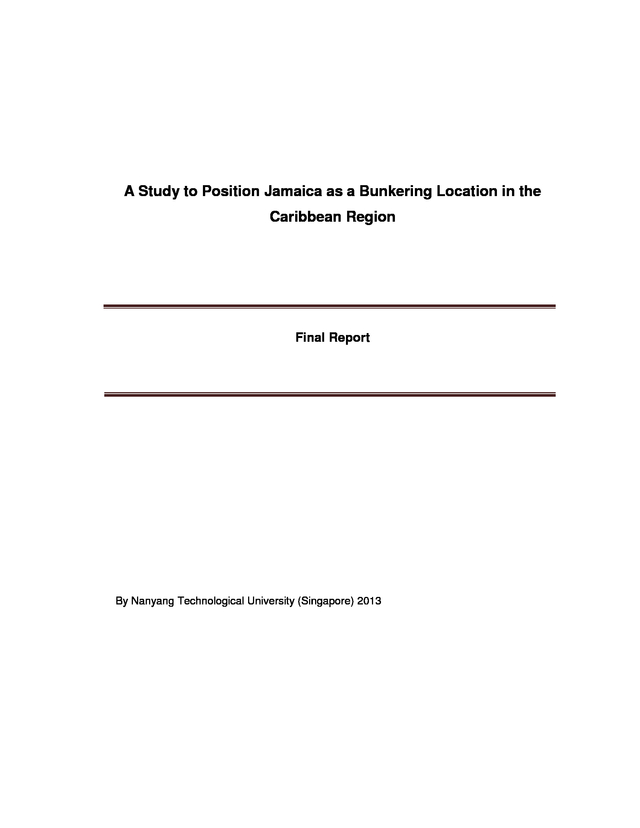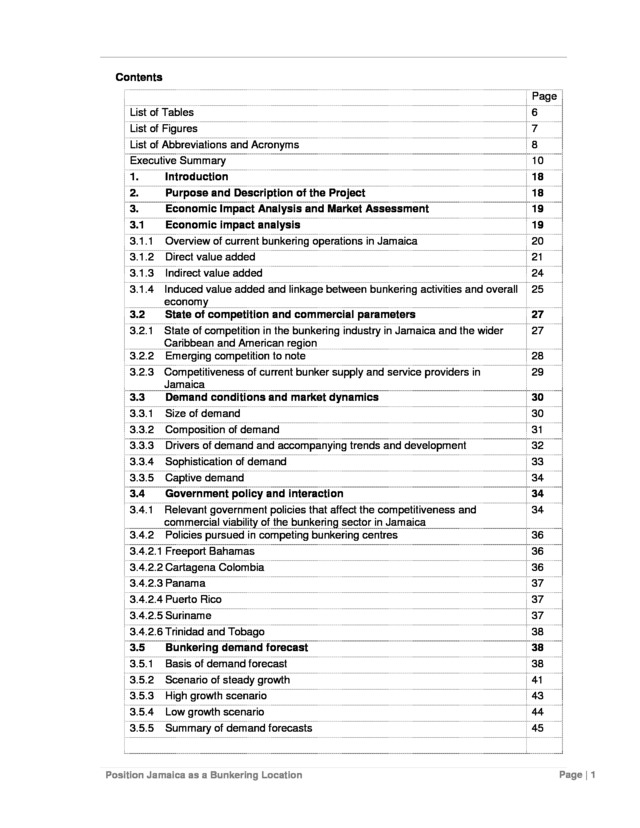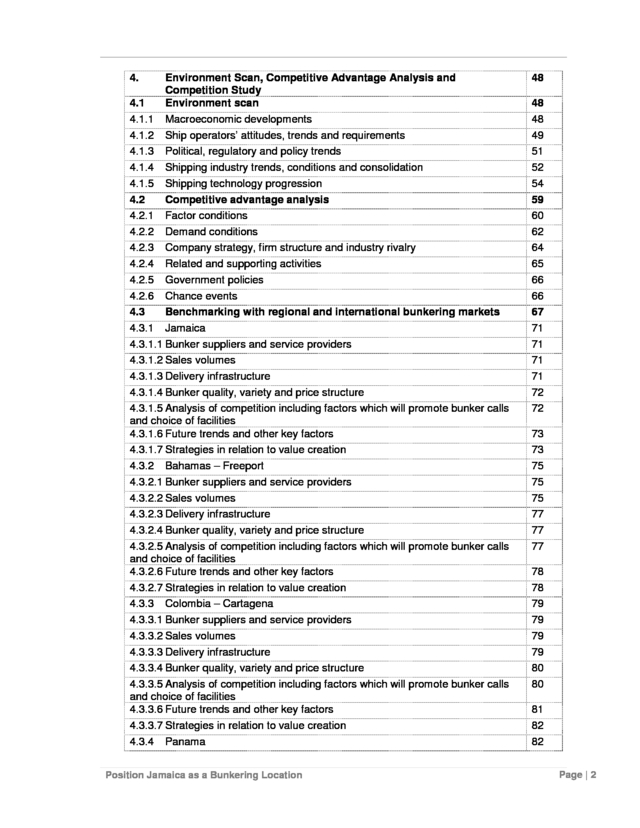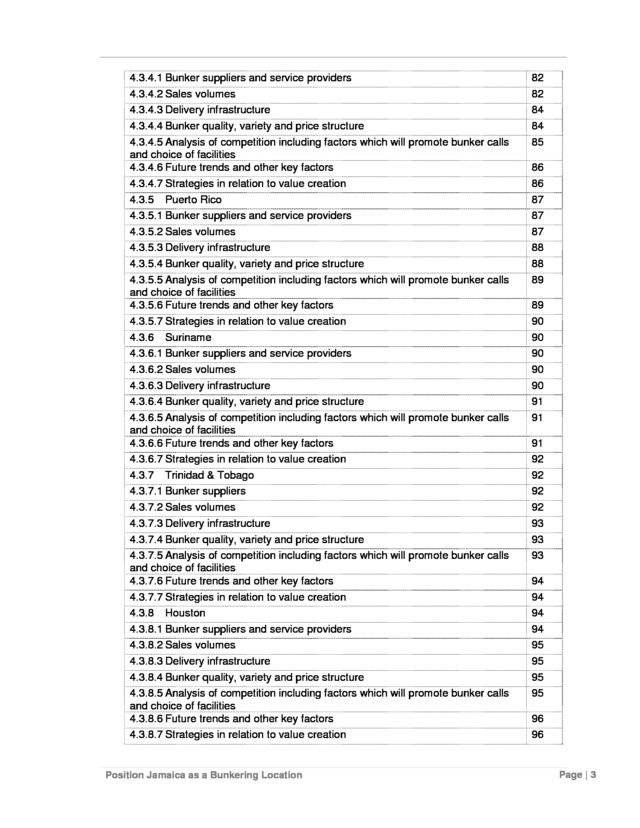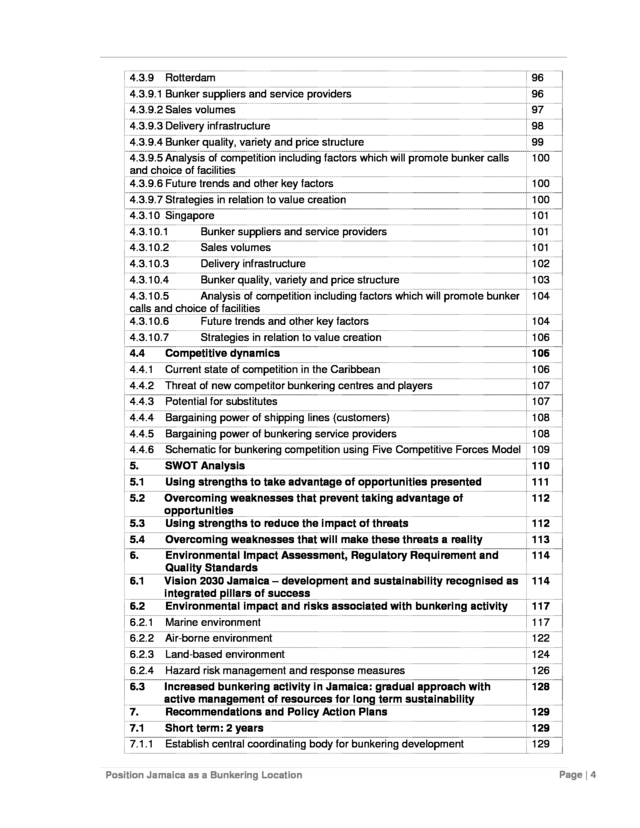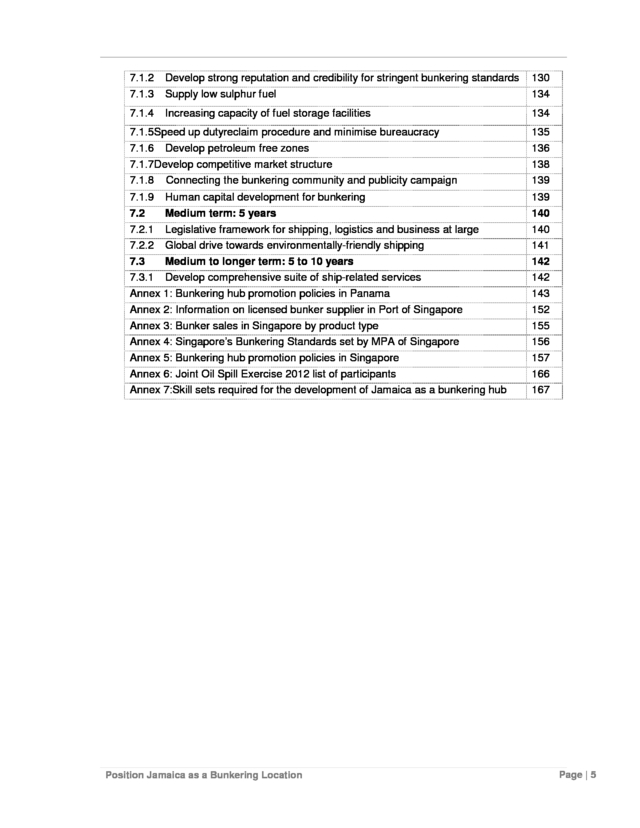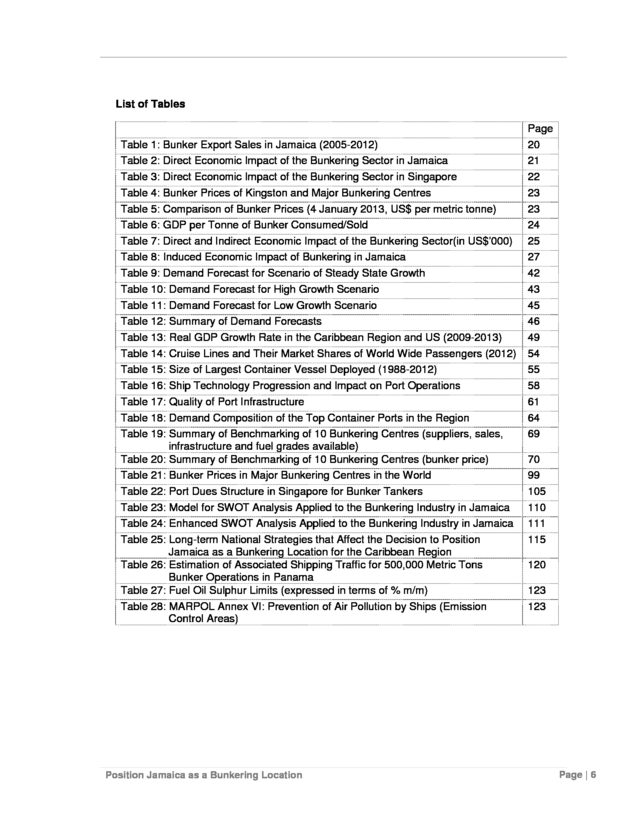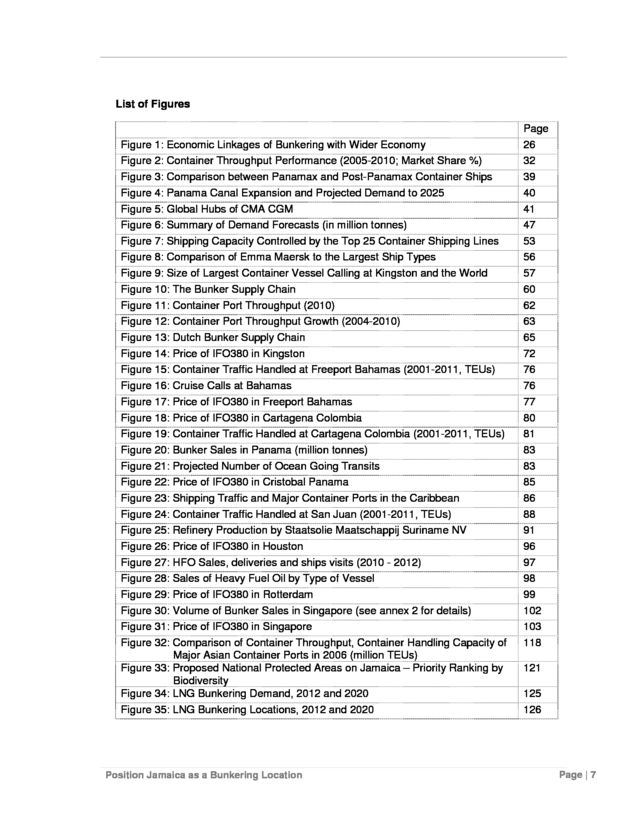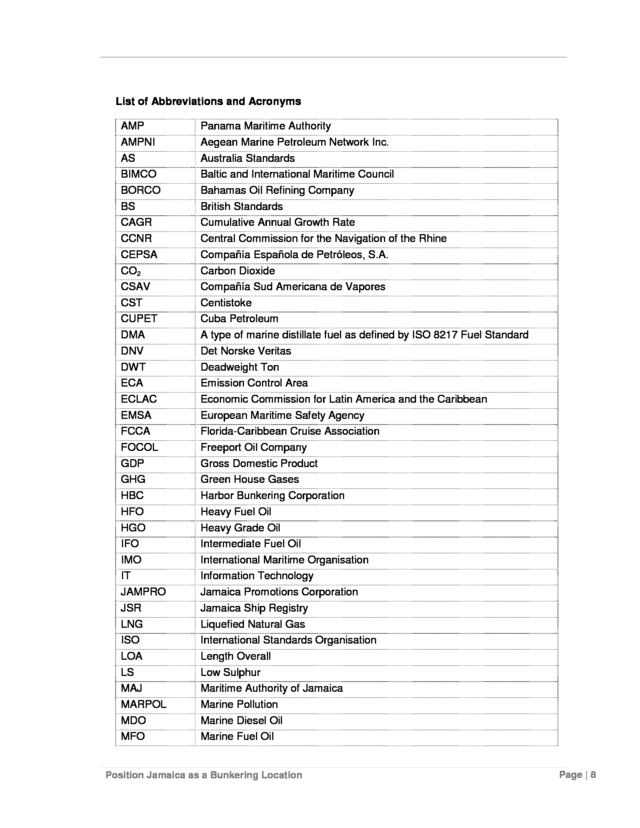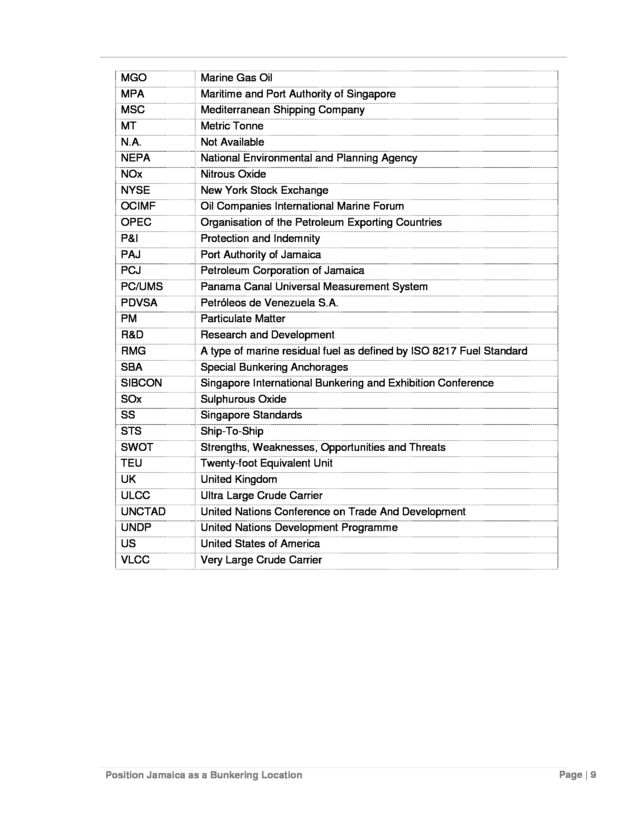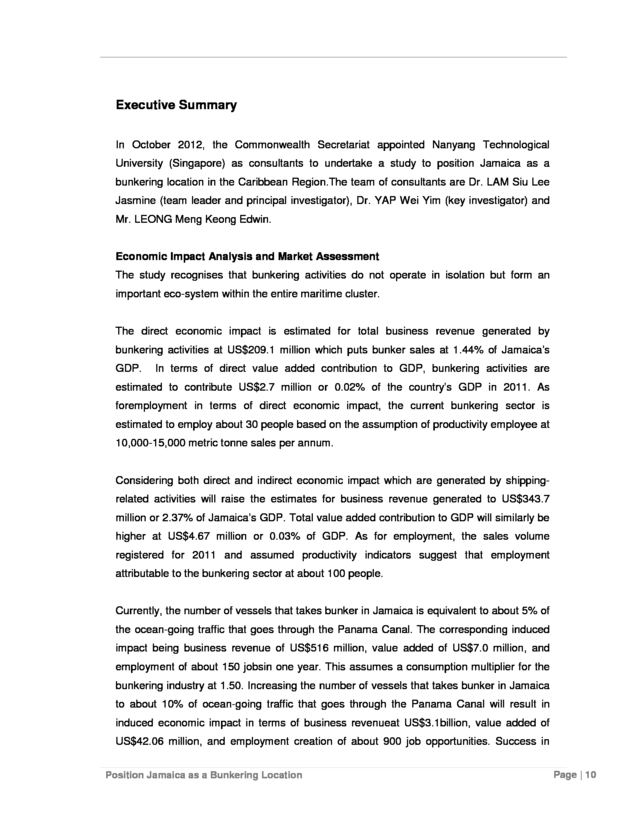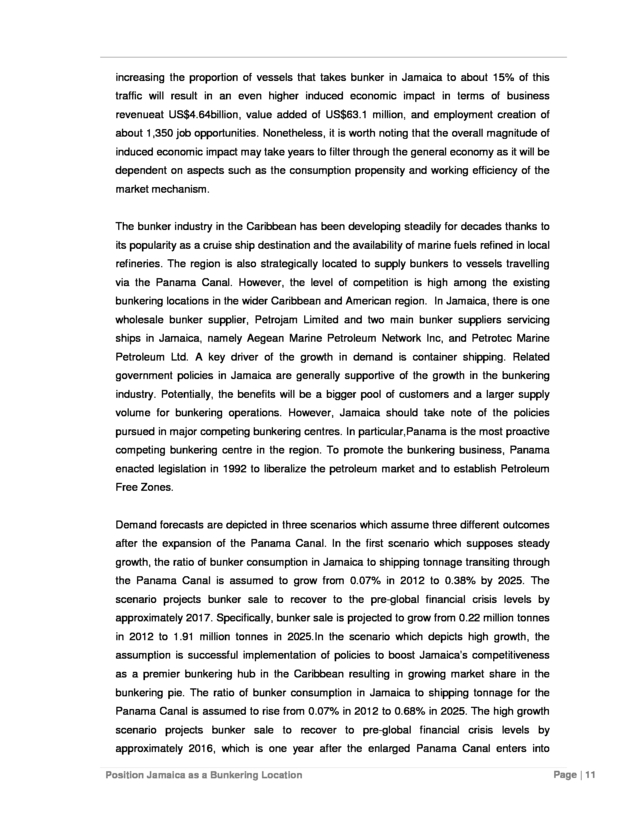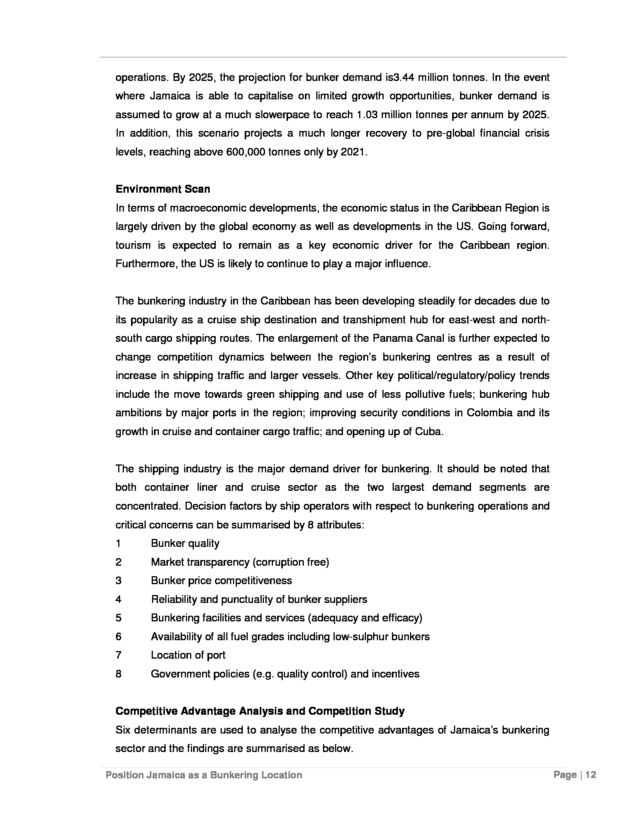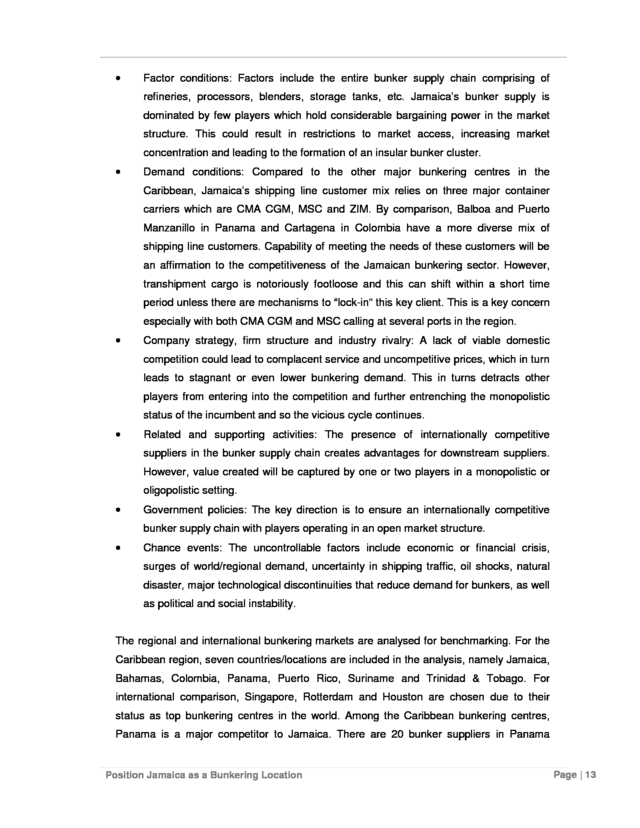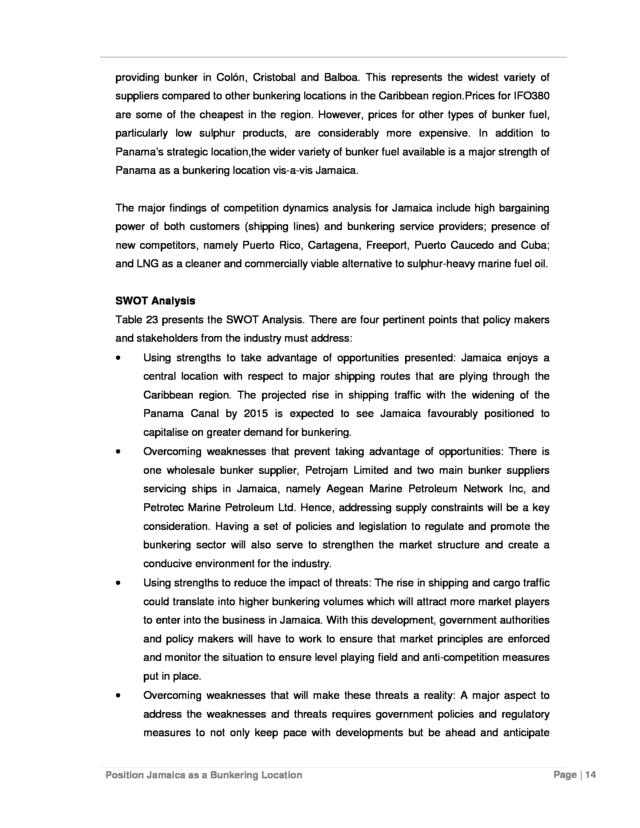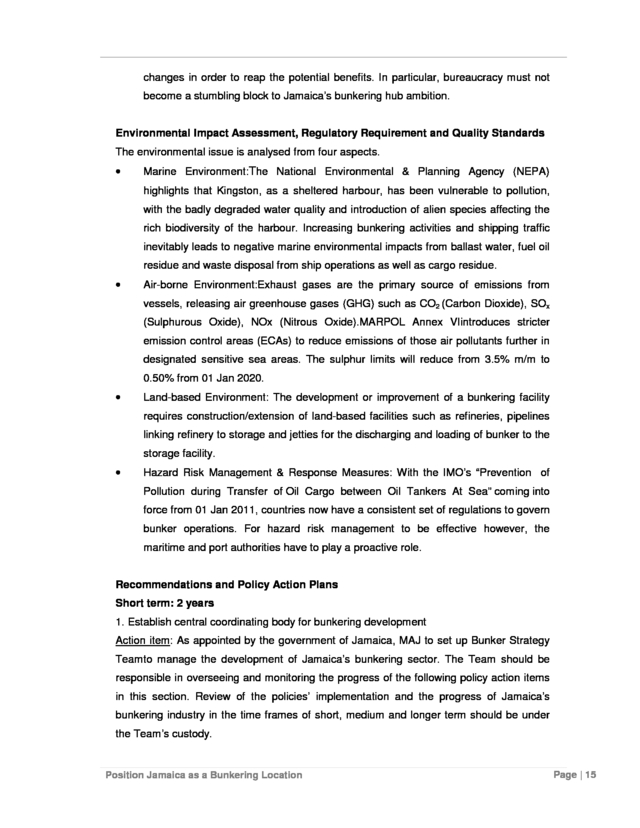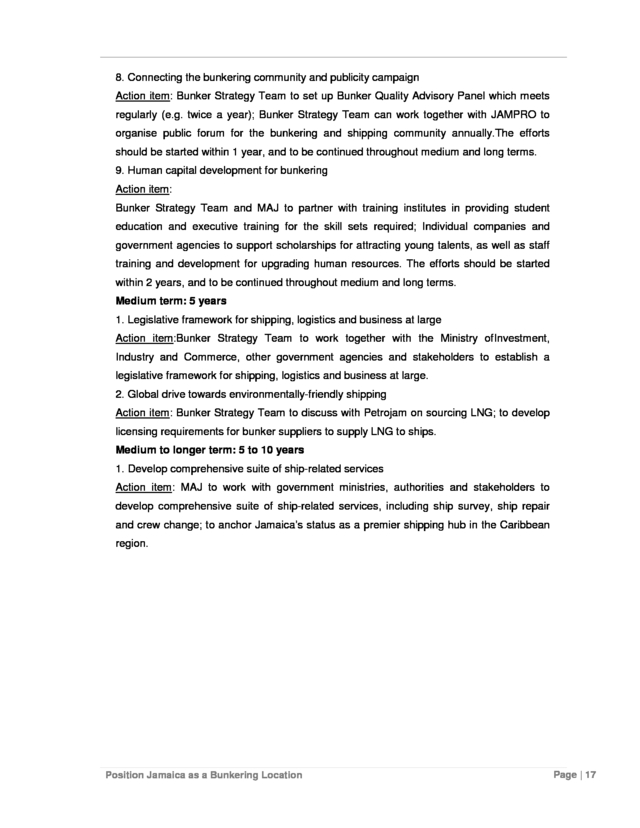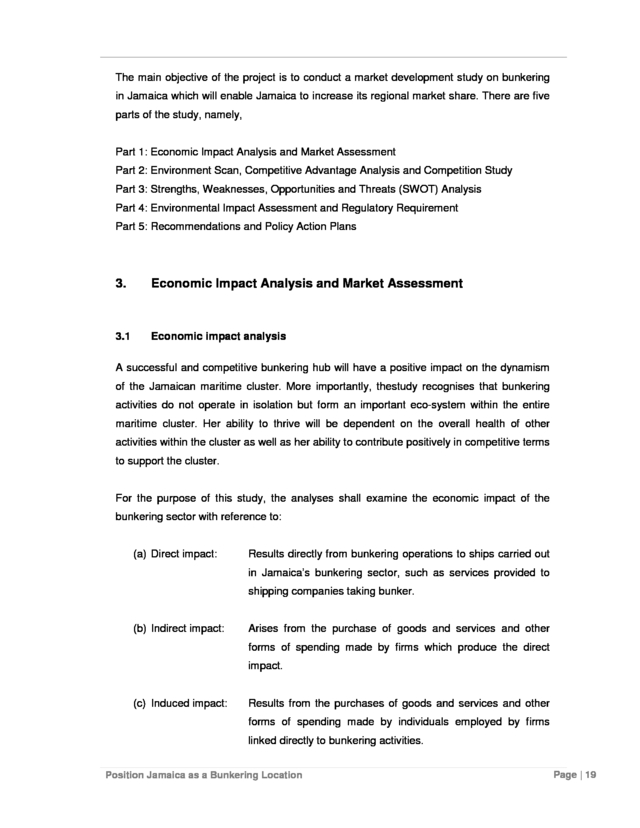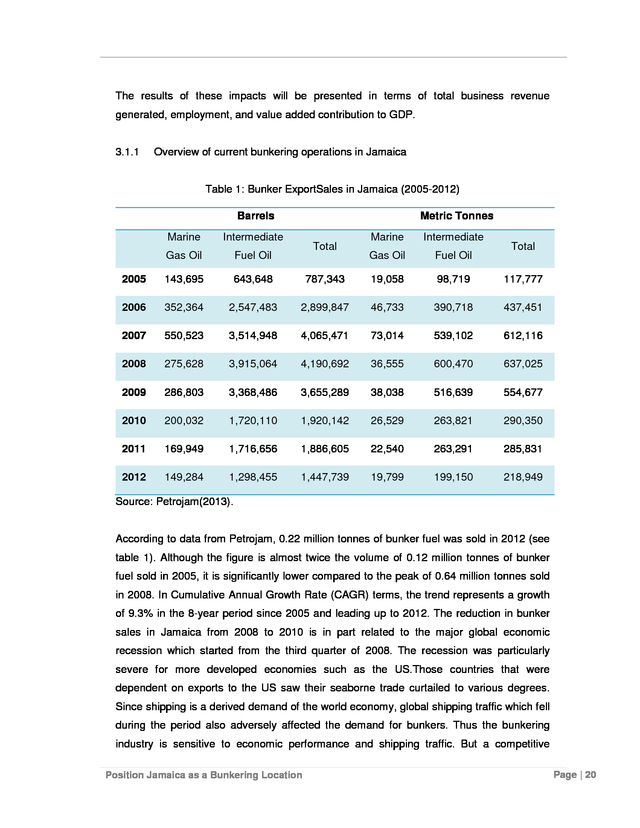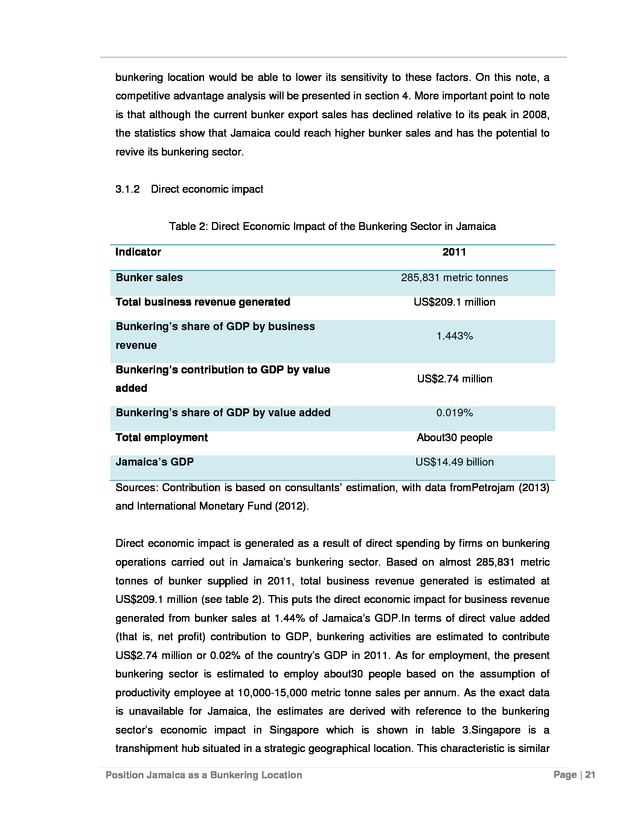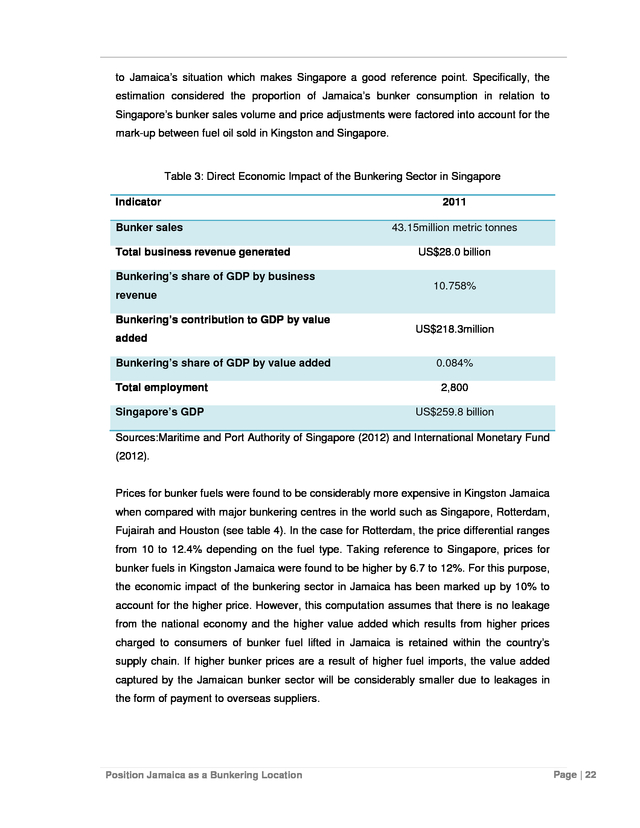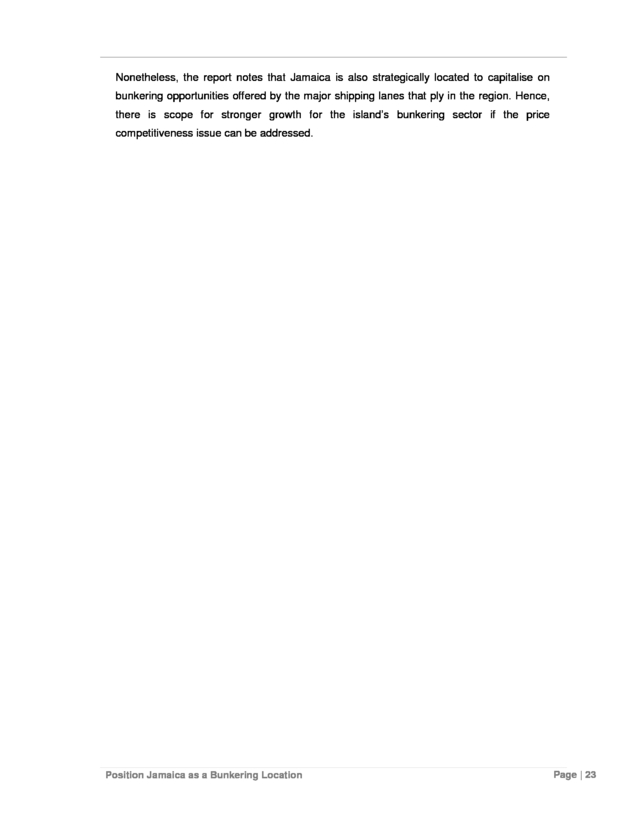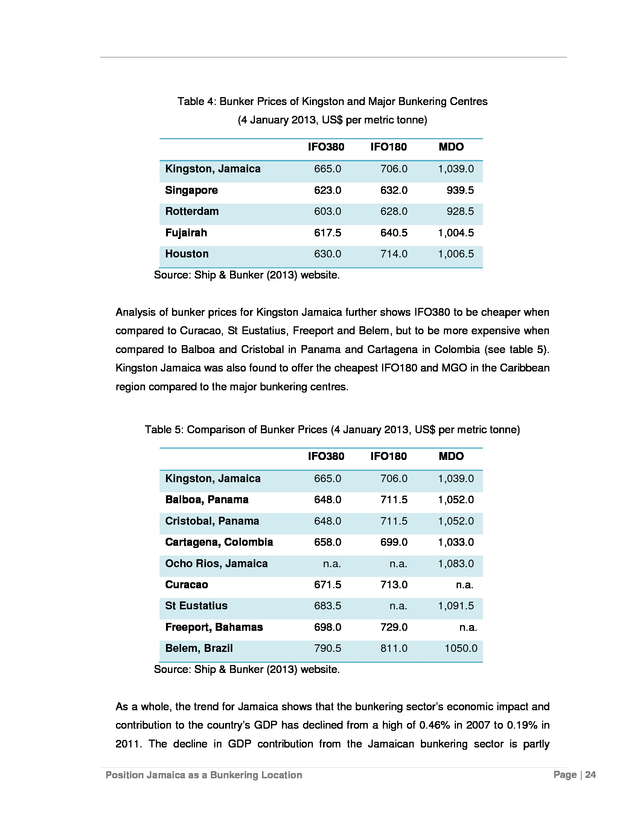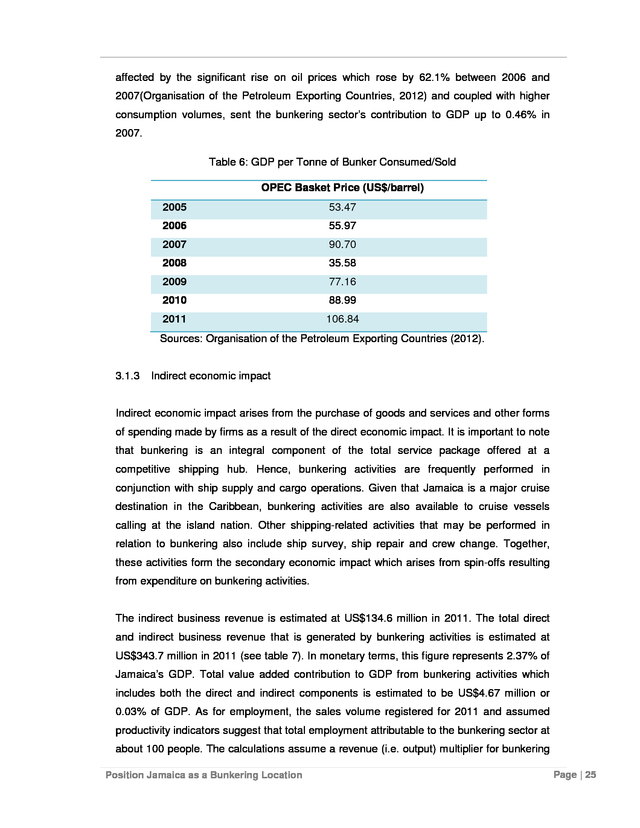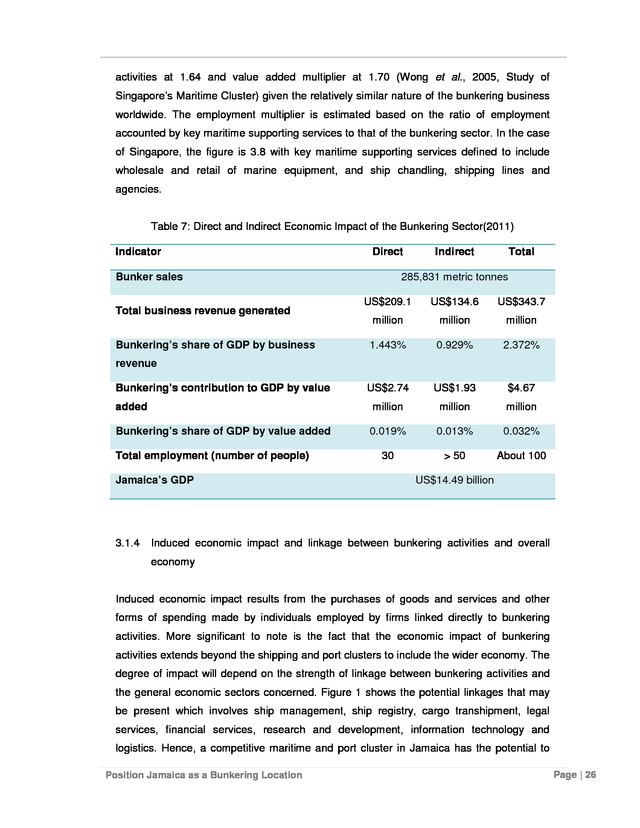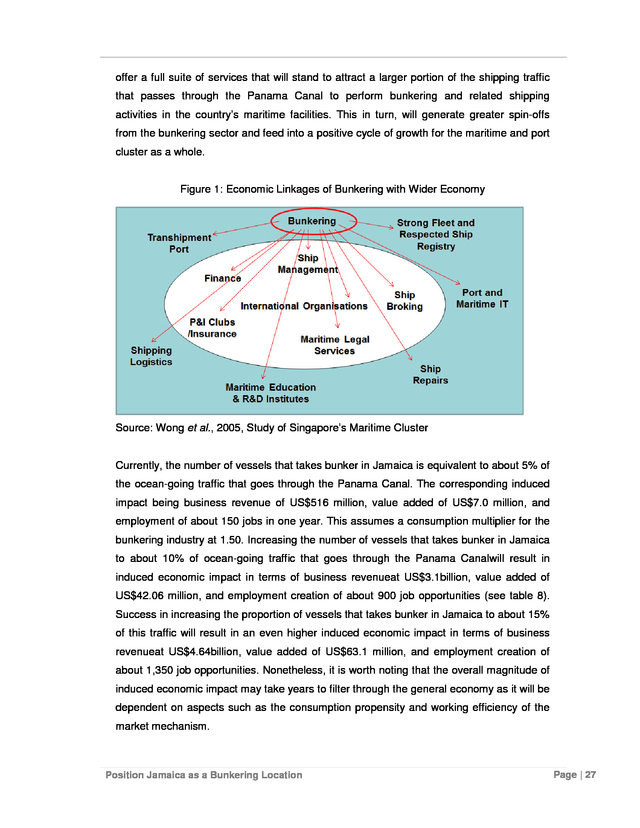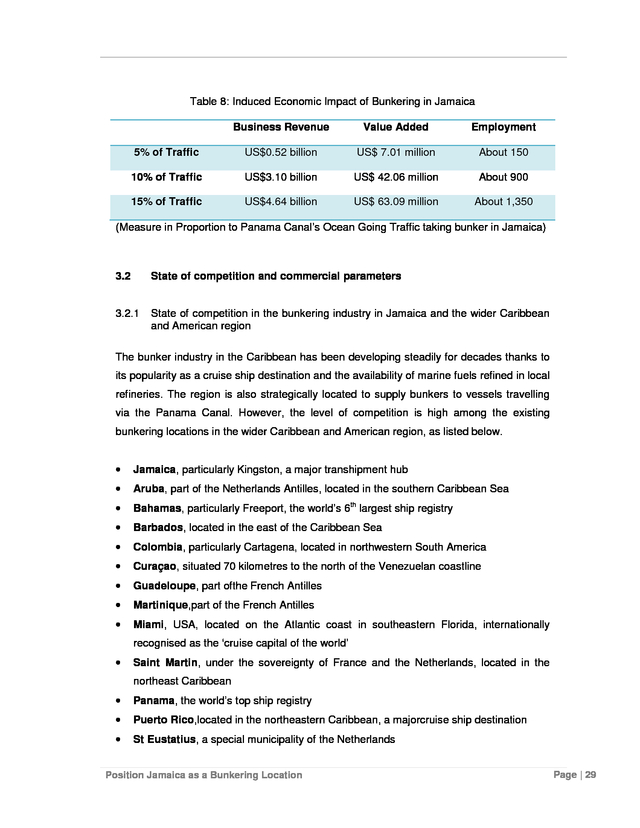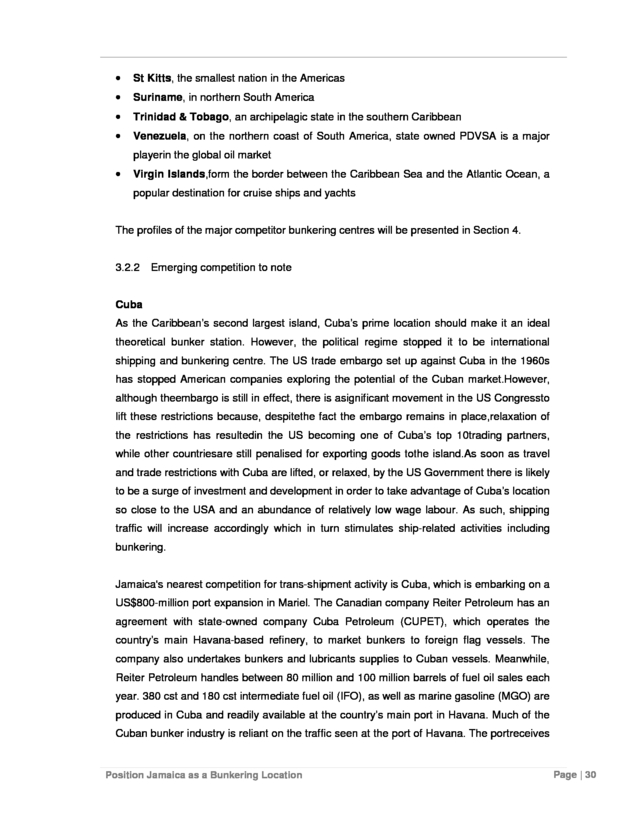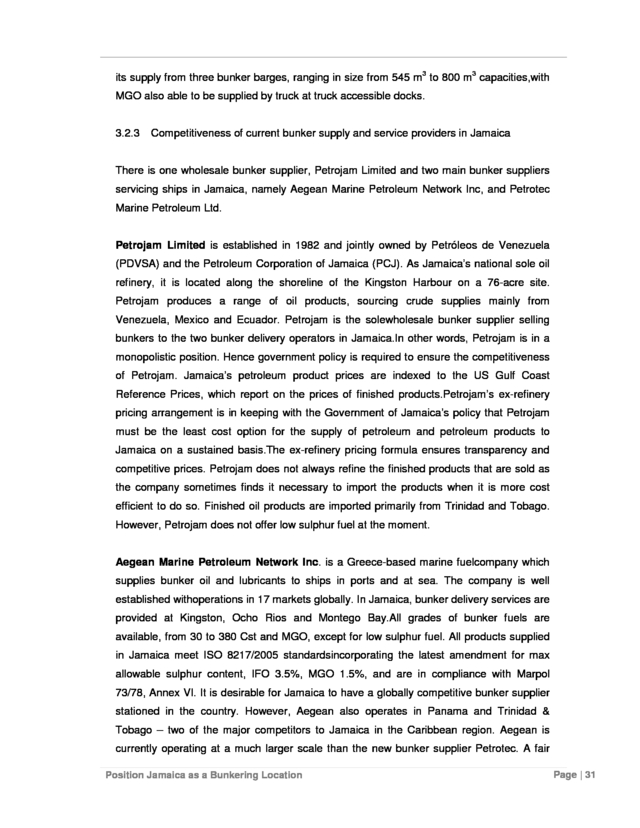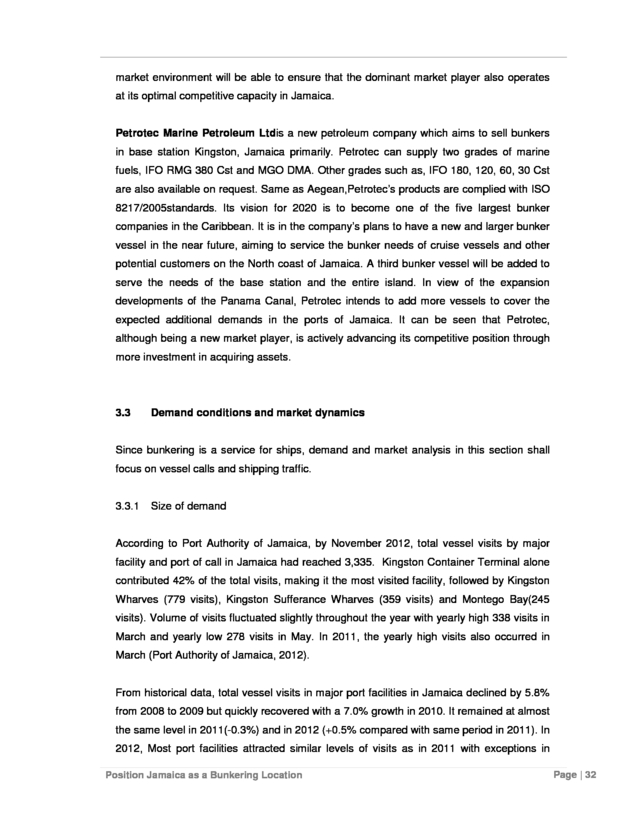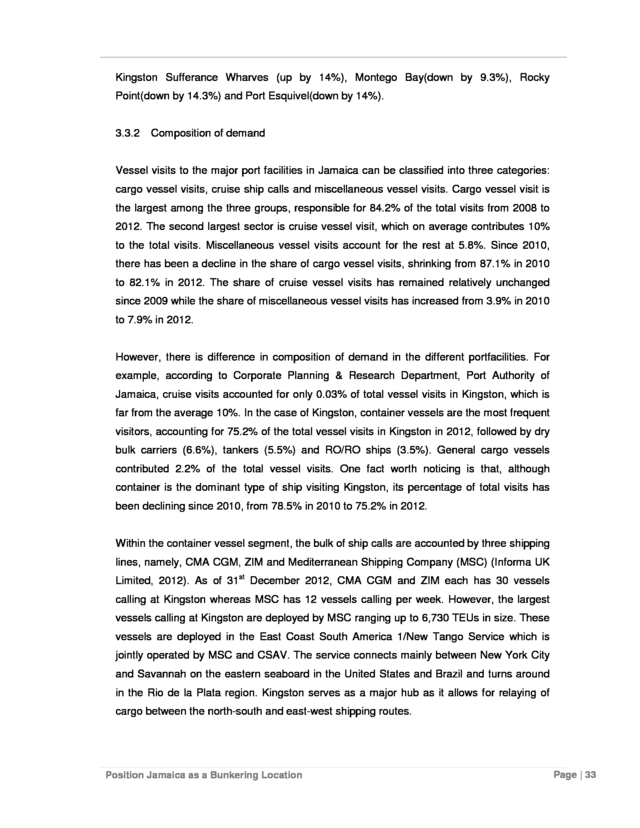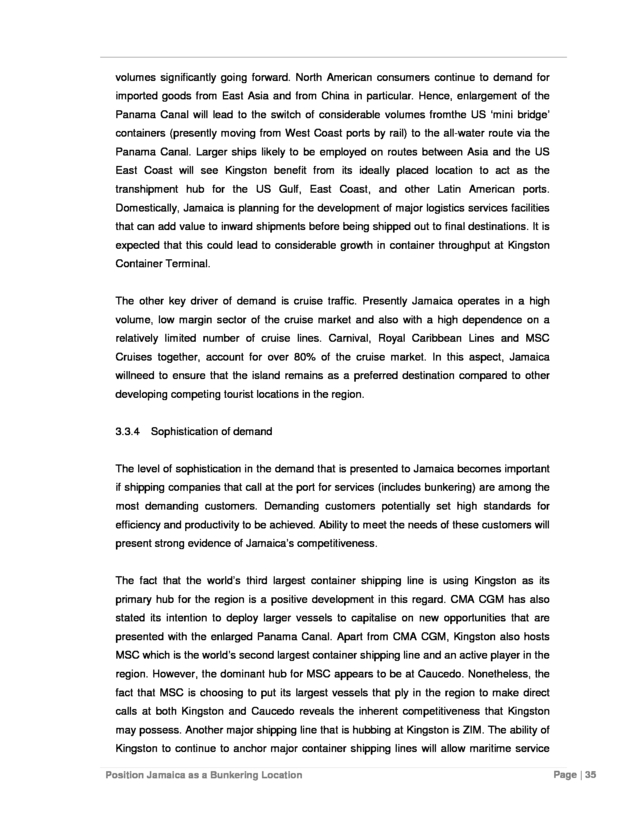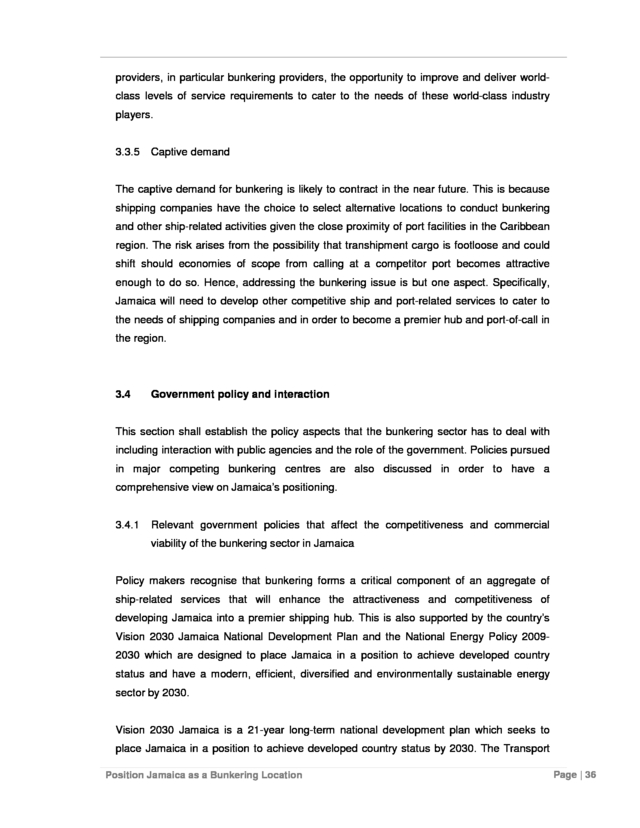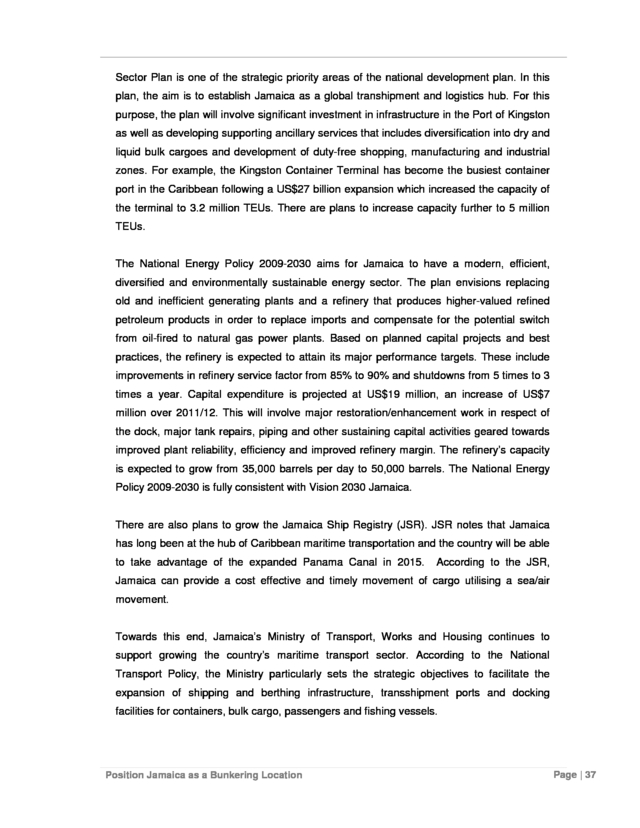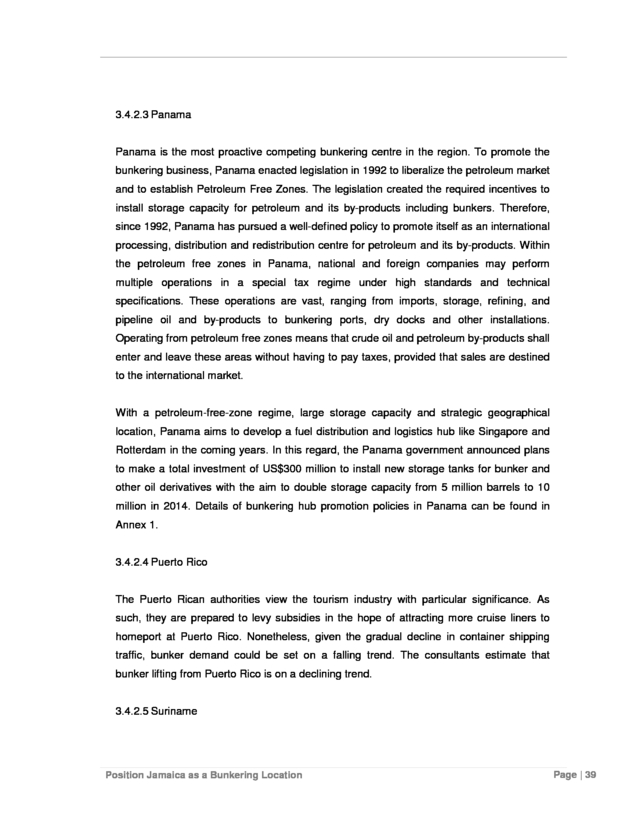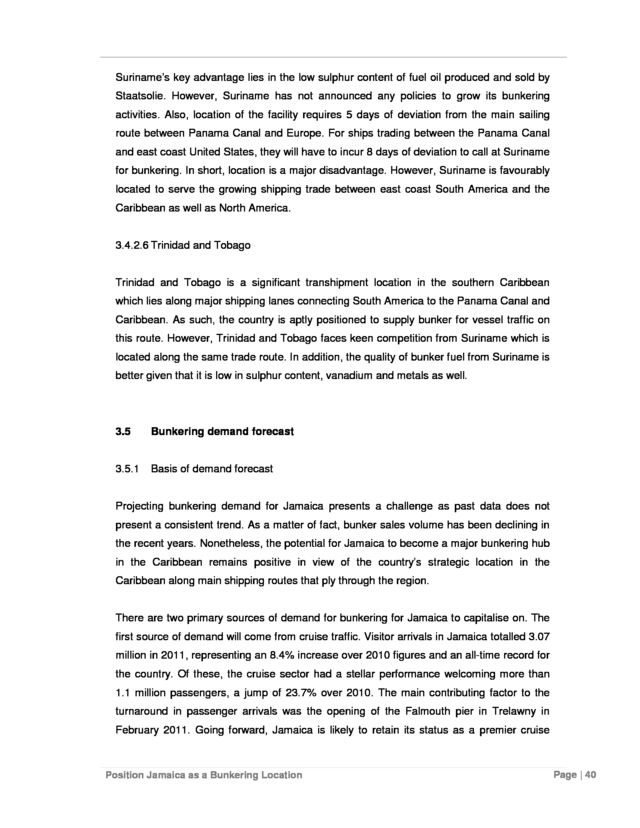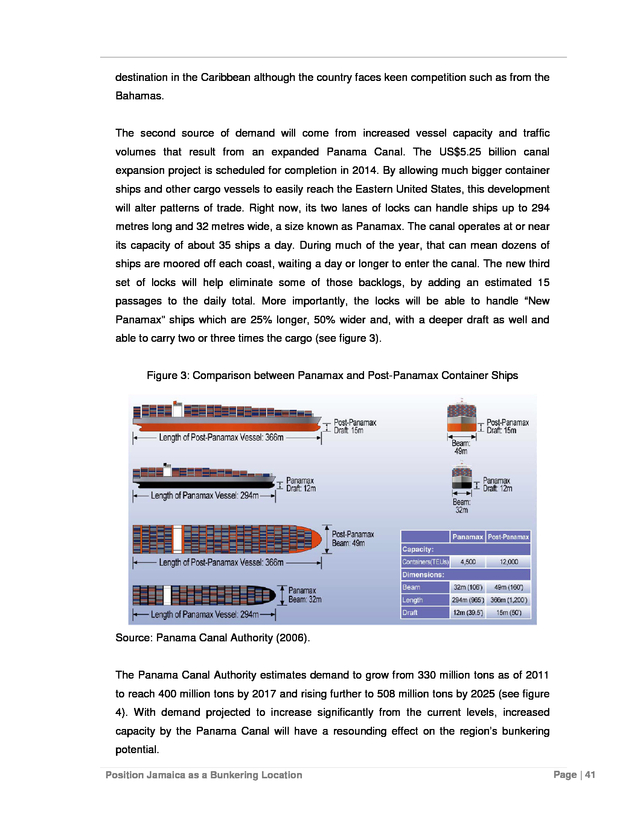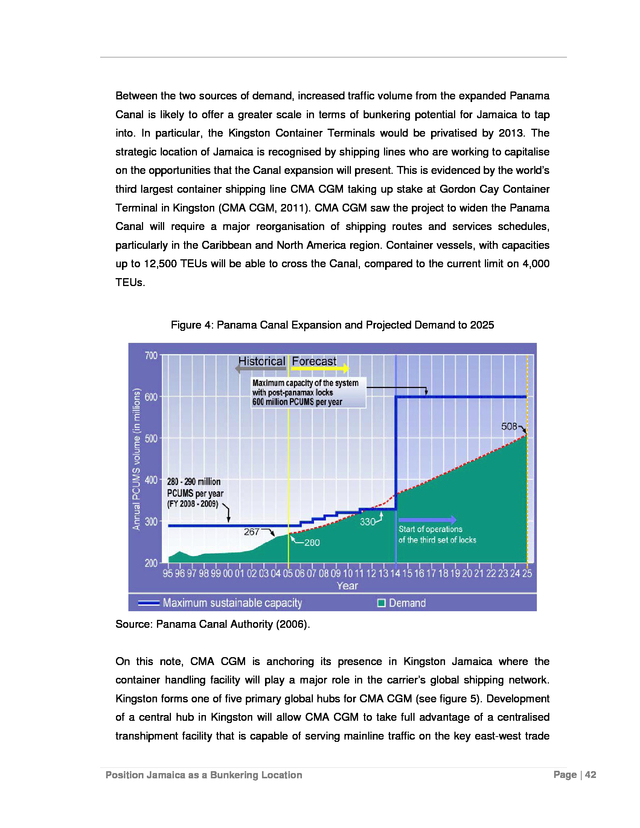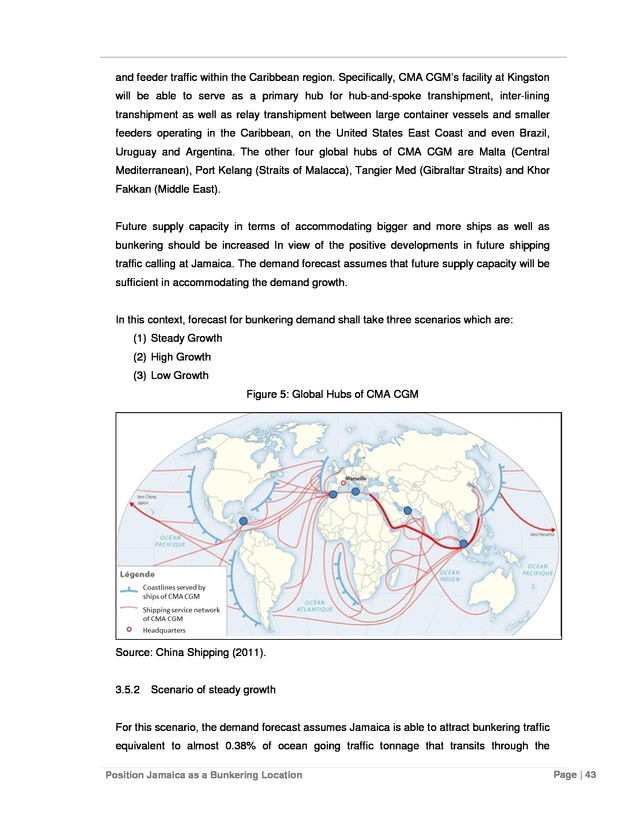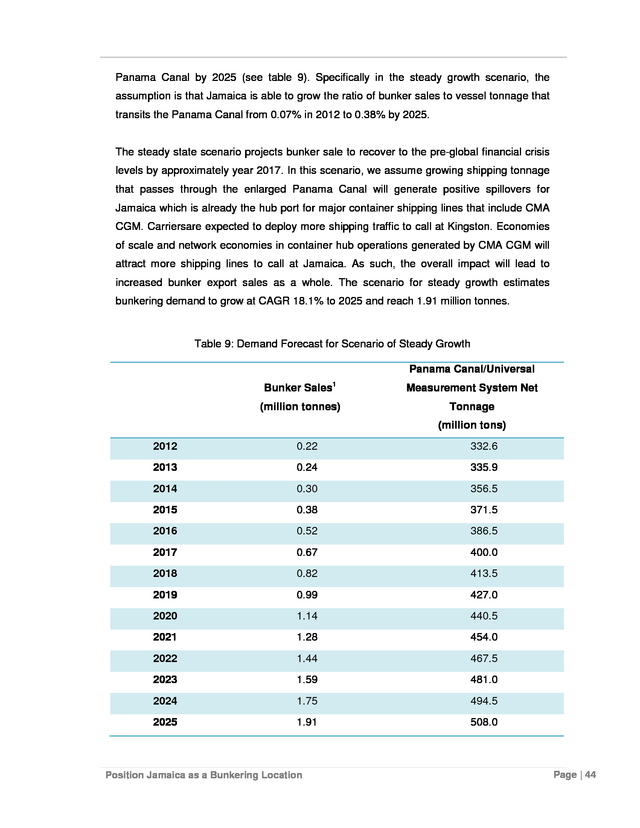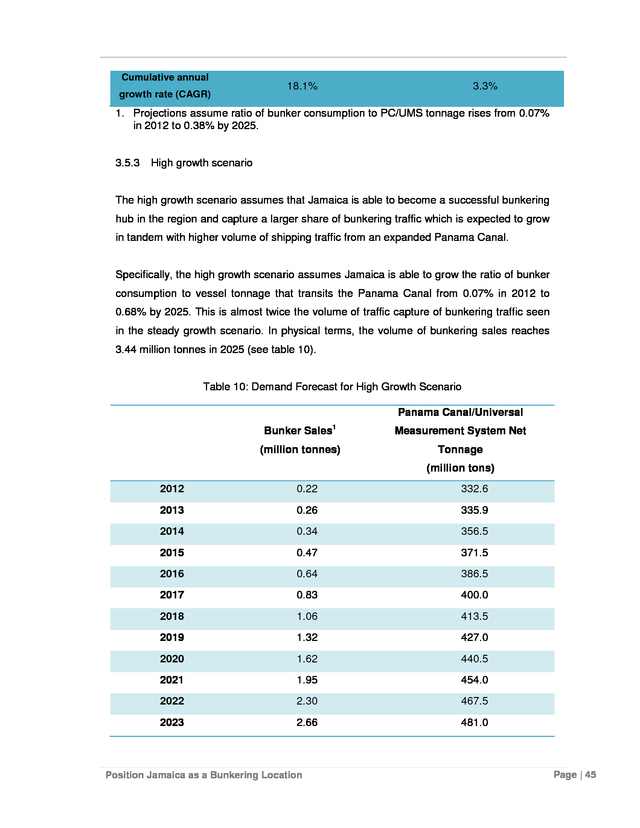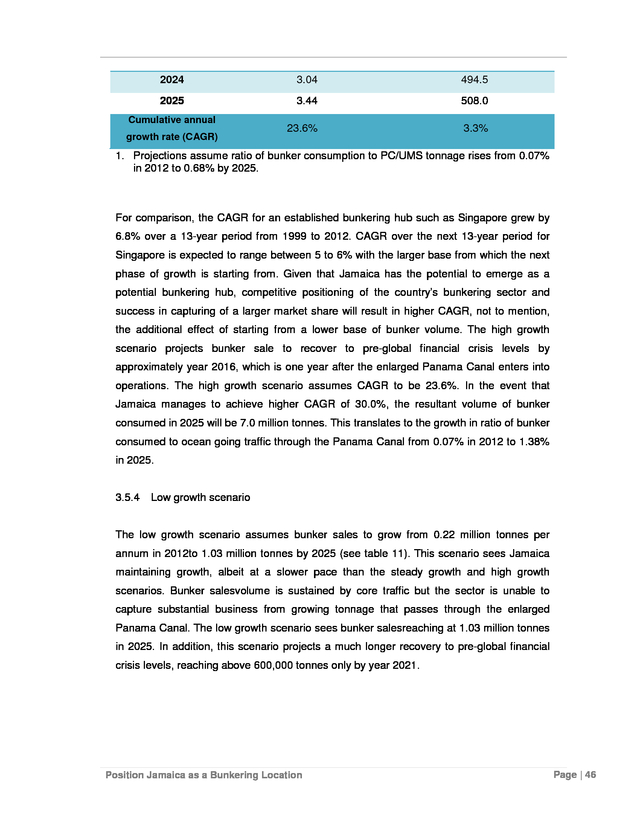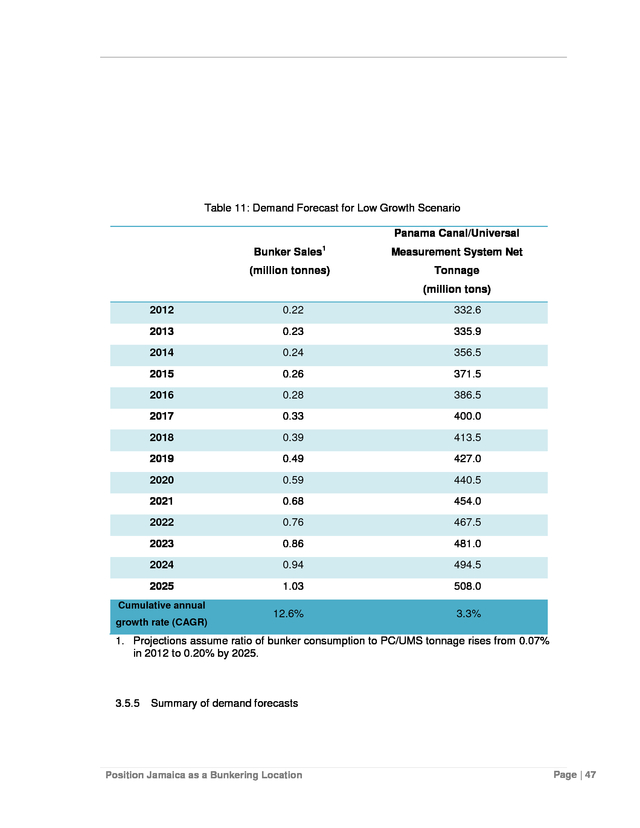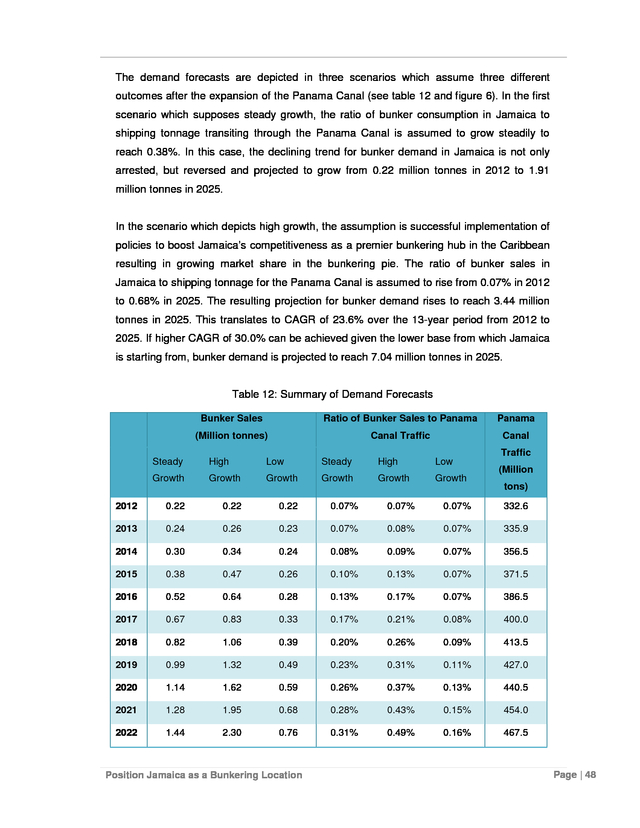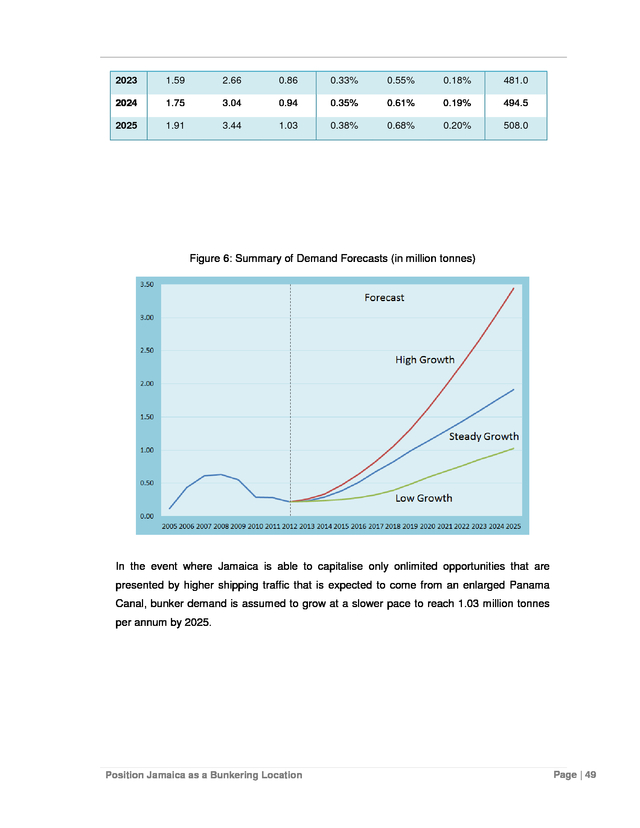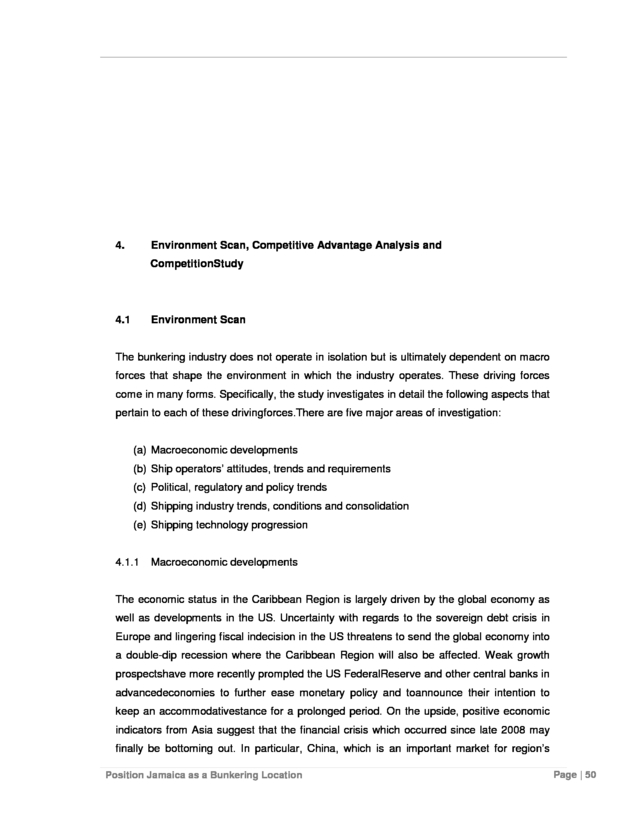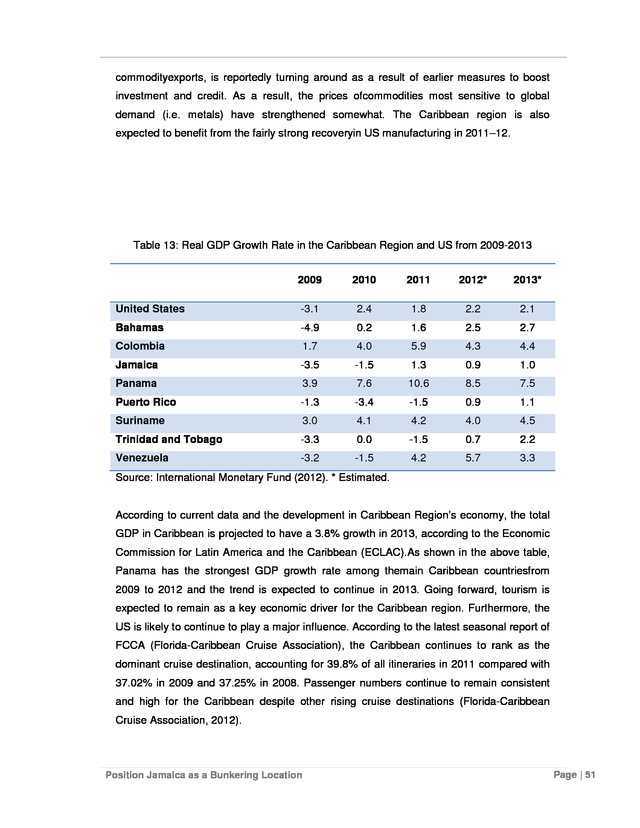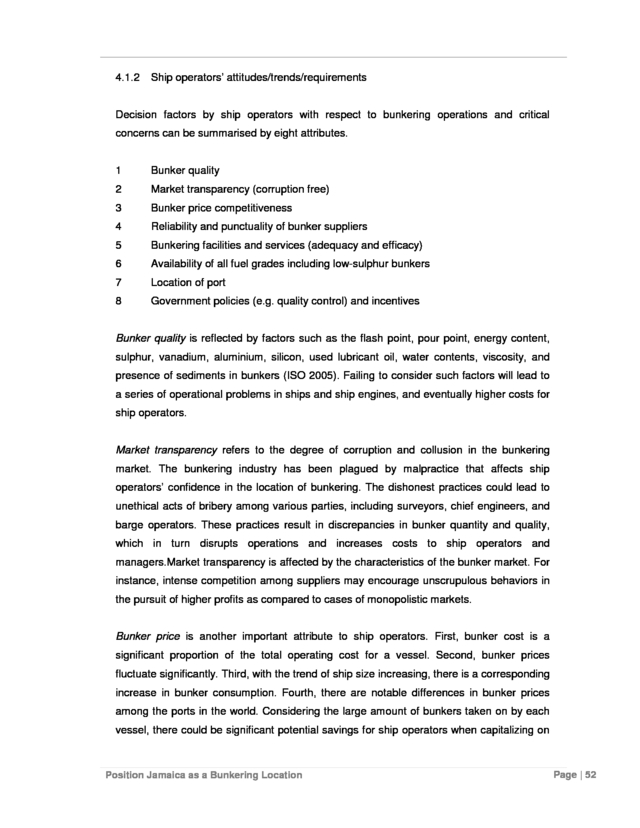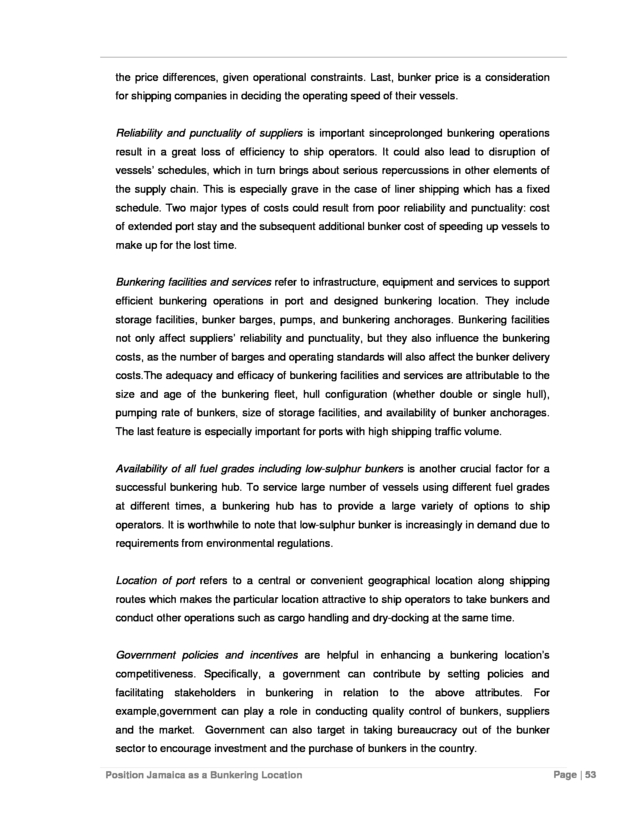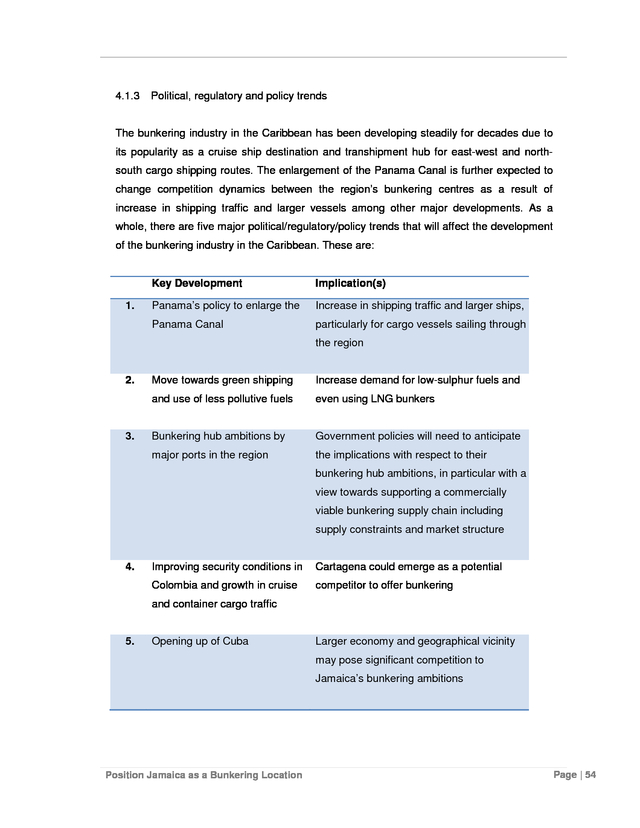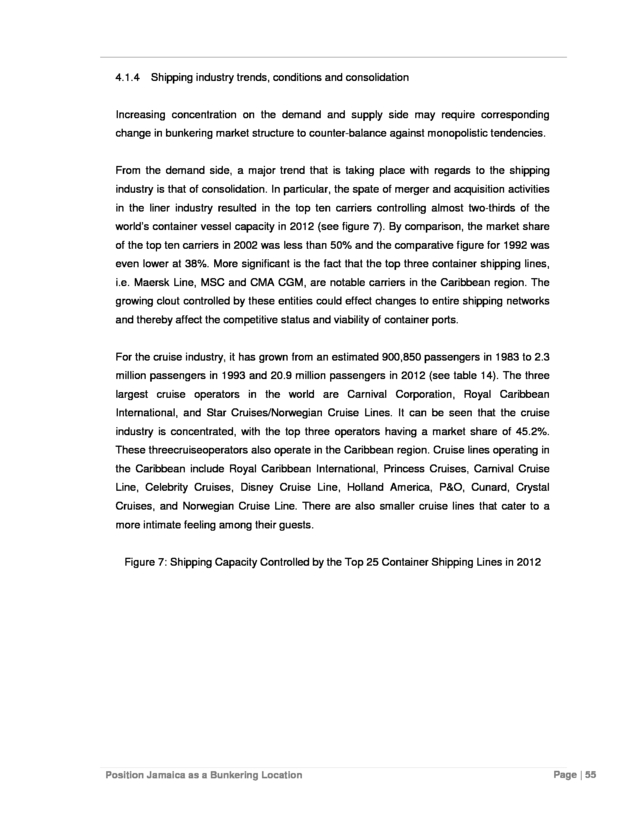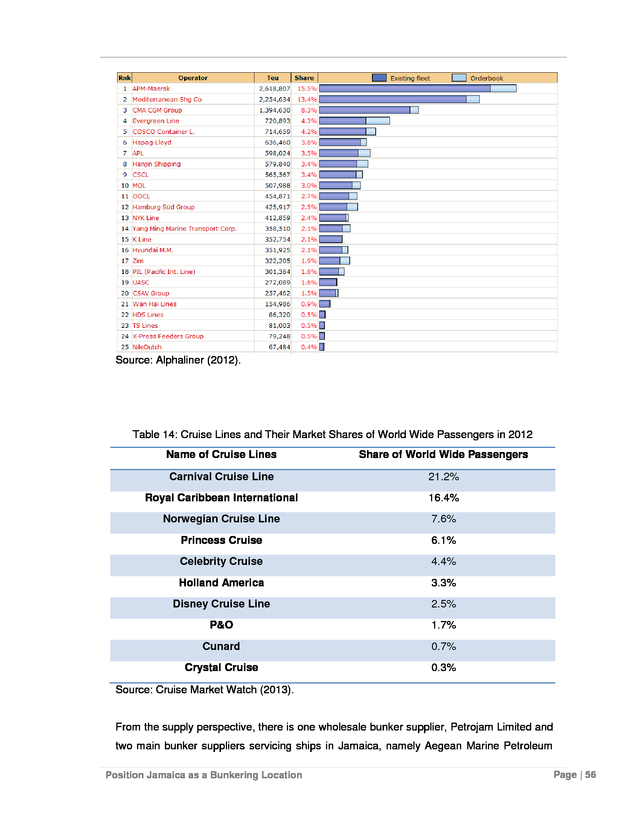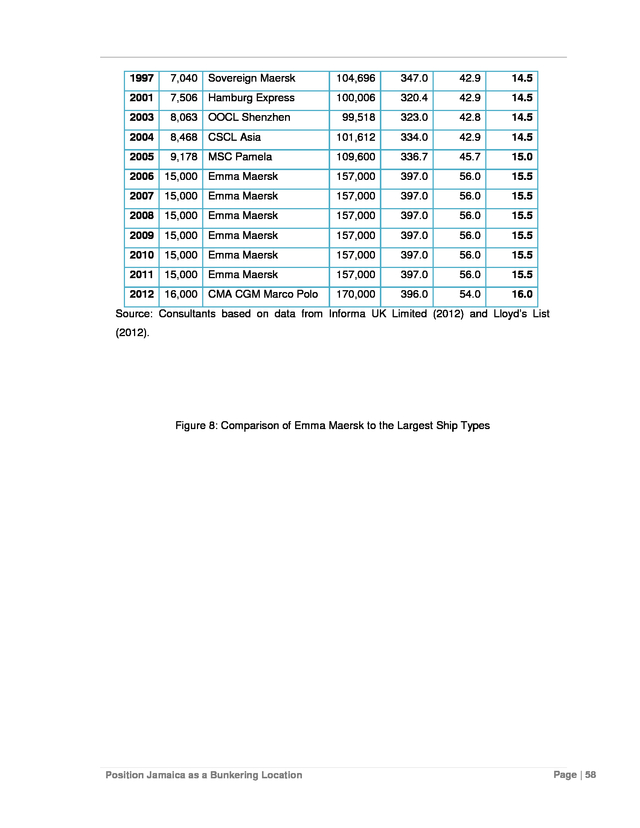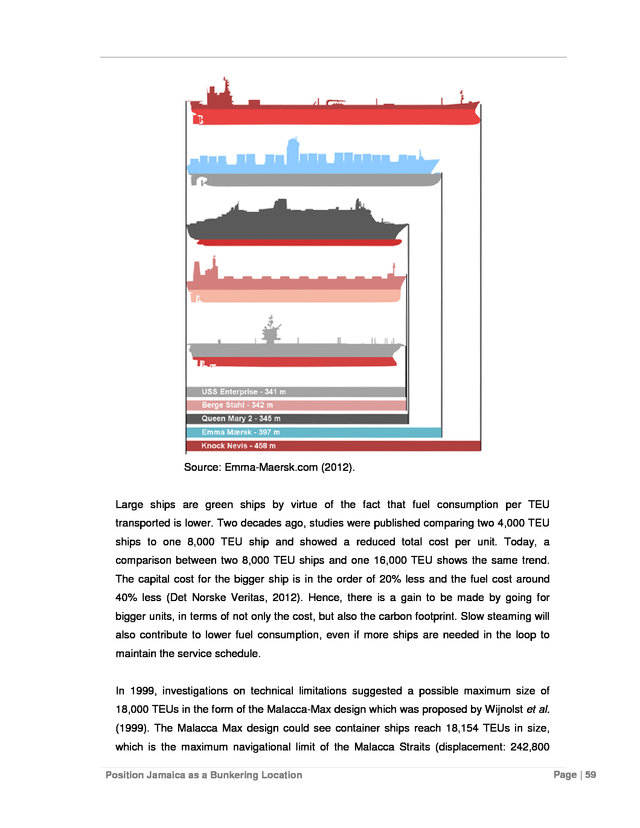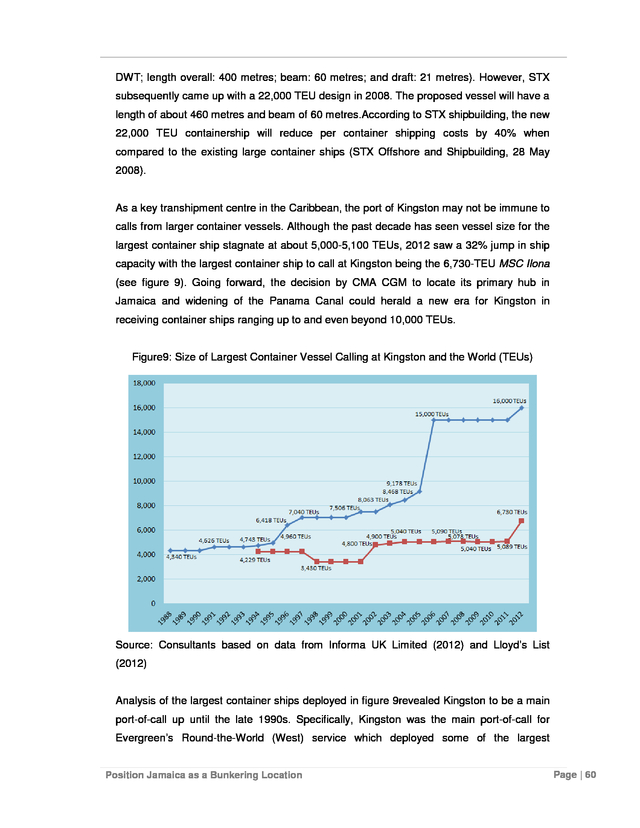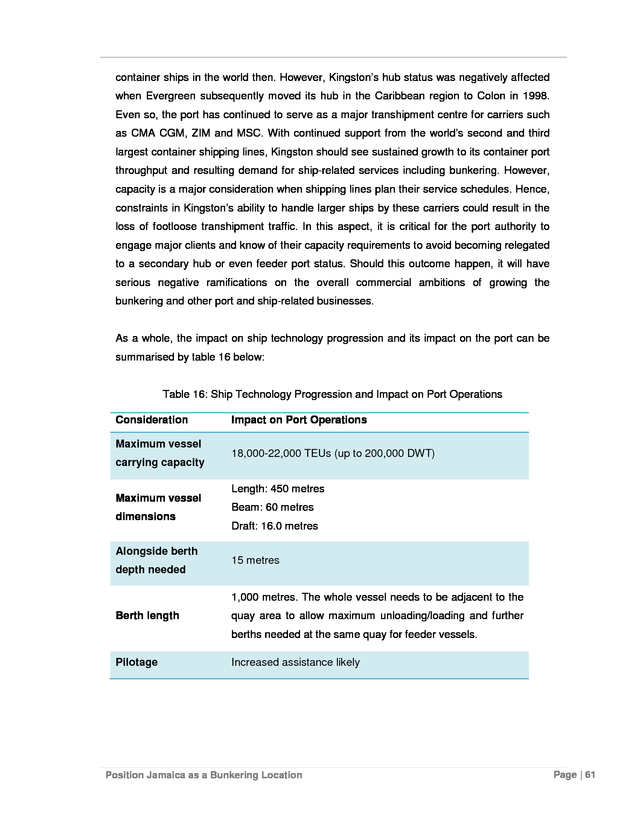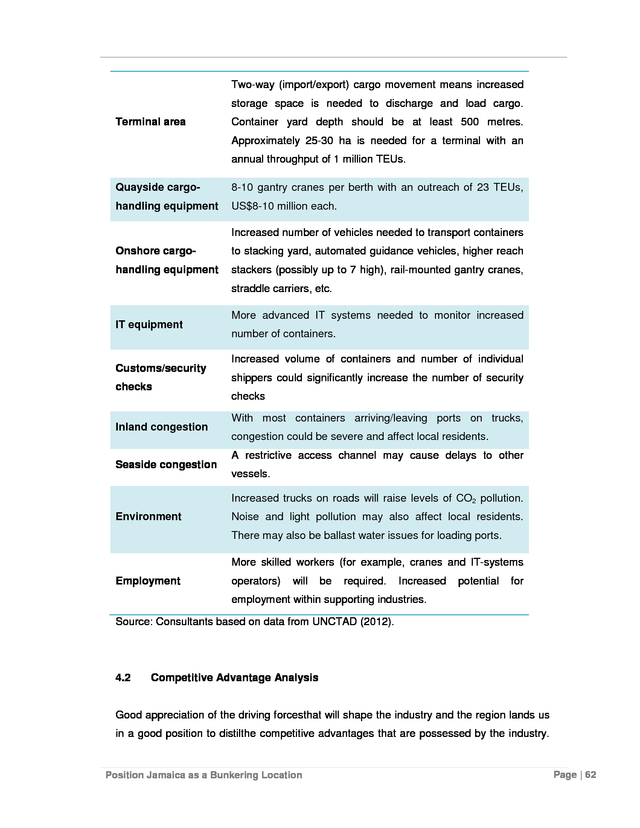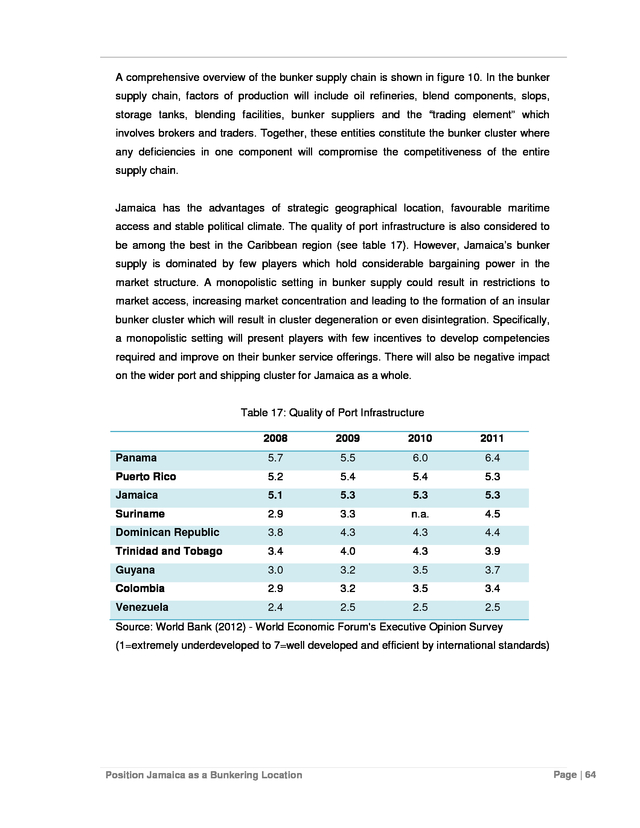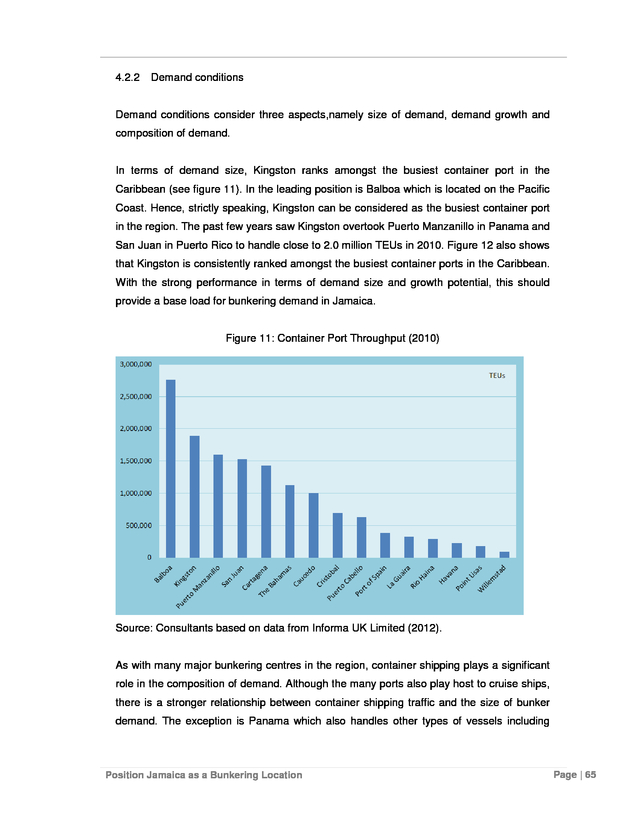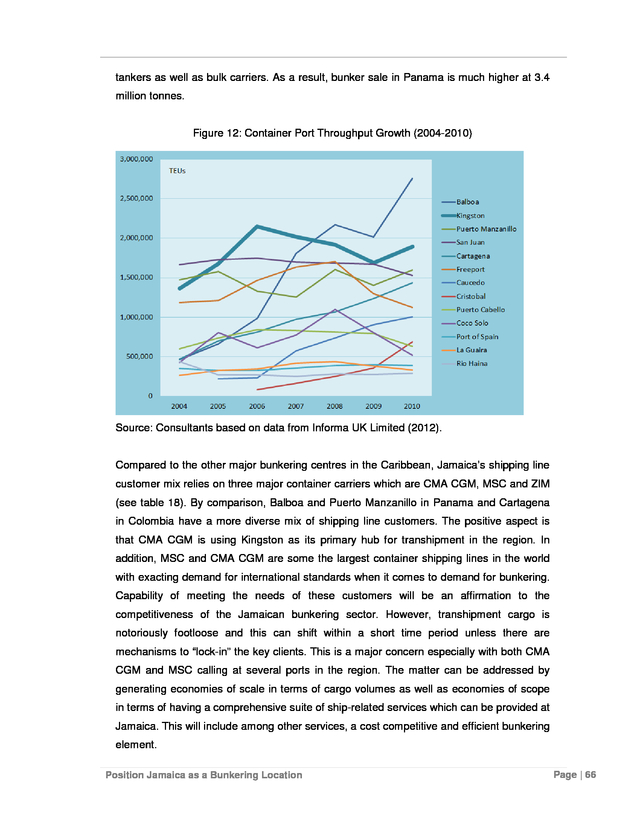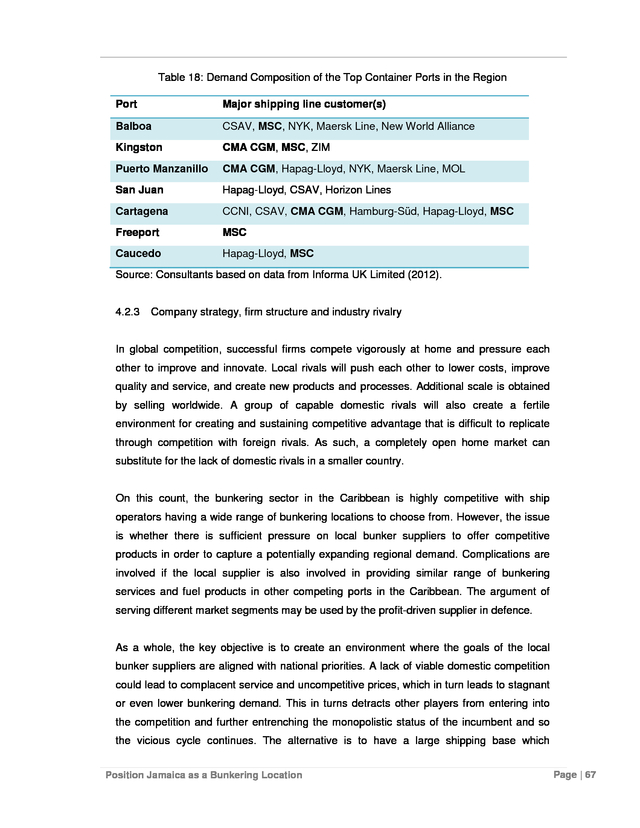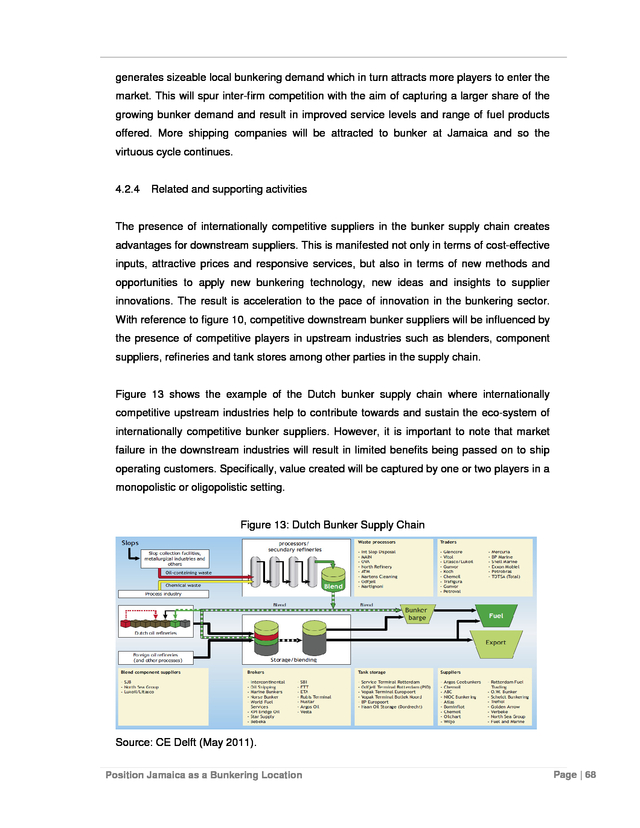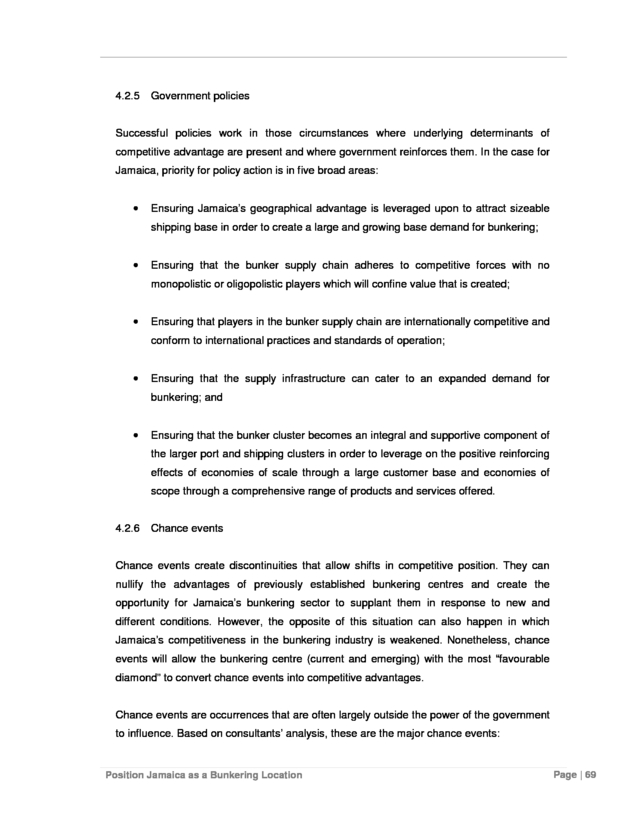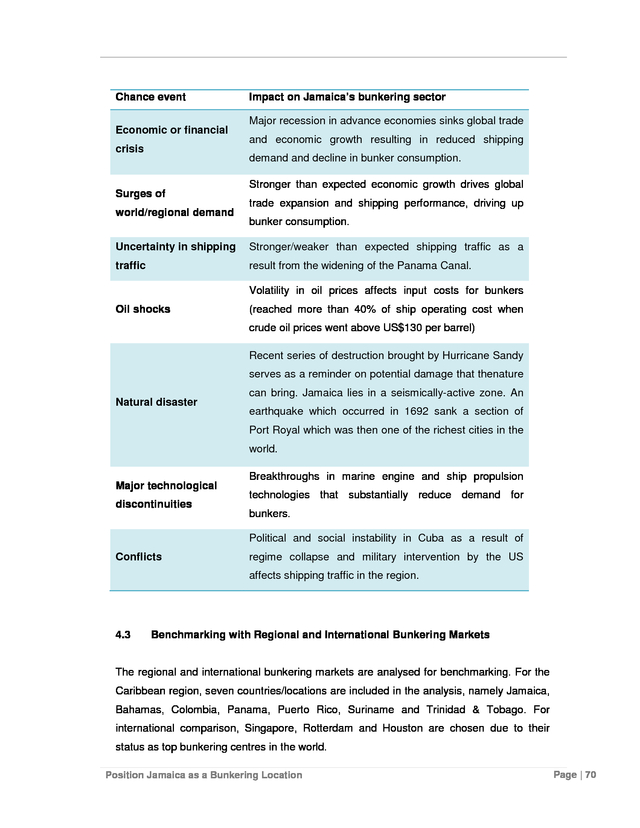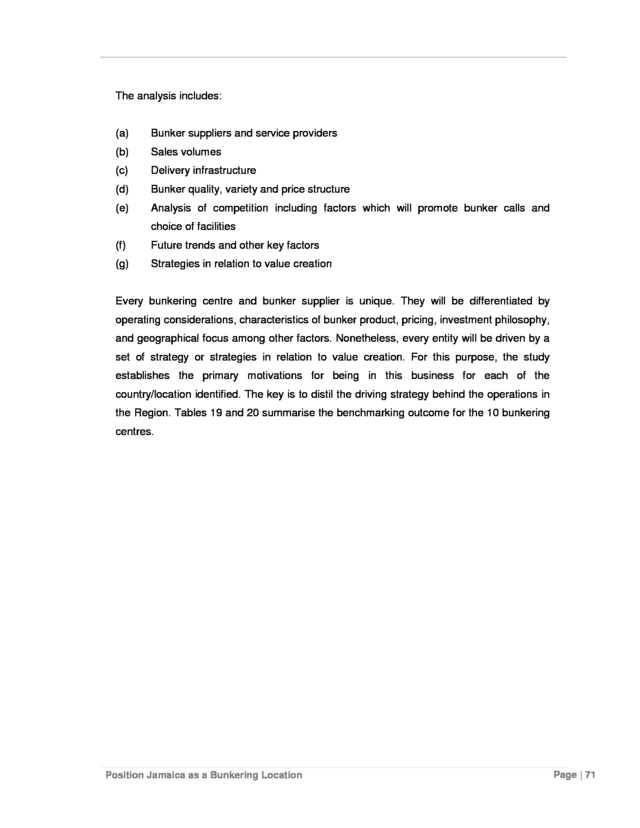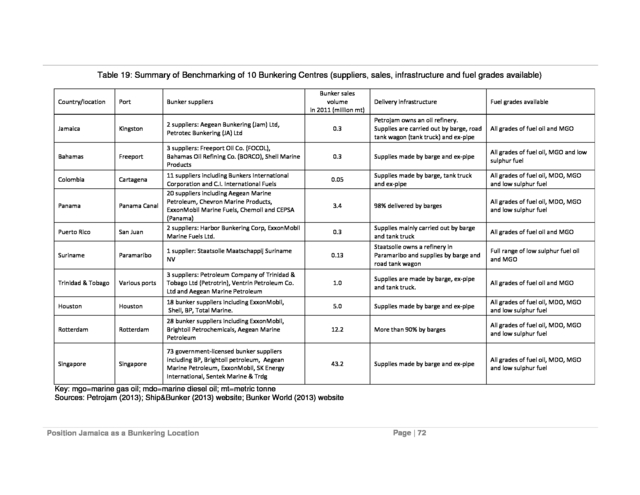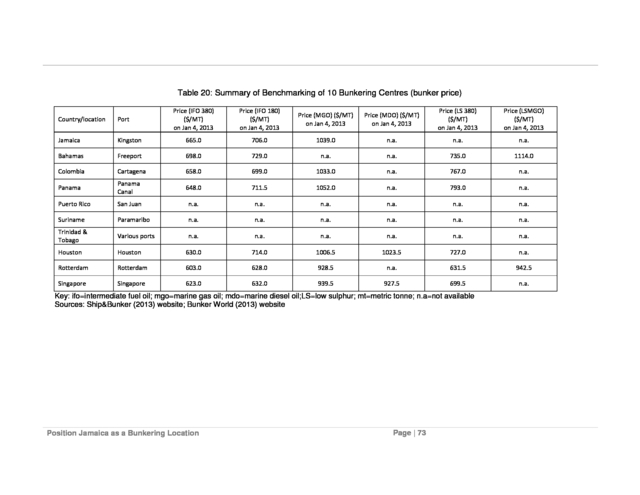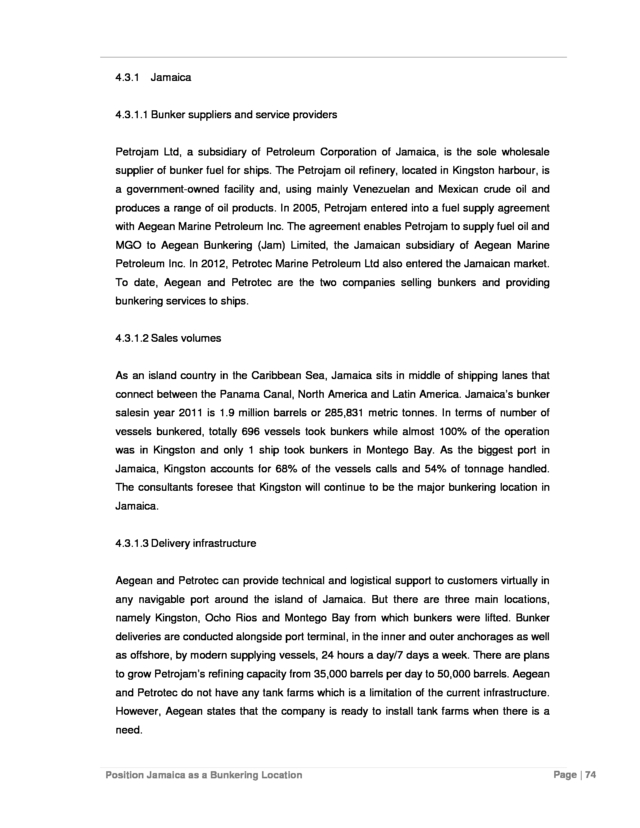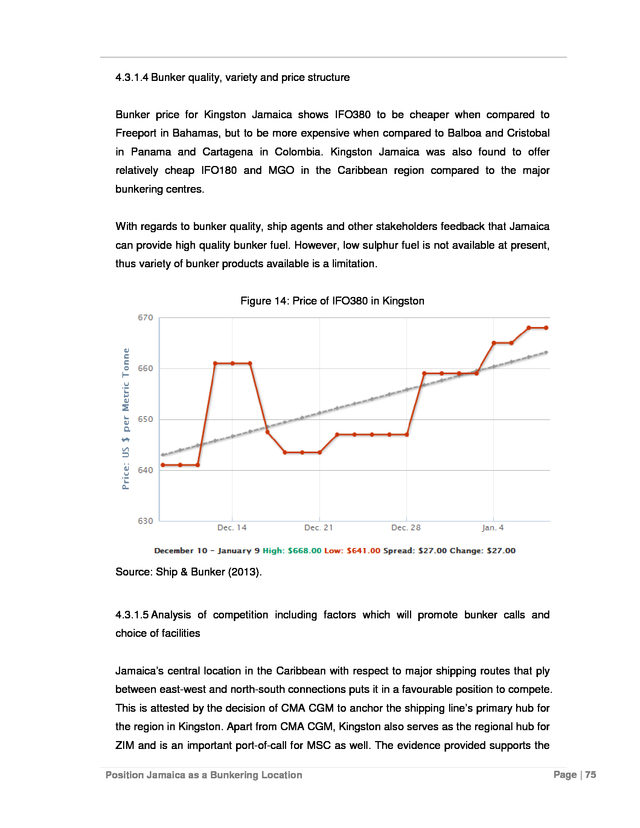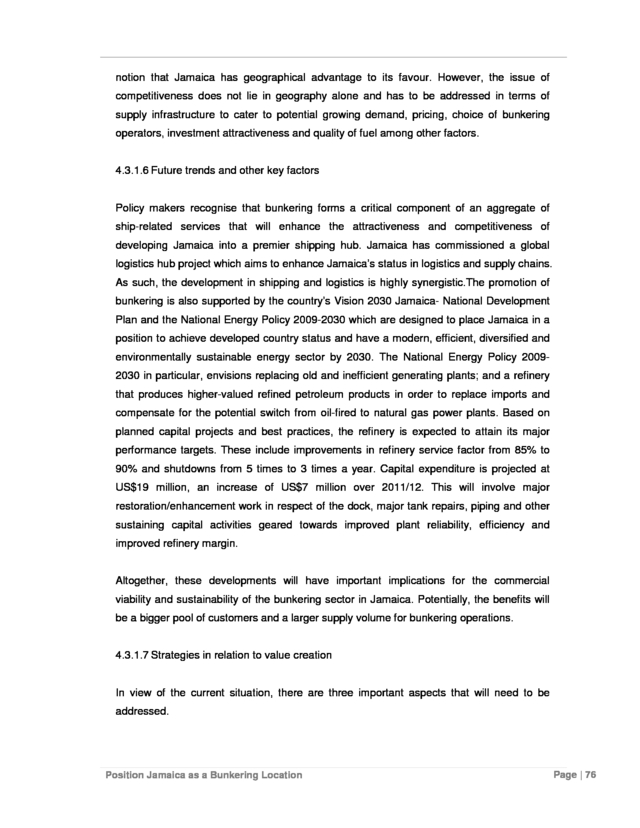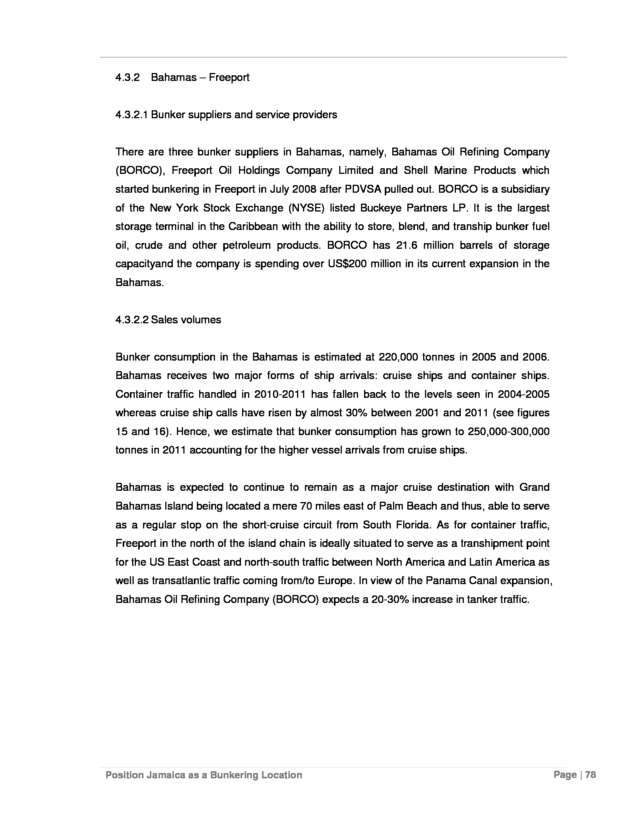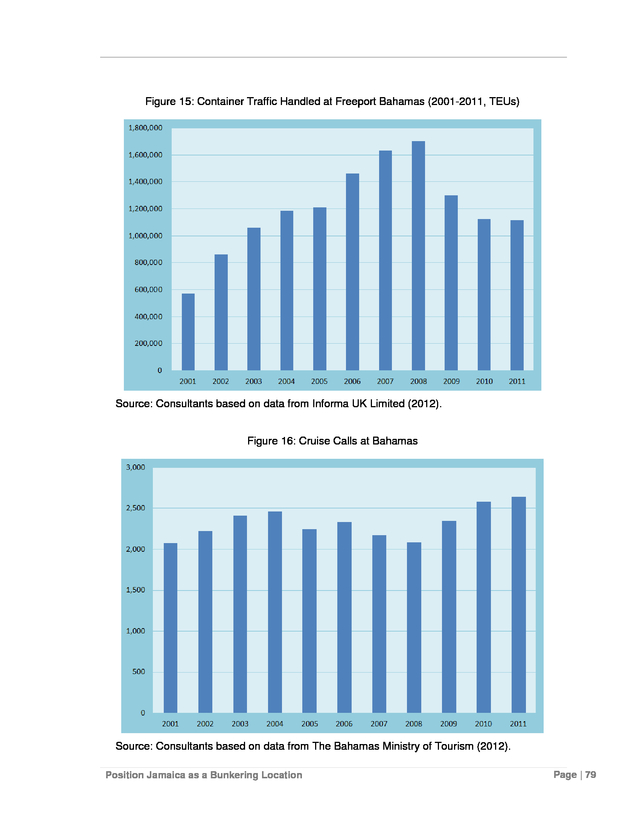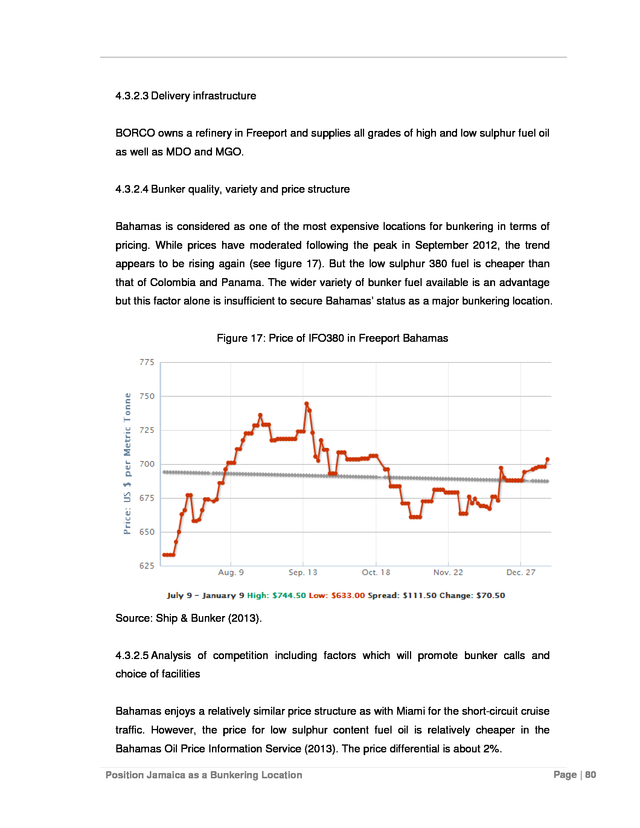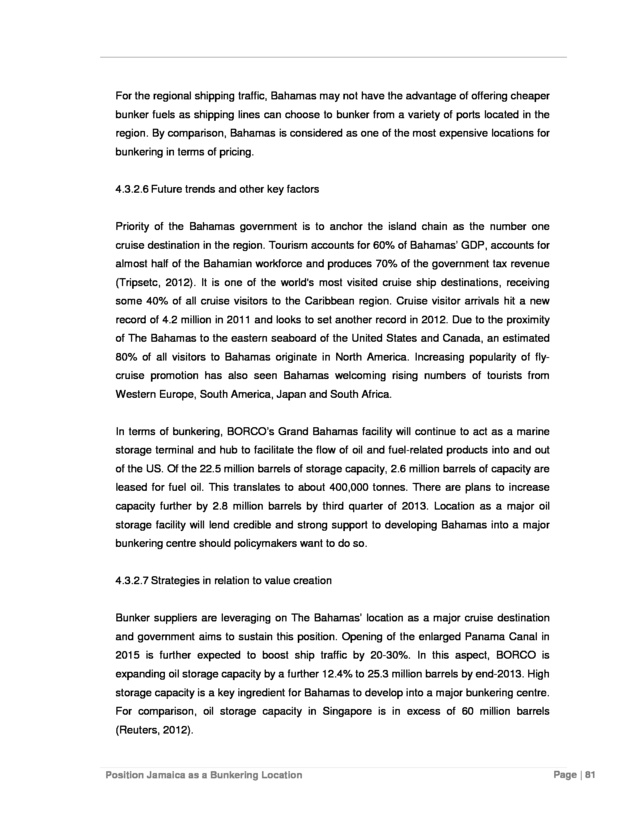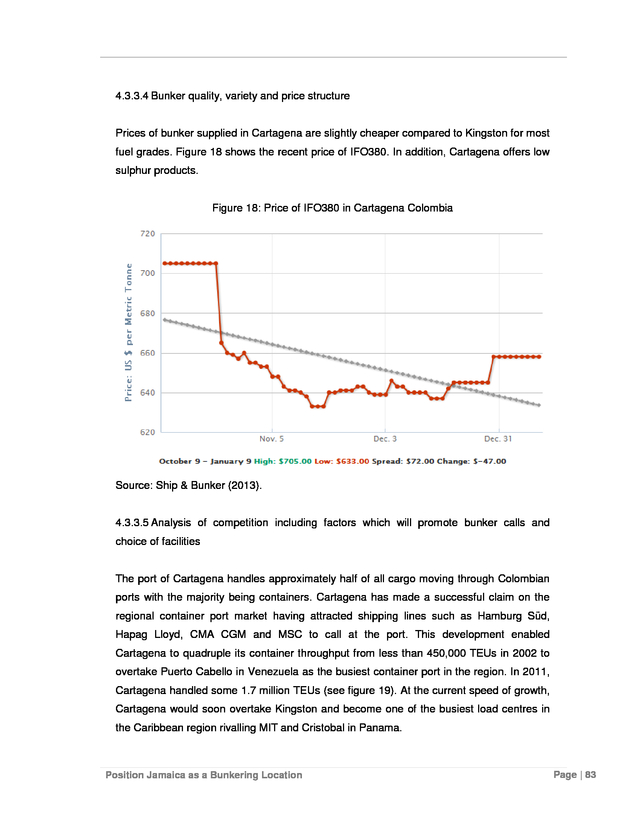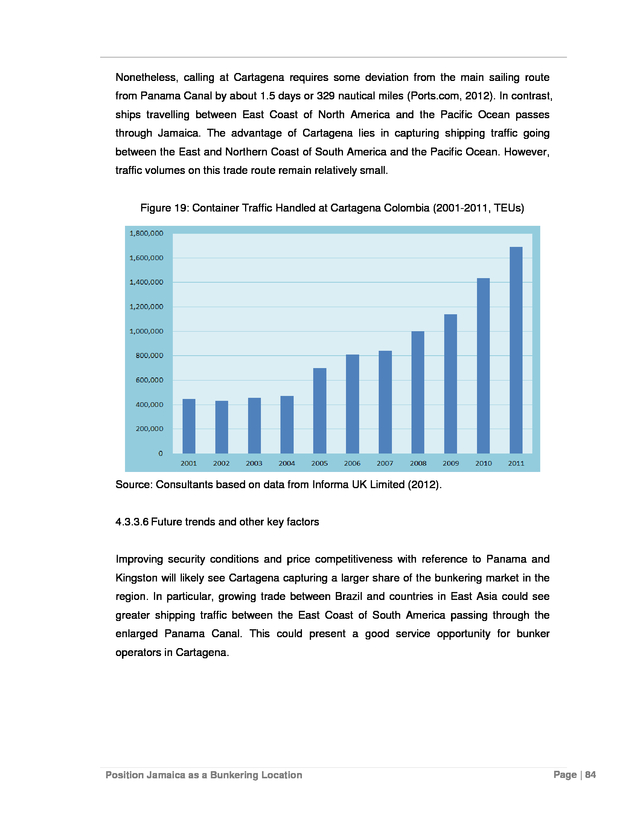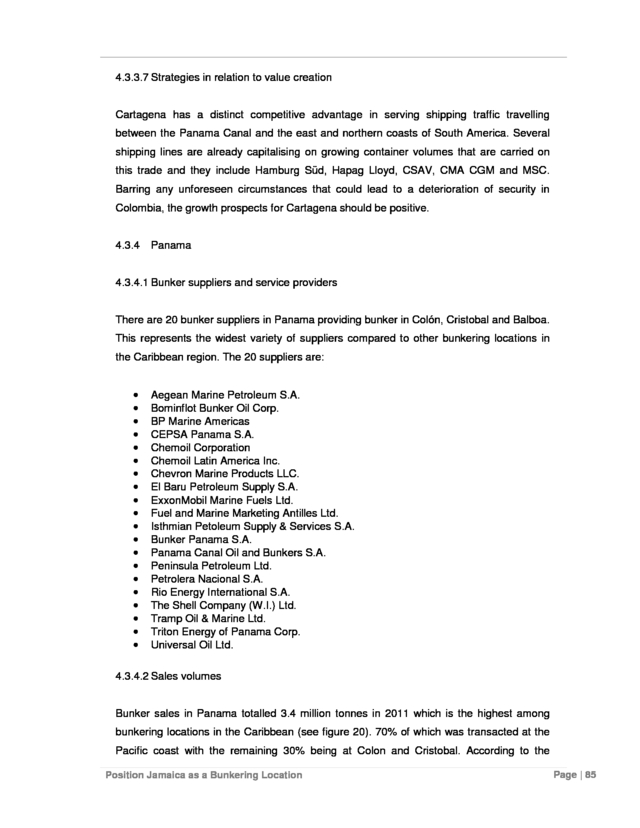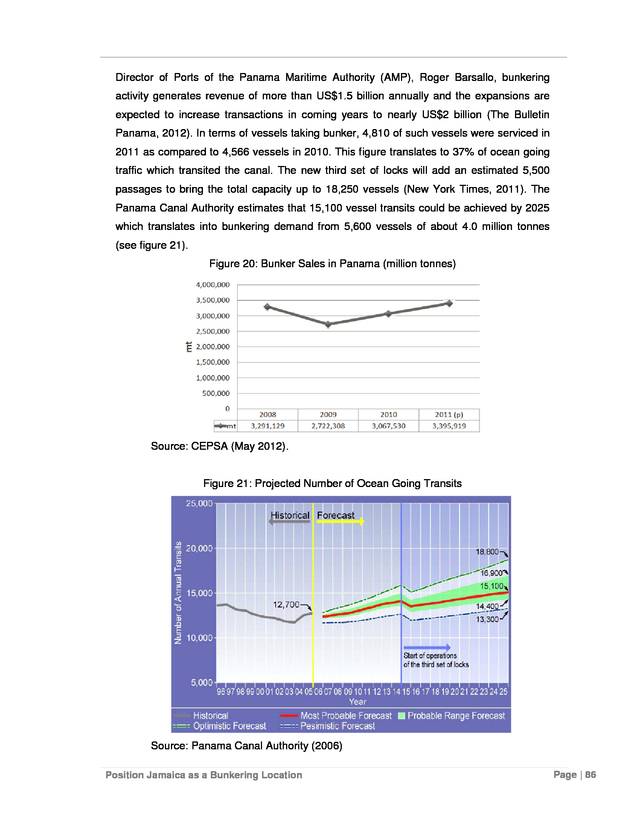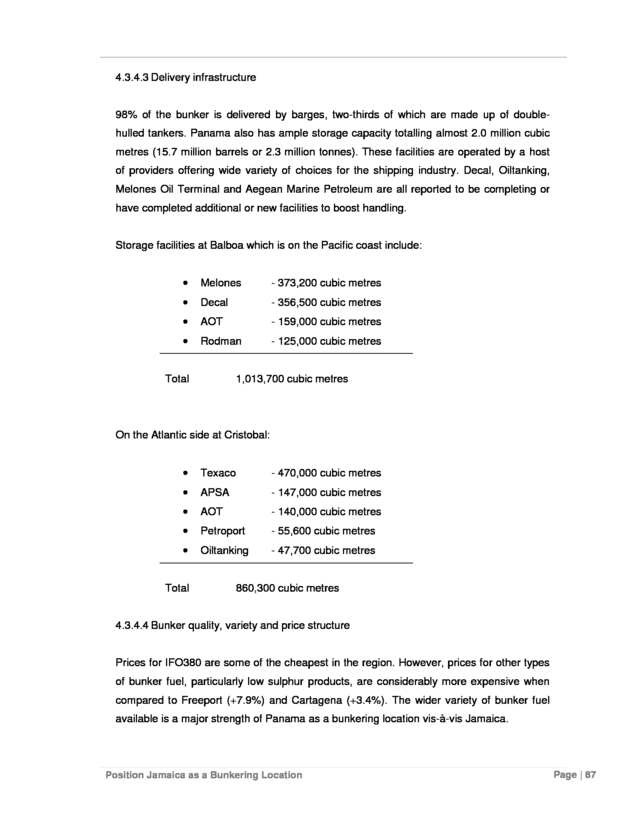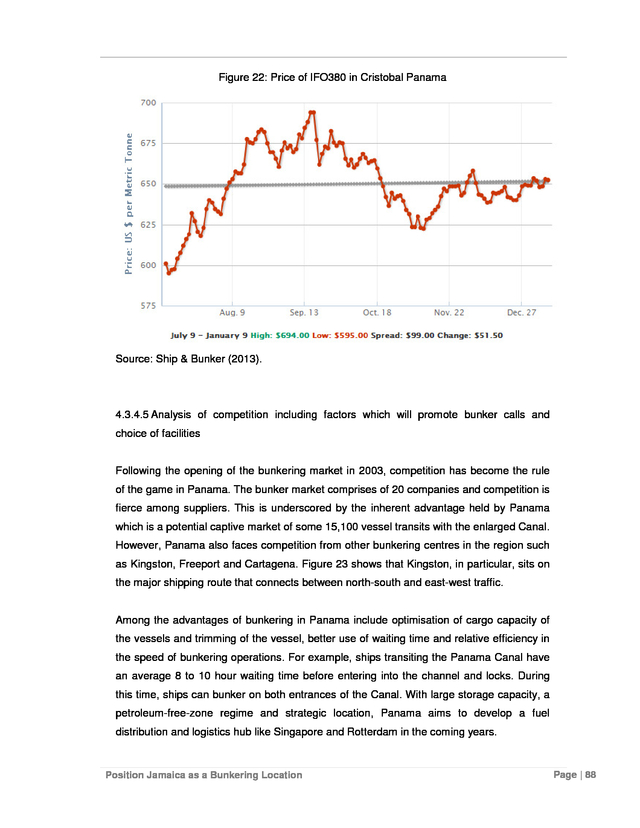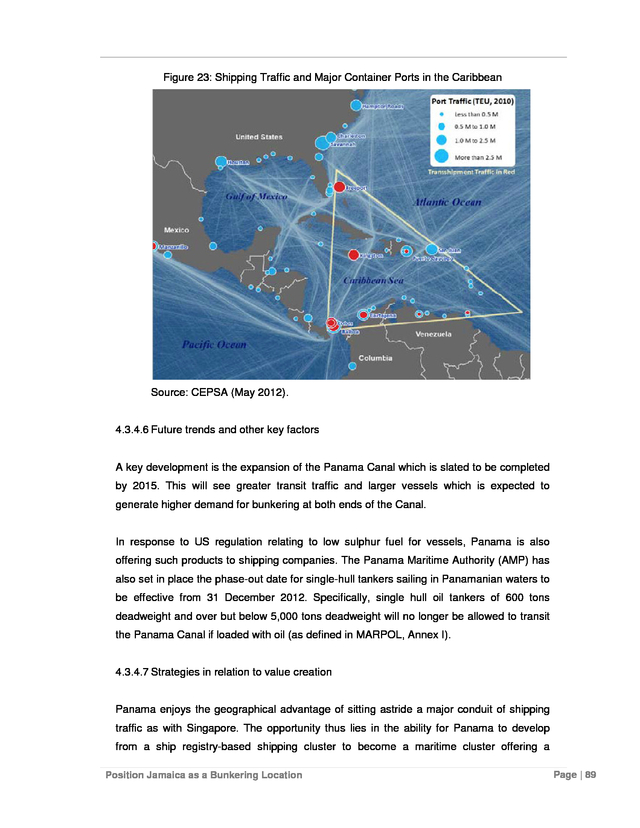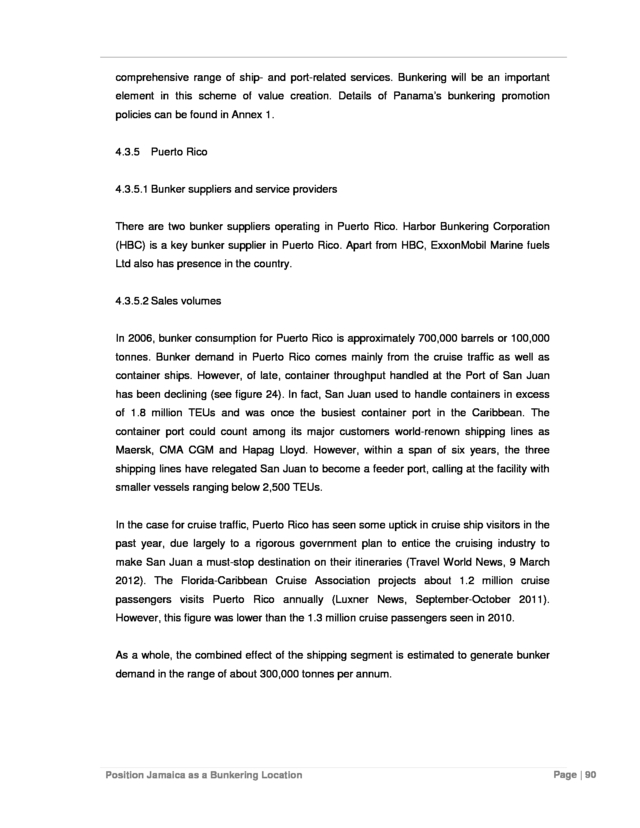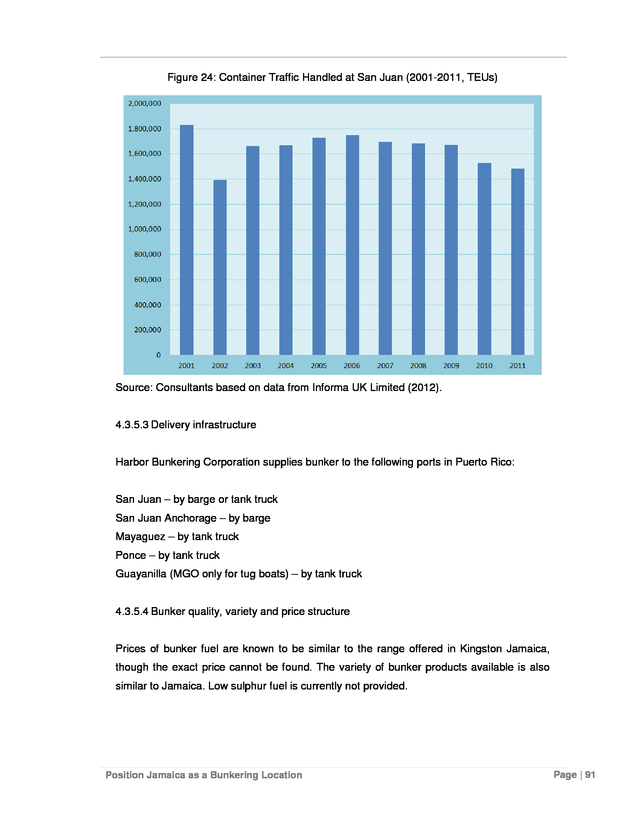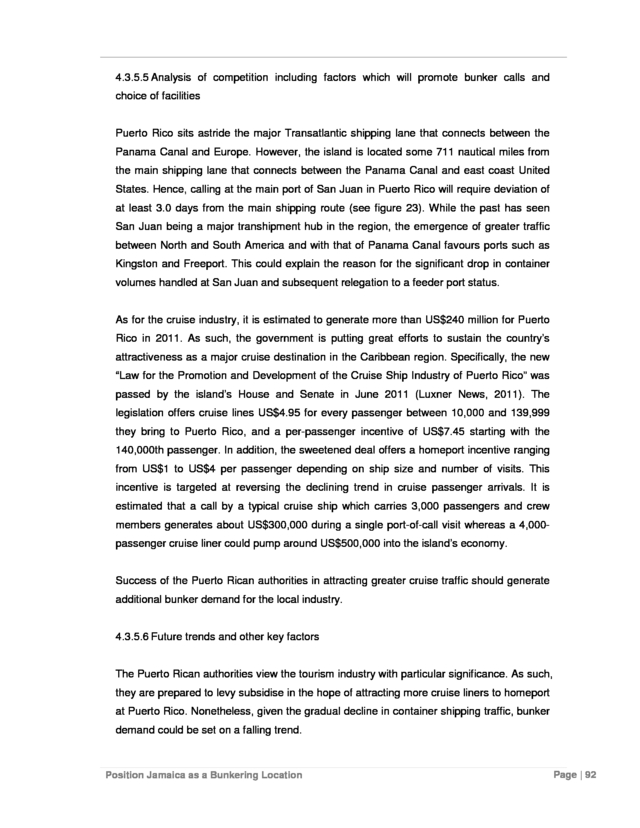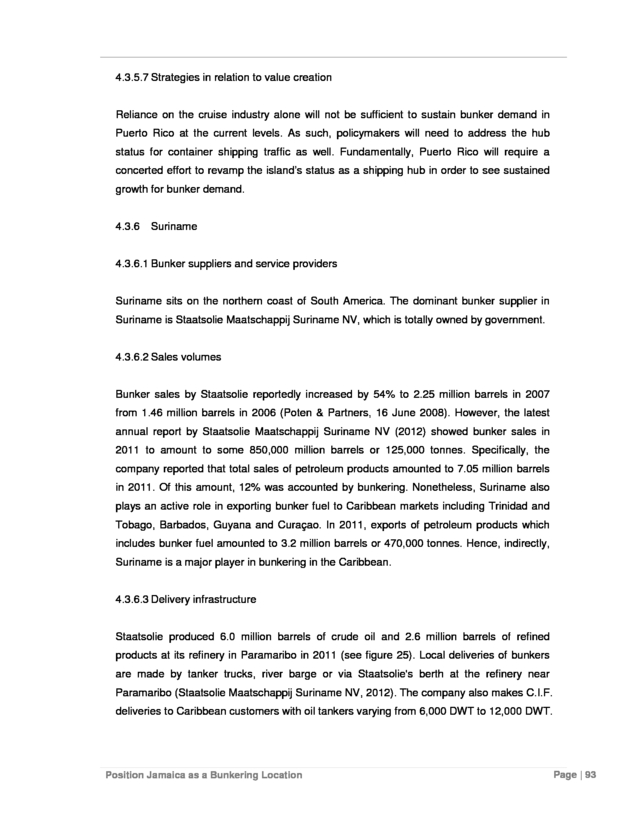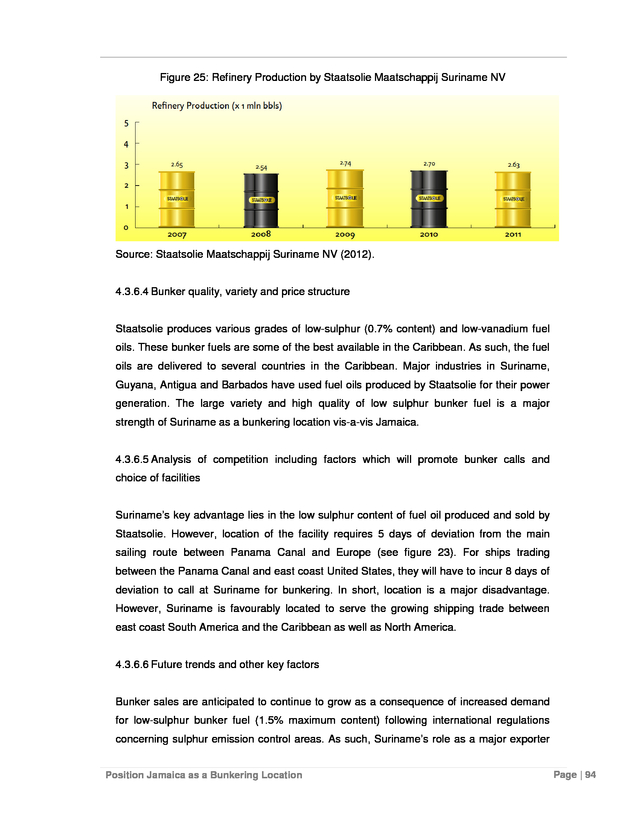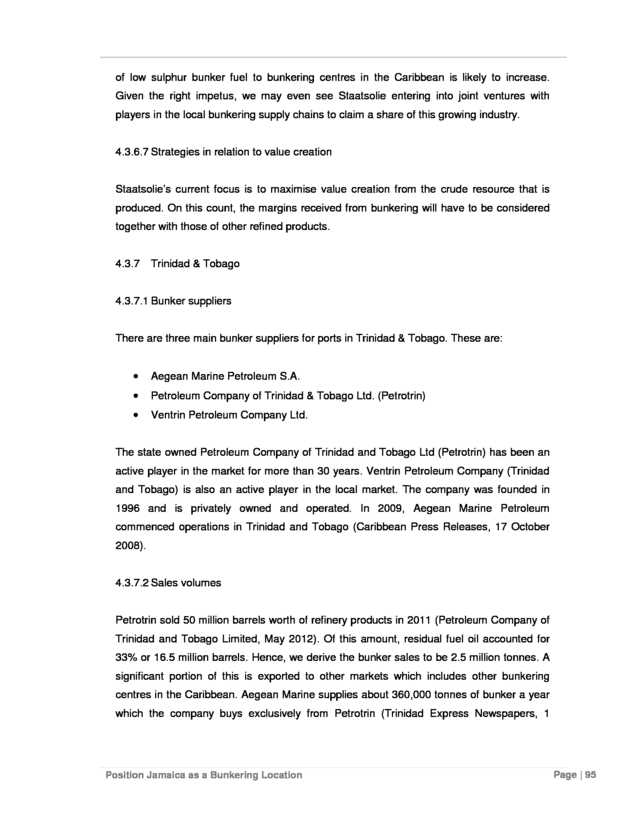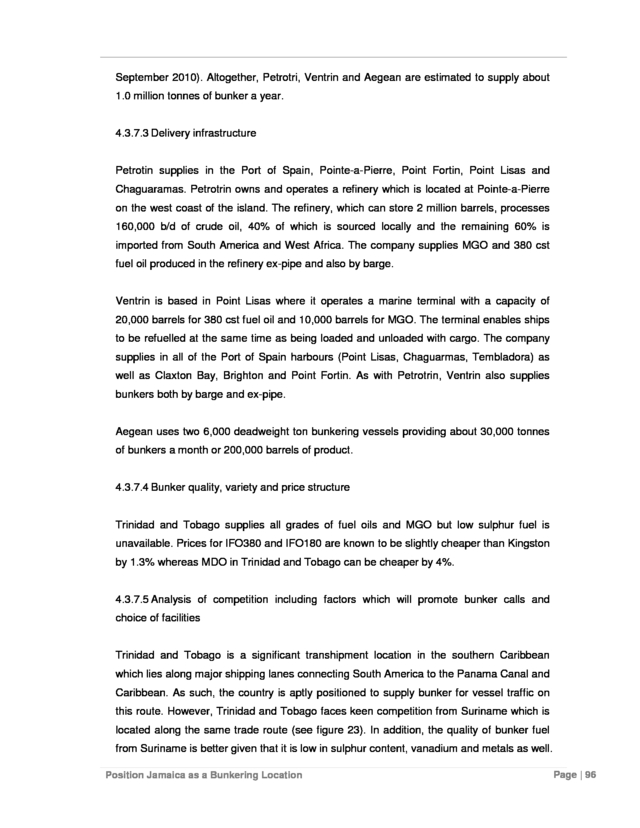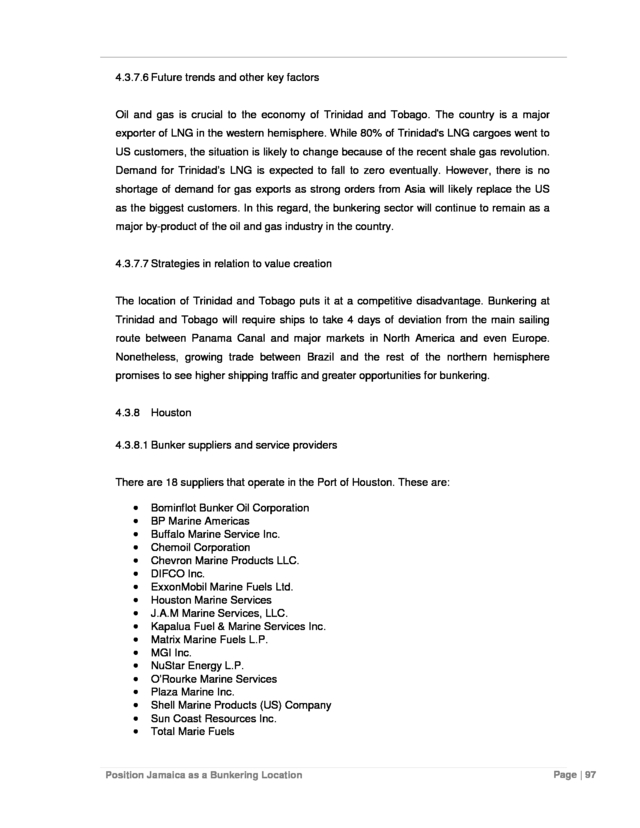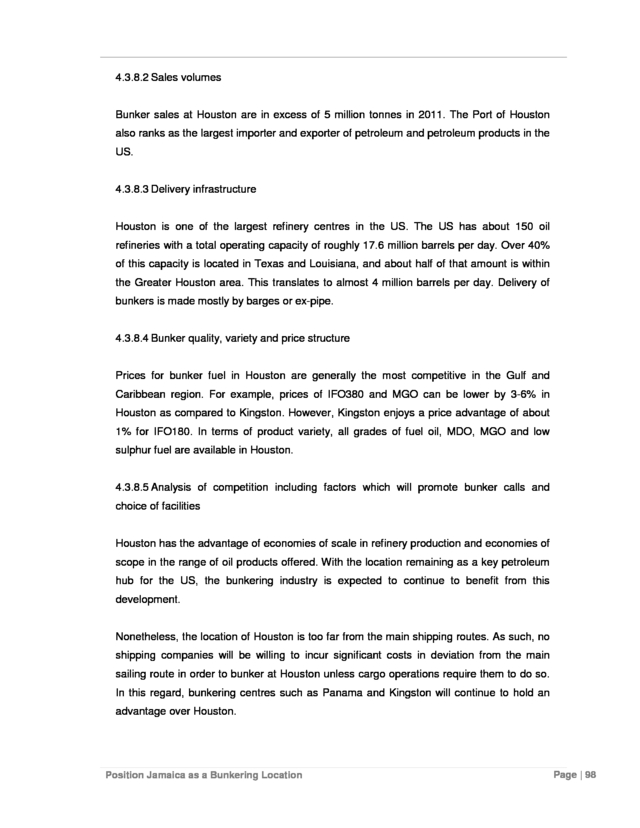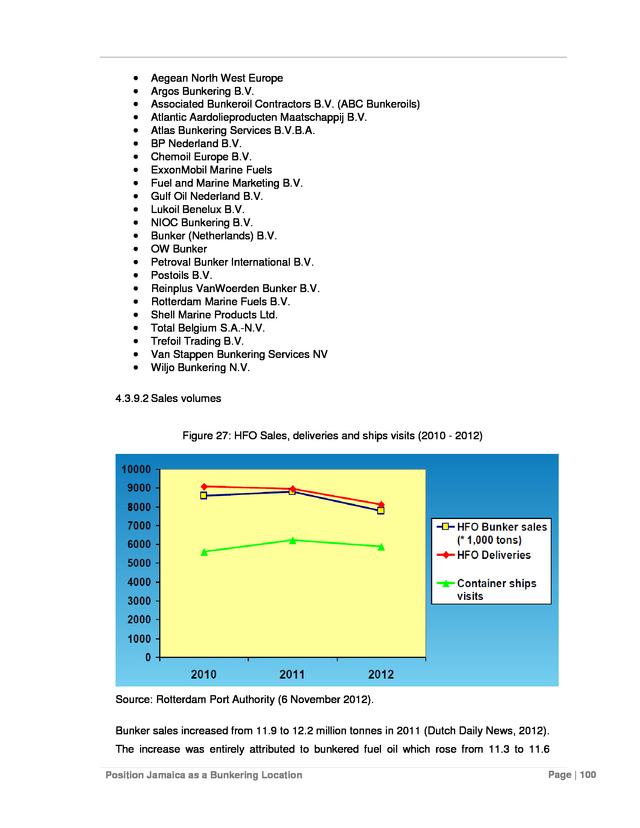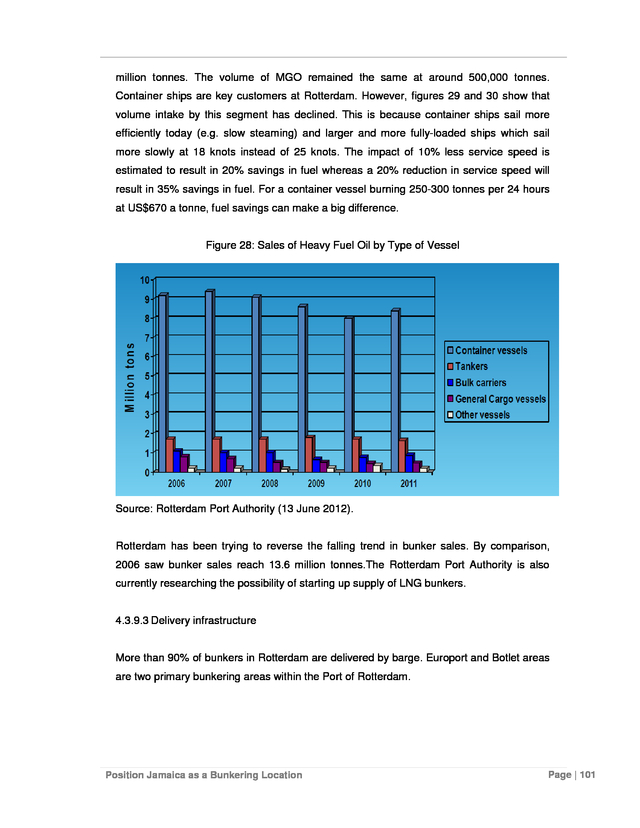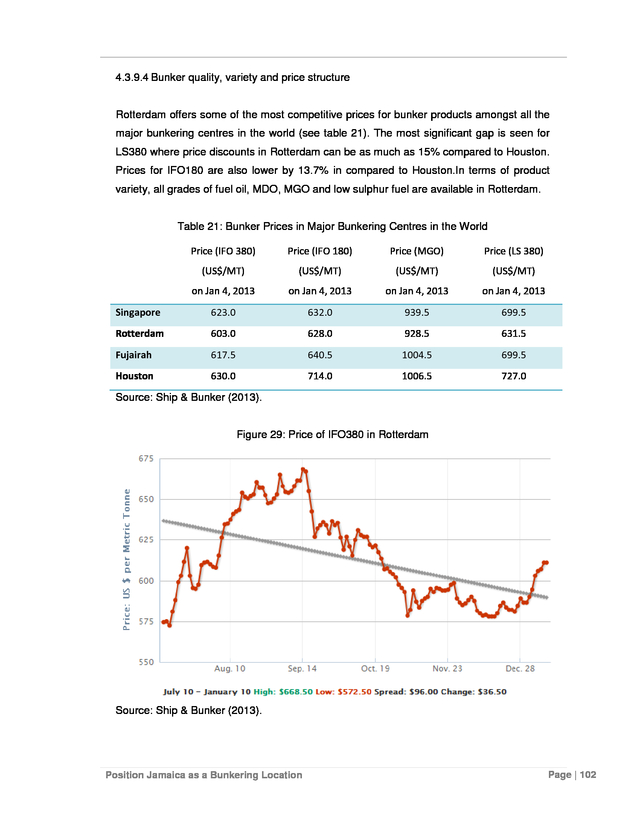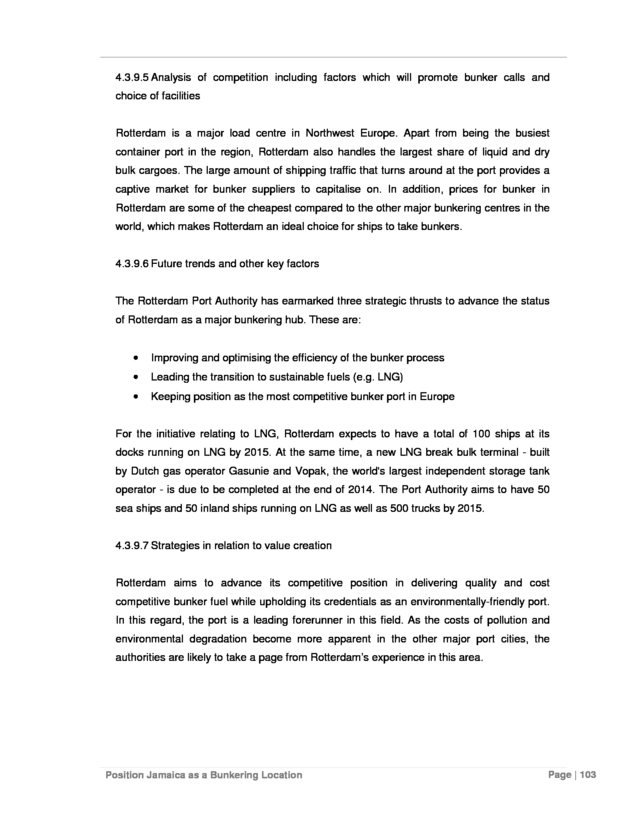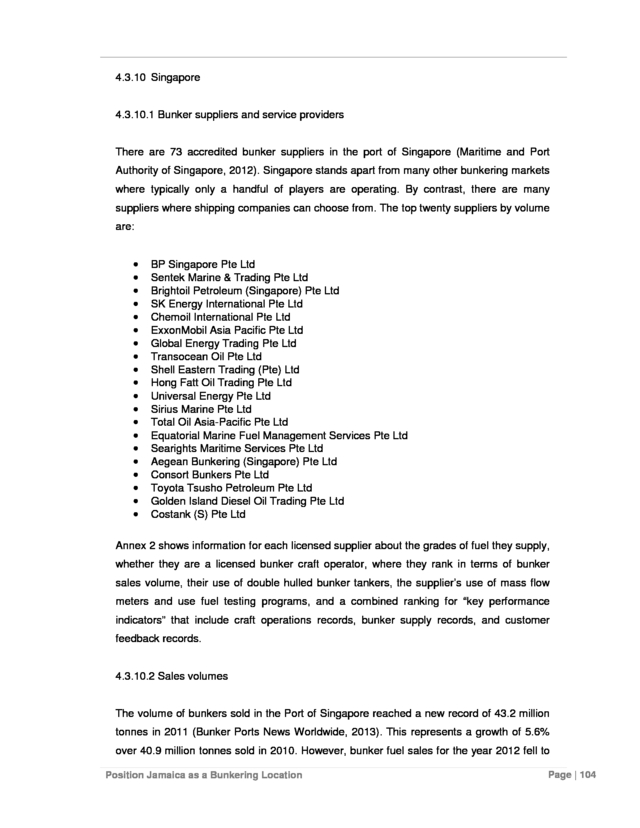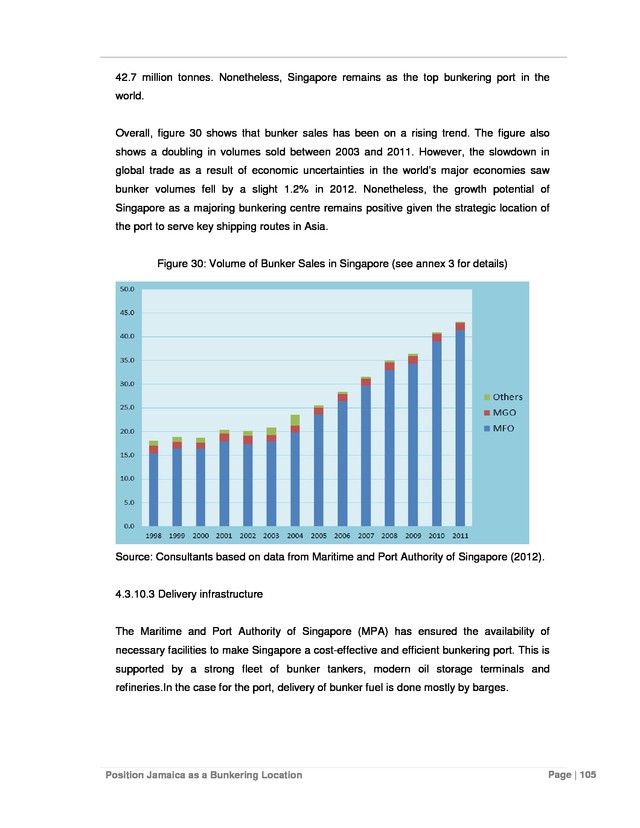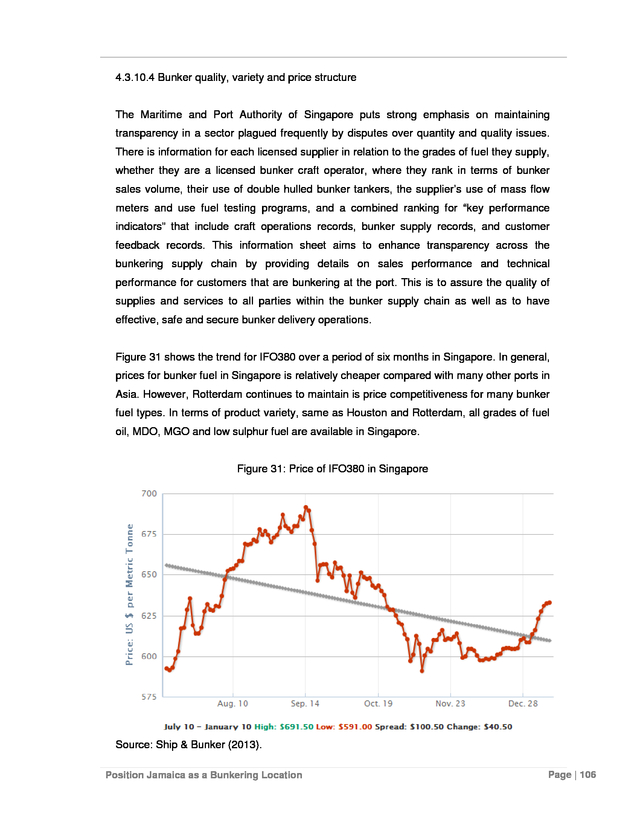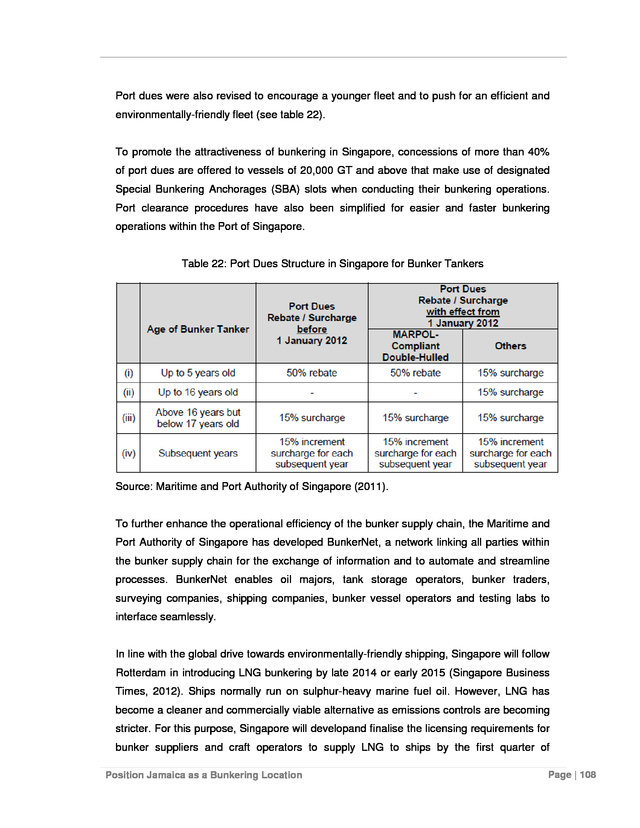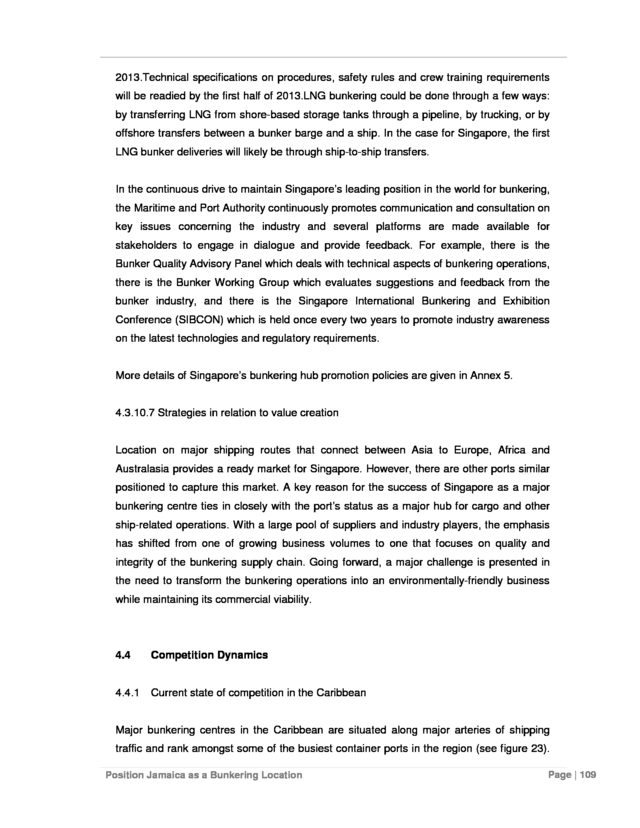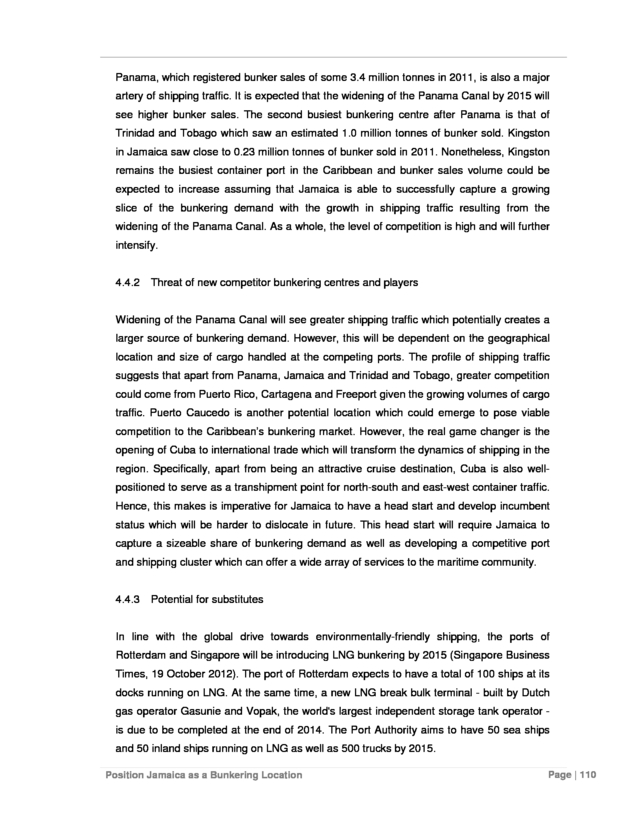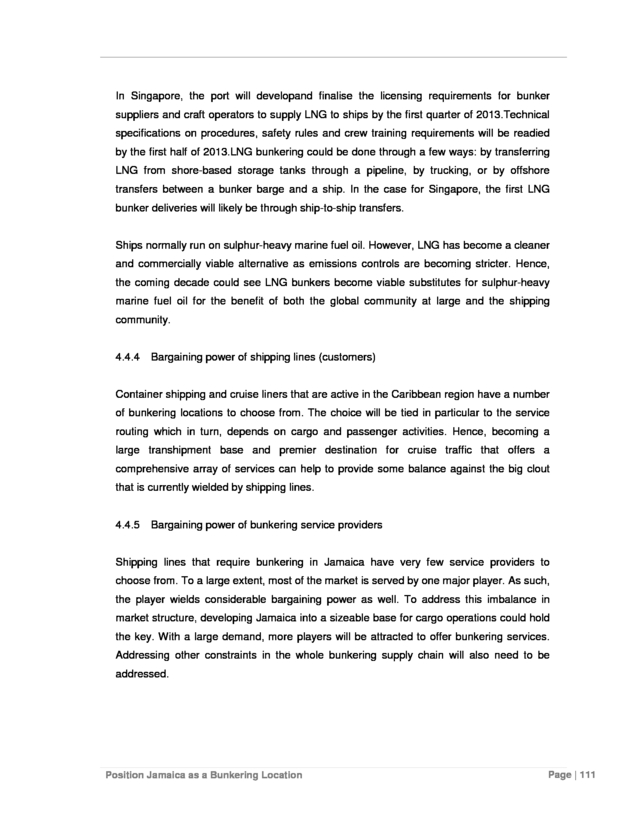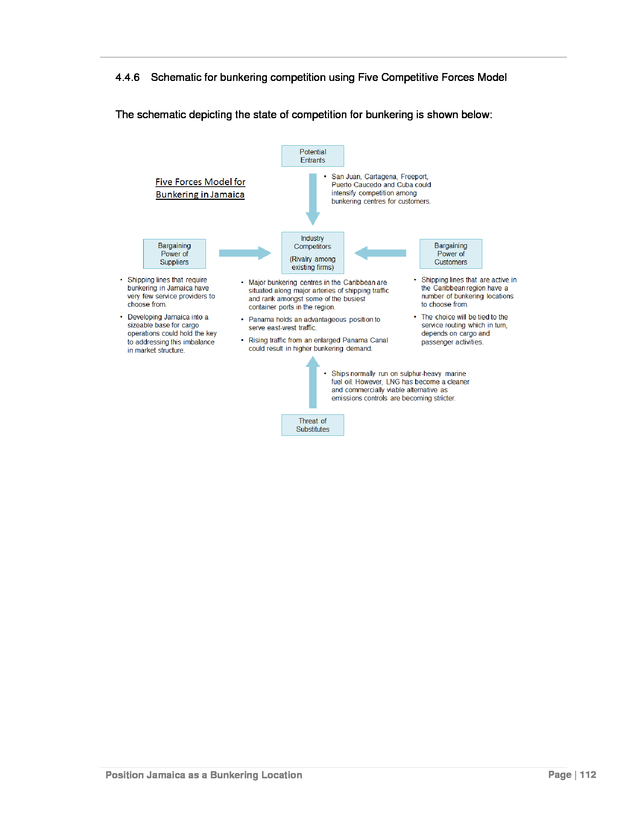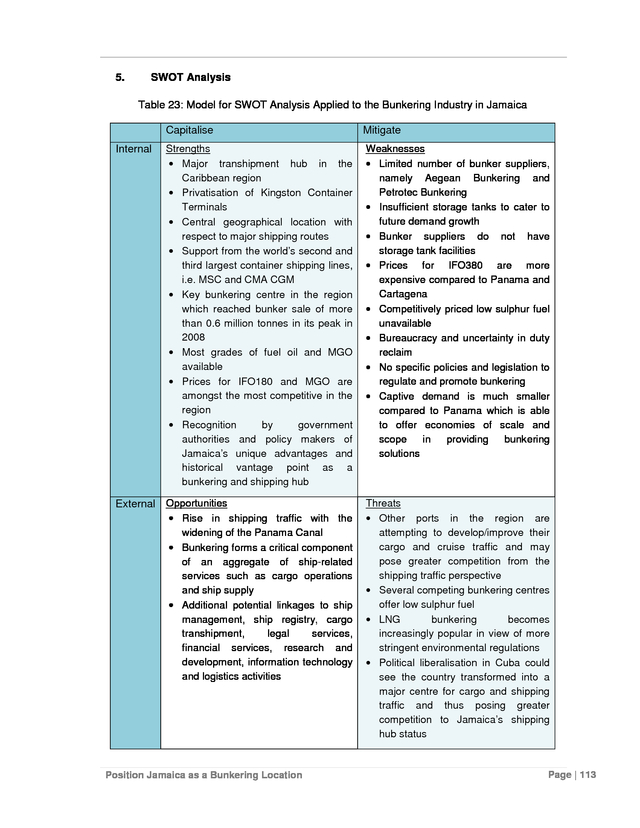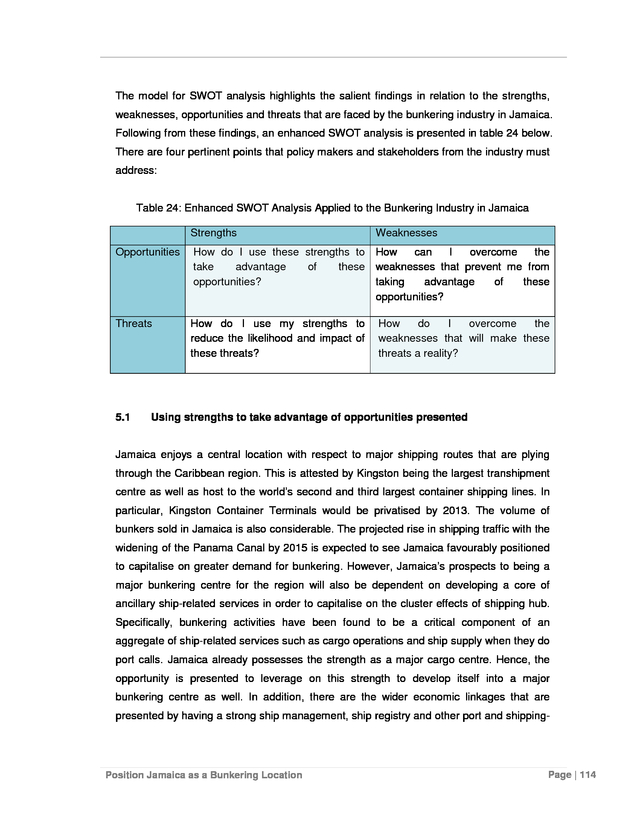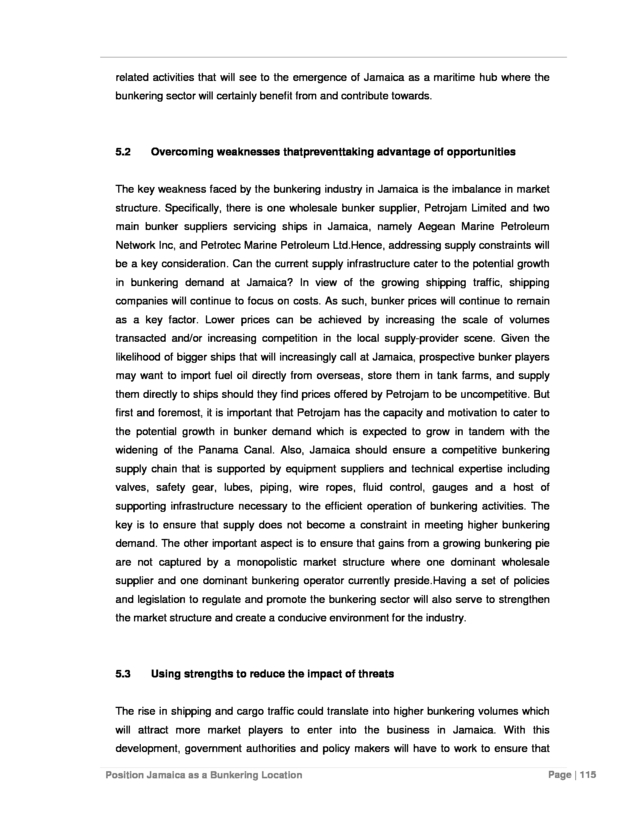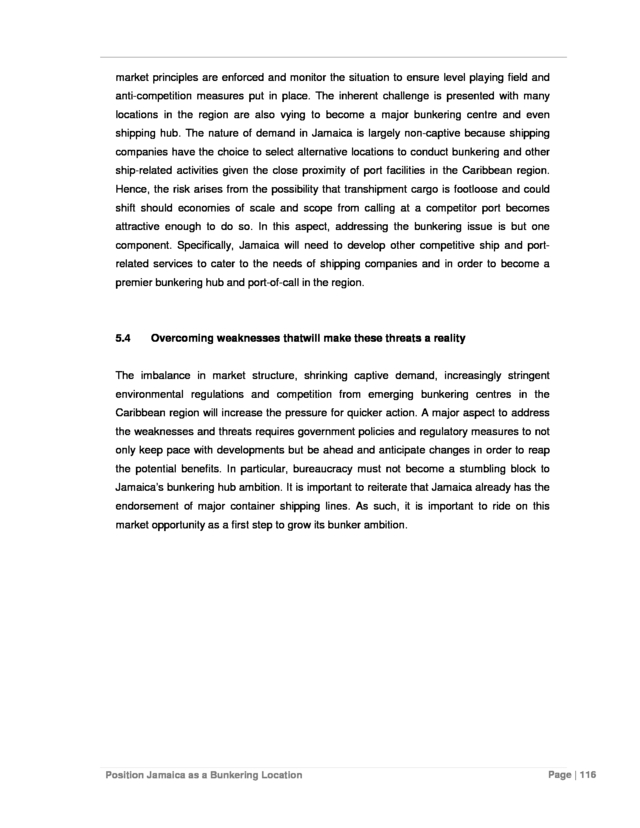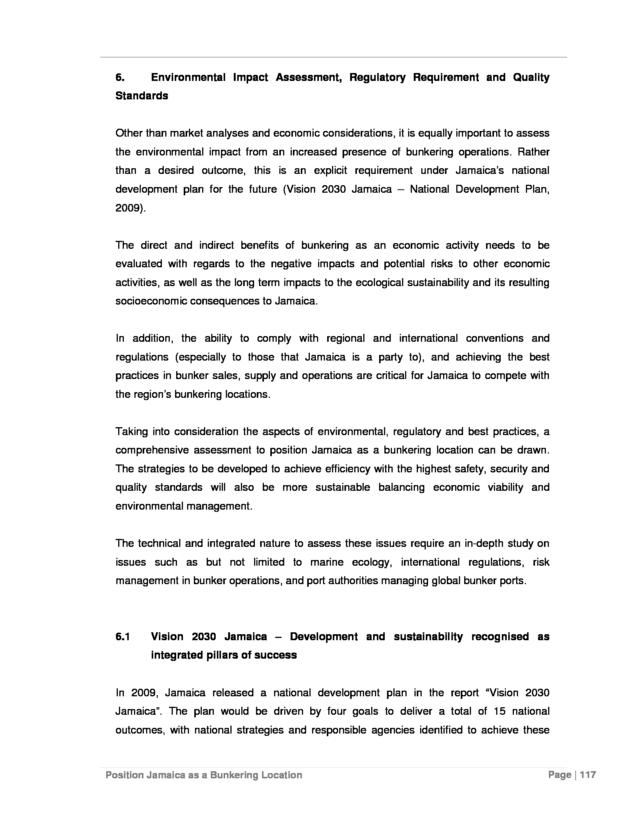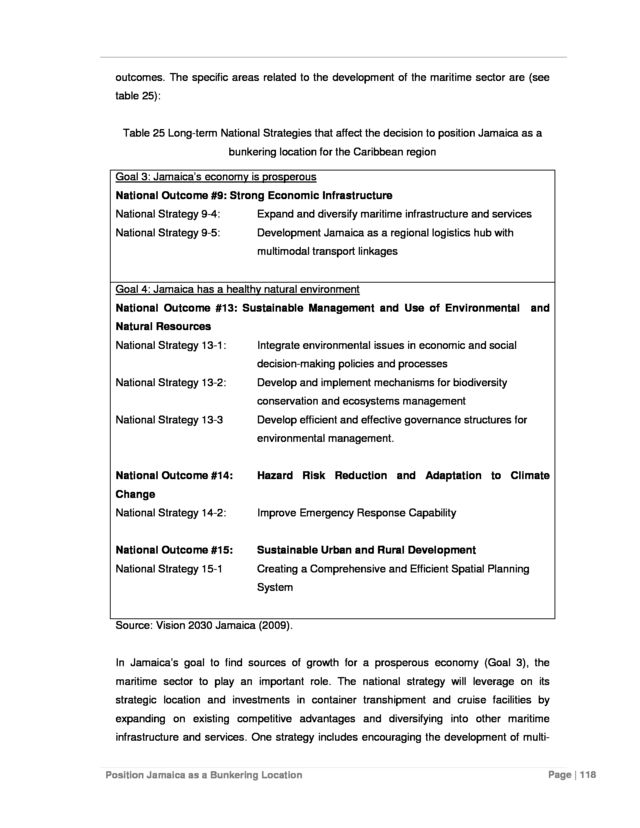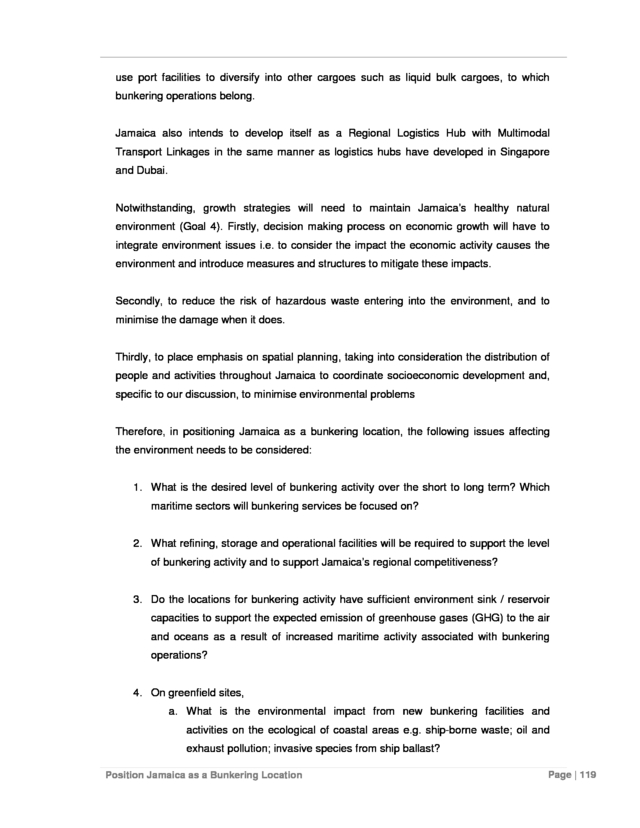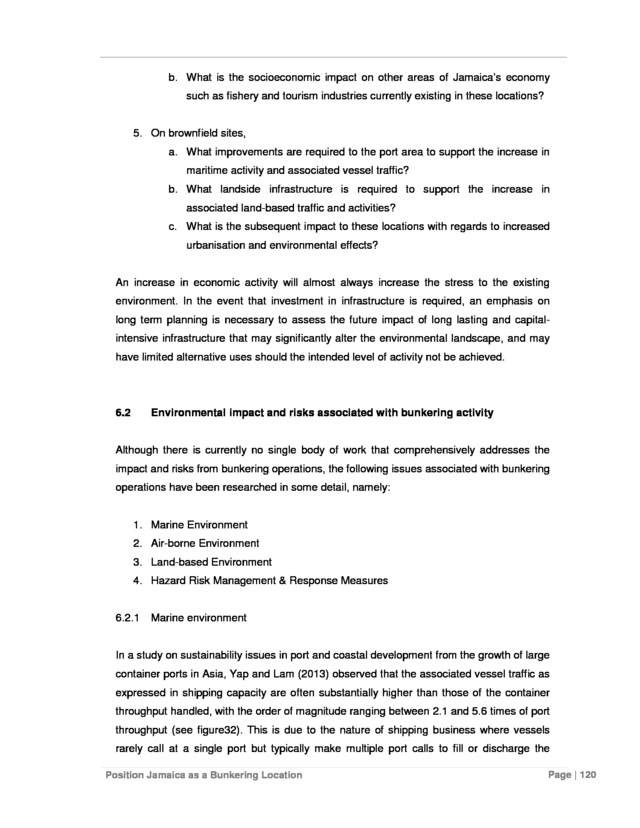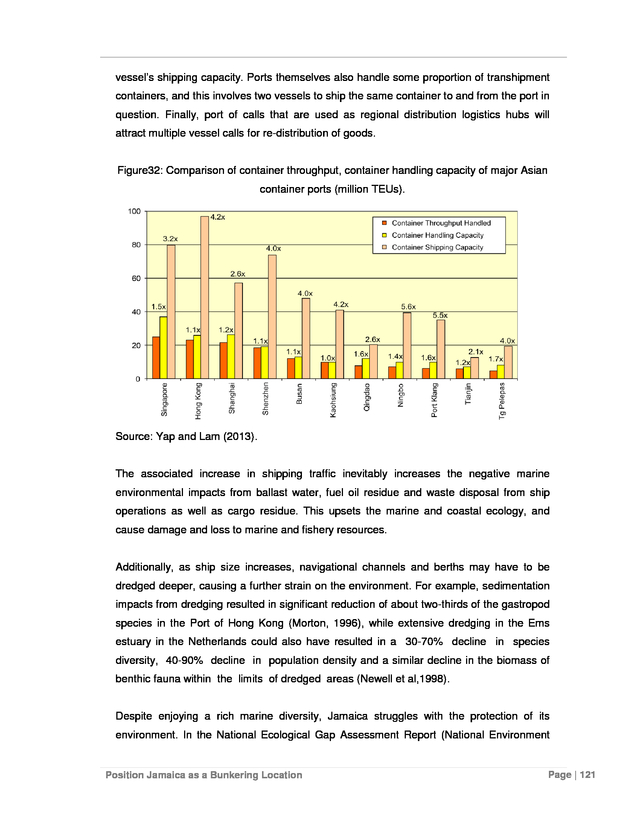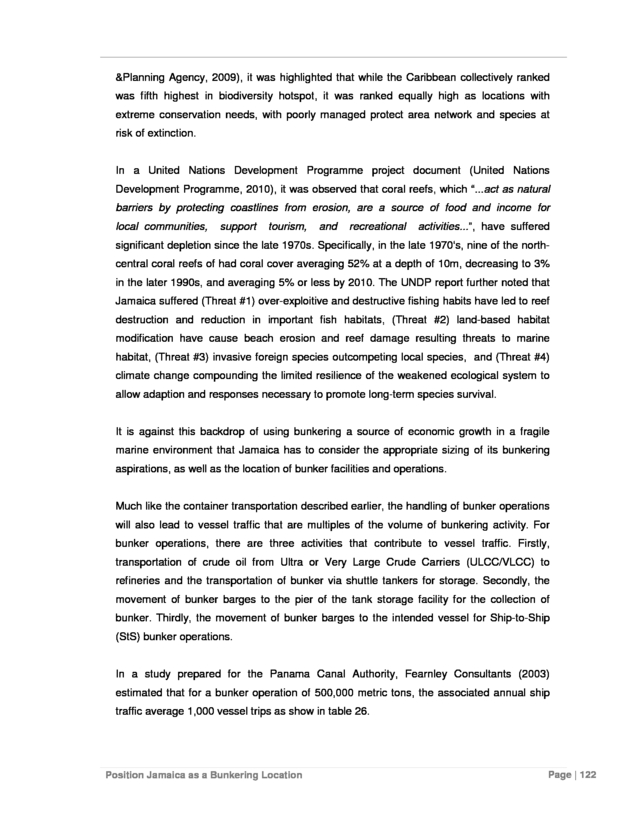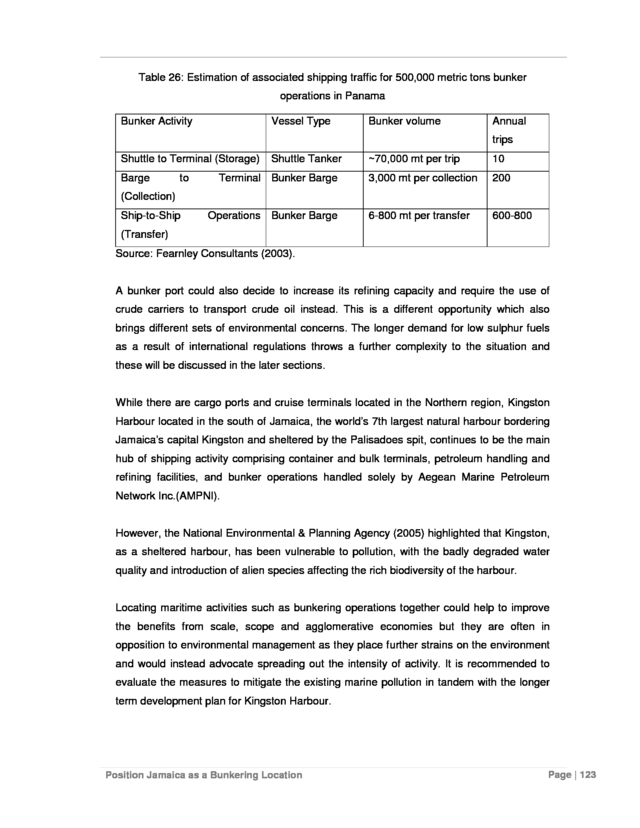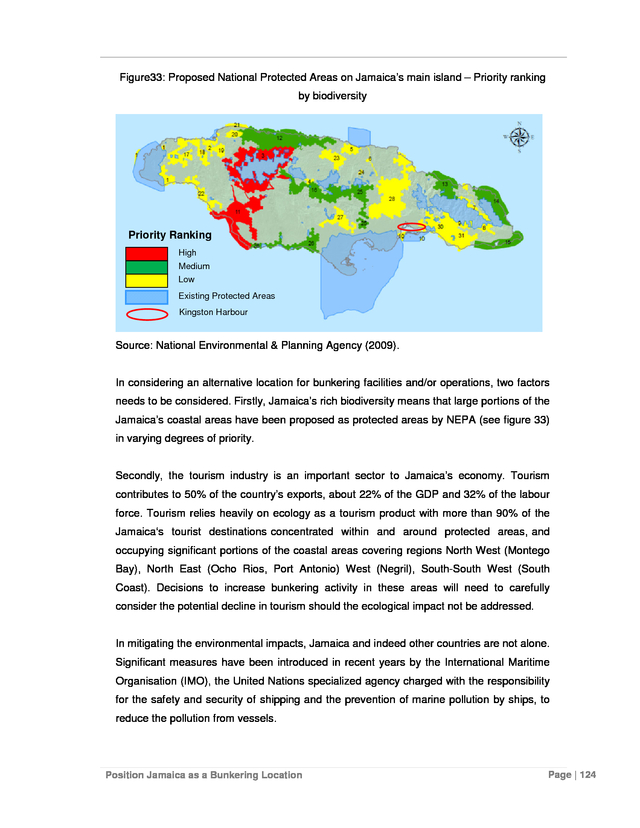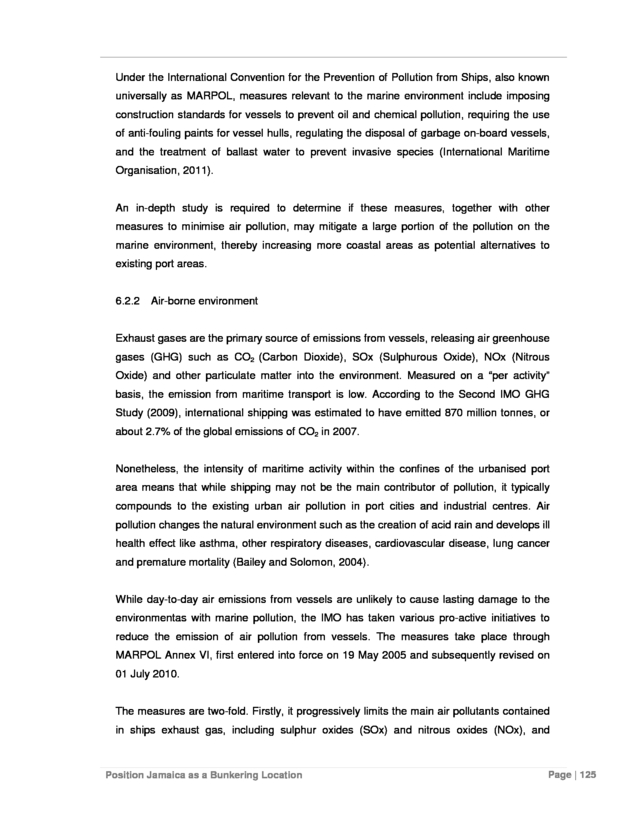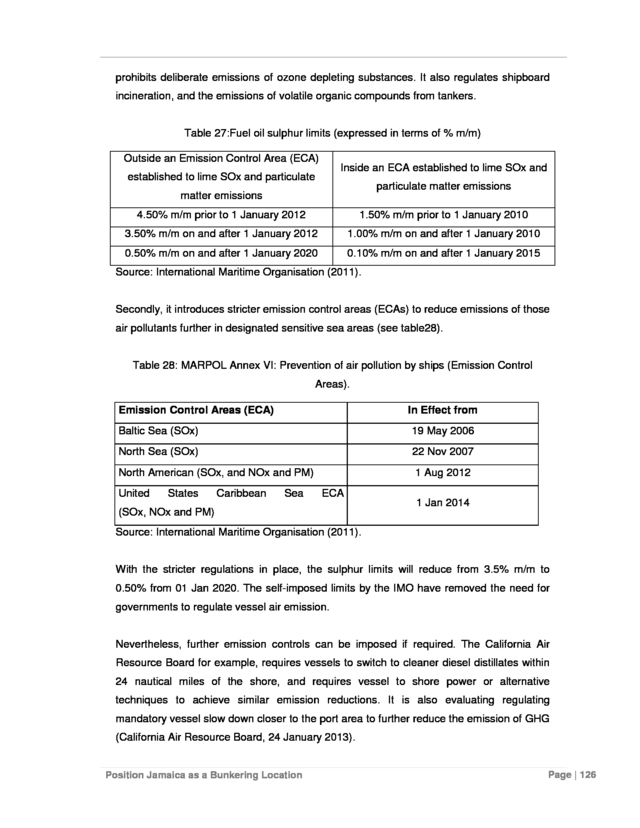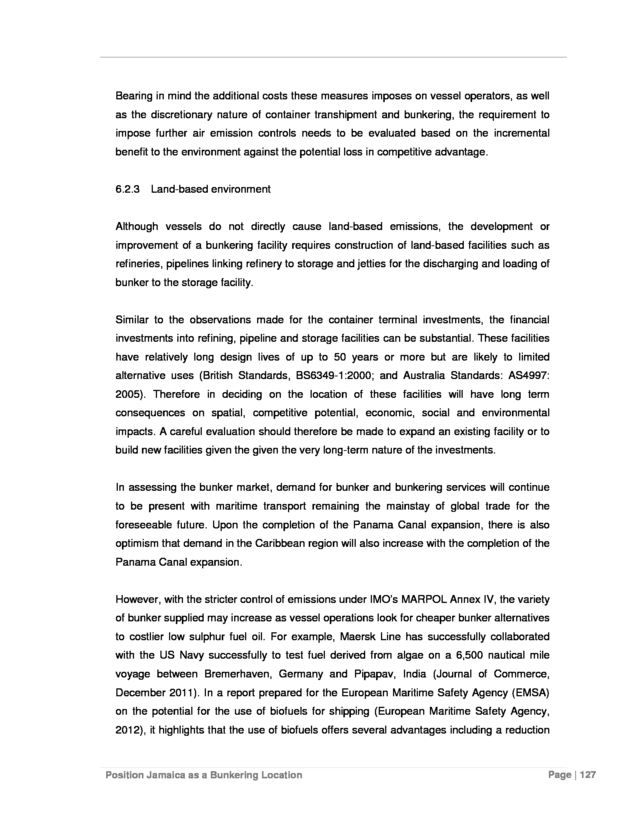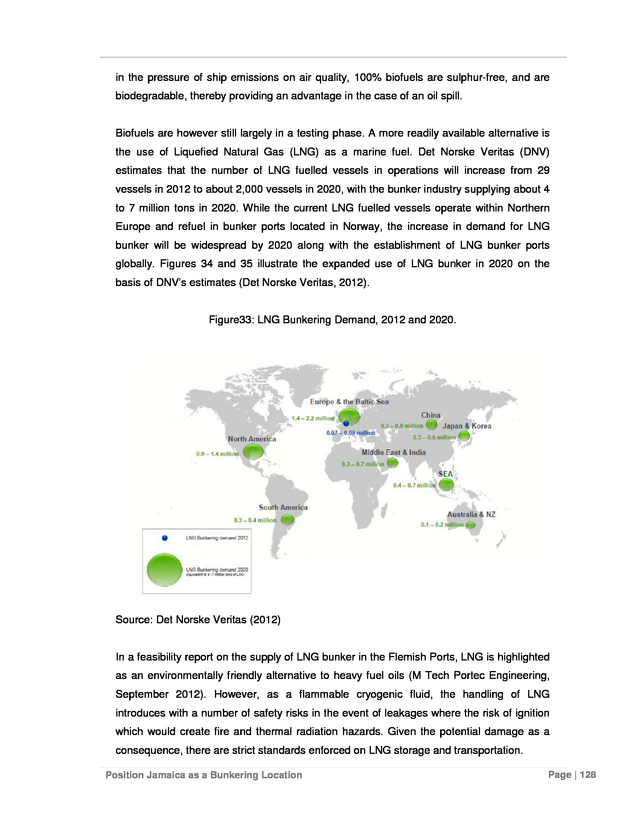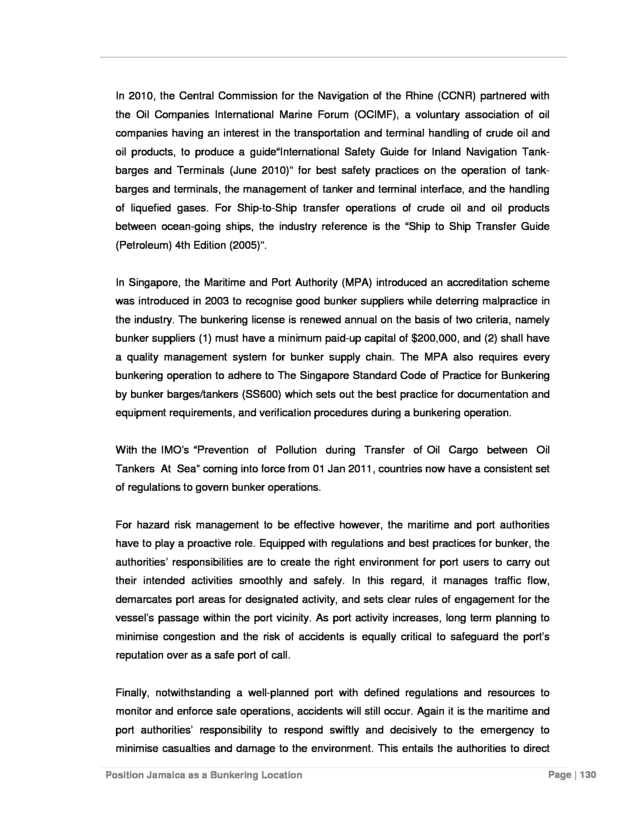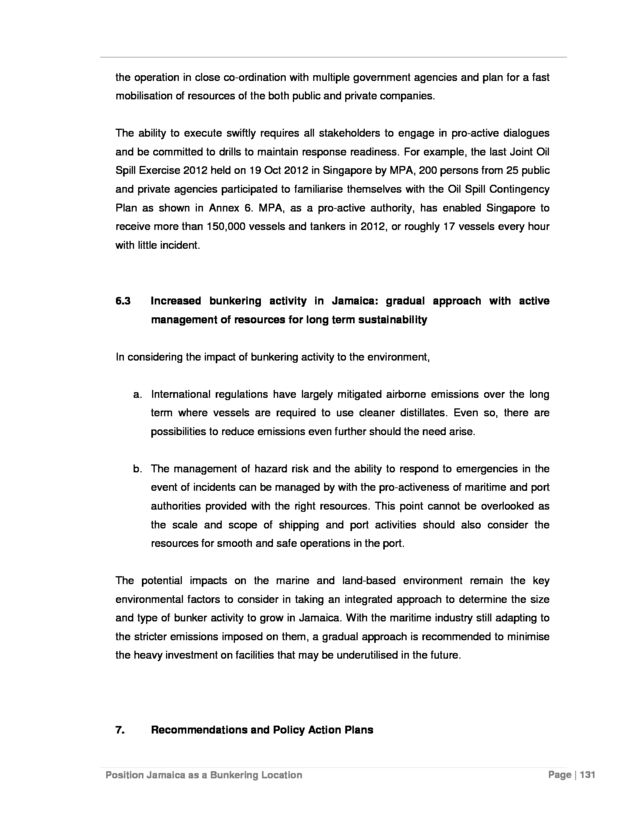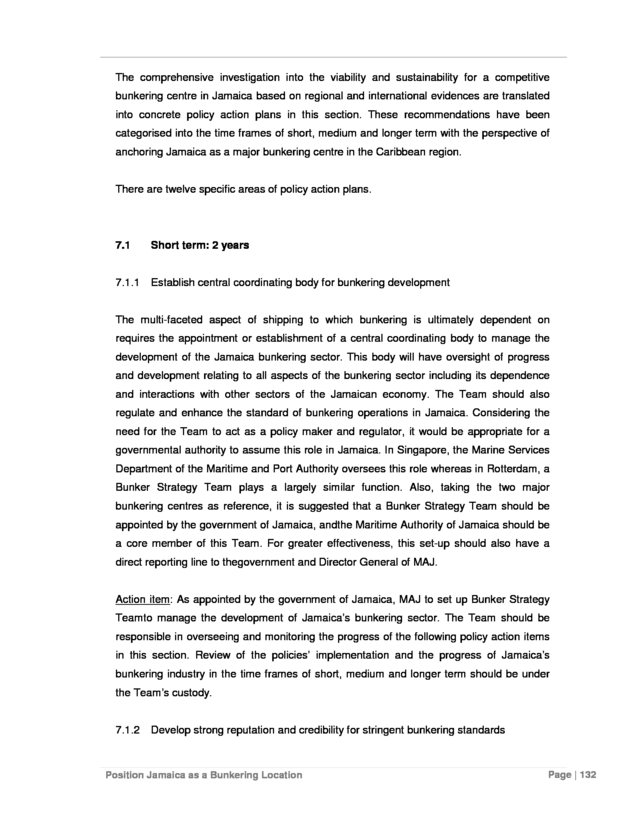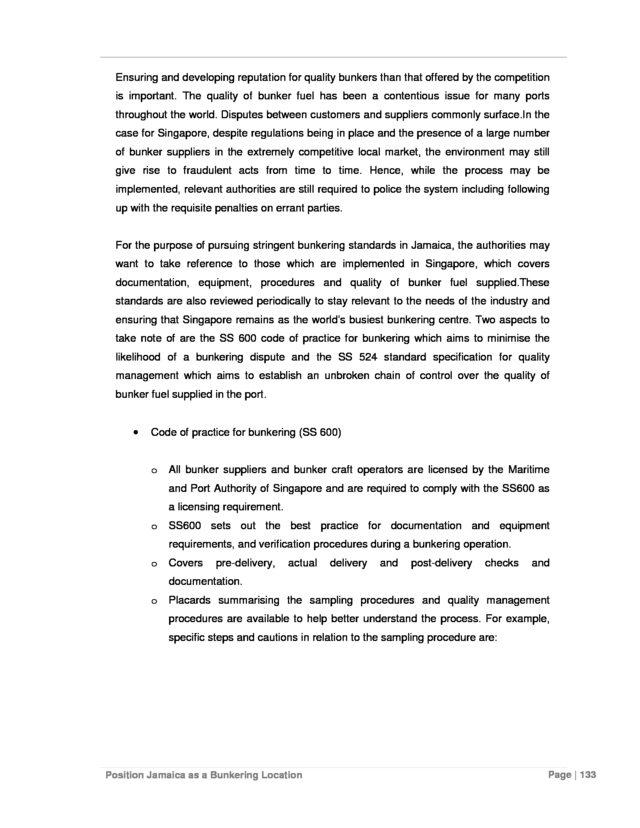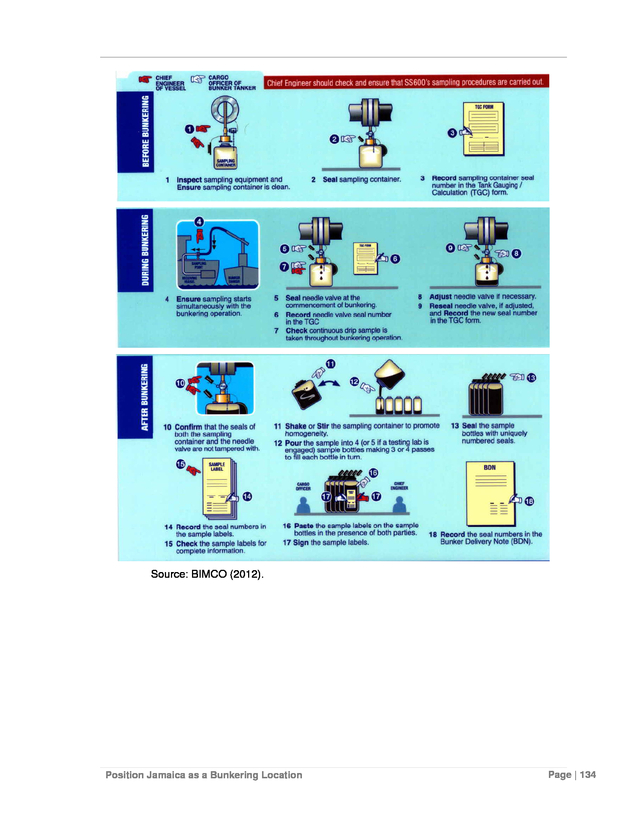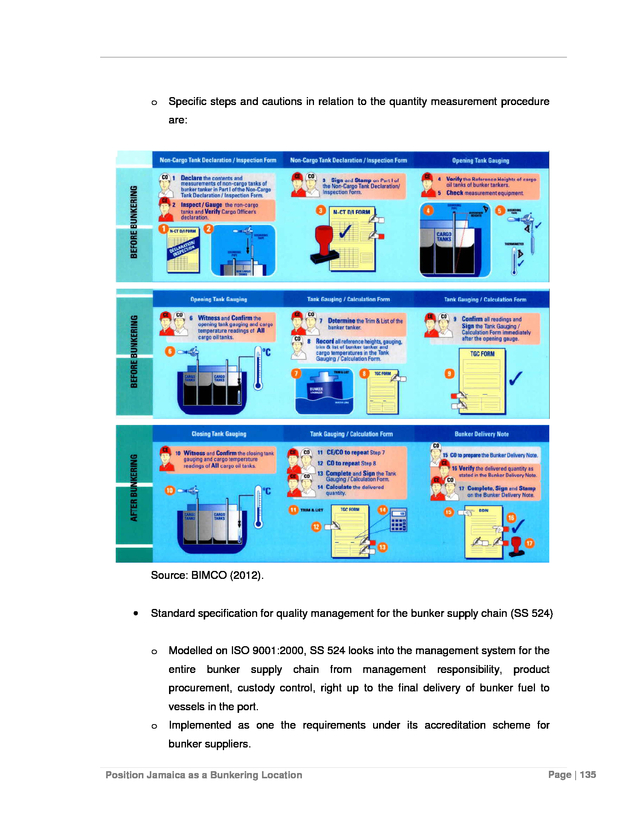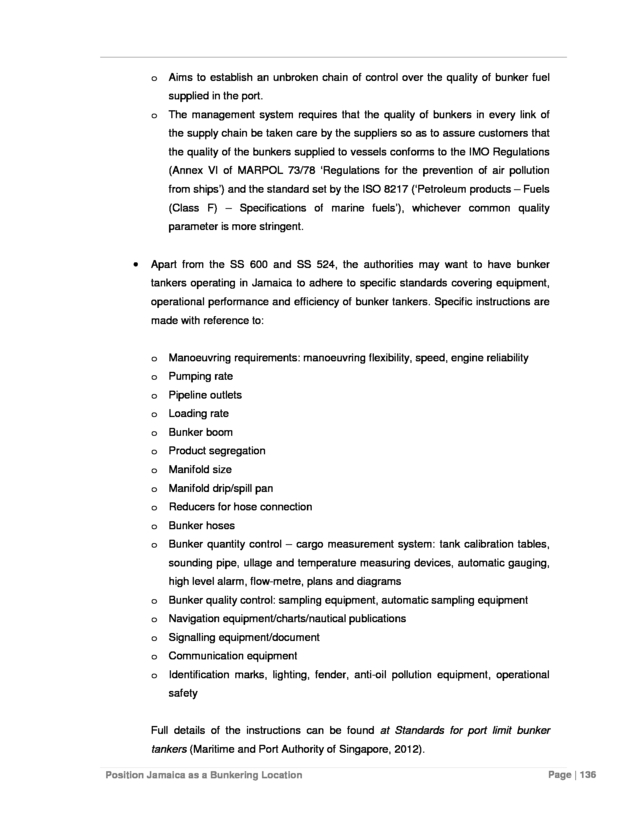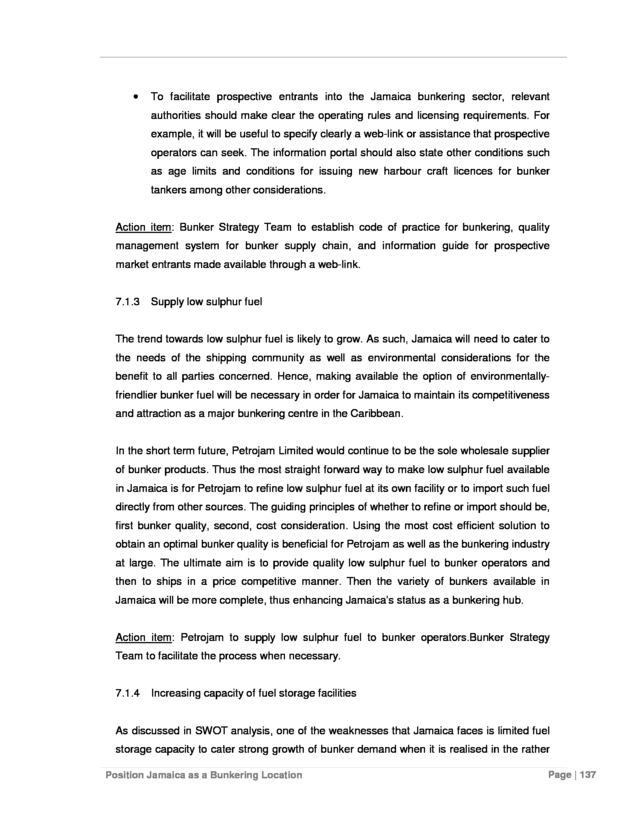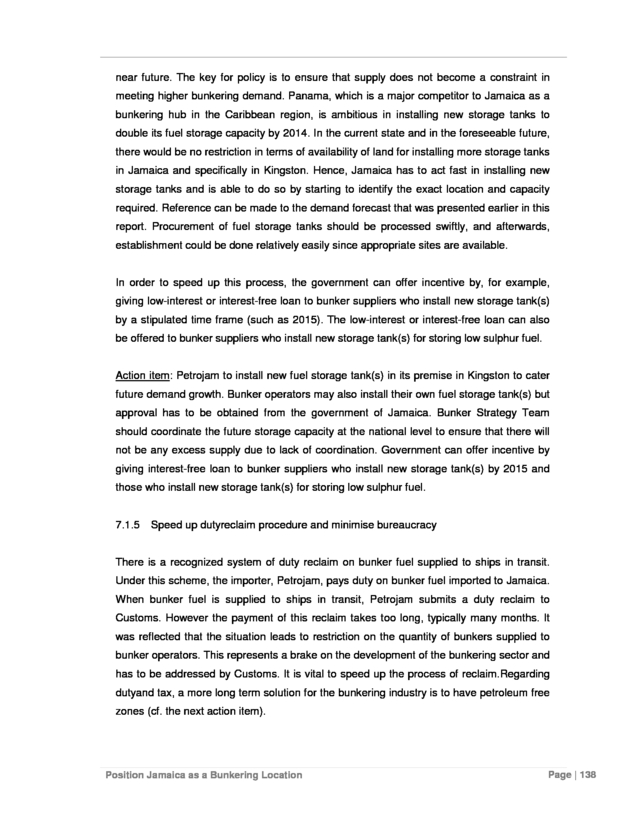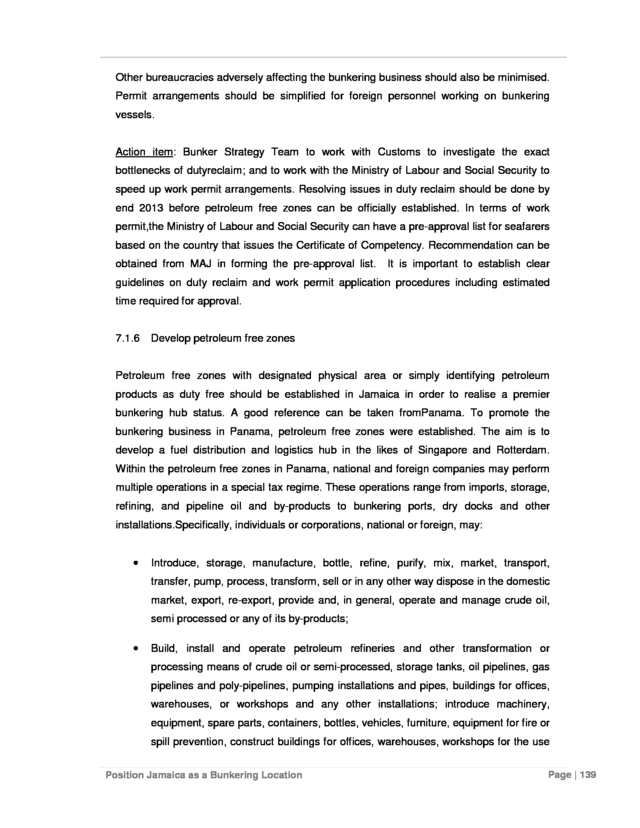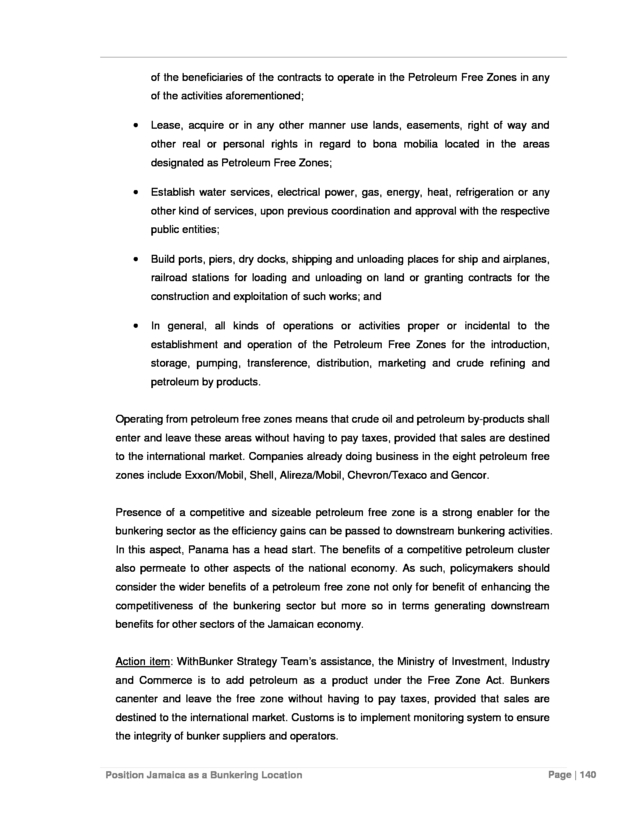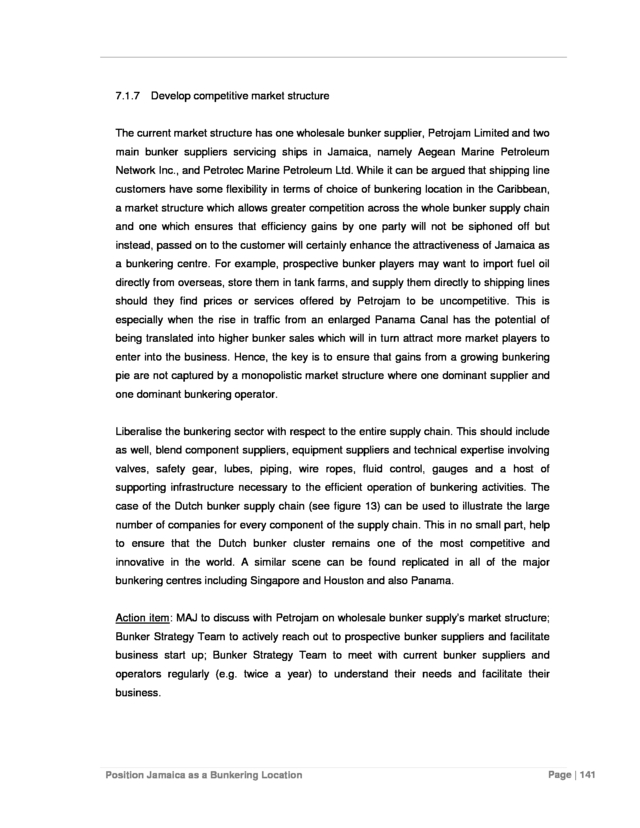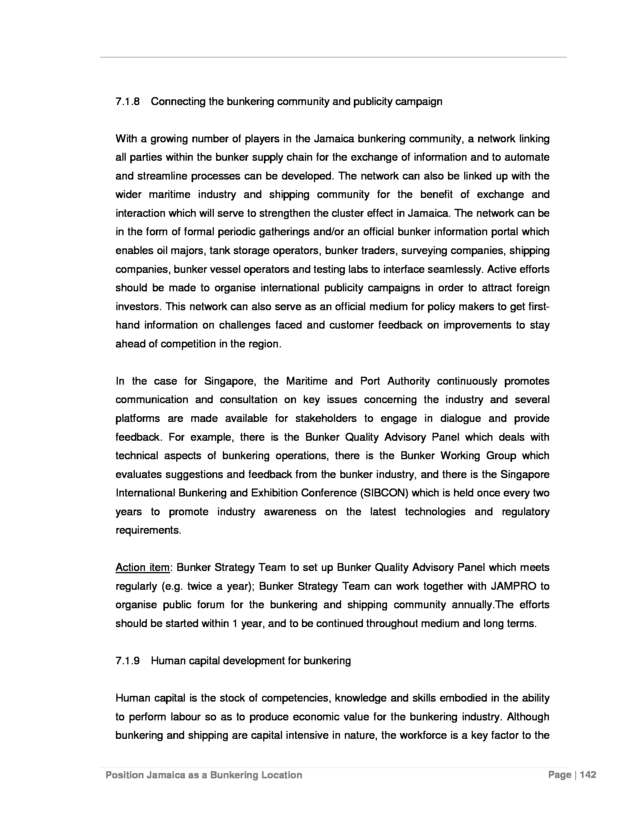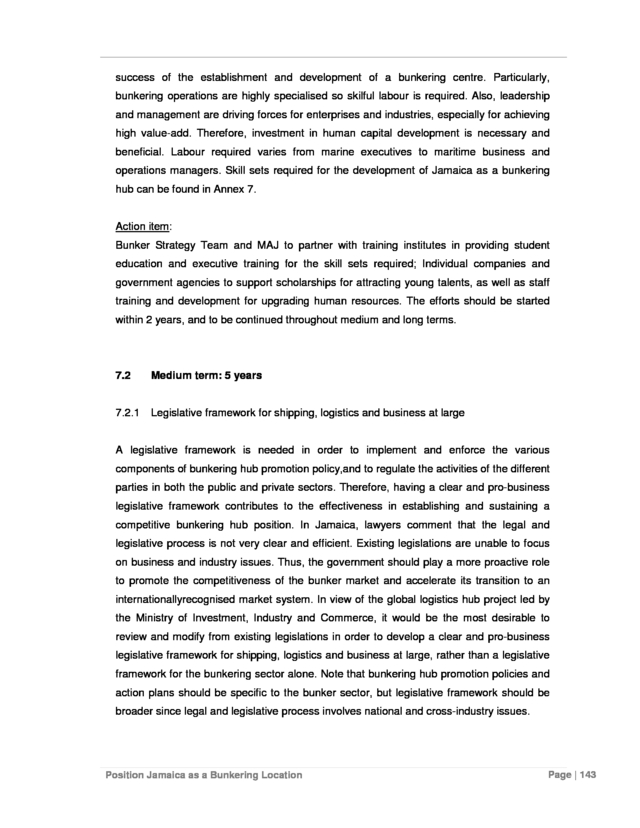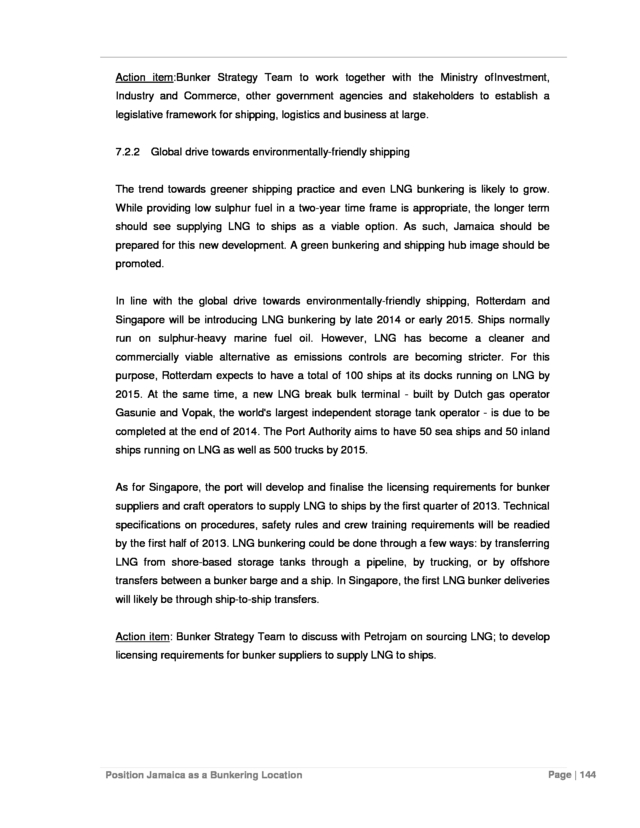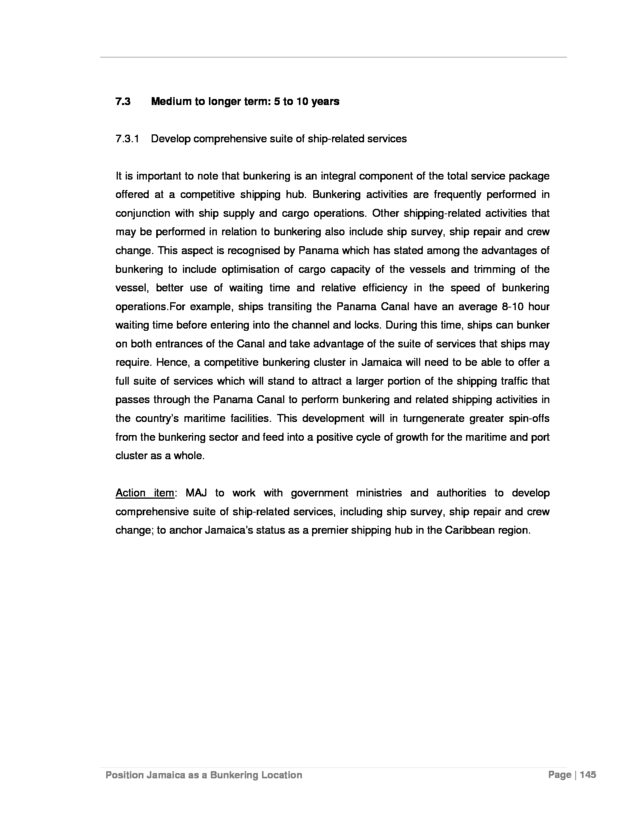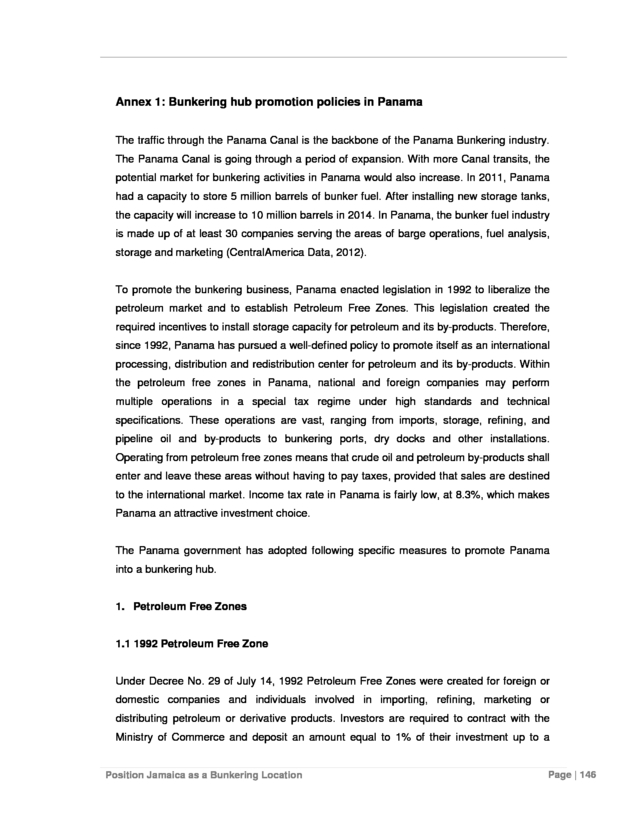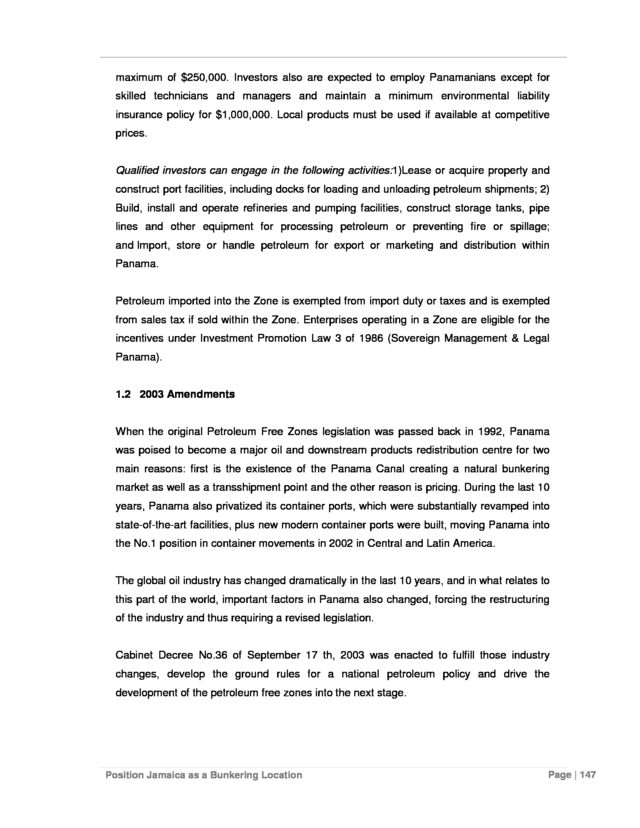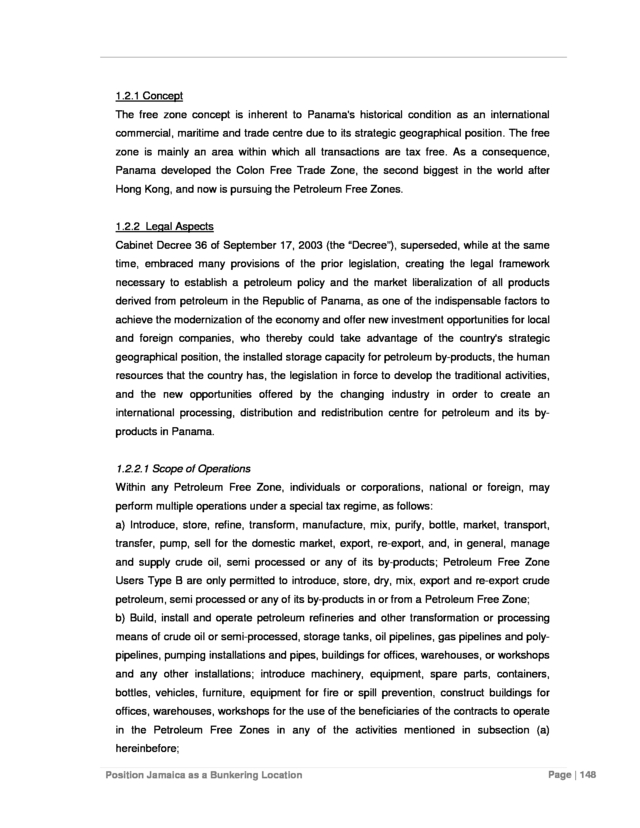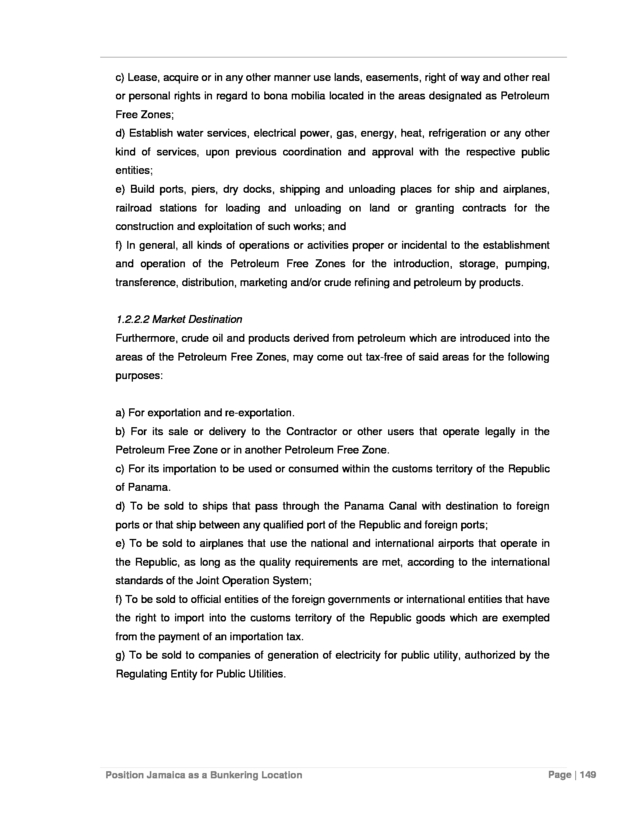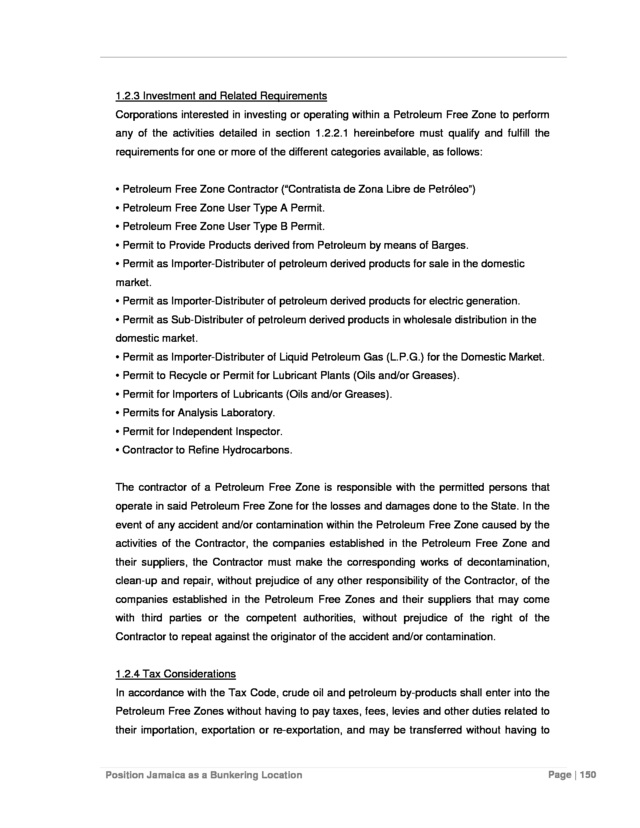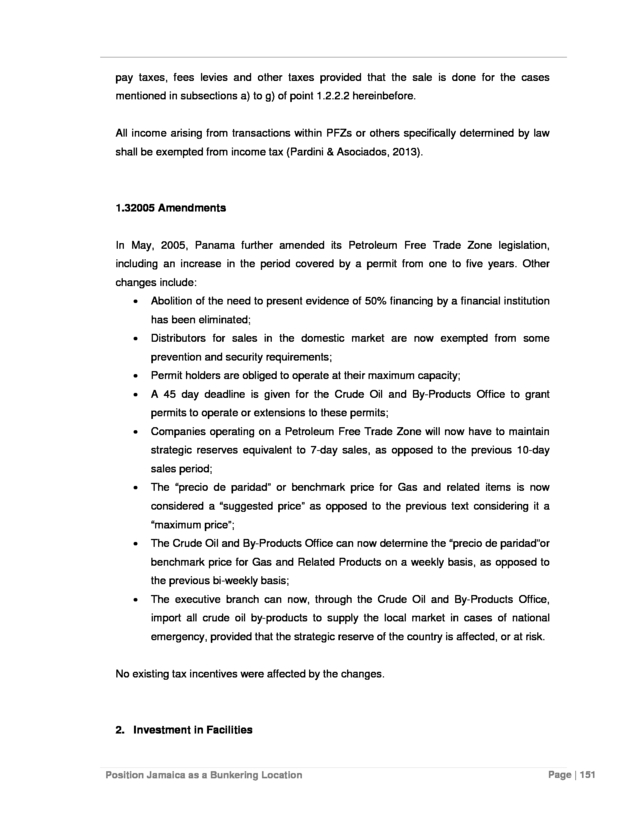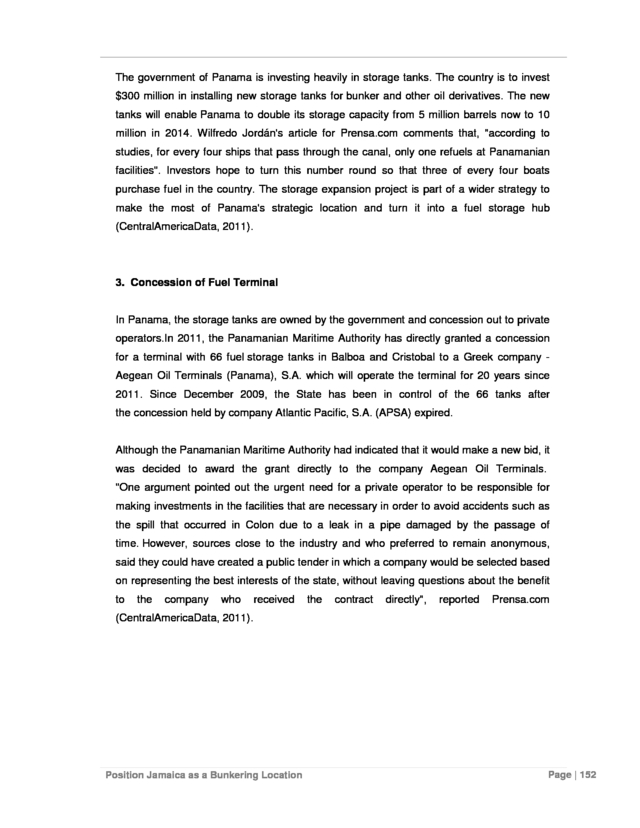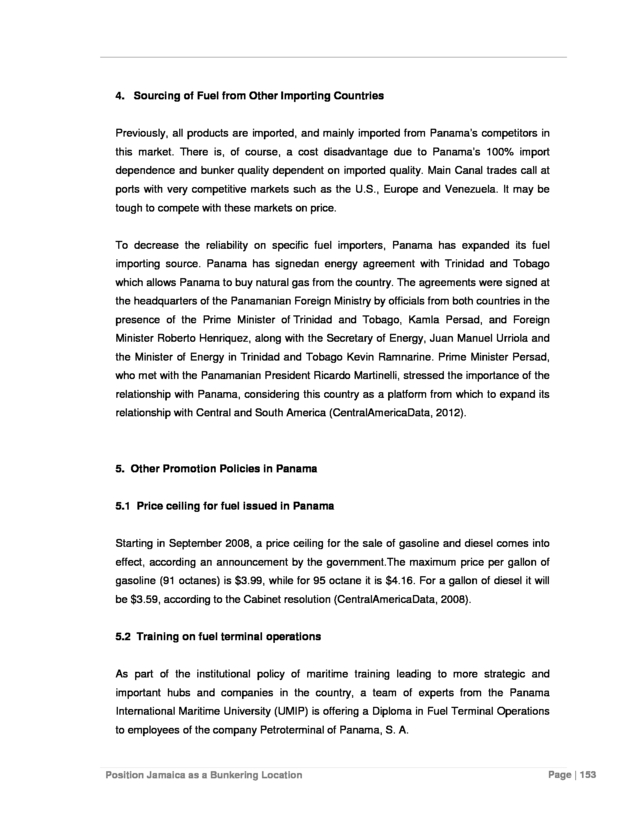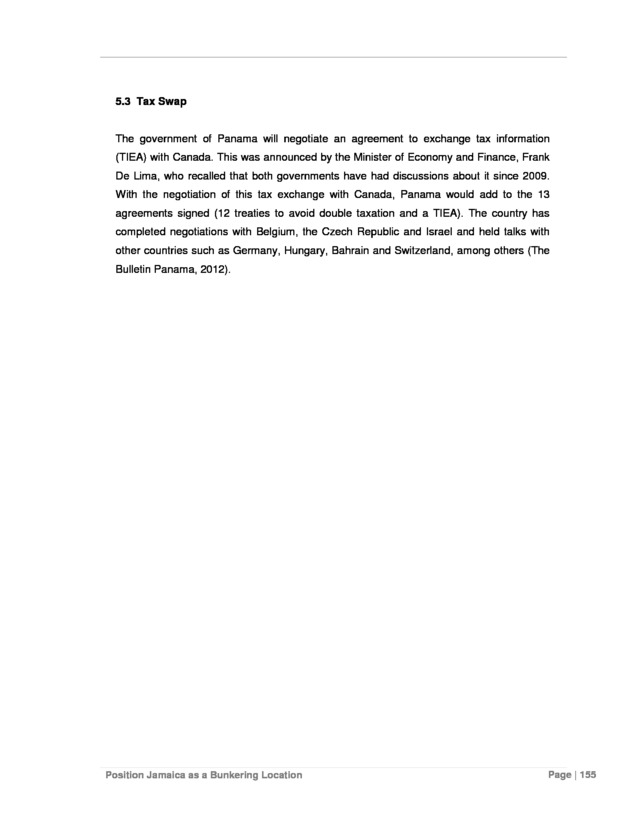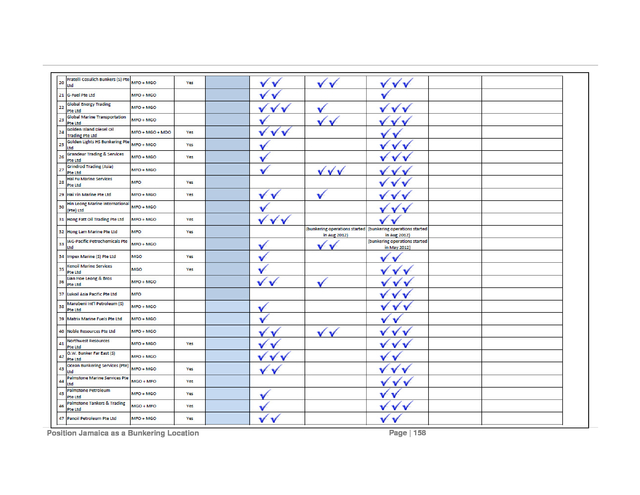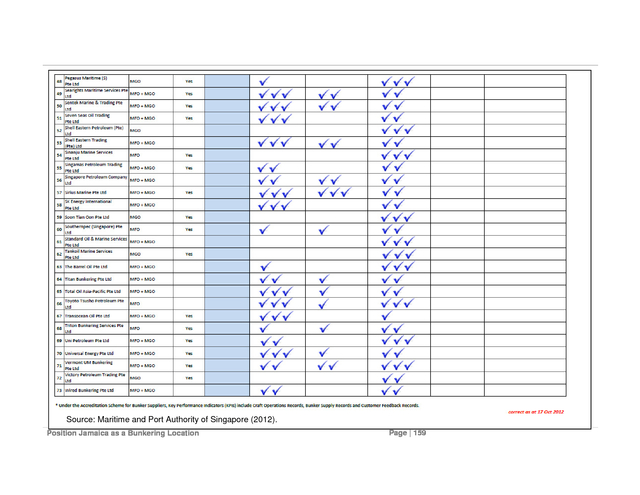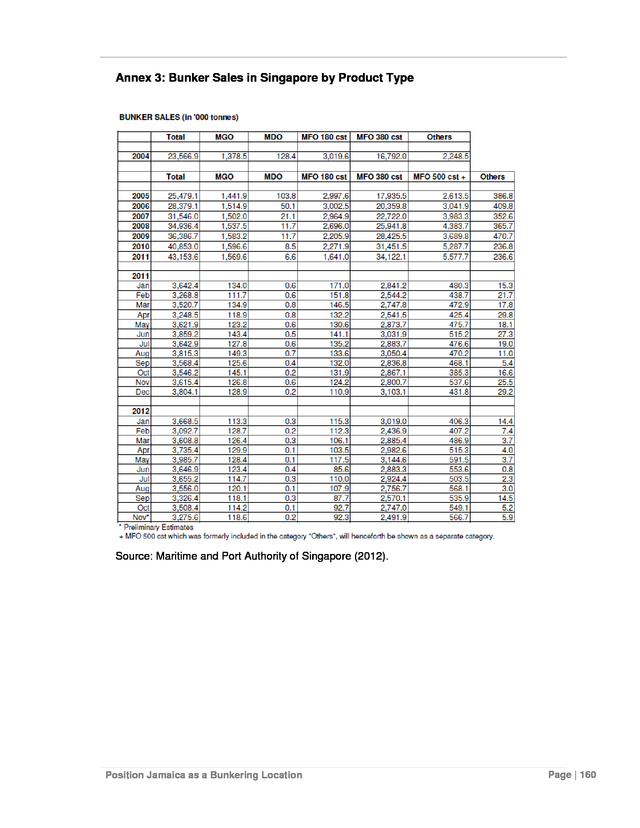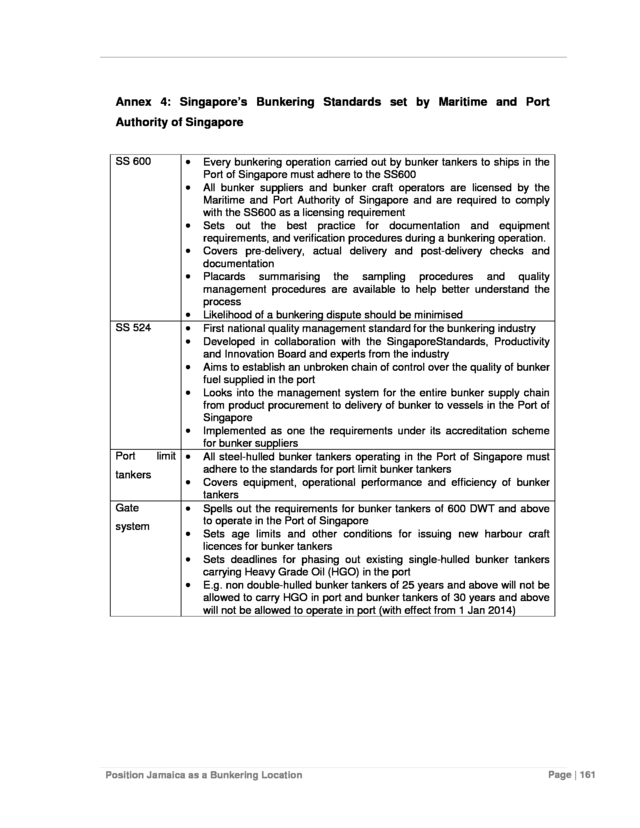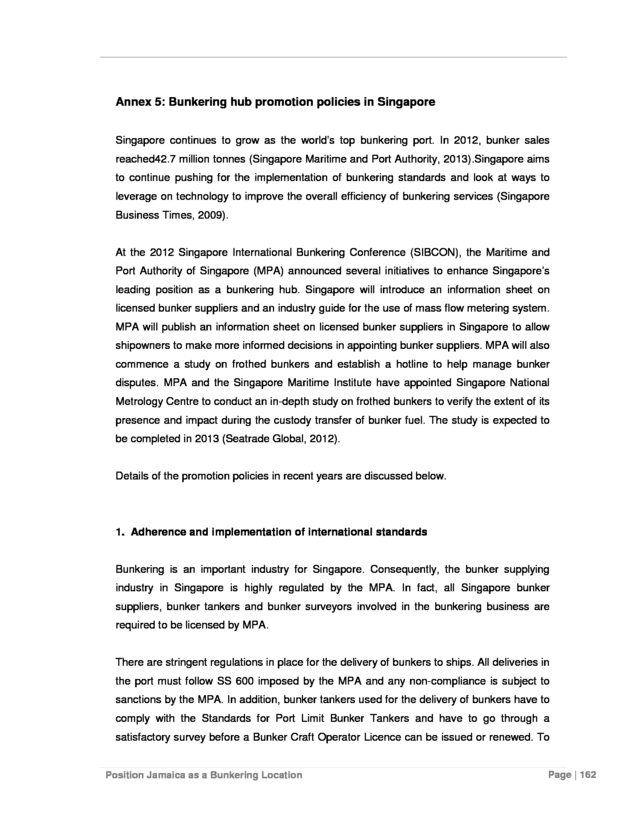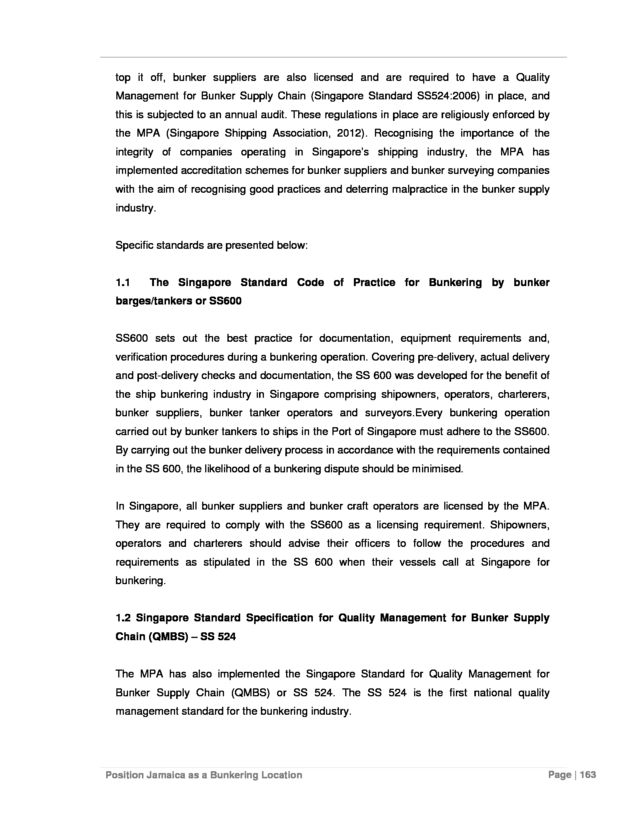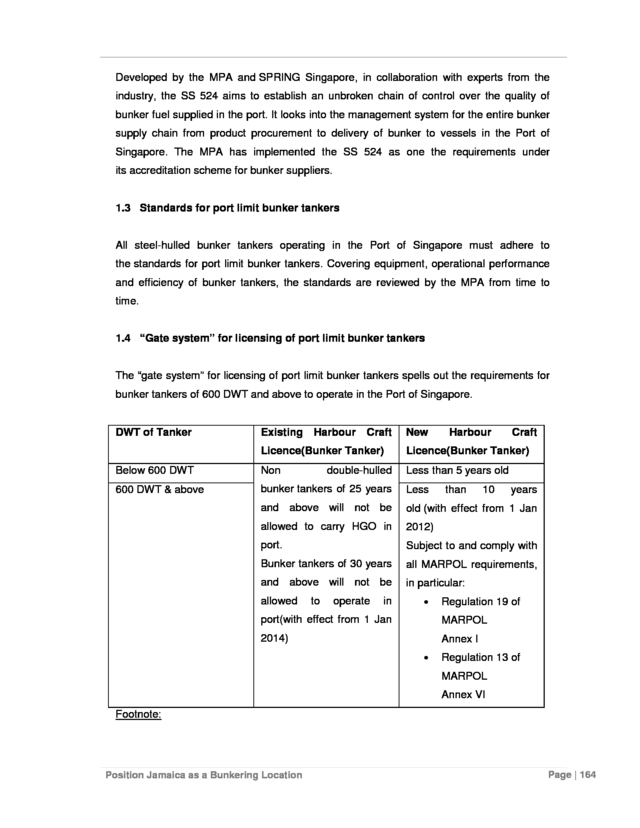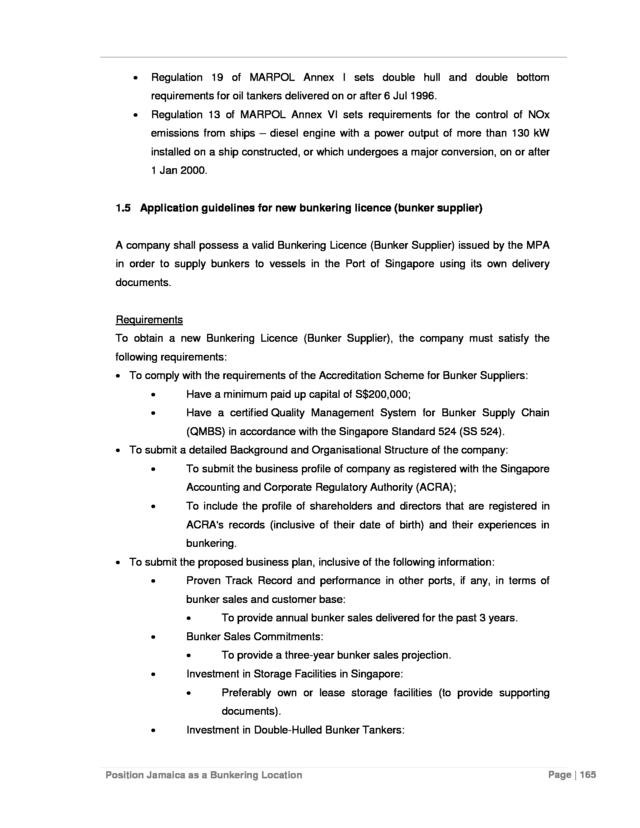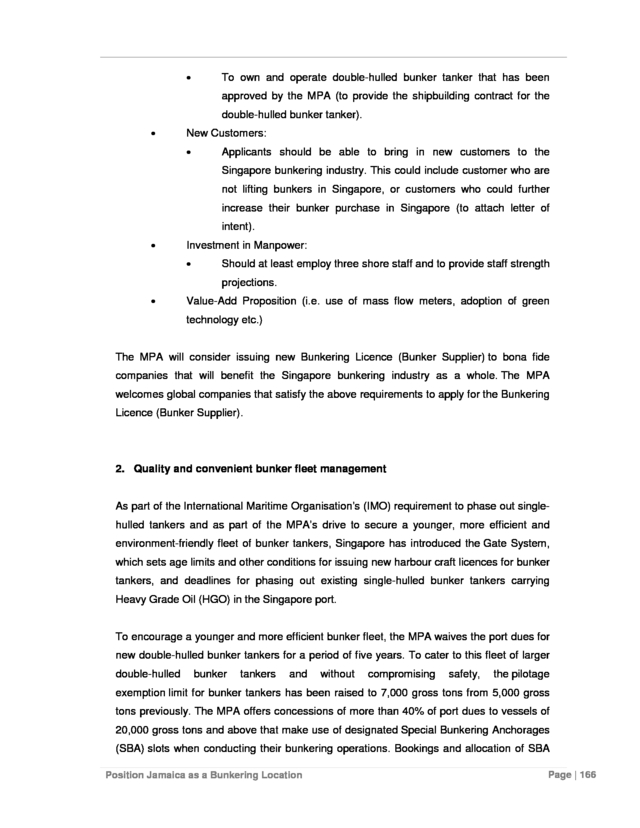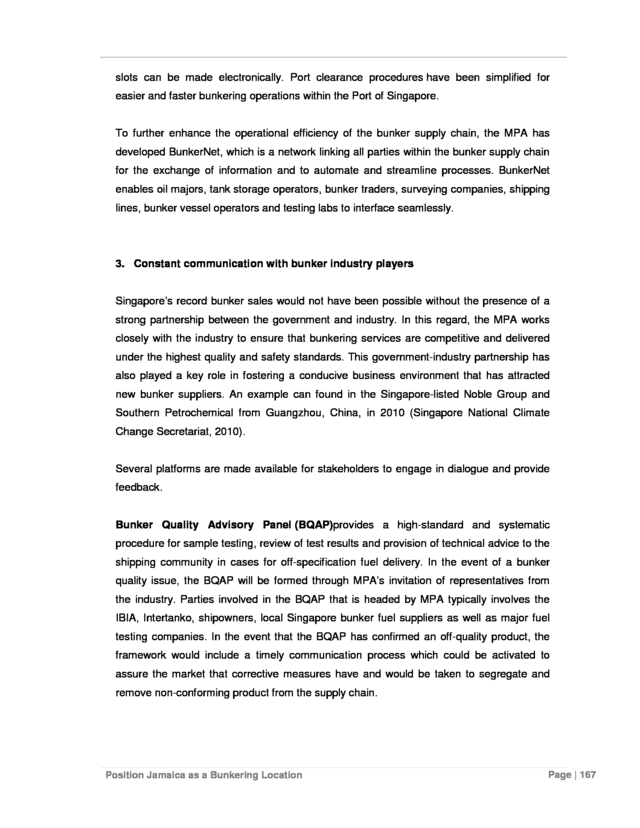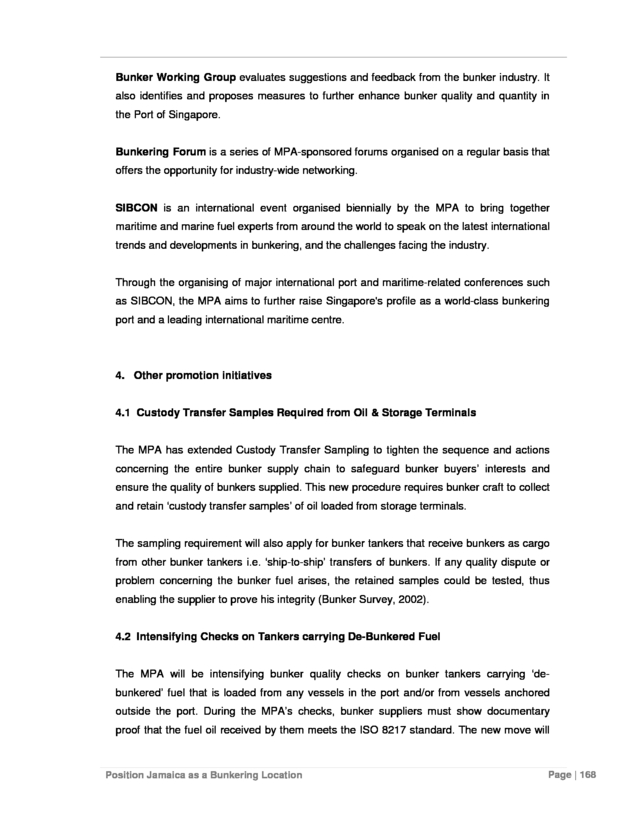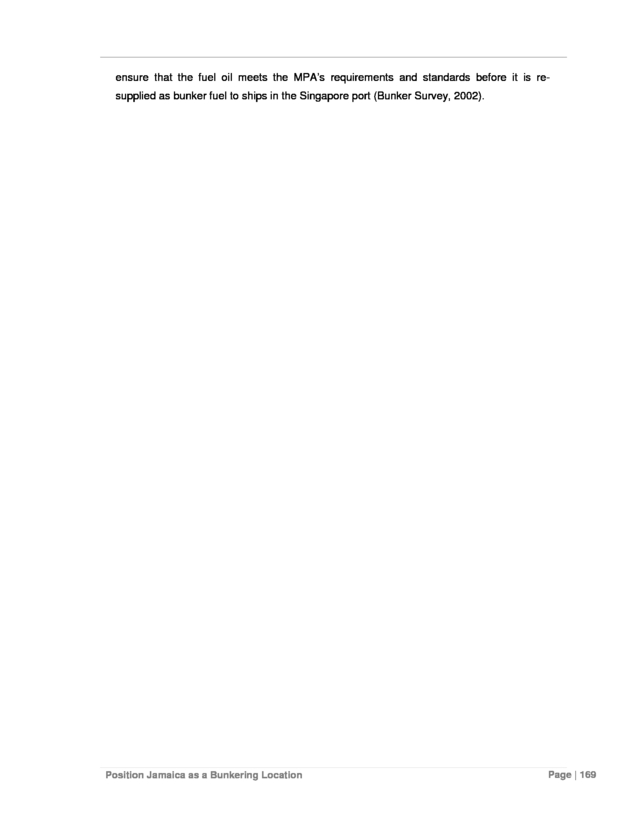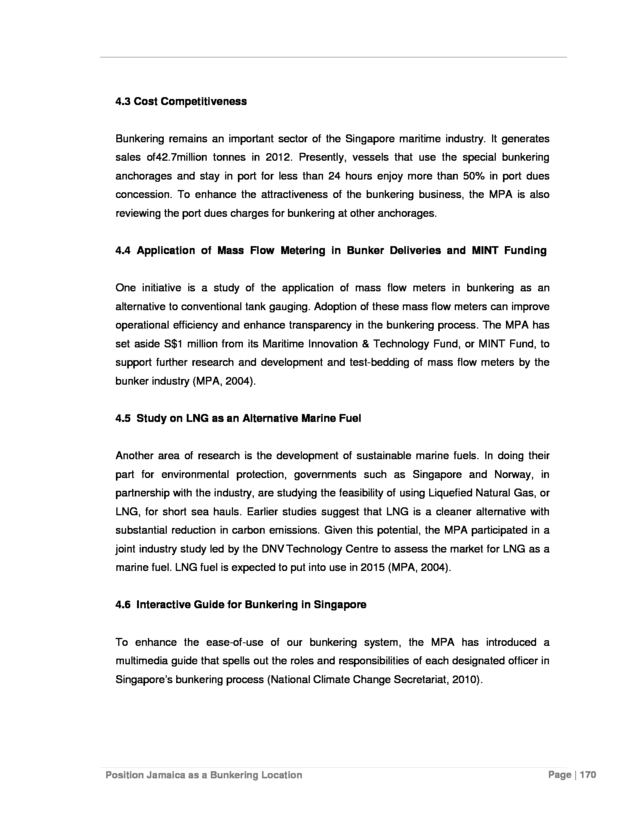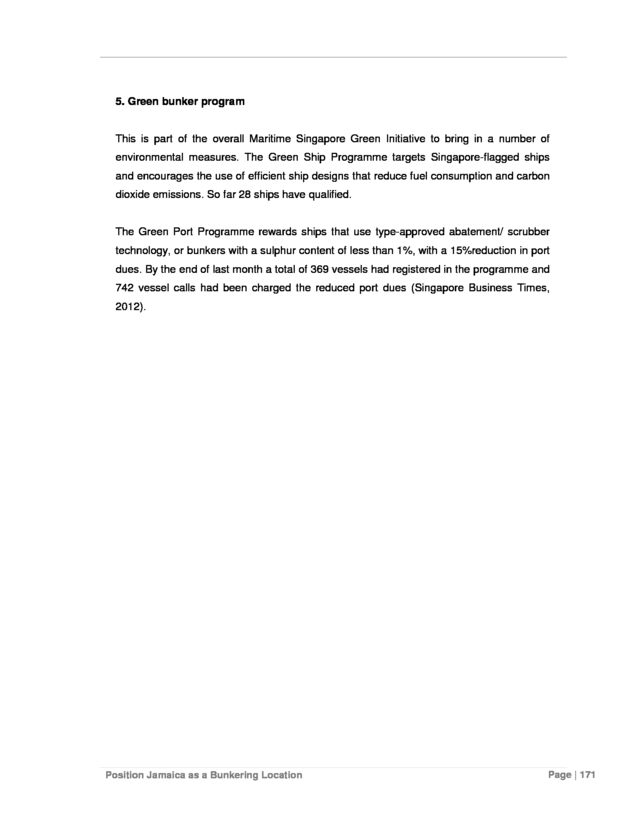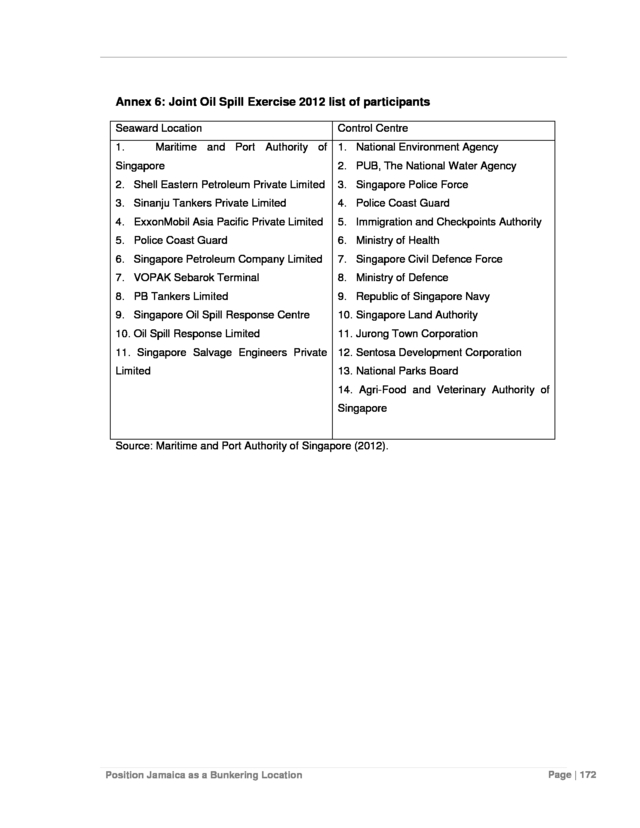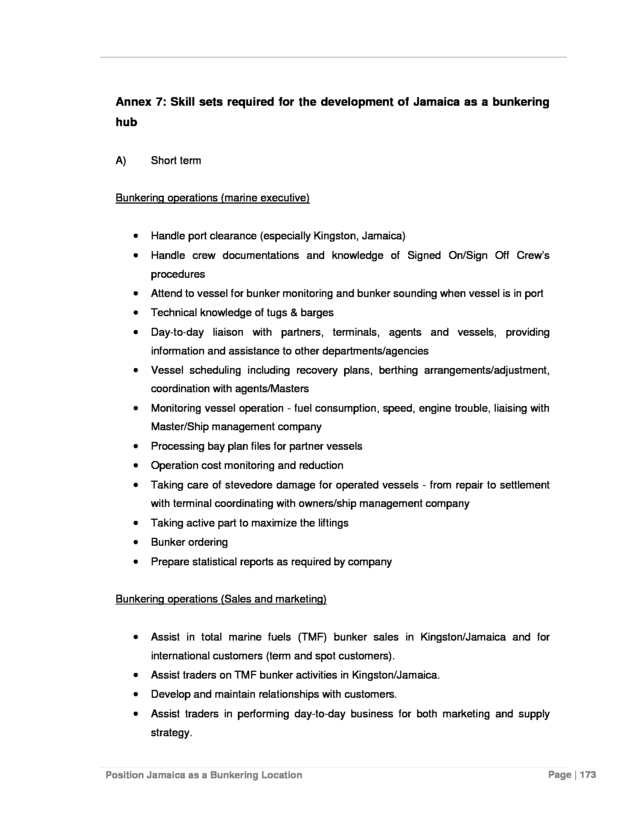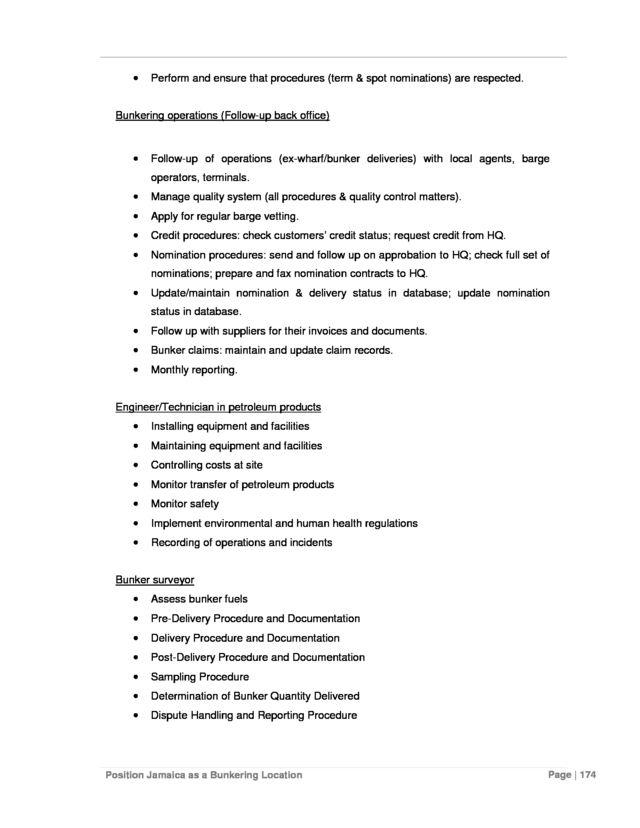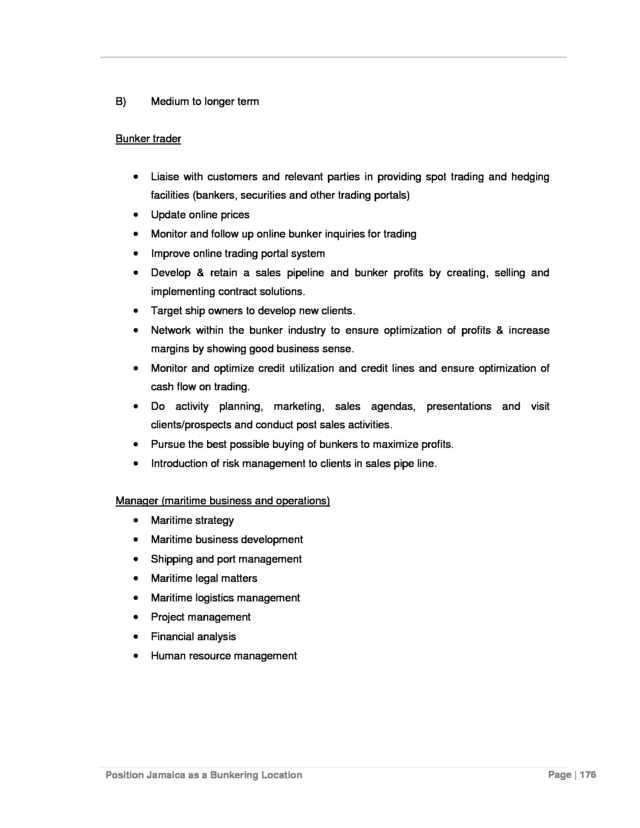




1) A Study to Position Jamaica as a Bunkering Location in the Caribbean Region Final Report By Nanyang Technological University (Singapore) 2013
2) Contents List of Tables List of Figures List of Abbreviations and Acronyms Executive Summary 1. Introduction 2. Purpose and Description of the Project 3. Economic Impact Analysis and Market Assessment 3.1 Economic impact analysis 3.1.1 Overview of current bunkering operations in Jamaica 3.1.2 Direct value added 3.1.3 Indirect value added 3.1.4 Induced value added and linkage between bunkering activities and overall economy 3.2 State of competition and commercial parameters 3.2.1 State of competition in the bunkering industry in Jamaica and the wider Caribbean and American region 3.2.2 Emerging competition to note 3.2.3 Competitiveness of current bunker supply and service providers in Jamaica 3.3 Demand conditions and market dynamics 3.3.1 Size of demand 3.3.2 Composition of demand 3.3.3 Drivers of demand and accompanying trends and development 3.3.4 Sophistication of demand 3.3.5 Captive demand 3.4 Government policy and interaction 3.4.1 Relevant government policies that affect the competitiveness and commercial viability of the bunkering sector in Jamaica 3.4.2 Policies pursued in competing bunkering centres 3.4.2.1 Freeport Bahamas 3.4.2.2 Cartagena Colombia 3.4.2.3 Panama 3.4.2.4 Puerto Rico 3.4.2.5 Suriname 3.4.2.6 Trinidad and Tobago 3.5 Bunkering demand forecast 3.5.1 Basis of demand forecast 3.5.2 Scenario of steady growth 3.5.3 High growth scenario 3.5.4 Low growth scenario 3.5.5 Summary of demand forecasts Position Jamaica as a Bunkering Location Page 6 7 8 10 18 18 19 19 20 21 24 25 27 27 28 29 30 30 31 32 33 34 34 34 36 36 36 37 37 37 38 38 38 41 43 44 45 Page | 1
3) 4. Environment Scan, Competitive Advantage Analysis and Competition Study 4.1 Environment scan 4.1.1 Macroeconomic developments 4.1.2 Ship operators’ attitudes, trends and requirements 4.1.3 Political, regulatory and policy trends 4.1.4 Shipping industry trends, conditions and consolidation 4.1.5 Shipping technology progression 4.2 Competitive advantage analysis 4.2.1 Factor conditions 4.2.2 Demand conditions 4.2.3 Company strategy, firm structure and industry rivalry 4.2.4 Related and supporting activities 4.2.5 Government policies 4.2.6 Chance events 4.3 Benchmarking with regional and international bunkering markets 4.3.1 Jamaica 4.3.1.1 Bunker suppliers and service providers 4.3.1.2 Sales volumes 4.3.1.3 Delivery infrastructure 4.3.1.4 Bunker quality, variety and price structure 4.3.1.5 Analysis of competition including factors which will promote bunker calls and choice of facilities 4.3.1.6 Future trends and other key factors 4.3.1.7 Strategies in relation to value creation 4.3.2 Bahamas – Freeport 4.3.2.1 Bunker suppliers and service providers 4.3.2.2 Sales volumes 4.3.2.3 Delivery infrastructure 4.3.2.4 Bunker quality, variety and price structure 4.3.2.5 Analysis of competition including factors which will promote bunker calls and choice of facilities 4.3.2.6 Future trends and other key factors 4.3.2.7 Strategies in relation to value creation 4.3.3 Colombia – Cartagena 4.3.3.1 Bunker suppliers and service providers 4.3.3.2 Sales volumes 4.3.3.3 Delivery infrastructure 4.3.3.4 Bunker quality, variety and price structure 4.3.3.5 Analysis of competition including factors which will promote bunker calls and choice of facilities 4.3.3.6 Future trends and other key factors 4.3.3.7 Strategies in relation to value creation 4.3.4 Panama Position Jamaica as a Bunkering Location 48 48 48 49 51 52 54 59 60 62 64 65 66 66 67 71 71 71 71 72 72 73 73 75 75 75 77 77 77 78 78 79 79 79 79 80 80 81 82 82 Page | 2
4) 4.3.4.1 Bunker suppliers and service providers 4.3.4.2 Sales volumes 4.3.4.3 Delivery infrastructure 4.3.4.4 Bunker quality, variety and price structure 4.3.4.5 Analysis of competition including factors which will promote bunker calls and choice of facilities 4.3.4.6 Future trends and other key factors 4.3.4.7 Strategies in relation to value creation 4.3.5 Puerto Rico 4.3.5.1 Bunker suppliers and service providers 4.3.5.2 Sales volumes 4.3.5.3 Delivery infrastructure 4.3.5.4 Bunker quality, variety and price structure 4.3.5.5 Analysis of competition including factors which will promote bunker calls and choice of facilities 4.3.5.6 Future trends and other key factors 4.3.5.7 Strategies in relation to value creation 4.3.6 Suriname 4.3.6.1 Bunker suppliers and service providers 4.3.6.2 Sales volumes 4.3.6.3 Delivery infrastructure 4.3.6.4 Bunker quality, variety and price structure 4.3.6.5 Analysis of competition including factors which will promote bunker calls and choice of facilities 4.3.6.6 Future trends and other key factors 4.3.6.7 Strategies in relation to value creation 4.3.7 Trinidad & Tobago 4.3.7.1 Bunker suppliers 4.3.7.2 Sales volumes 4.3.7.3 Delivery infrastructure 4.3.7.4 Bunker quality, variety and price structure 4.3.7.5 Analysis of competition including factors which will promote bunker calls and choice of facilities 4.3.7.6 Future trends and other key factors 4.3.7.7 Strategies in relation to value creation 4.3.8 Houston 4.3.8.1 Bunker suppliers and service providers 4.3.8.2 Sales volumes 4.3.8.3 Delivery infrastructure 4.3.8.4 Bunker quality, variety and price structure 4.3.8.5 Analysis of competition including factors which will promote bunker calls and choice of facilities 4.3.8.6 Future trends and other key factors 4.3.8.7 Strategies in relation to value creation Position Jamaica as a Bunkering Location 82 82 84 84 85 86 86 87 87 87 88 88 89 89 90 90 90 90 90 91 91 91 92 92 92 92 93 93 93 94 94 94 94 95 95 95 95 96 96 Page | 3
5) 4.3.9 Rotterdam 4.3.9.1 Bunker suppliers and service providers 4.3.9.2 Sales volumes 4.3.9.3 Delivery infrastructure 4.3.9.4 Bunker quality, variety and price structure 4.3.9.5 Analysis of competition including factors which will promote bunker calls and choice of facilities 4.3.9.6 Future trends and other key factors 4.3.9.7 Strategies in relation to value creation 4.3.10 Singapore 4.3.10.1 Bunker suppliers and service providers 4.3.10.2 Sales volumes 4.3.10.3 Delivery infrastructure 4.3.10.4 Bunker quality, variety and price structure 4.3.10.5 Analysis of competition including factors which will promote bunker calls and choice of facilities 4.3.10.6 Future trends and other key factors 4.3.10.7 Strategies in relation to value creation 4.4 Competitive dynamics 4.4.1 Current state of competition in the Caribbean 4.4.2 Threat of new competitor bunkering centres and players 4.4.3 Potential for substitutes 4.4.4 Bargaining power of shipping lines (customers) 4.4.5 Bargaining power of bunkering service providers 4.4.6 Schematic for bunkering competition using Five Competitive Forces Model 5. SWOT Analysis 5.1 Using strengths to take advantage of opportunities presented 5.2 Overcoming weaknesses that prevent taking advantage of opportunities 5.3 Using strengths to reduce the impact of threats 5.4 Overcoming weaknesses that will make these threats a reality 6. Environmental Impact Assessment, Regulatory Requirement and Quality Standards 6.1 Vision 2030 Jamaica – development and sustainability recognised as integrated pillars of success 6.2 Environmental impact and risks associated with bunkering activity 6.2.1 Marine environment 6.2.2 Air-borne environment 6.2.3 Land-based environment 6.2.4 Hazard risk management and response measures 6.3 Increased bunkering activity in Jamaica: gradual approach with active management of resources for long term sustainability 7. Recommendations and Policy Action Plans 7.1 Short term: 2 years 7.1.1 Establish central coordinating body for bunkering development Position Jamaica as a Bunkering Location 96 96 97 98 99 100 100 100 101 101 101 102 103 104 104 106 106 106 107 107 108 108 109 110 111 112 112 113 114 114 117 117 122 124 126 128 129 129 129 Page | 4
6) 7.1.2 7.1.3 Develop strong reputation and credibility for stringent bunkering standards Supply low sulphur fuel 130 134 7.1.4 Increasing capacity of fuel storage facilities 134 7.1.5Speed up dutyreclaim procedure and minimise bureaucracy 7.1.6 Develop petroleum free zones 7.1.7Develop competitive market structure 7.1.8 Connecting the bunkering community and publicity campaign 135 136 138 139 7.1.9 Human capital development for bunkering 7.2 Medium term: 5 years 7.2.1 Legislative framework for shipping, logistics and business at large 7.2.2 Global drive towards environmentally-friendly shipping 7.3 Medium to longer term: 5 to 10 years 7.3.1 Develop comprehensive suite of ship-related services Annex 1: Bunkering hub promotion policies in Panama Annex 2: Information on licensed bunker supplier in Port of Singapore Annex 3: Bunker sales in Singapore by product type Annex 4: Singapore’s Bunkering Standards set by MPA of Singapore Annex 5: Bunkering hub promotion policies in Singapore Annex 6: Joint Oil Spill Exercise 2012 list of participants Annex 7:Skill sets required for the development of Jamaica as a bunkering hub 139 140 140 141 142 142 143 152 155 156 157 166 167 Position Jamaica as a Bunkering Location Page | 5
7) List of Tables Table 1: Bunker Export Sales in Jamaica (2005-2012) Table 2: Direct Economic Impact of the Bunkering Sector in Jamaica Table 3: Direct Economic Impact of the Bunkering Sector in Singapore Table 4: Bunker Prices of Kingston and Major Bunkering Centres Table 5: Comparison of Bunker Prices (4 January 2013, US$ per metric tonne) Table 6: GDP per Tonne of Bunker Consumed/Sold Table 7: Direct and Indirect Economic Impact of the Bunkering Sector(in US$’000) Table 8: Induced Economic Impact of Bunkering in Jamaica Table 9: Demand Forecast for Scenario of Steady State Growth Table 10: Demand Forecast for High Growth Scenario Table 11: Demand Forecast for Low Growth Scenario Table 12: Summary of Demand Forecasts Table 13: Real GDP Growth Rate in the Caribbean Region and US (2009-2013) Table 14: Cruise Lines and Their Market Shares of World Wide Passengers (2012) Table 15: Size of Largest Container Vessel Deployed (1988-2012) Table 16: Ship Technology Progression and Impact on Port Operations Table 17: Quality of Port Infrastructure Table 18: Demand Composition of the Top Container Ports in the Region Table 19: Summary of Benchmarking of 10 Bunkering Centres (suppliers, sales, infrastructure and fuel grades available) Table 20: Summary of Benchmarking of 10 Bunkering Centres (bunker price) Table 21: Bunker Prices in Major Bunkering Centres in the World Table 22: Port Dues Structure in Singapore for Bunker Tankers Table 23: Model for SWOT Analysis Applied to the Bunkering Industry in Jamaica Table 24: Enhanced SWOT Analysis Applied to the Bunkering Industry in Jamaica Table 25: Long-term National Strategies that Affect the Decision to Position Jamaica as a Bunkering Location for the Caribbean Region Table 26: Estimation of Associated Shipping Traffic for 500,000 Metric Tons Bunker Operations in Panama Table 27: Fuel Oil Sulphur Limits (expressed in terms of % m/m) Table 28: MARPOL Annex VI: Prevention of Air Pollution by Ships (Emission Control Areas) Position Jamaica as a Bunkering Location Page 20 21 22 23 23 24 25 27 42 43 45 46 49 54 55 58 61 64 69 70 99 105 110 111 115 120 123 123 Page | 6
8) List of Figures Figure 1: Economic Linkages of Bunkering with Wider Economy Figure 2: Container Throughput Performance (2005-2010; Market Share %) Figure 3: Comparison between Panamax and Post-Panamax Container Ships Figure 4: Panama Canal Expansion and Projected Demand to 2025 Figure 5: Global Hubs of CMA CGM Figure 6: Summary of Demand Forecasts (in million tonnes) Figure 7: Shipping Capacity Controlled by the Top 25 Container Shipping Lines Figure 8: Comparison of Emma Maersk to the Largest Ship Types Figure 9: Size of Largest Container Vessel Calling at Kingston and the World Figure 10: The Bunker Supply Chain Figure 11: Container Port Throughput (2010) Figure 12: Container Port Throughput Growth (2004-2010) Figure 13: Dutch Bunker Supply Chain Figure 14: Price of IFO380 in Kingston Figure 15: Container Traffic Handled at Freeport Bahamas (2001-2011, TEUs) Figure 16: Cruise Calls at Bahamas Figure 17: Price of IFO380 in Freeport Bahamas Figure 18: Price of IFO380 in Cartagena Colombia Figure 19: Container Traffic Handled at Cartagena Colombia (2001-2011, TEUs) Figure 20: Bunker Sales in Panama (million tonnes) Figure 21: Projected Number of Ocean Going Transits Figure 22: Price of IFO380 in Cristobal Panama Figure 23: Shipping Traffic and Major Container Ports in the Caribbean Figure 24: Container Traffic Handled at San Juan (2001-2011, TEUs) Figure 25: Refinery Production by Staatsolie Maatschappij Suriname NV Figure 26: Price of IFO380 in Houston Figure 27: HFO Sales, deliveries and ships visits (2010 - 2012) Figure 28: Sales of Heavy Fuel Oil by Type of Vessel Figure 29: Price of IFO380 in Rotterdam Figure 30: Volume of Bunker Sales in Singapore (see annex 2 for details) Figure 31: Price of IFO380 in Singapore Figure 32: Comparison of Container Throughput, Container Handling Capacity of Major Asian Container Ports in 2006 (million TEUs) Figure 33: Proposed National Protected Areas on Jamaica – Priority Ranking by Biodiversity Figure 34: LNG Bunkering Demand, 2012 and 2020 Figure 35: LNG Bunkering Locations, 2012 and 2020 Position Jamaica as a Bunkering Location Page 26 32 39 40 41 47 53 56 57 60 62 63 65 72 76 76 77 80 81 83 83 85 86 88 91 96 97 98 99 102 103 118 121 125 126 Page | 7
9) List of Abbreviations and Acronyms AMP AMPNI AS BIMCO BORCO BS CAGR CCNR CEPSA CO2 CSAV CST CUPET DMA DNV DWT ECA ECLAC EMSA FCCA FOCOL GDP GHG HBC HFO HGO IFO IMO IT JAMPRO JSR LNG ISO LOA LS MAJ MARPOL MDO MFO Panama Maritime Authority Aegean Marine Petroleum Network Inc. Australia Standards Baltic and International Maritime Council Bahamas Oil Refining Company British Standards Cumulative Annual Growth Rate Central Commission for the Navigation of the Rhine Compañía Española de Petróleos, S.A. Carbon Dioxide Compañía Sud Americana de Vapores Centistoke Cuba Petroleum A type of marine distillate fuel as defined by ISO 8217 Fuel Standard Det Norske Veritas Deadweight Ton Emission Control Area Economic Commission for Latin America and the Caribbean European Maritime Safety Agency Florida-Caribbean Cruise Association Freeport Oil Company Gross Domestic Product Green House Gases Harbor Bunkering Corporation Heavy Fuel Oil Heavy Grade Oil Intermediate Fuel Oil International Maritime Organisation Information Technology Jamaica Promotions Corporation Jamaica Ship Registry Liquefied Natural Gas International Standards Organisation Length Overall Low Sulphur Maritime Authority of Jamaica Marine Pollution Marine Diesel Oil Marine Fuel Oil Position Jamaica as a Bunkering Location Page | 8
10) MGO MPA MSC MT N.A. NEPA NOx NYSE OCIMF OPEC P&I PAJ PCJ PC/UMS PDVSA PM R&D RMG SBA SIBCON SOx SS STS SWOT TEU UK ULCC UNCTAD UNDP US VLCC Marine Gas Oil Maritime and Port Authority of Singapore Mediterranean Shipping Company Metric Tonne Not Available National Environmental and Planning Agency Nitrous Oxide New York Stock Exchange Oil Companies International Marine Forum Organisation of the Petroleum Exporting Countries Protection and Indemnity Port Authority of Jamaica Petroleum Corporation of Jamaica Panama Canal Universal Measurement System Petróleos de Venezuela S.A. Particulate Matter Research and Development A type of marine residual fuel as defined by ISO 8217 Fuel Standard Special Bunkering Anchorages Singapore International Bunkering and Exhibition Conference Sulphurous Oxide Singapore Standards Ship-To-Ship Strengths, Weaknesses, Opportunities and Threats Twenty-foot Equivalent Unit United Kingdom Ultra Large Crude Carrier United Nations Conference on Trade And Development United Nations Development Programme United States of America Very Large Crude Carrier Position Jamaica as a Bunkering Location Page | 9
11) Executive Summary In October 2012, the Commonwealth Secretariat appointed Nanyang Technological University (Singapore) as consultants to undertake a study to position Jamaica as a bunkering location in the Caribbean Region.The team of consultants are Dr. LAM Siu Lee Jasmine (team leader and principal investigator), Dr. YAP Wei Yim (key investigator) and Mr. LEONG Meng Keong Edwin. Economic Impact Analysis and Market Assessment The study recognises that bunkering activities do not operate in isolation but form an important eco-system within the entire maritime cluster. The direct economic impact is estimated for total business revenue generated by bunkering activities at US$209.1 million which puts bunker sales at 1.44% of Jamaica’s GDP. In terms of direct value added contribution to GDP, bunkering activities are estimated to contribute US$2.7 million or 0.02% of the country’s GDP in 2011. As foremployment in terms of direct economic impact, the current bunkering sector is estimated to employ about 30 people based on the assumption of productivity employee at 10,000-15,000 metric tonne sales per annum. Considering both direct and indirect economic impact which are generated by shippingrelated activities will raise the estimates for business revenue generated to US$343.7 million or 2.37% of Jamaica’s GDP. Total value added contribution to GDP will similarly be higher at US$4.67 million or 0.03% of GDP. As for employment, the sales volume registered for 2011 and assumed productivity indicators suggest that employment attributable to the bunkering sector at about 100 people. Currently, the number of vessels that takes bunker in Jamaica is equivalent to about 5% of the ocean-going traffic that goes through the Panama Canal. The corresponding induced impact being business revenue of US$516 million, value added of US$7.0 million, and employment of about 150 jobsin one year. This assumes a consumption multiplier for the bunkering industry at 1.50. Increasing the number of vessels that takes bunker in Jamaica to about 10% of ocean-going traffic that goes through the Panama Canal will result in induced economic impact in terms of business revenueat US$3.1billion, value added of US$42.06 million, and employment creation of about 900 job opportunities. Success in Position Jamaica as a Bunkering Location Page | 10
12) increasing the proportion of vessels that takes bunker in Jamaica to about 15% of this traffic will result in an even higher induced economic impact in terms of business revenueat US$4.64billion, value added of US$63.1 million, and employment creation of about 1,350 job opportunities. Nonetheless, it is worth noting that the overall magnitude of induced economic impact may take years to filter through the general economy as it will be dependent on aspects such as the consumption propensity and working efficiency of the market mechanism. The bunker industry in the Caribbean has been developing steadily for decades thanks to its popularity as a cruise ship destination and the availability of marine fuels refined in local refineries. The region is also strategically located to supply bunkers to vessels travelling via the Panama Canal. However, the level of competition is high among the existing bunkering locations in the wider Caribbean and American region. In Jamaica, there is one wholesale bunker supplier, Petrojam Limited and two main bunker suppliers servicing ships in Jamaica, namely Aegean Marine Petroleum Network Inc, and Petrotec Marine Petroleum Ltd. A key driver of the growth in demand is container shipping. Related government policies in Jamaica are generally supportive of the growth in the bunkering industry. Potentially, the benefits will be a bigger pool of customers and a larger supply volume for bunkering operations. However, Jamaica should take note of the policies pursued in major competing bunkering centres. In particular,Panama is the most proactive competing bunkering centre in the region. To promote the bunkering business, Panama enacted legislation in 1992 to liberalize the petroleum market and to establish Petroleum Free Zones. Demand forecasts are depicted in three scenarios which assume three different outcomes after the expansion of the Panama Canal. In the first scenario which supposes steady growth, the ratio of bunker consumption in Jamaica to shipping tonnage transiting through the Panama Canal is assumed to grow from 0.07% in 2012 to 0.38% by 2025. The scenario projects bunker sale to recover to the pre-global financial crisis levels by approximately 2017. Specifically, bunker sale is projected to grow from 0.22 million tonnes in 2012 to 1.91 million tonnes in 2025.In the scenario which depicts high growth, the assumption is successful implementation of policies to boost Jamaica’s competitiveness as a premier bunkering hub in the Caribbean resulting in growing market share in the bunkering pie. The ratio of bunker consumption in Jamaica to shipping tonnage for the Panama Canal is assumed to rise from 0.07% in 2012 to 0.68% in 2025. The high growth scenario projects bunker sale to recover to pre-global financial crisis levels by approximately 2016, which is one year after the enlarged Panama Canal enters into Position Jamaica as a Bunkering Location Page | 11
13) operations. By 2025, the projection for bunker demand is3.44 million tonnes. In the event where Jamaica is able to capitalise on limited growth opportunities, bunker demand is assumed to grow at a much slowerpace to reach 1.03 million tonnes per annum by 2025. In addition, this scenario projects a much longer recovery to pre-global financial crisis levels, reaching above 600,000 tonnes only by 2021. Environment Scan In terms of macroeconomic developments, the economic status in the Caribbean Region is largely driven by the global economy as well as developments in the US. Going forward, tourism is expected to remain as a key economic driver for the Caribbean region. Furthermore, the US is likely to continue to play a major influence. The bunkering industry in the Caribbean has been developing steadily for decades due to its popularity as a cruise ship destination and transhipment hub for east-west and northsouth cargo shipping routes. The enlargement of the Panama Canal is further expected to change competition dynamics between the region’s bunkering centres as a result of increase in shipping traffic and larger vessels. Other key political/regulatory/policy trends include the move towards green shipping and use of less pollutive fuels; bunkering hub ambitions by major ports in the region; improving security conditions in Colombia and its growth in cruise and container cargo traffic; and opening up of Cuba. The shipping industry is the major demand driver for bunkering. It should be noted that both container liner and cruise sector as the two largest demand segments are concentrated. Decision factors by ship operators with respect to bunkering operations and critical concerns can be summarised by 8 attributes: 1 Bunker quality 2 Market transparency (corruption free) 3 Bunker price competitiveness 4 Reliability and punctuality of bunker suppliers 5 Bunkering facilities and services (adequacy and efficacy) 6 Availability of all fuel grades including low-sulphur bunkers 7 Location of port 8 Government policies (e.g. quality control) and incentives Competitive Advantage Analysis and Competition Study Six determinants are used to analyse the competitive advantages of Jamaica’s bunkering sector and the findings are summarised as below. Position Jamaica as a Bunkering Location Page | 12
14) • Factor conditions: Factors include the entire bunker supply chain comprising of refineries, processors, blenders, storage tanks, etc. Jamaica’s bunker supply is dominated by few players which hold considerable bargaining power in the market structure. This could result in restrictions to market access, increasing market concentration and leading to the formation of an insular bunker cluster. • Demand conditions: Compared to the other major bunkering centres in the Caribbean, Jamaica’s shipping line customer mix relies on three major container carriers which are CMA CGM, MSC and ZIM. By comparison, Balboa and Puerto Manzanillo in Panama and Cartagena in Colombia have a more diverse mix of shipping line customers. Capability of meeting the needs of these customers will be an affirmation to the competitiveness of the Jamaican bunkering sector. However, transhipment cargo is notoriously footloose and this can shift within a short time period unless there are mechanisms to “lock-in” this key client. This is a key concern especially with both CMA CGM and MSC calling at several ports in the region. • Company strategy, firm structure and industry rivalry: A lack of viable domestic competition could lead to complacent service and uncompetitive prices, which in turn leads to stagnant or even lower bunkering demand. This in turns detracts other players from entering into the competition and further entrenching the monopolistic status of the incumbent and so the vicious cycle continues. • Related and supporting activities: The presence of internationally competitive suppliers in the bunker supply chain creates advantages for downstream suppliers. However, value created will be captured by one or two players in a monopolistic or oligopolistic setting. • Government policies: The key direction is to ensure an internationally competitive bunker supply chain with players operating in an open market structure. • Chance events: The uncontrollable factors include economic or financial crisis, surges of world/regional demand, uncertainty in shipping traffic, oil shocks, natural disaster, major technological discontinuities that reduce demand for bunkers, as well as political and social instability. The regional and international bunkering markets are analysed for benchmarking. For the Caribbean region, seven countries/locations are included in the analysis, namely Jamaica, Bahamas, Colombia, Panama, Puerto Rico, Suriname and Trinidad & Tobago. For international comparison, Singapore, Rotterdam and Houston are chosen due to their status as top bunkering centres in the world. Among the Caribbean bunkering centres, Panama is a major competitor to Jamaica. There are 20 bunker suppliers in Panama Position Jamaica as a Bunkering Location Page | 13
15) providing bunker in Colón, Cristobal and Balboa. This represents the widest variety of suppliers compared to other bunkering locations in the Caribbean region.Prices for IFO380 are some of the cheapest in the region. However, prices for other types of bunker fuel, particularly low sulphur products, are considerably more expensive. In addition to Panama’s strategic location,the wider variety of bunker fuel available is a major strength of Panama as a bunkering location vis-a-vis Jamaica. The major findings of competition dynamics analysis for Jamaica include high bargaining power of both customers (shipping lines) and bunkering service providers; presence of new competitors, namely Puerto Rico, Cartagena, Freeport, Puerto Caucedo and Cuba; and LNG as a cleaner and commercially viable alternative to sulphur-heavy marine fuel oil. SWOT Analysis Table 23 presents the SWOT Analysis. There are four pertinent points that policy makers and stakeholders from the industry must address: • Using strengths to take advantage of opportunities presented: Jamaica enjoys a central location with respect to major shipping routes that are plying through the Caribbean region. The projected rise in shipping traffic with the widening of the Panama Canal by 2015 is expected to see Jamaica favourably positioned to capitalise on greater demand for bunkering. • Overcoming weaknesses that prevent taking advantage of opportunities: There is one wholesale bunker supplier, Petrojam Limited and two main bunker suppliers servicing ships in Jamaica, namely Aegean Marine Petroleum Network Inc, and Petrotec Marine Petroleum Ltd. Hence, addressing supply constraints will be a key consideration. Having a set of policies and legislation to regulate and promote the bunkering sector will also serve to strengthen the market structure and create a conducive environment for the industry. • Using strengths to reduce the impact of threats: The rise in shipping and cargo traffic could translate into higher bunkering volumes which will attract more market players to enter into the business in Jamaica. With this development, government authorities and policy makers will have to work to ensure that market principles are enforced and monitor the situation to ensure level playing field and anti-competition measures put in place. • Overcoming weaknesses that will make these threats a reality: A major aspect to address the weaknesses and threats requires government policies and regulatory measures to not only keep pace with developments but be ahead and anticipate Position Jamaica as a Bunkering Location Page | 14
16) changes in order to reap the potential benefits. In particular, bureaucracy must not become a stumbling block to Jamaica’s bunkering hub ambition. Environmental Impact Assessment, Regulatory Requirement and Quality Standards The environmental issue is analysed from four aspects. • Marine Environment:The National Environmental & Planning Agency (NEPA) highlights that Kingston, as a sheltered harbour, has been vulnerable to pollution, with the badly degraded water quality and introduction of alien species affecting the rich biodiversity of the harbour. Increasing bunkering activities and shipping traffic inevitably leads to negative marine environmental impacts from ballast water, fuel oil residue and waste disposal from ship operations as well as cargo residue. • Air-borne Environment:Exhaust gases are the primary source of emissions from vessels, releasing air greenhouse gases (GHG) such as CO2 (Carbon Dioxide), SOx (Sulphurous Oxide), NOx (Nitrous Oxide).MARPOL Annex VIintroduces stricter emission control areas (ECAs) to reduce emissions of those air pollutants further in designated sensitive sea areas. The sulphur limits will reduce from 3.5% m/m to 0.50% from 01 Jan 2020. • Land-based Environment: The development or improvement of a bunkering facility requires construction/extension of land-based facilities such as refineries, pipelines linking refinery to storage and jetties for the discharging and loading of bunker to the storage facility. • Hazard Risk Management & Response Measures: With the IMO’s “Prevention of Pollution during Transfer of Oil Cargo between Oil Tankers At Sea” coming into force from 01 Jan 2011, countries now have a consistent set of regulations to govern bunker operations. For hazard risk management to be effective however, the maritime and port authorities have to play a proactive role. Recommendations and Policy Action Plans Short term: 2 years 1. Establish central coordinating body for bunkering development Action item: As appointed by the government of Jamaica, MAJ to set up Bunker Strategy Teamto manage the development of Jamaica’s bunkering sector. The Team should be responsible in overseeing and monitoring the progress of the following policy action items in this section. Review of the policies’ implementation and the progress of Jamaica’s bunkering industry in the time frames of short, medium and longer term should be under the Team’s custody. Position Jamaica as a Bunkering Location Page | 15
17) 2. Develop strong reputation and credibility for stringent bunkering standards Action item: Bunker Strategy Team to establish code of practice for bunkering, quality management system for bunker supply chain, and information guide for prospective market entrants made available through a web-link. 3. Supply low sulphur fuel Action item: Petrojam to supply low sulphur fuel to bunker operators; Bunker Strategy Team to facilitate the process when necessary. 4. Increasing capacity of fuel storage facilities Action item: Petrojam to install new fuel storage tank(s) in its premise in Kingston to cater future demand growth. Bunker operators may also install their own fuel storage tank(s) but approval has to be obtained from the government of Jamaica. Bunker Strategy Team should coordinate the future storage capacity at the national level to ensure that there will not be any excess supply due to lack of coordination. Government can offer incentive by giving interest-free loan to bunker suppliers who install new storage tank(s) by 2015 and those who install new storage tank(s) for storing low sulphur fuel. 5. Speed up dutyreclaim procedure and minimise bureaucracy Action item: Bunker Strategy Team to work with Customs to investigate the exact bottlenecks of dutyreclaim; and to work with the Ministry of Labour and Social Security to speed up work permit arrangements. Resolving issues in duty reclaim should be done by end 2013 before petroleum free zones can be officially established. In terms of work permit,the Ministry of Labour and Social Security can have a pre-approval list for seafarers based on the country that issues the Certificate of Competency. Recommendation can be obtained from MAJ in forming the pre-approval list. It is important to establish clear guidelines on duty reclaim and work permit application procedures including estimated time required for approval. 6. Develop petroleum free zones Action item: WithBunker Strategy Team’s assistance, the Ministry of Investment, Industry and Commerce is to add petroleum as a product under the Free Zone Act. Bunkers canenter and leave the free zone without having to pay taxes, provided that sales are destined to the international market. Customs is to implement monitoring system to ensure the integrity of bunker suppliers and operators. 7. Develop competitive market structure Action item: MAJ to discuss with Petrojam on wholesale bunker supply’s market structure; Bunker Strategy Team to actively reach out to prospective bunker suppliers and facilitate business start up; Bunker Strategy Team to meet with current bunker suppliers and operators regularly (e.g. twice a year) to understand their needs and facilitate their business. Position Jamaica as a Bunkering Location Page | 16
18) 8. Connecting the bunkering community and publicity campaign Action item: Bunker Strategy Team to set up Bunker Quality Advisory Panel which meets regularly (e.g. twice a year); Bunker Strategy Team can work together with JAMPRO to organise public forum for the bunkering and shipping community annually.The efforts should be started within 1 year, and to be continued throughout medium and long terms. 9. Human capital development for bunkering Action item: Bunker Strategy Team and MAJ to partner with training institutes in providing student education and executive training for the skill sets required; Individual companies and government agencies to support scholarships for attracting young talents, as well as staff training and development for upgrading human resources. The efforts should be started within 2 years, and to be continued throughout medium and long terms. Medium term: 5 years 1. Legislative framework for shipping, logistics and business at large Action item:Bunker Strategy Team to work together with the Ministry ofInvestment, Industry and Commerce, other government agencies and stakeholders to establish a legislative framework for shipping, logistics and business at large. 2. Global drive towards environmentally-friendly shipping Action item: Bunker Strategy Team to discuss with Petrojam on sourcing LNG; to develop licensing requirements for bunker suppliers to supply LNG to ships. Medium to longer term: 5 to 10 years 1. Develop comprehensive suite of ship-related services Action item: MAJ to work with government ministries, authorities and stakeholders to develop comprehensive suite of ship-related services, including ship survey, ship repair and crew change; to anchor Jamaica’s status as a premier shipping hub in the Caribbean region. Position Jamaica as a Bunkering Location Page | 17
19) 1. Introduction In 2010, the Commonwealth Secretariat conducted a study and developed a framework to position Jamaica as a shipping hub. The report entitled ‘Development of a Frameworkfor Positioning Jamaicaas a Shipping Hub’ by the Commonwealth Secretariat had identified Jamaica as an active maritime centre with a bunkering station with considerable growth potential. The report also noted the importance of the shipping industry as a significant contributor to the country’s economy. Furthermore, the strategic location of Kingston port to benefit from north-south and east-west shipping routes has seen the facility benefiting from the transhipment, ship registry, cruise and maritime training aspects. This development also points to the strong potential of Jamaica to become a truly competitive maritime centre comprising a host of other maritime and related activities that include shipping services, marine insurance, banking, legal services, dry docking and bunkering. In an attempt to achieve the targets in the Government of Jamaica’s long term National Development Plan and its Growth Enhancement Strategy, the Planning Institute of Jamaica has requested on behalf of the Maritime Authority further assistance to conduct a study which inter alia, will quantify the benefits of positioning Jamaica as a bunkering hub in the region.In October 2012, the Commonwealth Secretariat appointed Nanyang Technological University (Singapore) as consultants to undertake a study to position Jamaica as a bunkering location in the Caribbean Region. The findings presented in this report are obtained from thorough research, based on various sources including interviews with stakeholders involved in or related to the maritime and bunkering industries in Jamaica to understand the situation of the bunkering industry in Jamaica. The consultants appreciate MAJ’s arrangements they made during the consultants’ visits to Kingston. The consultants are also thankful to the individuals and organisations that shared their views and information contributing to the preparation of this report. 2. Purpose and Description of the Project Position Jamaica as a Bunkering Location Page | 18
20) The main objective of the project is to conduct a market development study on bunkering in Jamaica which will enable Jamaica to increase its regional market share. There are five parts of the study, namely, Part 1: Economic Impact Analysis and Market Assessment Part 2: Environment Scan, Competitive Advantage Analysis and Competition Study Part 3: Strengths, Weaknesses, Opportunities and Threats (SWOT) Analysis Part 4: Environmental Impact Assessment and Regulatory Requirement Part 5: Recommendations and Policy Action Plans 3. Economic Impact Analysis and Market Assessment 3.1 Economic impact analysis A successful and competitive bunkering hub will have a positive impact on the dynamism of the Jamaican maritime cluster. More importantly, thestudy recognises that bunkering activities do not operate in isolation but form an important eco-system within the entire maritime cluster. Her ability to thrive will be dependent on the overall health of other activities within the cluster as well as her ability to contribute positively in competitive terms to support the cluster. For the purpose of this study, the analyses shall examine the economic impact of the bunkering sector with reference to: (a) Direct impact: Results directly from bunkering operations to ships carried out in Jamaica’s bunkering sector, such as services provided to shipping companies taking bunker. (b) Indirect impact: Arises from the purchase of goods and services and other forms of spending made by firms which produce the direct impact. (c) Induced impact: Results from the purchases of goods and services and other forms of spending made by individuals employed by firms linked directly to bunkering activities. Position Jamaica as a Bunkering Location Page | 19
21) The results of these impacts will be presented in terms of total business revenue generated, employment, and value added contribution to GDP. 3.1.1 Overview of current bunkering operations in Jamaica Table 1: Bunker ExportSales in Jamaica (2005-2012) Barrels Marine Intermediate Gas Oil Fuel Oil 2005 143,695 643,648 2006 352,364 2007 Metric Tonnes Marine Intermediate Gas Oil Fuel Oil 787,343 19,058 98,719 117,777 2,547,483 2,899,847 46,733 390,718 437,451 550,523 3,514,948 4,065,471 73,014 539,102 612,116 2008 275,628 3,915,064 4,190,692 36,555 600,470 637,025 2009 286,803 3,368,486 3,655,289 38,038 516,639 554,677 2010 200,032 1,720,110 1,920,142 26,529 263,821 290,350 2011 169,949 1,716,656 1,886,605 22,540 263,291 285,831 2012 149,284 1,298,455 1,447,739 19,799 199,150 218,949 Total Total Source: Petrojam(2013). According to data from Petrojam, 0.22 million tonnes of bunker fuel was sold in 2012 (see table 1). Although the figure is almost twice the volume of 0.12 million tonnes of bunker fuel sold in 2005, it is significantly lower compared to the peak of 0.64 million tonnes sold in 2008. In Cumulative Annual Growth Rate (CAGR) terms, the trend represents a growth of 9.3% in the 8-year period since 2005 and leading up to 2012. The reduction in bunker sales in Jamaica from 2008 to 2010 is in part related to the major global economic recession which started from the third quarter of 2008. The recession was particularly severe for more developed economies such as the US.Those countries that were dependent on exports to the US saw their seaborne trade curtailed to various degrees. Since shipping is a derived demand of the world economy, global shipping traffic which fell during the period also adversely affected the demand for bunkers. Thus the bunkering industry is sensitive to economic performance and shipping traffic. But a competitive Position Jamaica as a Bunkering Location Page | 20
22) bunkering location would be able to lower its sensitivity to these factors. On this note, a competitive advantage analysis will be presented in section 4. More important point to note is that although the current bunker export sales has declined relative to its peak in 2008, the statistics show that Jamaica could reach higher bunker sales and has the potential to revive its bunkering sector. 3.1.2 Direct economic impact Table 2: Direct Economic Impact of the Bunkering Sector in Jamaica Indicator Bunker sales Total business revenue generated Bunkering’s share of GDP by business revenue Bunkering’s contribution to GDP by value added Bunkering’s share of GDP by value added 2011 285,831 metric tonnes US$209.1 million 1.443% US$2.74 million 0.019% Total employment About30 people Jamaica’s GDP US$14.49 billion Sources: Contribution is based on consultants’ estimation, with data fromPetrojam (2013) and International Monetary Fund (2012). Direct economic impact is generated as a result of direct spending by firms on bunkering operations carried out in Jamaica’s bunkering sector. Based on almost 285,831 metric tonnes of bunker supplied in 2011, total business revenue generated is estimated at US$209.1 million (see table 2). This puts the direct economic impact for business revenue generated from bunker sales at 1.44% of Jamaica’s GDP.In terms of direct value added (that is, net profit) contribution to GDP, bunkering activities are estimated to contribute US$2.74 million or 0.02% of the country’s GDP in 2011. As for employment, the present bunkering sector is estimated to employ about30 people based on the assumption of productivity employee at 10,000-15,000 metric tonne sales per annum. As the exact data is unavailable for Jamaica, the estimates are derived with reference to the bunkering sector’s economic impact in Singapore which is shown in table 3.Singapore is a transhipment hub situated in a strategic geographical location. This characteristic is similar Position Jamaica as a Bunkering Location Page | 21
23) to Jamaica’s situation which makes Singapore a good reference point. Specifically, the estimation considered the proportion of Jamaica’s bunker consumption in relation to Singapore’s bunker sales volume and price adjustments were factored into account for the mark-up between fuel oil sold in Kingston and Singapore. Table 3: Direct Economic Impact of the Bunkering Sector in Singapore Indicator Bunker sales Total business revenue generated Bunkering’s share of GDP by business revenue Bunkering’s contribution to GDP by value added Bunkering’s share of GDP by value added 2011 43.15million metric tonnes US$28.0 billion 10.758% US$218.3million 0.084% Total employment 2,800 Singapore’s GDP US$259.8 billion Sources:Maritime and Port Authority of Singapore (2012) and International Monetary Fund (2012). Prices for bunker fuels were found to be considerably more expensive in Kingston Jamaica when compared with major bunkering centres in the world such as Singapore, Rotterdam, Fujairah and Houston (see table 4). In the case for Rotterdam, the price differential ranges from 10 to 12.4% depending on the fuel type. Taking reference to Singapore, prices for bunker fuels in Kingston Jamaica were found to be higher by 6.7 to 12%. For this purpose, the economic impact of the bunkering sector in Jamaica has been marked up by 10% to account for the higher price. However, this computation assumes that there is no leakage from the national economy and the higher value added which results from higher prices charged to consumers of bunker fuel lifted in Jamaica is retained within the country’s supply chain. If higher bunker prices are a result of higher fuel imports, the value added captured by the Jamaican bunker sector will be considerably smaller due to leakages in the form of payment to overseas suppliers. Position Jamaica as a Bunkering Location Page | 22
24) Nonetheless, the report notes that Jamaica is also strategically located to capitalise on bunkering opportunities offered by the major shipping lanes that ply in the region. Hence, there is scope for stronger growth for the island’s bunkering sector if the price competitiveness issue can be addressed. Position Jamaica as a Bunkering Location Page | 23
25) Table 4: Bunker Prices of Kingston and Major Bunkering Centres (4 January 2013, US$ per metric tonne) IFO380 IFO180 MDO Kingston, Jamaica 665.0 706.0 1,039.0 Singapore 623.0 632.0 939.5 Rotterdam 603.0 628.0 928.5 Fujairah 617.5 640.5 1,004.5 Houston 630.0 714.0 1,006.5 Source: Ship & Bunker (2013) website. Analysis of bunker prices for Kingston Jamaica further shows IFO380 to be cheaper when compared to Curacao, St Eustatius, Freeport and Belem, but to be more expensive when compared to Balboa and Cristobal in Panama and Cartagena in Colombia (see table 5). Kingston Jamaica was also found to offer the cheapest IFO180 and MGO in the Caribbean region compared to the major bunkering centres. Table 5: Comparison of Bunker Prices (4 January 2013, US$ per metric tonne) IFO380 IFO180 Kingston, Jamaica 665.0 706.0 1,039.0 Balboa, Panama 648.0 711.5 1,052.0 Cristobal, Panama 648.0 711.5 1,052.0 Cartagena, Colombia 658.0 699.0 1,033.0 n.a. n.a. 1,083.0 Curacao 671.5 713.0 n.a. St Eustatius 683.5 n.a. 1,091.5 Freeport, Bahamas 698.0 729.0 n.a. Belem, Brazil 790.5 811.0 1050.0 Ocho Rios, Jamaica MDO Source: Ship & Bunker (2013) website. As a whole, the trend for Jamaica shows that the bunkering sector’s economic impact and contribution to the country’s GDP has declined from a high of 0.46% in 2007 to 0.19% in 2011. The decline in GDP contribution from the Jamaican bunkering sector is partly Position Jamaica as a Bunkering Location Page | 24
26) affected by the significant rise on oil prices which rose by 62.1% between 2006 and 2007(Organisation of the Petroleum Exporting Countries, 2012) and coupled with higher consumption volumes, sent the bunkering sector’s contribution to GDP up to 0.46% in 2007. Table 6: GDP per Tonne of Bunker Consumed/Sold OPEC Basket Price (US$/barrel) 2005 53.47 2006 55.97 2007 90.70 2008 35.58 2009 77.16 2010 88.99 2011 106.84 Sources: Organisation of the Petroleum Exporting Countries (2012). 3.1.3 Indirect economic impact Indirect economic impact arises from the purchase of goods and services and other forms of spending made by firms as a result of the direct economic impact. It is important to note that bunkering is an integral component of the total service package offered at a competitive shipping hub. Hence, bunkering activities are frequently performed in conjunction with ship supply and cargo operations. Given that Jamaica is a major cruise destination in the Caribbean, bunkering activities are also available to cruise vessels calling at the island nation. Other shipping-related activities that may be performed in relation to bunkering also include ship survey, ship repair and crew change. Together, these activities form the secondary economic impact which arises from spin-offs resulting from expenditure on bunkering activities. The indirect business revenue is estimated at US$134.6 million in 2011. The total direct and indirect business revenue that is generated by bunkering activities is estimated at US$343.7 million in 2011 (see table 7). In monetary terms, this figure represents 2.37% of Jamaica’s GDP. Total value added contribution to GDP from bunkering activities which includes both the direct and indirect components is estimated to be US$4.67 million or 0.03% of GDP. As for employment, the sales volume registered for 2011 and assumed productivity indicators suggest that total employment attributable to the bunkering sector at about 100 people. The calculations assume a revenue (i.e. output) multiplier for bunkering Position Jamaica as a Bunkering Location Page | 25
27) activities at 1.64 and value added multiplier at 1.70 (Wong et al., 2005, Study of Singapore’s Maritime Cluster) given the relatively similar nature of the bunkering business worldwide. The employment multiplier is estimated based on the ratio of employment accounted by key maritime supporting services to that of the bunkering sector. In the case of Singapore, the figure is 3.8 with key maritime supporting services defined to include wholesale and retail of marine equipment, and ship chandling, shipping lines and agencies. Table 7: Direct and Indirect Economic Impact of the Bunkering Sector(2011) Indicator Direct Indirect Total 285,831 metric tonnes Bunker sales US$209.1 US$134.6 US$343.7 million million million 1.443% 0.929% 2.372% US$2.74 US$1.93 $4.67 added million million million Bunkering’s share of GDP by value added 0.019% 0.013% 0.032% 30 > 50 About 100 Total business revenue generated Bunkering’s share of GDP by business revenue Bunkering’s contribution to GDP by value Total employment (number of people) Jamaica’s GDP 3.1.4 US$14.49 billion Induced economic impact and linkage between bunkering activities and overall economy Induced economic impact results from the purchases of goods and services and other forms of spending made by individuals employed by firms linked directly to bunkering activities. More significant to note is the fact that the economic impact of bunkering activities extends beyond the shipping and port clusters to include the wider economy. The degree of impact will depend on the strength of linkage between bunkering activities and the general economic sectors concerned. Figure 1 shows the potential linkages that may be present which involves ship management, ship registry, cargo transhipment, legal services, financial services, research and development, information technology and logistics. Hence, a competitive maritime and port cluster in Jamaica has the potential to Position Jamaica as a Bunkering Location Page | 26
28) offer a full suite of services that will stand to attract a larger portion of the shipping traffic that passes through the Panama Canal to perform bunkering and related shipping activities in the country’s maritime facilities. This in turn, will generate greater spin-offs from the bunkering sector and feed into a positive cycle of growth for the maritime and port cluster as a whole. Figure 1: Economic Linkages of Bunkering with Wider Economy Source: Wong et al., 2005, Study of Singapore’s Maritime Cluster Currently, the number of vessels that takes bunker in Jamaica is equivalent to about 5% of the ocean-going traffic that goes through the Panama Canal. The corresponding induced impact being business revenue of US$516 million, value added of US$7.0 million, and employment of about 150 jobs in one year. This assumes a consumption multiplier for the bunkering industry at 1.50. Increasing the number of vessels that takes bunker in Jamaica to about 10% of ocean-going traffic that goes through the Panama Canalwill result in induced economic impact in terms of business revenueat US$3.1billion, value added of US$42.06 million, and employment creation of about 900 job opportunities (see table 8). Success in increasing the proportion of vessels that takes bunker in Jamaica to about 15% of this traffic will result in an even higher induced economic impact in terms of business revenueat US$4.64billion, value added of US$63.1 million, and employment creation of about 1,350 job opportunities. Nonetheless, it is worth noting that the overall magnitude of induced economic impact may take years to filter through the general economy as it will be dependent on aspects such as the consumption propensity and working efficiency of the market mechanism. Position Jamaica as a Bunkering Location Page | 27
29) Position Jamaica as a Bunkering Location Page | 28
30) Table 8: Induced Economic Impact of Bunkering in Jamaica Business Revenue Value Added Employment 5% of Traffic US$0.52 billion US$ 7.01 million About 150 10% of Traffic US$3.10 billion US$ 42.06 million About 900 15% of Traffic US$4.64 billion US$ 63.09 million About 1,350 (Measure in Proportion to Panama Canal’s Ocean Going Traffic taking bunker in Jamaica) 3.2 State of competition and commercial parameters 3.2.1 State of competition in the bunkering industry in Jamaica and the wider Caribbean and American region The bunker industry in the Caribbean has been developing steadily for decades thanks to its popularity as a cruise ship destination and the availability of marine fuels refined in local refineries. The region is also strategically located to supply bunkers to vessels travelling via the Panama Canal. However, the level of competition is high among the existing bunkering locations in the wider Caribbean and American region, as listed below. • Jamaica, particularly Kingston, a major transhipment hub • Aruba, part of the Netherlands Antilles, located in the southern Caribbean Sea • Bahamas, particularly Freeport, the world’s 6th largest ship registry • Barbados, located in the east of the Caribbean Sea • Colombia, particularly Cartagena, located in northwestern South America • Curaçao, situated 70 kilometres to the north of the Venezuelan coastline • Guadeloupe, part ofthe French Antilles • Martinique,part of the French Antilles • Miami, USA, located on the Atlantic coast in southeastern Florida, internationally recognised as the ‘cruise capital of the world’ • Saint Martin, under the sovereignty of France and the Netherlands, located in the northeast Caribbean • Panama, the world’s top ship registry • Puerto Rico,located in the northeastern Caribbean, a majorcruise ship destination • St Eustatius, a special municipality of the Netherlands Position Jamaica as a Bunkering Location Page | 29
31) • St Kitts, the smallest nation in the Americas • Suriname, in northern South America • Trinidad & Tobago, an archipelagic state in the southern Caribbean • Venezuela, on the northern coast of South America, state owned PDVSA is a major playerin the global oil market • Virgin Islands,form the border between the Caribbean Sea and the Atlantic Ocean, a popular destination for cruise ships and yachts The profiles of the major competitor bunkering centres will be presented in Section 4. 3.2.2 Emerging competition to note Cuba As the Caribbean’s second largest island, Cuba’s prime location should make it an ideal theoretical bunker station. However, the political regime stopped it to be international shipping and bunkering centre. The US trade embargo set up against Cuba in the 1960s has stopped American companies exploring the potential of the Cuban market.However, although theembargo is still in effect, there is asignificant movement in the US Congressto lift these restrictions because, despitethe fact the embargo remains in place,relaxation of the restrictions has resultedin the US becoming one of Cuba’s top 10trading partners, while other countriesare still penalised for exporting goods tothe island.As soon as travel and trade restrictions with Cuba are lifted, or relaxed, by the US Government there is likely to be a surge of investment and development in order to take advantage of Cuba’s location so close to the USA and an abundance of relatively low wage labour. As such, shipping traffic will increase accordingly which in turn stimulates ship-related activities including bunkering. Jamaica's nearest competition for trans-shipment activity is Cuba, which is embarking on a US$800-million port expansion in Mariel. The Canadian company Reiter Petroleum has an agreement with state-owned company Cuba Petroleum (CUPET), which operates the country’s main Havana-based refinery, to market bunkers to foreign flag vessels. The company also undertakes bunkers and lubricants supplies to Cuban vessels. Meanwhile, Reiter Petroleum handles between 80 million and 100 million barrels of fuel oil sales each year. 380 cst and 180 cst intermediate fuel oil (IFO), as well as marine gasoline (MGO) are produced in Cuba and readily available at the country’s main port in Havana. Much of the Cuban bunker industry is reliant on the traffic seen at the port of Havana. The portreceives Position Jamaica as a Bunkering Location Page | 30
32) its supply from three bunker barges, ranging in size from 545 m3 to 800 m3 capacities,with MGO also able to be supplied by truck at truck accessible docks. 3.2.3 Competitiveness of current bunker supply and service providers in Jamaica There is one wholesale bunker supplier, Petrojam Limited and two main bunker suppliers servicing ships in Jamaica, namely Aegean Marine Petroleum Network Inc, and Petrotec Marine Petroleum Ltd. Petrojam Limited is established in 1982 and jointly owned by Petróleos de Venezuela (PDVSA) and the Petroleum Corporation of Jamaica (PCJ). As Jamaica’s national sole oil refinery, it is located along the shoreline of the Kingston Harbour on a 76-acre site. Petrojam produces a range of oil products, sourcing crude supplies mainly from Venezuela, Mexico and Ecuador. Petrojam is the solewholesale bunker supplier selling bunkers to the two bunker delivery operators in Jamaica.In other words, Petrojam is in a monopolistic position. Hence government policy is required to ensure the competitiveness of Petrojam. Jamaica’s petroleum product prices are indexed to the US Gulf Coast Reference Prices, which report on the prices of finished products.Petrojam’s ex-refinery pricing arrangement is in keeping with the Government of Jamaica’s policy that Petrojam must be the least cost option for the supply of petroleum and petroleum products to Jamaica on a sustained basis.The ex-refinery pricing formula ensures transparency and competitive prices. Petrojam does not always refine the finished products that are sold as the company sometimes finds it necessary to import the products when it is more cost efficient to do so. Finished oil products are imported primarily from Trinidad and Tobago. However, Petrojam does not offer low sulphur fuel at the moment. Aegean Marine Petroleum Network Inc. is a Greece-based marine fuelcompany which supplies bunker oil and lubricants to ships in ports and at sea. The company is well established withoperations in 17 markets globally. In Jamaica, bunker delivery services are provided at Kingston, Ocho Rios and Montego Bay.All grades of bunker fuels are available, from 30 to 380 Cst and MGO, except for low sulphur fuel. All products supplied in Jamaica meet ISO 8217/2005 standardsincorporating the latest amendment for max allowable sulphur content, IFO 3.5%, MGO 1.5%, and are in compliance with Marpol 73/78, Annex VI. It is desirable for Jamaica to have a globally competitive bunker supplier stationed in the country. However, Aegean also operates in Panama and Trinidad & Tobago – two of the major competitors to Jamaica in the Caribbean region. Aegean is currently operating at a much larger scale than the new bunker supplier Petrotec. A fair Position Jamaica as a Bunkering Location Page | 31
33) market environment will be able to ensure that the dominant market player also operates at its optimal competitive capacity in Jamaica. Petrotec Marine Petroleum Ltdis a new petroleum company which aims to sell bunkers in base station Kingston, Jamaica primarily. Petrotec can supply two grades of marine fuels, IFO RMG 380 Cst and MGO DMA. Other grades such as, IFO 180, 120, 60, 30 Cst are also available on request. Same as Aegean,Petrotec’s products are complied with ISO 8217/2005standards. Its vision for 2020 is to become one of the five largest bunker companies in the Caribbean. It is in the company’s plans to have a new and larger bunker vessel in the near future, aiming to service the bunker needs of cruise vessels and other potential customers on the North coast of Jamaica. A third bunker vessel will be added to serve the needs of the base station and the entire island. In view of the expansion developments of the Panama Canal, Petrotec intends to add more vessels to cover the expected additional demands in the ports of Jamaica. It can be seen that Petrotec, although being a new market player, is actively advancing its competitive position through more investment in acquiring assets. 3.3 Demand conditions and market dynamics Since bunkering is a service for ships, demand and market analysis in this section shall focus on vessel calls and shipping traffic. 3.3.1 Size of demand According to Port Authority of Jamaica, by November 2012, total vessel visits by major facility and port of call in Jamaica had reached 3,335. Kingston Container Terminal alone contributed 42% of the total visits, making it the most visited facility, followed by Kingston Wharves (779 visits), Kingston Sufferance Wharves (359 visits) and Montego Bay(245 visits). Volume of visits fluctuated slightly throughout the year with yearly high 338 visits in March and yearly low 278 visits in May. In 2011, the yearly high visits also occurred in March (Port Authority of Jamaica, 2012). From historical data, total vessel visits in major port facilities in Jamaica declined by 5.8% from 2008 to 2009 but quickly recovered with a 7.0% growth in 2010. It remained at almost the same level in 2011(-0.3%) and in 2012 (+0.5% compared with same period in 2011). In 2012, Most port facilities attracted similar levels of visits as in 2011 with exceptions in Position Jamaica as a Bunkering Location Page | 32
34) Kingston Sufferance Wharves (up by 14%), Montego Bay(down by 9.3%), Rocky Point(down by 14.3%) and Port Esquivel(down by 14%). 3.3.2 Composition of demand Vessel visits to the major port facilities in Jamaica can be classified into three categories: cargo vessel visits, cruise ship calls and miscellaneous vessel visits. Cargo vessel visit is the largest among the three groups, responsible for 84.2% of the total visits from 2008 to 2012. The second largest sector is cruise vessel visit, which on average contributes 10% to the total visits. Miscellaneous vessel visits account for the rest at 5.8%. Since 2010, there has been a decline in the share of cargo vessel visits, shrinking from 87.1% in 2010 to 82.1% in 2012. The share of cruise vessel visits has remained relatively unchanged since 2009 while the share of miscellaneous vessel visits has increased from 3.9% in 2010 to 7.9% in 2012. However, there is difference in composition of demand in the different portfacilities. For example, according to Corporate Planning & Research Department, Port Authority of Jamaica, cruise visits accounted for only 0.03% of total vessel visits in Kingston, which is far from the average 10%. In the case of Kingston, container vessels are the most frequent visitors, accounting for 75.2% of the total vessel visits in Kingston in 2012, followed by dry bulk carriers (6.6%), tankers (5.5%) and RO/RO ships (3.5%). General cargo vessels contributed 2.2% of the total vessel visits. One fact worth noticing is that, although container is the dominant type of ship visiting Kingston, its percentage of total visits has been declining since 2010, from 78.5% in 2010 to 75.2% in 2012. Within the container vessel segment, the bulk of ship calls are accounted by three shipping lines, namely, CMA CGM, ZIM and Mediterranean Shipping Company (MSC) (Informa UK Limited, 2012). As of 31st December 2012, CMA CGM and ZIM each has 30 vessels calling at Kingston whereas MSC has 12 vessels calling per week. However, the largest vessels calling at Kingston are deployed by MSC ranging up to 6,730 TEUs in size. These vessels are deployed in the East Coast South America 1/New Tango Service which is jointly operated by MSC and CSAV. The service connects mainly between New York City and Savannah on the eastern seaboard in the United States and Brazil and turns around in the Rio de la Plata region. Kingston serves as a major hub as it allows for relaying of cargo between the north-south and east-west shipping routes. Position Jamaica as a Bunkering Location Page | 33
35) 3.3.3 Drivers of demand and accompanying trends and development A key driver of the growth in demand is container shipping. However, the demand has been declining as seen in Jamaica’s largest terminal, Kingston Container Terminal. There could be two main reasons for this decline. Firstly, more direct calls at Central and South American ports have reduced the need for transhipment via a way port such as Kingston. As containerisation has grown in South America and cargo volumes are now providing a sufficient load base, it has become economical for container service providers to call direct rather than rely on transhipment for certain ports. Secondly, Kingston is facing more intense competition from other transhipment hubs in the region including Freeport, Bahamas; Port of Spain, Trinidad and Tobago; Caucedo, Dominican Republic; Panama; and Colombia. Nonetheless, Kingston has managed to increase its overall share of the container port market in the Caribbean from 24% in 2005 to 27% in 2010 (see figure 2). By comparison, San Juan and Freeport saw their container market share decline or remaining stagnant in the same period. Hence, transhipment-wise, Kingston is expected to remain among the largest container hub in the region especially with the support of CMA CGM. Figure 2: Container Throughput Performance (2005-2010; Market Share %) Source: Consultants based on data from Informa UK Limited (2012). Furthermore, despite the fact that fierce competition is challenging Jamaica’s container shipping market, there are other major developments which should help increase traffic Position Jamaica as a Bunkering Location Page | 34
36) volumes significantly going forward. North American consumers continue to demand for imported goods from East Asia and from China in particular. Hence, enlargement of the Panama Canal will lead to the switch of considerable volumes fromthe US ‘mini bridge’ containers (presently moving from West Coast ports by rail) to the all-water route via the Panama Canal. Larger ships likely to be employed on routes between Asia and the US East Coast will see Kingston benefit from its ideally placed location to act as the transhipment hub for the US Gulf, East Coast, and other Latin American ports. Domestically, Jamaica is planning for the development of major logistics services facilities that can add value to inward shipments before being shipped out to final destinations. It is expected that this could lead to considerable growth in container throughput at Kingston Container Terminal. The other key driver of demand is cruise traffic. Presently Jamaica operates in a high volume, low margin sector of the cruise market and also with a high dependence on a relatively limited number of cruise lines. Carnival, Royal Caribbean Lines and MSC Cruises together, account for over 80% of the cruise market. In this aspect, Jamaica willneed to ensure that the island remains as a preferred destination compared to other developing competing tourist locations in the region. 3.3.4 Sophistication of demand The level of sophistication in the demand that is presented to Jamaica becomes important if shipping companies that call at the port for services (includes bunkering) are among the most demanding customers. Demanding customers potentially set high standards for efficiency and productivity to be achieved. Ability to meet the needs of these customers will present strong evidence of Jamaica’s competitiveness. The fact that the world’s third largest container shipping line is using Kingston as its primary hub for the region is a positive development in this regard. CMA CGM has also stated its intention to deploy larger vessels to capitalise on new opportunities that are presented with the enlarged Panama Canal. Apart from CMA CGM, Kingston also hosts MSC which is the world’s second largest container shipping line and an active player in the region. However, the dominant hub for MSC appears to be at Caucedo. Nonetheless, the fact that MSC is choosing to put its largest vessels that ply in the region to make direct calls at both Kingston and Caucedo reveals the inherent competitiveness that Kingston may possess. Another major shipping line that is hubbing at Kingston is ZIM. The ability of Kingston to continue to anchor major container shipping lines will allow maritime service Position Jamaica as a Bunkering Location Page | 35
37) providers, in particular bunkering providers, the opportunity to improve and deliver worldclass levels of service requirements to cater to the needs of these world-class industry players. 3.3.5 Captive demand The captive demand for bunkering is likely to contract in the near future. This is because shipping companies have the choice to select alternative locations to conduct bunkering and other ship-related activities given the close proximity of port facilities in the Caribbean region. The risk arises from the possibility that transhipment cargo is footloose and could shift should economies of scope from calling at a competitor port becomes attractive enough to do so. Hence, addressing the bunkering issue is but one aspect. Specifically, Jamaica will need to develop other competitive ship and port-related services to cater to the needs of shipping companies and in order to become a premier hub and port-of-call in the region. 3.4 Government policy and interaction This section shall establish the policy aspects that the bunkering sector has to deal with including interaction with public agencies and the role of the government. Policies pursued in major competing bunkering centres are also discussed in order to have a comprehensive view on Jamaica’s positioning. 3.4.1 Relevant government policies that affect the competitiveness and commercial viability of the bunkering sector in Jamaica Policy makers recognise that bunkering forms a critical component of an aggregate of ship-related services that will enhance the attractiveness and competitiveness of developing Jamaica into a premier shipping hub. This is also supported by the country’s Vision 2030 Jamaica National Development Plan and the National Energy Policy 20092030 which are designed to place Jamaica in a position to achieve developed country status and have a modern, efficient, diversified and environmentally sustainable energy sector by 2030. Vision 2030 Jamaica is a 21-year long-term national development plan which seeks to place Jamaica in a position to achieve developed country status by 2030. The Transport Position Jamaica as a Bunkering Location Page | 36
38) Sector Plan is one of the strategic priority areas of the national development plan. In this plan, the aim is to establish Jamaica as a global transhipment and logistics hub. For this purpose, the plan will involve significant investment in infrastructure in the Port of Kingston as well as developing supporting ancillary services that includes diversification into dry and liquid bulk cargoes and development of duty-free shopping, manufacturing and industrial zones. For example, the Kingston Container Terminal has become the busiest container port in the Caribbean following a US$27 billion expansion which increased the capacity of the terminal to 3.2 million TEUs. There are plans to increase capacity further to 5 million TEUs. The National Energy Policy 2009-2030 aims for Jamaica to have a modern, efficient, diversified and environmentally sustainable energy sector. The plan envisions replacing old and inefficient generating plants and a refinery that produces higher-valued refined petroleum products in order to replace imports and compensate for the potential switch from oil-fired to natural gas power plants. Based on planned capital projects and best practices, the refinery is expected to attain its major performance targets. These include improvements in refinery service factor from 85% to 90% and shutdowns from 5 times to 3 times a year. Capital expenditure is projected at US$19 million, an increase of US$7 million over 2011/12. This will involve major restoration/enhancement work in respect of the dock, major tank repairs, piping and other sustaining capital activities geared towards improved plant reliability, efficiency and improved refinery margin. The refinery’s capacity is expected to grow from 35,000 barrels per day to 50,000 barrels. The National Energy Policy 2009-2030 is fully consistent with Vision 2030 Jamaica. There are also plans to grow the Jamaica Ship Registry (JSR). JSR notes that Jamaica has long been at the hub of Caribbean maritime transportation and the country will be able to take advantage of the expanded Panama Canal in 2015. According to the JSR, Jamaica can provide a cost effective and timely movement of cargo utilising a sea/air movement. Towards this end, Jamaica’s Ministry of Transport, Works and Housing continues to support growing the country’s maritime transport sector. According to the National Transport Policy, the Ministry particularly sets the strategic objectives to facilitate the expansion of shipping and berthing infrastructure, transshipment ports and docking facilities for containers, bulk cargo, passengers and fishing vessels. Position Jamaica as a Bunkering Location Page | 37
39) Furthermore, Jamaica’s Ministry of Industry, Investment and Commerce has also pledged support to the shipping industry through investment and positioning of Jamaica as a major logistics and shipping hub with the global logistics hub project. The Ministry noted that the opening of the Panama Canal is going to shift trade in the world and believes that Jamaica can become the 4th node or pillar in the global supply and logistics chain, along with Singapore, Rotterdam and Dubai. Altogether, these developments will have important implications for the commercial viability and sustainability of the bunkering sector in Jamaica. Potentially, the benefits will be a bigger pool of customers and a larger supply volume for bunkering operations. 3.4.2 Policies pursued in competing bunkering centres 3.4.2.1 Freeport Bahamas The Bahamas Oil Refining Company’s (BORCO) Grand Bahamas facility acts as a marine storage terminal and hub to facilitate the flow of oil and fuel-related products into and out of the US. Of the 22.5 million barrels of storage capacity, 2.6 million barrels of capacity are leased for fuel oil. This translates to about 400,000 tonnes. There are plans to increase capacity further by 2.8 million barrels by third quarter of 2013. This will make it the largest storage terminal facility in the Caribbean. Location as a major oil storage facility will lend credible and strong support to developing Bahamas into a major bunkering centre should policymakers want to do so. 3.4.2.2 Cartagena Colombia Improving security conditions and price competitiveness with reference to Panama and Kingston will likely see Cartagena capturing a larger share of the bunkering market in the region. In particular, growing trade between Brazil and countries in East Asia could see greater shipping traffic between the East Coast of South America passing through the enlarged Panama Canal. This could present a good service opportunity for bunker operators in Cartagena. Nonetheless, calling at Cartagena requires some deviation from the main sailing route from Panama Canal by about 1.5 days or 329 nautical miles. In contrast, ships travelling between East Coast of North America and the Pacific Ocean passes through Jamaica. The advantage of Cartagena lies in capturing shipping traffic going between the East and Northern Coast of South America and the Pacific Ocean. Position Jamaica as a Bunkering Location Page | 38
40) 3.4.2.3 Panama Panama is the most proactive competing bunkering centre in the region. To promote the bunkering business, Panama enacted legislation in 1992 to liberalize the petroleum market and to establish Petroleum Free Zones. The legislation created the required incentives to install storage capacity for petroleum and its by-products including bunkers. Therefore, since 1992, Panama has pursued a well-defined policy to promote itself as an international processing, distribution and redistribution centre for petroleum and its by-products. Within the petroleum free zones in Panama, national and foreign companies may perform multiple operations in a special tax regime under high standards and technical specifications. These operations are vast, ranging from imports, storage, refining, and pipeline oil and by-products to bunkering ports, dry docks and other installations. Operating from petroleum free zones means that crude oil and petroleum by-products shall enter and leave these areas without having to pay taxes, provided that sales are destined to the international market. With a petroleum-free-zone regime, large storage capacity and strategic geographical location, Panama aims to develop a fuel distribution and logistics hub like Singapore and Rotterdam in the coming years. In this regard, the Panama government announced plans to make a total investment of US$300 million to install new storage tanks for bunker and other oil derivatives with the aim to double storage capacity from 5 million barrels to 10 million in 2014. Details of bunkering hub promotion policies in Panama can be found in Annex 1. 3.4.2.4 Puerto Rico The Puerto Rican authorities view the tourism industry with particular significance. As such, they are prepared to levy subsidies in the hope of attracting more cruise liners to homeport at Puerto Rico. Nonetheless, given the gradual decline in container shipping traffic, bunker demand could be set on a falling trend. The consultants estimate that bunker lifting from Puerto Rico is on a declining trend. 3.4.2.5 Suriname Position Jamaica as a Bunkering Location Page | 39
41) Suriname’s key advantage lies in the low sulphur content of fuel oil produced and sold by Staatsolie. However, Suriname has not announced any policies to grow its bunkering activities. Also, location of the facility requires 5 days of deviation from the main sailing route between Panama Canal and Europe. For ships trading between the Panama Canal and east coast United States, they will have to incur 8 days of deviation to call at Suriname for bunkering. In short, location is a major disadvantage. However, Suriname is favourably located to serve the growing shipping trade between east coast South America and the Caribbean as well as North America. 3.4.2.6 Trinidad and Tobago Trinidad and Tobago is a significant transhipment location in the southern Caribbean which lies along major shipping lanes connecting South America to the Panama Canal and Caribbean. As such, the country is aptly positioned to supply bunker for vessel traffic on this route. However, Trinidad and Tobago faces keen competition from Suriname which is located along the same trade route. In addition, the quality of bunker fuel from Suriname is better given that it is low in sulphur content, vanadium and metals as well. 3.5 Bunkering demand forecast 3.5.1 Basis of demand forecast Projecting bunkering demand for Jamaica presents a challenge as past data does not present a consistent trend. As a matter of fact, bunker sales volume has been declining in the recent years. Nonetheless, the potential for Jamaica to become a major bunkering hub in the Caribbean remains positive in view of the country’s strategic location in the Caribbean along main shipping routes that ply through the region. There are two primary sources of demand for bunkering for Jamaica to capitalise on. The first source of demand will come from cruise traffic. Visitor arrivals in Jamaica totalled 3.07 million in 2011, representing an 8.4% increase over 2010 figures and an all-time record for the country. Of these, the cruise sector had a stellar performance welcoming more than 1.1 million passengers, a jump of 23.7% over 2010. The main contributing factor to the turnaround in passenger arrivals was the opening of the Falmouth pier in Trelawny in February 2011. Going forward, Jamaica is likely to retain its status as a premier cruise Position Jamaica as a Bunkering Location Page | 40
42) destination in the Caribbean although the country faces keen competition such as from the Bahamas. The second source of demand will come from increased vessel capacity and traffic volumes that result from an expanded Panama Canal. The US$5.25 billion canal expansion project is scheduled for completion in 2014. By allowing much bigger container ships and other cargo vessels to easily reach the Eastern United States, this development will alter patterns of trade. Right now, its two lanes of locks can handle ships up to 294 metres long and 32 metres wide, a size known as Panamax. The canal operates at or near its capacity of about 35 ships a day. During much of the year, that can mean dozens of ships are moored off each coast, waiting a day or longer to enter the canal. The new third set of locks will help eliminate some of those backlogs, by adding an estimated 15 passages to the daily total. More importantly, the locks will be able to handle “New Panamax” ships which are 25% longer, 50% wider and, with a deeper draft as well and able to carry two or three times the cargo (see figure 3). Figure 3: Comparison between Panamax and Post-Panamax Container Ships Source: Panama Canal Authority (2006). The Panama Canal Authority estimates demand to grow from 330 million tons as of 2011 to reach 400 million tons by 2017 and rising further to 508 million tons by 2025 (see figure 4). With demand projected to increase significantly from the current levels, increased capacity by the Panama Canal will have a resounding effect on the region’s bunkering potential. Position Jamaica as a Bunkering Location Page | 41
43) Between the two sources of demand, increased traffic volume from the expanded Panama Canal is likely to offer a greater scale in terms of bunkering potential for Jamaica to tap into. In particular, the Kingston Container Terminals would be privatised by 2013. The strategic location of Jamaica is recognised by shipping lines who are working to capitalise on the opportunities that the Canal expansion will present. This is evidenced by the world’s third largest container shipping line CMA CGM taking up stake at Gordon Cay Container Terminal in Kingston (CMA CGM, 2011). CMA CGM saw the project to widen the Panama Canal will require a major reorganisation of shipping routes and services schedules, particularly in the Caribbean and North America region. Container vessels, with capacities up to 12,500 TEUs will be able to cross the Canal, compared to the current limit on 4,000 TEUs. Figure 4: Panama Canal Expansion and Projected Demand to 2025 Source: Panama Canal Authority (2006). On this note, CMA CGM is anchoring its presence in Kingston Jamaica where the container handling facility will play a major role in the carrier’s global shipping network. Kingston forms one of five primary global hubs for CMA CGM (see figure 5). Development of a central hub in Kingston will allow CMA CGM to take full advantage of a centralised transhipment facility that is capable of serving mainline traffic on the key east-west trade Position Jamaica as a Bunkering Location Page | 42
44) and feeder traffic within the Caribbean region. Specifically, CMA CGM’s facility at Kingston will be able to serve as a primary hub for hub-and-spoke transhipment, inter-lining transhipment as well as relay transhipment between large container vessels and smaller feeders operating in the Caribbean, on the United States East Coast and even Brazil, Uruguay and Argentina. The other four global hubs of CMA CGM are Malta (Central Mediterranean), Port Kelang (Straits of Malacca), Tangier Med (Gibraltar Straits) and Khor Fakkan (Middle East). Future supply capacity in terms of accommodating bigger and more ships as well as bunkering should be increased In view of the positive developments in future shipping traffic calling at Jamaica. The demand forecast assumes that future supply capacity will be sufficient in accommodating the demand growth. In this context, forecast for bunkering demand shall take three scenarios which are: (1) Steady Growth (2) High Growth (3) Low Growth Figure 5: Global Hubs of CMA CGM Source: China Shipping (2011). 3.5.2 Scenario of steady growth For this scenario, the demand forecast assumes Jamaica is able to attract bunkering traffic equivalent to almost 0.38% of ocean going traffic tonnage that transits through the Position Jamaica as a Bunkering Location Page | 43
45) Panama Canal by 2025 (see table 9). Specifically in the steady growth scenario, the assumption is that Jamaica is able to grow the ratio of bunker sales to vessel tonnage that transits the Panama Canal from 0.07% in 2012 to 0.38% by 2025. The steady state scenario projects bunker sale to recover to the pre-global financial crisis levels by approximately year 2017. In this scenario, we assume growing shipping tonnage that passes through the enlarged Panama Canal will generate positive spillovers for Jamaica which is already the hub port for major container shipping lines that include CMA CGM. Carriersare expected to deploy more shipping traffic to call at Kingston. Economies of scale and network economies in container hub operations generated by CMA CGM will attract more shipping lines to call at Jamaica. As such, the overall impact will lead to increased bunker export sales as a whole. The scenario for steady growth estimates bunkering demand to grow at CAGR 18.1% to 2025 and reach 1.91 million tonnes. Table 9: Demand Forecast for Scenario of Steady Growth Panama Canal/Universal Bunker Sales 1 (million tonnes) Measurement System Net Tonnage (million tons) 2012 0.22 332.6 2013 0.24 335.9 2014 0.30 356.5 2015 0.38 371.5 2016 0.52 386.5 2017 0.67 400.0 2018 0.82 413.5 2019 0.99 427.0 2020 1.14 440.5 2021 1.28 454.0 2022 1.44 467.5 2023 1.59 481.0 2024 1.75 494.5 2025 1.91 508.0 Position Jamaica as a Bunkering Location Page | 44
46) Cumulative annual growth rate (CAGR) 18.1% 3.3% 1. Projections assume ratio of bunker consumption to PC/UMS tonnage rises from 0.07% in 2012 to 0.38% by 2025. 3.5.3 High growth scenario The high growth scenario assumes that Jamaica is able to become a successful bunkering hub in the region and capture a larger share of bunkering traffic which is expected to grow in tandem with higher volume of shipping traffic from an expanded Panama Canal. Specifically, the high growth scenario assumes Jamaica is able to grow the ratio of bunker consumption to vessel tonnage that transits the Panama Canal from 0.07% in 2012 to 0.68% by 2025. This is almost twice the volume of traffic capture of bunkering traffic seen in the steady growth scenario. In physical terms, the volume of bunkering sales reaches 3.44 million tonnes in 2025 (see table 10). Table 10: Demand Forecast for High Growth Scenario Panama Canal/Universal Bunker Sales 1 (million tonnes) Measurement System Net Tonnage (million tons) 2012 0.22 332.6 2013 0.26 335.9 2014 0.34 356.5 2015 0.47 371.5 2016 0.64 386.5 2017 0.83 400.0 2018 1.06 413.5 2019 1.32 427.0 2020 1.62 440.5 2021 1.95 454.0 2022 2.30 467.5 2023 2.66 481.0 Position Jamaica as a Bunkering Location Page | 45
47) 2024 3.04 494.5 2025 3.44 508.0 23.6% 3.3% Cumulative annual growth rate (CAGR) 1. Projections assume ratio of bunker consumption to PC/UMS tonnage rises from 0.07% in 2012 to 0.68% by 2025. For comparison, the CAGR for an established bunkering hub such as Singapore grew by 6.8% over a 13-year period from 1999 to 2012. CAGR over the next 13-year period for Singapore is expected to range between 5 to 6% with the larger base from which the next phase of growth is starting from. Given that Jamaica has the potential to emerge as a potential bunkering hub, competitive positioning of the country’s bunkering sector and success in capturing of a larger market share will result in higher CAGR, not to mention, the additional effect of starting from a lower base of bunker volume. The high growth scenario projects bunker sale to recover to pre-global financial crisis levels by approximately year 2016, which is one year after the enlarged Panama Canal enters into operations. The high growth scenario assumes CAGR to be 23.6%. In the event that Jamaica manages to achieve higher CAGR of 30.0%, the resultant volume of bunker consumed in 2025 will be 7.0 million tonnes. This translates to the growth in ratio of bunker consumed to ocean going traffic through the Panama Canal from 0.07% in 2012 to 1.38% in 2025. 3.5.4 Low growth scenario The low growth scenario assumes bunker sales to grow from 0.22 million tonnes per annum in 2012to 1.03 million tonnes by 2025 (see table 11). This scenario sees Jamaica maintaining growth, albeit at a slower pace than the steady growth and high growth scenarios. Bunker salesvolume is sustained by core traffic but the sector is unable to capture substantial business from growing tonnage that passes through the enlarged Panama Canal. The low growth scenario sees bunker salesreaching at 1.03 million tonnes in 2025. In addition, this scenario projects a much longer recovery to pre-global financial crisis levels, reaching above 600,000 tonnes only by year 2021. Position Jamaica as a Bunkering Location Page | 46
48) Table 11: Demand Forecast for Low Growth Scenario Panama Canal/Universal Bunker Sales 1 (million tonnes) Measurement System Net Tonnage (million tons) 2012 0.22 332.6 2013 0.23 335.9 2014 0.24 356.5 2015 0.26 371.5 2016 0.28 386.5 2017 0.33 400.0 2018 0.39 413.5 2019 0.49 427.0 2020 0.59 440.5 2021 0.68 454.0 2022 0.76 467.5 2023 0.86 481.0 2024 0.94 494.5 2025 1.03 508.0 12.6% 3.3% Cumulative annual growth rate (CAGR) 1. Projections assume ratio of bunker consumption to PC/UMS tonnage rises from 0.07% in 2012 to 0.20% by 2025. 3.5.5 Summary of demand forecasts Position Jamaica as a Bunkering Location Page | 47
49) The demand forecasts are depicted in three scenarios which assume three different outcomes after the expansion of the Panama Canal (see table 12 and figure 6). In the first scenario which supposes steady growth, the ratio of bunker consumption in Jamaica to shipping tonnage transiting through the Panama Canal is assumed to grow steadily to reach 0.38%. In this case, the declining trend for bunker demand in Jamaica is not only arrested, but reversed and projected to grow from 0.22 million tonnes in 2012 to 1.91 million tonnes in 2025. In the scenario which depicts high growth, the assumption is successful implementation of policies to boost Jamaica’s competitiveness as a premier bunkering hub in the Caribbean resulting in growing market share in the bunkering pie. The ratio of bunker sales in Jamaica to shipping tonnage for the Panama Canal is assumed to rise from 0.07% in 2012 to 0.68% in 2025. The resulting projection for bunker demand rises to reach 3.44 million tonnes in 2025. This translates to CAGR of 23.6% over the 13-year period from 2012 to 2025. If higher CAGR of 30.0% can be achieved given the lower base from which Jamaica is starting from, bunker demand is projected to reach 7.04 million tonnes in 2025. Table 12: Summary of Demand Forecasts Bunker Sales Ratio of Bunker Sales to Panama Panama (Million tonnes) Canal Traffic Canal Traffic Steady High Low Steady High Low Growth Growth Growth Growth Growth Growth 2012 0.22 0.22 0.22 0.07% 0.07% 0.07% 332.6 2013 0.24 0.26 0.23 0.07% 0.08% 0.07% 335.9 2014 0.30 0.34 0.24 0.08% 0.09% 0.07% 356.5 2015 0.38 0.47 0.26 0.10% 0.13% 0.07% 371.5 2016 0.52 0.64 0.28 0.13% 0.17% 0.07% 386.5 2017 0.67 0.83 0.33 0.17% 0.21% 0.08% 400.0 2018 0.82 1.06 0.39 0.20% 0.26% 0.09% 413.5 2019 0.99 1.32 0.49 0.23% 0.31% 0.11% 427.0 2020 1.14 1.62 0.59 0.26% 0.37% 0.13% 440.5 2021 1.28 1.95 0.68 0.28% 0.43% 0.15% 454.0 2022 1.44 2.30 0.76 0.31% 0.49% 0.16% 467.5 Position Jamaica as a Bunkering Location (Million tons) Page | 48
50) 2023 1.59 2.66 0.86 0.33% 0.55% 0.18% 481.0 2024 1.75 3.04 0.94 0.35% 0.61% 0.19% 494.5 2025 1.91 3.44 1.03 0.38% 0.68% 0.20% 508.0 Figure 6: Summary of Demand Forecasts (in million tonnes) In the event where Jamaica is able to capitalise only onlimited opportunities that are presented by higher shipping traffic that is expected to come from an enlarged Panama Canal, bunker demand is assumed to grow at a slower pace to reach 1.03 million tonnes per annum by 2025. Position Jamaica as a Bunkering Location Page | 49
51) 4. Environment Scan, Competitive Advantage Analysis and CompetitionStudy 4.1 Environment Scan The bunkering industry does not operate in isolation but is ultimately dependent on macro forces that shape the environment in which the industry operates. These driving forces come in many forms. Specifically, the study investigates in detail the following aspects that pertain to each of these drivingforces.There are five major areas of investigation: (a) Macroeconomic developments (b) Ship operators’ attitudes, trends and requirements (c) Political, regulatory and policy trends (d) Shipping industry trends, conditions and consolidation (e) Shipping technology progression 4.1.1 Macroeconomic developments The economic status in the Caribbean Region is largely driven by the global economy as well as developments in the US. Uncertainty with regards to the sovereign debt crisis in Europe and lingering fiscal indecision in the US threatens to send the global economy into a double-dip recession where the Caribbean Region will also be affected. Weak growth prospectshave more recently prompted the US FederalReserve and other central banks in advancedeconomies to further ease monetary policy and toannounce their intention to keep an accommodativestance for a prolonged period. On the upside, positive economic indicators from Asia suggest that the financial crisis which occurred since late 2008 may finally be bottoming out. In particular, China, which is an important market for region’s Position Jamaica as a Bunkering Location Page | 50
52) commodityexports, is reportedly turning around as a result of earlier measures to boost investment and credit. As a result, the prices ofcommodities most sensitive to global demand (i.e. metals) have strengthened somewhat. The Caribbean region is also expected to benefit from the fairly strong recoveryin US manufacturing in 2011–12. Table 13: Real GDP Growth Rate in the Caribbean Region and US from 2009-2013 2009 2010 2011 2012* 2013* United States -3.1 2.4 1.8 2.2 2.1 Bahamas -4.9 0.2 1.6 2.5 2.7 Colombia 1.7 4.0 5.9 4.3 4.4 Jamaica -3.5 -1.5 1.3 0.9 1.0 Panama 3.9 7.6 10.6 8.5 7.5 Puerto Rico -1.3 -3.4 -1.5 0.9 1.1 Suriname 3.0 4.1 4.2 4.0 4.5 Trinidad and Tobago -3.3 0.0 -1.5 0.7 2.2 Venezuela -3.2 -1.5 4.2 5.7 3.3 Source: International Monetary Fund (2012). * Estimated. According to current data and the development in Caribbean Region’s economy, the total GDP in Caribbean is projected to have a 3.8% growth in 2013, according to the Economic Commission for Latin America and the Caribbean (ECLAC).As shown in the above table, Panama has the strongest GDP growth rate among themain Caribbean countriesfrom 2009 to 2012 and the trend is expected to continue in 2013. Going forward, tourism is expected to remain as a key economic driver for the Caribbean region. Furthermore, the US is likely to continue to play a major influence. According to the latest seasonal report of FCCA (Florida-Caribbean Cruise Association), the Caribbean continues to rank as the dominant cruise destination, accounting for 39.8% of all itineraries in 2011 compared with 37.02% in 2009 and 37.25% in 2008. Passenger numbers continue to remain consistent and high for the Caribbean despite other rising cruise destinations (Florida-Caribbean Cruise Association, 2012). Position Jamaica as a Bunkering Location Page | 51
53) 4.1.2 Ship operators’ attitudes/trends/requirements Decision factors by ship operators with respect to bunkering operations and critical concerns can be summarised by eight attributes. 1 Bunker quality 2 Market transparency (corruption free) 3 Bunker price competitiveness 4 Reliability and punctuality of bunker suppliers 5 Bunkering facilities and services (adequacy and efficacy) 6 Availability of all fuel grades including low-sulphur bunkers 7 Location of port 8 Government policies (e.g. quality control) and incentives Bunker quality is reflected by factors such as the flash point, pour point, energy content, sulphur, vanadium, aluminium, silicon, used lubricant oil, water contents, viscosity, and presence of sediments in bunkers (ISO 2005). Failing to consider such factors will lead to a series of operational problems in ships and ship engines, and eventually higher costs for ship operators. Market transparency refers to the degree of corruption and collusion in the bunkering market. The bunkering industry has been plagued by malpractice that affects ship operators’ confidence in the location of bunkering. The dishonest practices could lead to unethical acts of bribery among various parties, including surveyors, chief engineers, and barge operators. These practices result in discrepancies in bunker quantity and quality, which in turn disrupts operations and increases costs to ship operators and managers.Market transparency is affected by the characteristics of the bunker market. For instance, intense competition among suppliers may encourage unscrupulous behaviors in the pursuit of higher profits as compared to cases of monopolistic markets. Bunker price is another important attribute to ship operators. First, bunker cost is a significant proportion of the total operating cost for a vessel. Second, bunker prices fluctuate significantly. Third, with the trend of ship size increasing, there is a corresponding increase in bunker consumption. Fourth, there are notable differences in bunker prices among the ports in the world. Considering the large amount of bunkers taken on by each vessel, there could be significant potential savings for ship operators when capitalizing on Position Jamaica as a Bunkering Location Page | 52
54) the price differences, given operational constraints. Last, bunker price is a consideration for shipping companies in deciding the operating speed of their vessels. Reliability and punctuality of suppliers is important sinceprolonged bunkering operations result in a great loss of efficiency to ship operators. It could also lead to disruption of vessels’ schedules, which in turn brings about serious repercussions in other elements of the supply chain. This is especially grave in the case of liner shipping which has a fixed schedule. Two major types of costs could result from poor reliability and punctuality: cost of extended port stay and the subsequent additional bunker cost of speeding up vessels to make up for the lost time. Bunkering facilities and services refer to infrastructure, equipment and services to support efficient bunkering operations in port and designed bunkering location. They include storage facilities, bunker barges, pumps, and bunkering anchorages. Bunkering facilities not only affect suppliers’ reliability and punctuality, but they also influence the bunkering costs, as the number of barges and operating standards will also affect the bunker delivery costs.The adequacy and efficacy of bunkering facilities and services are attributable to the size and age of the bunkering fleet, hull configuration (whether double or single hull), pumping rate of bunkers, size of storage facilities, and availability of bunker anchorages. The last feature is especially important for ports with high shipping traffic volume. Availability of all fuel grades including low-sulphur bunkers is another crucial factor for a successful bunkering hub. To service large number of vessels using different fuel grades at different times, a bunkering hub has to provide a large variety of options to ship operators. It is worthwhile to note that low-sulphur bunker is increasingly in demand due to requirements from environmental regulations. Location of port refers to a central or convenient geographical location along shipping routes which makes the particular location attractive to ship operators to take bunkers and conduct other operations such as cargo handling and dry-docking at the same time. Government policies and incentives are helpful in enhancing a bunkering location’s competitiveness. Specifically, a government can contribute by setting policies and facilitating stakeholders in bunkering in relation to the above attributes. For example,government can play a role in conducting quality control of bunkers, suppliers and the market. Government can also target in taking bureaucracy out of the bunker sector to encourage investment and the purchase of bunkers in the country. Position Jamaica as a Bunkering Location Page | 53
55) 4.1.3 Political, regulatory and policy trends The bunkering industry in the Caribbean has been developing steadily for decades due to its popularity as a cruise ship destination and transhipment hub for east-west and northsouth cargo shipping routes. The enlargement of the Panama Canal is further expected to change competition dynamics between the region’s bunkering centres as a result of increase in shipping traffic and larger vessels among other major developments. As a whole, there are five major political/regulatory/policy trends that will affect the development of the bunkering industry in the Caribbean. These are: Key Development Panama’s policy to enlarge the Increase in shipping traffic and larger ships, Panama Canal 1. Implication(s) particularly for cargo vessels sailing through the region Increase demand for low-sulphur fuels and even using LNG bunkers Bunkering hub ambitions by Government policies will need to anticipate major ports in the region 3. Move towards green shipping and use of less pollutive fuels 2. the implications with respect to their bunkering hub ambitions, in particular with a view towards supporting a commercially viable bunkering supply chain including supply constraints and market structure Improving security conditions in Cartagena could emerge as a potential Colombia and growth in cruise 4. competitor to offer bunkering and container cargo traffic 5. Opening up of Cuba Larger economy and geographical vicinity may pose significant competition to Jamaica’s bunkering ambitions Position Jamaica as a Bunkering Location Page | 54
56) 4.1.4 Shipping industry trends, conditions and consolidation Increasing concentration on the demand and supply side may require corresponding change in bunkering market structure to counter-balance against monopolistic tendencies. From the demand side, a major trend that is taking place with regards to the shipping industry is that of consolidation. In particular, the spate of merger and acquisition activities in the liner industry resulted in the top ten carriers controlling almost two-thirds of the world’s container vessel capacity in 2012 (see figure 7). By comparison, the market share of the top ten carriers in 2002 was less than 50% and the comparative figure for 1992 was even lower at 38%. More significant is the fact that the top three container shipping lines, i.e. Maersk Line, MSC and CMA CGM, are notable carriers in the Caribbean region. The growing clout controlled by these entities could effect changes to entire shipping networks and thereby affect the competitive status and viability of container ports. For the cruise industry, it has grown from an estimated 900,850 passengers in 1983 to 2.3 million passengers in 1993 and 20.9 million passengers in 2012 (see table 14). The three largest cruise operators in the world are Carnival Corporation, Royal Caribbean International, and Star Cruises/Norwegian Cruise Lines. It can be seen that the cruise industry is concentrated, with the top three operators having a market share of 45.2%. These threecruiseoperators also operate in the Caribbean region. Cruise lines operating in the Caribbean include Royal Caribbean International, Princess Cruises, Carnival Cruise Line, Celebrity Cruises, Disney Cruise Line, Holland America, P&O, Cunard, Crystal Cruises, and Norwegian Cruise Line. There are also smaller cruise lines that cater to a more intimate feeling among their guests. Figure 7: Shipping Capacity Controlled by the Top 25 Container Shipping Lines in 2012 Position Jamaica as a Bunkering Location Page | 55
57) Source: Alphaliner (2012). Table 14: Cruise Lines and Their Market Shares of World Wide Passengers in 2012 Name of Cruise Lines Share of World Wide Passengers Carnival Cruise Line 21.2% Royal Caribbean International 16.4% Norwegian Cruise Line 7.6% Princess Cruise 6.1% Celebrity Cruise 4.4% Holland America 3.3% Disney Cruise Line 2.5% P&O 1.7% Cunard 0.7% Crystal Cruise 0.3% Source: Cruise Market Watch (2013). From the supply perspective, there is one wholesale bunker supplier, Petrojam Limited and two main bunker suppliers servicing ships in Jamaica, namely Aegean Marine Petroleum Position Jamaica as a Bunkering Location Page | 56
58) Network Inc., and Petrotec Marine Petroleum Ltd. Hence, the supply market structure is considered as concentrated. The Petrojam oil refinery, located in Kingston harbour, is a government-owned facility and, using mainly Venezuelan and Mexican crude oil and produces a range of oil products.Given the prospect of bigger ships and higher shipping traffic that will call at Jamaica, it is important that the supplying infrastructure has the capacity and motivation to cater to the potential growth in bunker demand which is expected to grow in tandem with the widening of the Panama Canal. In addition, the supply infrastructure has to ensure that it is supported by equipment suppliers and technical expertise necessary to the efficient operation of bunkering activities. The key is to ensure that supply does not become a constraint in meeting higher bunkering demand. 4.1.5 Shipping technology progression Ships are getting larger as they allow for economies of scale. This development can be clearly seen in the case for the container shipping industry where vessel size has grown tremendously over the past decades. Specifically, the largest vessel currently deployed which is the CMA CGM Macro Polo is twice the size of the OOCL Shenzhen that was deployed in 2003 (see table 15). Up till 2005, ship size has been increasing steadily at the pace of about 1,000 TEUs in every few years. However, a significant structural break occurred in 2006 when the 15,000 TEU Emma Maersk entered service (see figure 8). This development took the industry by surprise and led to a rush for orders of container ships exceeding 10,000 TEUs. Such vessels come at a hefty price of more than US$120 million apiece and 80% of the orderbook is currently made up of these ships. Big ships need to be filled up to be able to reap the benefits. In times of fluctuating transport volumes, operators are challenged with the task of finding cargo amidst price wars and intense competition. Nonetheless, the coming decade is likely to see vessels ranging above 10,000 TEUs as the workhorses on main container trade routes. Table 15: Size of Largest Container Vessel Deployed (1988-2012) Year TEU Vessel Name DWT LOA Beam Draft (m) (m) (m) 1988 4,340 President Truman 54,000 275.2 39.4 12.7 1991 4,626 Hannover Express 67,686 294.0 32.3 12.0 1994 4,743 NYK Altair 63,163 300.0 37.1 13.0 1995 4,960 OOCL California 67,958 276.0 40.0 14.0 1996 6,418 Regina Maersk 84,900 318.2 42.9 14.0 Position Jamaica as a Bunkering Location Page | 57
59) 1997 7,040 Sovereign Maersk 104,696 347.0 42.9 14.5 2001 7,506 Hamburg Express 100,006 320.4 42.9 14.5 2003 8,063 OOCL Shenzhen 99,518 323.0 42.8 14.5 2004 8,468 CSCL Asia 101,612 334.0 42.9 14.5 2005 9,178 MSC Pamela 109,600 336.7 45.7 15.0 2006 15,000 Emma Maersk 157,000 397.0 56.0 15.5 2007 15,000 Emma Maersk 157,000 397.0 56.0 15.5 2008 15,000 Emma Maersk 157,000 397.0 56.0 15.5 2009 15,000 Emma Maersk 157,000 397.0 56.0 15.5 2010 15,000 Emma Maersk 157,000 397.0 56.0 15.5 2011 15,000 Emma Maersk 157,000 397.0 56.0 15.5 2012 16,000 CMA CGM Marco Polo 170,000 396.0 54.0 16.0 Source: Consultants based on data from Informa UK Limited (2012) and Lloyd’s List (2012). Figure 8: Comparison of Emma Maersk to the Largest Ship Types Position Jamaica as a Bunkering Location Page | 58
60) Source: Emma-Maersk.com (2012). Large ships are green ships by virtue of the fact that fuel consumption per TEU transported is lower. Two decades ago, studies were published comparing two 4,000 TEU ships to one 8,000 TEU ship and showed a reduced total cost per unit. Today, a comparison between two 8,000 TEU ships and one 16,000 TEU shows the same trend. The capital cost for the bigger ship is in the order of 20% less and the fuel cost around 40% less (Det Norske Veritas, 2012). Hence, there is a gain to be made by going for bigger units, in terms of not only the cost, but also the carbon footprint. Slow steaming will also contribute to lower fuel consumption, even if more ships are needed in the loop to maintain the service schedule. In 1999, investigations on technical limitations suggested a possible maximum size of 18,000 TEUs in the form of the Malacca-Max design which was proposed by Wijnolst et al. (1999). The Malacca Max design could see container ships reach 18,154 TEUs in size, which is the maximum navigational limit of the Malacca Straits (displacement: 242,800 Position Jamaica as a Bunkering Location Page | 59
61) DWT; length overall: 400 metres; beam: 60 metres; and draft: 21 metres). However, STX subsequently came up with a 22,000 TEU design in 2008. The proposed vessel will have a length of about 460 metres and beam of 60 metres.According to STX shipbuilding, the new 22,000 TEU containership will reduce per container shipping costs by 40% when compared to the existing large container ships (STX Offshore and Shipbuilding, 28 May 2008). As a key transhipment centre in the Caribbean, the port of Kingston may not be immune to calls from larger container vessels. Although the past decade has seen vessel size for the largest container ship stagnate at about 5,000-5,100 TEUs, 2012 saw a 32% jump in ship capacity with the largest container ship to call at Kingston being the 6,730-TEU MSC Ilona (see figure 9). Going forward, the decision by CMA CGM to locate its primary hub in Jamaica and widening of the Panama Canal could herald a new era for Kingston in receiving container ships ranging up to and even beyond 10,000 TEUs. Figure9: Size of Largest Container Vessel Calling at Kingston and the World (TEUs) Source: Consultants based on data from Informa UK Limited (2012) and Lloyd’s List (2012) Analysis of the largest container ships deployed in figure 9revealed Kingston to be a main port-of-call up until the late 1990s. Specifically, Kingston was the main port-of-call for Evergreen’s Round-the-World (West) service which deployed some of the largest Position Jamaica as a Bunkering Location Page | 60
62) container ships in the world then. However, Kingston’s hub status was negatively affected when Evergreen subsequently moved its hub in the Caribbean region to Colon in 1998. Even so, the port has continued to serve as a major transhipment centre for carriers such as CMA CGM, ZIM and MSC. With continued support from the world’s second and third largest container shipping lines, Kingston should see sustained growth to its container port throughput and resulting demand for ship-related services including bunkering. However, capacity is a major consideration when shipping lines plan their service schedules. Hence, constraints in Kingston’s ability to handle larger ships by these carriers could result in the loss of footloose transhipment traffic. In this aspect, it is critical for the port authority to engage major clients and know of their capacity requirements to avoid becoming relegated to a secondary hub or even feeder port status. Should this outcome happen, it will have serious negative ramifications on the overall commercial ambitions of growing the bunkering and other port and ship-related businesses. As a whole, the impact on ship technology progression and its impact on the port can be summarised by table 16 below: Table 16: Ship Technology Progression and Impact on Port Operations Consideration Maximum vessel carrying capacity Maximum vessel dimensions Alongside berth depth needed Impact on Port Operations 18,000-22,000 TEUs (up to 200,000 DWT) Length: 450 metres Beam: 60 metres Draft: 16.0 metres 15 metres 1,000 metres. The whole vessel needs to be adjacent to the Berth length quay area to allow maximum unloading/loading and further berths needed at the same quay for feeder vessels. Pilotage Increased assistance likely Position Jamaica as a Bunkering Location Page | 61
63) Two-way (import/export) cargo movement means increased storage space is needed to discharge and load cargo. Terminal area Container yard depth should be at least 500 metres. Approximately 25-30 ha is needed for a terminal with an annual throughput of 1 million TEUs. Quayside cargo- 8-10 gantry cranes per berth with an outreach of 23 TEUs, handling equipment US$8-10 million each. Increased number of vehicles needed to transport containers Onshore cargo- to stacking yard, automated guidance vehicles, higher reach handling equipment stackers (possibly up to 7 high), rail-mounted gantry cranes, straddle carriers, etc. IT equipment Customs/security checks Inland congestion Seaside congestion More advanced IT systems needed to monitor increased number of containers. Increased volume of containers and number of individual shippers could significantly increase the number of security checks With most containers arriving/leaving ports on trucks, congestion could be severe and affect local residents. A restrictive access channel may cause delays to other vessels. Increased trucks on roads will raise levels of CO2 pollution. Environment Noise and light pollution may also affect local residents. There may also be ballast water issues for loading ports. More skilled workers (for example, cranes and IT-systems Employment operators) will be required. Increased potential for employment within supporting industries. Source: Consultants based on data from UNCTAD (2012). 4.2 Competitive Advantage Analysis Good appreciation of the driving forcesthat will shape the industry and the region lands us in a good position to distilthe competitive advantages that are possessed by the industry. Position Jamaica as a Bunkering Location Page | 62
64) Fundamentally, the bunkering centre and bunkering operator’s ability to competeis determined by determinants that constitute its competitive advantage. The approach taken for this section employs Michael Porter’s Diamond Model which is used to analyse the competitive advantage of industry clusters. For this purpose, the Diamond Model will be used to analyse the competitive advantages of Jamaica’s bunkering cluster which consist of: (a)Factor conditions (b)Demand conditions (c) Company strategy, firm structure and industry rivalry (d)Related and supporting activities (e)Government policies (f) Chance events 4.2.1 Factor conditions Factors of production are inputs necessary to compete in any industry. For the bunkering industry, factors of production will include the entire bunker supply chain including the refineries, processors, blenders, storage tanks as well as bunker barges and other supporting facilities that supply bunker directly to ships. Figure 10: The Bunker Supply Chain Source: CE Delft (May 2011). Position Jamaica as a Bunkering Location Page | 63
65) A comprehensive overview of the bunker supply chain is shown in figure 10. In the bunker supply chain, factors of production will include oil refineries, blend components, slops, storage tanks, blending facilities, bunker suppliers and the “trading element” which involves brokers and traders. Together, these entities constitute the bunker cluster where any deficiencies in one component will compromise the competitiveness of the entire supply chain. Jamaica has the advantages of strategic geographical location, favourable maritime access and stable political climate. The quality of port infrastructure is also considered to be among the best in the Caribbean region (see table 17). However, Jamaica’s bunker supply is dominated by few players which hold considerable bargaining power in the market structure. A monopolistic setting in bunker supply could result in restrictions to market access, increasing market concentration and leading to the formation of an insular bunker cluster which will result in cluster degeneration or even disintegration. Specifically, a monopolistic setting will present players with few incentives to develop competencies required and improve on their bunker service offerings. There will also be negative impact on the wider port and shipping cluster for Jamaica as a whole. Table 17: Quality of Port Infrastructure 2008 2009 2010 2011 Panama 5.7 5.5 6.0 6.4 Puerto Rico 5.2 5.4 5.4 5.3 Jamaica 5.1 5.3 5.3 5.3 Suriname 2.9 3.3 n.a. 4.5 Dominican Republic 3.8 4.3 4.3 4.4 Trinidad and Tobago 3.4 4.0 4.3 3.9 Guyana 3.0 3.2 3.5 3.7 Colombia 2.9 3.2 3.5 3.4 Venezuela 2.4 2.5 2.5 2.5 Source: World Bank (2012) - World Economic Forum's Executive Opinion Survey (1=extremely underdeveloped to 7=well developed and efficient by international standards) Position Jamaica as a Bunkering Location Page | 64
66) 4.2.2 Demand conditions Demand conditions consider three aspects,namely size of demand, demand growth and composition of demand. In terms of demand size, Kingston ranks amongst the busiest container port in the Caribbean (see figure 11). In the leading position is Balboa which is located on the Pacific Coast. Hence, strictly speaking, Kingston can be considered as the busiest container port in the region. The past few years saw Kingston overtook Puerto Manzanillo in Panama and San Juan in Puerto Rico to handle close to 2.0 million TEUs in 2010. Figure 12 also shows that Kingston is consistently ranked amongst the busiest container ports in the Caribbean. With the strong performance in terms of demand size and growth potential, this should provide a base load for bunkering demand in Jamaica. Figure 11: Container Port Throughput (2010) Source: Consultants based on data from Informa UK Limited (2012). As with many major bunkering centres in the region, container shipping plays a significant role in the composition of demand. Although the many ports also play host to cruise ships, there is a stronger relationship between container shipping traffic and the size of bunker demand. The exception is Panama which also handles other types of vessels including Position Jamaica as a Bunkering Location Page | 65
67) tankers as well as bulk carriers. As a result, bunker sale in Panama is much higher at 3.4 million tonnes. Figure 12: Container Port Throughput Growth (2004-2010) Source: Consultants based on data from Informa UK Limited (2012). Compared to the other major bunkering centres in the Caribbean, Jamaica’s shipping line customer mix relies on three major container carriers which are CMA CGM, MSC and ZIM (see table 18). By comparison, Balboa and Puerto Manzanillo in Panama and Cartagena in Colombia have a more diverse mix of shipping line customers. The positive aspect is that CMA CGM is using Kingston as its primary hub for transhipment in the region. In addition, MSC and CMA CGM are some the largest container shipping lines in the world with exacting demand for international standards when it comes to demand for bunkering. Capability of meeting the needs of these customers will be an affirmation to the competitiveness of the Jamaican bunkering sector. However, transhipment cargo is notoriously footloose and this can shift within a short time period unless there are mechanisms to “lock-in” the key clients. This is a major concern especially with both CMA CGM and MSC calling at several ports in the region. The matter can be addressed by generating economies of scale in terms of cargo volumes as well as economies of scope in terms of having a comprehensive suite of ship-related services which can be provided at Jamaica. This will include among other services, a cost competitive and efficient bunkering element. Position Jamaica as a Bunkering Location Page | 66
68) Table 18: Demand Composition of the Top Container Ports in the Region Port Major shipping line customer(s) Balboa CSAV, MSC, NYK, Maersk Line, New World Alliance Kingston CMA CGM, MSC, ZIM Puerto Manzanillo CMA CGM, Hapag-Lloyd, NYK, Maersk Line, MOL San Juan Hapag-Lloyd, CSAV, Horizon Lines Cartagena CCNI, CSAV, CMA CGM, Hamburg-Süd, Hapag-Lloyd, MSC Freeport MSC Caucedo Hapag-Lloyd, MSC Source: Consultants based on data from Informa UK Limited (2012). 4.2.3 Company strategy, firm structure and industry rivalry In global competition, successful firms compete vigorously at home and pressure each other to improve and innovate. Local rivals will push each other to lower costs, improve quality and service, and create new products and processes. Additional scale is obtained by selling worldwide. A group of capable domestic rivals will also create a fertile environment for creating and sustaining competitive advantage that is difficult to replicate through competition with foreign rivals. As such, a completely open home market can substitute for the lack of domestic rivals in a smaller country. On this count, the bunkering sector in the Caribbean is highly competitive with ship operators having a wide range of bunkering locations to choose from. However, the issue is whether there is sufficient pressure on local bunker suppliers to offer competitive products in order to capture a potentially expanding regional demand. Complications are involved if the local supplier is also involved in providing similar range of bunkering services and fuel products in other competing ports in the Caribbean. The argument of serving different market segments may be used by the profit-driven supplier in defence. As a whole, the key objective is to create an environment where the goals of the local bunker suppliers are aligned with national priorities. A lack of viable domestic competition could lead to complacent service and uncompetitive prices, which in turn leads to stagnant or even lower bunkering demand. This in turns detracts other players from entering into the competition and further entrenching the monopolistic status of the incumbent and so the vicious cycle continues. The alternative is to have a large shipping base which Position Jamaica as a Bunkering Location Page | 67
69) generates sizeable local bunkering demand which in turn attracts more players to enter the market. This will spur inter-firm competition with the aim of capturing a larger share of the growing bunker demand and result in improved service levels and range of fuel products offered. More shipping companies will be attracted to bunker at Jamaica and so the virtuous cycle continues. 4.2.4 Related and supporting activities The presence of internationally competitive suppliers in the bunker supply chain creates advantages for downstream suppliers. This is manifested not only in terms of cost-effective inputs, attractive prices and responsive services, but also in terms of new methods and opportunities to apply new bunkering technology, new ideas and insights to supplier innovations. The result is acceleration to the pace of innovation in the bunkering sector. With reference to figure 10, competitive downstream bunker suppliers will be influenced by the presence of competitive players in upstream industries such as blenders, component suppliers, refineries and tank stores among other parties in the supply chain. Figure 13 shows the example of the Dutch bunker supply chain where internationally competitive upstream industries help to contribute towards and sustain the eco-system of internationally competitive bunker suppliers. However, it is important to note that market failure in the downstream industries will result in limited benefits being passed on to ship operating customers. Specifically, value created will be captured by one or two players in a monopolistic or oligopolistic setting. Figure 13: Dutch Bunker Supply Chain Source: CE Delft (May 2011). Position Jamaica as a Bunkering Location Page | 68
70) 4.2.5 Government policies Successful policies work in those circumstances where underlying determinants of competitive advantage are present and where government reinforces them. In the case for Jamaica, priority for policy action is in five broad areas: • Ensuring Jamaica’s geographical advantage is leveraged upon to attract sizeable shipping base in order to create a large and growing base demand for bunkering; • Ensuring that the bunker supply chain adheres to competitive forces with no monopolistic or oligopolistic players which will confine value that is created; • Ensuring that players in the bunker supply chain are internationally competitive and conform to international practices and standards of operation; • Ensuring that the supply infrastructure can cater to an expanded demand for bunkering; and • Ensuring that the bunker cluster becomes an integral and supportive component of the larger port and shipping clusters in order to leverage on the positive reinforcing effects of economies of scale through a large customer base and economies of scope through a comprehensive range of products and services offered. 4.2.6 Chance events Chance events create discontinuities that allow shifts in competitive position. They can nullify the advantages of previously established bunkering centres and create the opportunity for Jamaica’s bunkering sector to supplant them in response to new and different conditions. However, the opposite of this situation can also happen in which Jamaica’s competitiveness in the bunkering industry is weakened. Nonetheless, chance events will allow the bunkering centre (current and emerging) with the most “favourable diamond” to convert chance events into competitive advantages. Chance events are occurrences that are often largely outside the power of the government to influence. Based on consultants’ analysis, these are the major chance events: Position Jamaica as a Bunkering Location Page | 69
71) Chance event Economic or financial crisis Impact on Jamaica’s bunkering sector Major recession in advance economies sinks global trade and economic growth resulting in reduced shipping demand and decline in bunker consumption. Surges of world/regional demand Stronger than expected economic growth drives global trade expansion and shipping performance, driving up bunker consumption. Uncertainty in shipping Stronger/weaker than expected shipping traffic as a traffic result from the widening of the Panama Canal. Volatility in oil prices affects input costs for bunkers Oil shocks (reached more than 40% of ship operating cost when crude oil prices went above US$130 per barrel) Recent series of destruction brought by Hurricane Sandy serves as a reminder on potential damage that thenature Natural disaster can bring. Jamaica lies in a seismically-active zone. An earthquake which occurred in 1692 sank a section of Port Royal which was then one of the richest cities in the world. Major technological discontinuities Breakthroughs in marine engine and ship propulsion technologies that substantially reduce demand for bunkers. Political and social instability in Cuba as a result of Conflicts regime collapse and military intervention by the US affects shipping traffic in the region. 4.3 Benchmarking with Regional and International Bunkering Markets The regional and international bunkering markets are analysed for benchmarking. For the Caribbean region, seven countries/locations are included in the analysis, namely Jamaica, Bahamas, Colombia, Panama, Puerto Rico, Suriname and Trinidad & Tobago. For international comparison, Singapore, Rotterdam and Houston are chosen due to their status as top bunkering centres in the world. Position Jamaica as a Bunkering Location Page | 70
72) The analysis includes: (a) Bunker suppliers and service providers (b) Sales volumes (c) Delivery infrastructure (d) Bunker quality, variety and price structure (e) Analysis of competition including factors which will promote bunker calls and choice of facilities (f) Future trends and other key factors (g) Strategies in relation to value creation Every bunkering centre and bunker supplier is unique. They will be differentiated by operating considerations, characteristics of bunker product, pricing, investment philosophy, and geographical focus among other factors. Nonetheless, every entity will be driven by a set of strategy or strategies in relation to value creation. For this purpose, the study establishes the primary motivations for being in this business for each of the country/location identified. The key is to distil the driving strategy behind the operations in the Region. Tables 19 and 20 summarise the benchmarking outcome for the 10 bunkering centres. Position Jamaica as a Bunkering Location Page | 71
73) Table 19: Summary of Benchmarking of 10 Bunkering Centres (suppliers, sales, infrastructure and fuel grades available) Country/location Port Bunker suppliers Jamaica Kingston 2 suppliers: Aegean Bunkering (Jam) Ltd, Petrotec Bunkering (JA) Ltd Bahamas Freeport 3 suppliers: Freeport Oil Co. (FOCOL), Bahamas Oil Refining Co. (BORCO), Shell Marine Products Colombia Cartagena Panama Panama Canal Puerto Rico San Juan Suriname Paramaribo Trinidad & Tobago Bunker sales volume in 2011 (million mt) Delivery infrastructure Fuel grades available 0.3 Petrojam owns an oil refinery. Supplies are carried out by barge, road tank wagon (tank truck) and ex-pipe All grades of fuel oil and MGO 0.3 Supplies made by barge and ex-pipe All grades of fuel oil, MGO and low sulphur fuel 0.05 Supplies made by barge, tank truck and ex-pipe All grades of fuel oil, MDO, MGO and low sulphur fuel 3.4 98% delivered by barges All grades of fuel oil, MDO, MGO and low sulphur fuel 0.3 Supplies mainly carried out by barge and tank truck All grades of fuel oil and MGO 1 supplier: Staatsolie Maatschappij Suriname NV 0.13 Staatsolie owns a refinery in Paramaribo and supplies by barge and road tank wagon Full range of low sulphur fuel oil and MGO Various ports 3 suppliers: Petroleum Company of Trinidad & Tobago Ltd (Petrotrin), Ventrin Petroleum Co. Ltd and Aegean Marine Petroleum 1.0 Supplies are made by barge, ex-pipe and tank truck. All grades of fuel oil and MGO Houston Houston 18 bunker suppliers including ExxonMobil, Shell, BP, Total Marine. 5.0 Supplies made by barge and ex-pipe All grades of fuel oil, MDO, MGO and low sulphur fuel Rotterdam Rotterdam 28 bunker suppliers including ExxonMobil, Brightoil Petrochemicals, Aegean Marine Petroleum 12.2 More than 90% by barges All grades of fuel oil, MDO, MGO and low sulphur fuel Singapore 73 government-licensed bunker suppliers including BP, Brightoil petroleum, Aegean Marine Petroleum, ExxonMobil, SK Energy International, Sentek Marine & Trdg 43.2 Supplies made by barge and ex-pipe All grades of fuel oil, MDO, MGO and low sulphur fuel Singapore 11 suppliers including Bunkers International Corporation and C.I. International Fuels 20 suppliers including Aegean Marine Petroleum, Chevron Marine Products, ExxonMobil Marine Fuels, Chemoil and CEPSA (Panama) 2 suppliers: Harbor Bunkering Corp, ExxonMobil Marine Fuels Ltd. Key: mgo=marine gas oil; mdo=marine diesel oil; mt=metric tonne Sources: Petrojam (2013); Ship&Bunker (2013) website; Bunker World (2013) website Position Jamaica as a Bunkering Location Page | 72
74) Table 20: Summary of Benchmarking of 10 Bunkering Centres (bunker price) Price (IFO 380) ($/MT) on Jan 4, 2013 Price (IFO 180) ($/MT) on Jan 4, 2013 Price (MGO) ($/MT) on Jan 4, 2013 Price (MDO) ($/MT) on Jan 4, 2013 Price (LS 380) ($/MT) on Jan 4, 2013 Price (LSMGO) ($/MT) on Jan 4, 2013 Kingston 665.0 706.0 1039.0 n.a. n.a. n.a. Bahamas Freeport 698.0 729.0 n.a. n.a. 735.0 1114.0 Colombia Cartagena 658.0 699.0 1033.0 n.a. 767.0 n.a. Panama Panama Canal 648.0 711.5 1052.0 n.a. 793.0 n.a. Puerto Rico San Juan n.a. n.a. n.a. n.a. n.a. n.a. Suriname Paramaribo n.a. n.a. n.a. n.a. n.a. n.a. Trinidad & Tobago Various ports n.a. n.a. n.a. n.a. n.a. n.a. Houston Houston 630.0 714.0 1006.5 1023.5 727.0 n.a. Rotterdam Rotterdam 603.0 628.0 928.5 n.a. 631.5 942.5 Singapore Singapore 623.0 632.0 939.5 927.5 699.5 n.a. Country/location Port Jamaica Key: ifo=intermediate fuel oil; mgo=marine gas oil; mdo=marine diesel oil;LS=low sulphur; mt=metric tonne; n.a=not available Sources: Ship&Bunker (2013) website; Bunker World (2013) website Position Jamaica as a Bunkering Location Page | 73
75) 4.3.1 Jamaica 4.3.1.1 Bunker suppliers and service providers Petrojam Ltd, a subsidiary of Petroleum Corporation of Jamaica, is the sole wholesale supplier of bunker fuel for ships. The Petrojam oil refinery, located in Kingston harbour, is a government-owned facility and, using mainly Venezuelan and Mexican crude oil and produces a range of oil products. In 2005, Petrojam entered into a fuel supply agreement with Aegean Marine Petroleum Inc. The agreement enables Petrojam to supply fuel oil and MGO to Aegean Bunkering (Jam) Limited, the Jamaican subsidiary of Aegean Marine Petroleum Inc. In 2012, Petrotec Marine Petroleum Ltd also entered the Jamaican market. To date, Aegean and Petrotec are the two companies selling bunkers and providing bunkering services to ships. 4.3.1.2 Sales volumes As an island country in the Caribbean Sea, Jamaica sits in middle of shipping lanes that connect between the Panama Canal, North America and Latin America. Jamaica’s bunker salesin year 2011 is 1.9 million barrels or 285,831 metric tonnes. In terms of number of vessels bunkered, totally 696 vessels took bunkers while almost 100% of the operation was in Kingston and only 1 ship took bunkers in Montego Bay. As the biggest port in Jamaica, Kingston accounts for 68% of the vessels calls and 54% of tonnage handled. The consultants foresee that Kingston will continue to be the major bunkering location in Jamaica. 4.3.1.3 Delivery infrastructure Aegean and Petrotec can provide technical and logistical support to customers virtually in any navigable port around the island of Jamaica. But there are three main locations, namely Kingston, Ocho Rios and Montego Bay from which bunkers were lifted. Bunker deliveries are conducted alongside port terminal, in the inner and outer anchorages as well as offshore, by modern supplying vessels, 24 hours a day/7 days a week. There are plans to grow Petrojam’s refining capacity from 35,000 barrels per day to 50,000 barrels. Aegean and Petrotec do not have any tank farms which is a limitation of the current infrastructure. However, Aegean states that the company is ready to install tank farms when there is a need. Position Jamaica as a Bunkering Location Page | 74
76) 4.3.1.4 Bunker quality, variety and price structure Bunker price for Kingston Jamaica shows IFO380 to be cheaper when compared to Freeport in Bahamas, but to be more expensive when compared to Balboa and Cristobal in Panama and Cartagena in Colombia. Kingston Jamaica was also found to offer relatively cheap IFO180 and MGO in the Caribbean region compared to the major bunkering centres. With regards to bunker quality, ship agents and other stakeholders feedback that Jamaica can provide high quality bunker fuel. However, low sulphur fuel is not available at present, thus variety of bunker products available is a limitation. Figure 14: Price of IFO380 in Kingston Source: Ship & Bunker (2013). 4.3.1.5 Analysis of competition including factors which will promote bunker calls and choice of facilities Jamaica’s central location in the Caribbean with respect to major shipping routes that ply between east-west and north-south connections puts it in a favourable position to compete. This is attested by the decision of CMA CGM to anchor the shipping line’s primary hub for the region in Kingston. Apart from CMA CGM, Kingston also serves as the regional hub for ZIM and is an important port-of-call for MSC as well. The evidence provided supports the Position Jamaica as a Bunkering Location Page | 75
77) notion that Jamaica has geographical advantage to its favour. However, the issue of competitiveness does not lie in geography alone and has to be addressed in terms of supply infrastructure to cater to potential growing demand, pricing, choice of bunkering operators, investment attractiveness and quality of fuel among other factors. 4.3.1.6 Future trends and other key factors Policy makers recognise that bunkering forms a critical component of an aggregate of ship-related services that will enhance the attractiveness and competitiveness of developing Jamaica into a premier shipping hub. Jamaica has commissioned a global logistics hub project which aims to enhance Jamaica’s status in logistics and supply chains. As such, the development in shipping and logistics is highly synergistic.The promotion of bunkering is also supported by the country’s Vision 2030 Jamaica- National Development Plan and the National Energy Policy 2009-2030 which are designed to place Jamaica in a position to achieve developed country status and have a modern, efficient, diversified and environmentally sustainable energy sector by 2030. The National Energy Policy 20092030 in particular, envisions replacing old and inefficient generating plants; and a refinery that produces higher-valued refined petroleum products in order to replace imports and compensate for the potential switch from oil-fired to natural gas power plants. Based on planned capital projects and best practices, the refinery is expected to attain its major performance targets. These include improvements in refinery service factor from 85% to 90% and shutdowns from 5 times to 3 times a year. Capital expenditure is projected at US$19 million, an increase of US$7 million over 2011/12. This will involve major restoration/enhancement work in respect of the dock, major tank repairs, piping and other sustaining capital activities geared towards improved plant reliability, efficiency and improved refinery margin. Altogether, these developments will have important implications for the commercial viability and sustainability of the bunkering sector in Jamaica. Potentially, the benefits will be a bigger pool of customers and a larger supply volume for bunkering operations. 4.3.1.7 Strategies in relation to value creation In view of the current situation, there are three important aspects that will need to be addressed. Position Jamaica as a Bunkering Location Page | 76
78) Firstly, addressing supply constraints will be a key consideration. Specifically, can the current supply infrastructure cater to the potential growth in bunkering demand at Jamaica? For example, in view of the growing shipping traffic, shipping lines will continue to be focused on costs. As such, bunker prices will continue to remain as a key factor. Lower prices can be achieved by increasing the scale of volumes transacted and/or increasing competition in the local supply-provider scene. Given the likelihood of bigger ships that will increasingly call at Jamaica, prospective bunker players may want to import fuel oil directly from overseas, store them in tank farms, and supply them directly to shipping lines should they find prices offered by Petrojam to be uncompetitive. But first and foremost, it is important that Petrojam has the capacity and motivation to cater to the potential growth in bunker demand which is expected to grow in tandem with the widening of the Panama Canal. Also, Jamaica should ensure a competitive bunkering supply chain that is supported by equipment suppliers and technical expertise including valves, safety gear, lubes, piping, wire ropes, fluid control, gauges and a host of supporting infrastructure necessary to the efficient operation of bunkering activities. The key is to ensure that supply does not become a constraint in meeting higher bunkering demand. Secondly, the rise in traffic could translate into higher volume transactions which will attract more market players to enter into the business. In this aspect, market principles should be enforced and policy makers will have to monitor the situation to ensure level playing field and anti-competition measures put in place. The key is to ensure that gains from a growing bunkering pie are not captured by a monopolistic market structure where one dominant supplier and one dominant bunkering operator currently preside. Thirdly, the coming decade is likely to see significant changes taking place with respect to the shipping scene in the Caribbean. As such, government policies and regulatory measures must not only keep pace with developments but be ahead and anticipate changes in order to reap the potential benefits. Otherwise, bureaucracy could become a stumbling block to Jamaica’s bunkering hub ambition. The key is to ensure that regulatory measures are periodically reviewed to keep pace with commercial needs and meet international standards and requirements. The bottom line is Jamaica already has the endorsement of major container shipping lines. As such, it is important to capture this market opportunity as a first step to grow its bunker ambition. Position Jamaica as a Bunkering Location Page | 77
79) 4.3.2 Bahamas – Freeport 4.3.2.1 Bunker suppliers and service providers There are three bunker suppliers in Bahamas, namely, Bahamas Oil Refining Company (BORCO), Freeport Oil Holdings Company Limited and Shell Marine Products which started bunkering in Freeport in July 2008 after PDVSA pulled out. BORCO is a subsidiary of the New York Stock Exchange (NYSE) listed Buckeye Partners LP. It is the largest storage terminal in the Caribbean with the ability to store, blend, and tranship bunker fuel oil, crude and other petroleum products. BORCO has 21.6 million barrels of storage capacityand the company is spending over US$200 million in its current expansion in the Bahamas. 4.3.2.2 Sales volumes Bunker consumption in the Bahamas is estimated at 220,000 tonnes in 2005 and 2006. Bahamas receives two major forms of ship arrivals: cruise ships and container ships. Container traffic handled in 2010-2011 has fallen back to the levels seen in 2004-2005 whereas cruise ship calls have risen by almost 30% between 2001 and 2011 (see figures 15 and 16). Hence, we estimate that bunker consumption has grown to 250,000-300,000 tonnes in 2011 accounting for the higher vessel arrivals from cruise ships. Bahamas is expected to continue to remain as a major cruise destination with Grand Bahamas Island being located a mere 70 miles east of Palm Beach and thus, able to serve as a regular stop on the short-cruise circuit from South Florida. As for container traffic, Freeport in the north of the island chain is ideally situated to serve as a transhipment point for the US East Coast and north-south traffic between North America and Latin America as well as transatlantic traffic coming from/to Europe. In view of the Panama Canal expansion, Bahamas Oil Refining Company (BORCO) expects a 20-30% increase in tanker traffic. Position Jamaica as a Bunkering Location Page | 78
80) Figure 15: Container Traffic Handled at Freeport Bahamas (2001-2011, TEUs) Source: Consultants based on data from Informa UK Limited (2012). Figure 16: Cruise Calls at Bahamas Source: Consultants based on data from The Bahamas Ministry of Tourism (2012). Position Jamaica as a Bunkering Location Page | 79
81) 4.3.2.3 Delivery infrastructure BORCO owns a refinery in Freeport and supplies all grades of high and low sulphur fuel oil as well as MDO and MGO. 4.3.2.4 Bunker quality, variety and price structure Bahamas is considered as one of the most expensive locations for bunkering in terms of pricing. While prices have moderated following the peak in September 2012, the trend appears to be rising again (see figure 17). But the low sulphur 380 fuel is cheaper than that of Colombia and Panama. The wider variety of bunker fuel available is an advantage but this factor alone is insufficient to secure Bahamas’ status as a major bunkering location. Figure 17: Price of IFO380 in Freeport Bahamas Source: Ship & Bunker (2013). 4.3.2.5 Analysis of competition including factors which will promote bunker calls and choice of facilities Bahamas enjoys a relatively similar price structure as with Miami for the short-circuit cruise traffic. However, the price for low sulphur content fuel oil is relatively cheaper in the Bahamas Oil Price Information Service (2013). The price differential is about 2%. Position Jamaica as a Bunkering Location Page | 80
82) For the regional shipping traffic, Bahamas may not have the advantage of offering cheaper bunker fuels as shipping lines can choose to bunker from a variety of ports located in the region. By comparison, Bahamas is considered as one of the most expensive locations for bunkering in terms of pricing. 4.3.2.6 Future trends and other key factors Priority of the Bahamas government is to anchor the island chain as the number one cruise destination in the region. Tourism accounts for 60% of Bahamas’ GDP, accounts for almost half of the Bahamian workforce and produces 70% of the government tax revenue (Tripsetc, 2012). It is one of the world's most visited cruise ship destinations, receiving some 40% of all cruise visitors to the Caribbean region. Cruise visitor arrivals hit a new record of 4.2 million in 2011 and looks to set another record in 2012. Due to the proximity of The Bahamas to the eastern seaboard of the United States and Canada, an estimated 80% of all visitors to Bahamas originate in North America. Increasing popularity of flycruise promotion has also seen Bahamas welcoming rising numbers of tourists from Western Europe, South America, Japan and South Africa. In terms of bunkering, BORCO’s Grand Bahamas facility will continue to act as a marine storage terminal and hub to facilitate the flow of oil and fuel-related products into and out of the US. Of the 22.5 million barrels of storage capacity, 2.6 million barrels of capacity are leased for fuel oil. This translates to about 400,000 tonnes. There are plans to increase capacity further by 2.8 million barrels by third quarter of 2013. Location as a major oil storage facility will lend credible and strong support to developing Bahamas into a major bunkering centre should policymakers want to do so. 4.3.2.7 Strategies in relation to value creation Bunker suppliers are leveraging on The Bahamas’ location as a major cruise destination and government aims to sustain this position. Opening of the enlarged Panama Canal in 2015 is further expected to boost ship traffic by 20-30%. In this aspect, BORCO is expanding oil storage capacity by a further 12.4% to 25.3 million barrels by end-2013. High storage capacity is a key ingredient for Bahamas to develop into a major bunkering centre. For comparison, oil storage capacity in Singapore is in excess of 60 million barrels (Reuters, 2012). Position Jamaica as a Bunkering Location Page | 81
83) 4.3.3 Colombia – Cartagena 4.3.3.1 Bunker suppliers and service providers There are 11 bunker suppliers and service providers operating in the port of Cartagena Colombia. The list of bunker suppliers and service providers are: • • • • • • • • • • • Areda Ltda. Bunkers International Corporation C.I. International Fuels Ltda. C.I. Pacific Fuels International S.A.S. C.I. Petrocomercial S.A. C.I. Quality Bunkers Supply S.A.S. Codis S.A. ExxonMobil Marine Fuels Ltd. Organización Terpel S.A. Petrocosta CI Ltda. Petromil (Petróleos del Milenio) S.A. There is a diversity of players to choose from although Bunkers International Corporation continues to hold the lion’s share in the Colombian market. It is worth mentioning that the number of bunker suppliers is the second highest after Panama, but Colombia’s bunker sales volume currently is the lowest among the 7 Caribbean locations. 4.3.3.2 Sales volumes In 2006, bunker consumption for Colombia is put at approximately 130,000 barrels or 20,000 tonnes. Considering the number of ship calls which is estimated at 1,700 in 2011, bunker consumption is likely to have grown significantly from the level in 2006. Hence, we estimate that bunker lifting in Cartagena is about 50,000 tonnes. 4.3.3.3 Delivery infrastructure Bunkers International Corporation is a key player in the Colombian market. The company is in partnership with Vanoil Ltda and is known collectively as Bunkersoil Colombia Ltda. Bunkersoil supplies all grades of fuel oil and MGO in the major Colombian ports and has approximately an 80% share of the market. The company has access to 100,000 barrels of shore side storage in Cartagena. C.I. International Fuels owns about 50,000 barrels of storage facilities in Cartagena as well as 45,000 barrels of storage space at Santa Marta. Position Jamaica as a Bunkering Location Page | 82
84) 4.3.3.4 Bunker quality, variety and price structure Prices of bunker supplied in Cartagena are slightly cheaper compared to Kingston for most fuel grades. Figure 18 shows the recent price of IFO380. In addition, Cartagena offers low sulphur products. Figure 18: Price of IFO380 in Cartagena Colombia Source: Ship & Bunker (2013). 4.3.3.5 Analysis of competition including factors which will promote bunker calls and choice of facilities The port of Cartagena handles approximately half of all cargo moving through Colombian ports with the majority being containers. Cartagena has made a successful claim on the regional container port market having attracted shipping lines such as Hamburg Süd, Hapag Lloyd, CMA CGM and MSC to call at the port. This development enabled Cartagena to quadruple its container throughput from less than 450,000 TEUs in 2002 to overtake Puerto Cabello in Venezuela as the busiest container port in the region. In 2011, Cartagena handled some 1.7 million TEUs (see figure 19). At the current speed of growth, Cartagena would soon overtake Kingston and become one of the busiest load centres in the Caribbean region rivalling MIT and Cristobal in Panama. Position Jamaica as a Bunkering Location Page | 83
85) Nonetheless, calling at Cartagena requires some deviation from the main sailing route from Panama Canal by about 1.5 days or 329 nautical miles (Ports.com, 2012). In contrast, ships travelling between East Coast of North America and the Pacific Ocean passes through Jamaica. The advantage of Cartagena lies in capturing shipping traffic going between the East and Northern Coast of South America and the Pacific Ocean. However, traffic volumes on this trade route remain relatively small. Figure 19: Container Traffic Handled at Cartagena Colombia (2001-2011, TEUs) Source: Consultants based on data from Informa UK Limited (2012). 4.3.3.6 Future trends and other key factors Improving security conditions and price competitiveness with reference to Panama and Kingston will likely see Cartagena capturing a larger share of the bunkering market in the region. In particular, growing trade between Brazil and countries in East Asia could see greater shipping traffic between the East Coast of South America passing through the enlarged Panama Canal. This could present a good service opportunity for bunker operators in Cartagena. Position Jamaica as a Bunkering Location Page | 84
86) 4.3.3.7 Strategies in relation to value creation Cartagena has a distinct competitive advantage in serving shipping traffic travelling between the Panama Canal and the east and northern coasts of South America. Several shipping lines are already capitalising on growing container volumes that are carried on this trade and they include Hamburg Süd, Hapag Lloyd, CSAV, CMA CGM and MSC. Barring any unforeseen circumstances that could lead to a deterioration of security in Colombia, the growth prospects for Cartagena should be positive. 4.3.4 Panama 4.3.4.1 Bunker suppliers and service providers There are 20 bunker suppliers in Panama providing bunker in Colón, Cristobal and Balboa. This represents the widest variety of suppliers compared to other bunkering locations in the Caribbean region. The 20 suppliers are: • • • • • • • • • • • • • • • • • • • • Aegean Marine Petroleum S.A. Bominflot Bunker Oil Corp. BP Marine Americas CEPSA Panama S.A. Chemoil Corporation Chemoil Latin America Inc. Chevron Marine Products LLC. El Baru Petroleum Supply S.A. ExxonMobil Marine Fuels Ltd. Fuel and Marine Marketing Antilles Ltd. Isthmian Petoleum Supply & Services S.A. Bunker Panama S.A. Panama Canal Oil and Bunkers S.A. Peninsula Petroleum Ltd. Petrolera Nacional S.A. Rio Energy International S.A. The Shell Company (W.I.) Ltd. Tramp Oil & Marine Ltd. Triton Energy of Panama Corp. Universal Oil Ltd. 4.3.4.2 Sales volumes Bunker sales in Panama totalled 3.4 million tonnes in 2011 which is the highest among bunkering locations in the Caribbean (see figure 20). 70% of which was transacted at the Pacific coast with the remaining 30% being at Colon and Cristobal. According to the Position Jamaica as a Bunkering Location Page | 85
87) Director of Ports of the Panama Maritime Authority (AMP), Roger Barsallo, bunkering activity generates revenue of more than US$1.5 billion annually and the expansions are expected to increase transactions in coming years to nearly US$2 billion (The Bulletin Panama, 2012). In terms of vessels taking bunker, 4,810 of such vessels were serviced in 2011 as compared to 4,566 vessels in 2010. This figure translates to 37% of ocean going traffic which transited the canal. The new third set of locks will add an estimated 5,500 passages to bring the total capacity up to 18,250 vessels (New York Times, 2011). The Panama Canal Authority estimates that 15,100 vessel transits could be achieved by 2025 which translates into bunkering demand from 5,600 vessels of about 4.0 million tonnes (see figure 21). Figure 20: Bunker Sales in Panama (million tonnes) Source: CEPSA (May 2012). Figure 21: Projected Number of Ocean Going Transits Source: Panama Canal Authority (2006) Position Jamaica as a Bunkering Location Page | 86
88) 4.3.4.3 Delivery infrastructure 98% of the bunker is delivered by barges, two-thirds of which are made up of doublehulled tankers. Panama also has ample storage capacity totalling almost 2.0 million cubic metres (15.7 million barrels or 2.3 million tonnes). These facilities are operated by a host of providers offering wide variety of choices for the shipping industry. Decal, Oiltanking, Melones Oil Terminal and Aegean Marine Petroleum are all reported to be completing or have completed additional or new facilities to boost handling. Storage facilities at Balboa which is on the Pacific coast include: • Melones - 373,200 cubic metres • Decal - 356,500 cubic metres • AOT - 159,000 cubic metres • Rodman - 125,000 cubic metres Total 1,013,700 cubic metres On the Atlantic side at Cristobal: • Texaco - 470,000 cubic metres • APSA - 147,000 cubic metres • AOT - 140,000 cubic metres • Petroport - 55,600 cubic metres • Oiltanking - 47,700 cubic metres Total 860,300 cubic metres 4.3.4.4 Bunker quality, variety and price structure Prices for IFO380 are some of the cheapest in the region. However, prices for other types of bunker fuel, particularly low sulphur products, are considerably more expensive when compared to Freeport (+7.9%) and Cartagena (+3.4%). The wider variety of bunker fuel available is a major strength of Panama as a bunkering location vis-à-vis Jamaica. Position Jamaica as a Bunkering Location Page | 87
89) Figure 22: Price of IFO380 in Cristobal Panama Source: Ship & Bunker (2013). 4.3.4.5 Analysis of competition including factors which will promote bunker calls and choice of facilities Following the opening of the bunkering market in 2003, competition has become the rule of the game in Panama. The bunker market comprises of 20 companies and competition is fierce among suppliers. This is underscored by the inherent advantage held by Panama which is a potential captive market of some 15,100 vessel transits with the enlarged Canal. However, Panama also faces competition from other bunkering centres in the region such as Kingston, Freeport and Cartagena. Figure 23 shows that Kingston, in particular, sits on the major shipping route that connects between north-south and east-west traffic. Among the advantages of bunkering in Panama include optimisation of cargo capacity of the vessels and trimming of the vessel, better use of waiting time and relative efficiency in the speed of bunkering operations. For example, ships transiting the Panama Canal have an average 8 to 10 hour waiting time before entering into the channel and locks. During this time, ships can bunker on both entrances of the Canal. With large storage capacity, a petroleum-free-zone regime and strategic location, Panama aims to develop a fuel distribution and logistics hub like Singapore and Rotterdam in the coming years. Position Jamaica as a Bunkering Location Page | 88
90) Figure 23: Shipping Traffic and Major Container Ports in the Caribbean Source: CEPSA (May 2012). 4.3.4.6 Future trends and other key factors A key development is the expansion of the Panama Canal which is slated to be completed by 2015. This will see greater transit traffic and larger vessels which is expected to generate higher demand for bunkering at both ends of the Canal. In response to US regulation relating to low sulphur fuel for vessels, Panama is also offering such products to shipping companies. The Panama Maritime Authority (AMP) has also set in place the phase-out date for single-hull tankers sailing in Panamanian waters to be effective from 31 December 2012. Specifically, single hull oil tankers of 600 tons deadweight and over but below 5,000 tons deadweight will no longer be allowed to transit the Panama Canal if loaded with oil (as defined in MARPOL, Annex I). 4.3.4.7 Strategies in relation to value creation Panama enjoys the geographical advantage of sitting astride a major conduit of shipping traffic as with Singapore. The opportunity thus lies in the ability for Panama to develop from a ship registry-based shipping cluster to become a maritime cluster offering a Position Jamaica as a Bunkering Location Page | 89
91) comprehensive range of ship- and port-related services. Bunkering will be an important element in this scheme of value creation. Details of Panama’s bunkering promotion policies can be found in Annex 1. 4.3.5 Puerto Rico 4.3.5.1 Bunker suppliers and service providers There are two bunker suppliers operating in Puerto Rico. Harbor Bunkering Corporation (HBC) is a key bunker supplier in Puerto Rico. Apart from HBC, ExxonMobil Marine fuels Ltd also has presence in the country. 4.3.5.2 Sales volumes In 2006, bunker consumption for Puerto Rico is approximately 700,000 barrels or 100,000 tonnes. Bunker demand in Puerto Rico comes mainly from the cruise traffic as well as container ships. However, of late, container throughput handled at the Port of San Juan has been declining (see figure 24). In fact, San Juan used to handle containers in excess of 1.8 million TEUs and was once the busiest container port in the Caribbean. The container port could count among its major customers world-renown shipping lines as Maersk, CMA CGM and Hapag Lloyd. However, within a span of six years, the three shipping lines have relegated San Juan to become a feeder port, calling at the facility with smaller vessels ranging below 2,500 TEUs. In the case for cruise traffic, Puerto Rico has seen some uptick in cruise ship visitors in the past year, due largely to a rigorous government plan to entice the cruising industry to make San Juan a must-stop destination on their itineraries (Travel World News, 9 March 2012). The Florida-Caribbean Cruise Association projects about 1.2 million cruise passengers visits Puerto Rico annually (Luxner News, September-October 2011). However, this figure was lower than the 1.3 million cruise passengers seen in 2010. As a whole, the combined effect of the shipping segment is estimated to generate bunker demand in the range of about 300,000 tonnes per annum. Position Jamaica as a Bunkering Location Page | 90
92) Figure 24: Container Traffic Handled at San Juan (2001-2011, TEUs) Source: Consultants based on data from Informa UK Limited (2012). 4.3.5.3 Delivery infrastructure Harbor Bunkering Corporation supplies bunker to the following ports in Puerto Rico: San Juan – by barge or tank truck San Juan Anchorage – by barge Mayaguez – by tank truck Ponce – by tank truck Guayanilla (MGO only for tug boats) – by tank truck 4.3.5.4 Bunker quality, variety and price structure Prices of bunker fuel are known to be similar to the range offered in Kingston Jamaica, though the exact price cannot be found. The variety of bunker products available is also similar to Jamaica. Low sulphur fuel is currently not provided. Position Jamaica as a Bunkering Location Page | 91
93) 4.3.5.5 Analysis of competition including factors which will promote bunker calls and choice of facilities Puerto Rico sits astride the major Transatlantic shipping lane that connects between the Panama Canal and Europe. However, the island is located some 711 nautical miles from the main shipping lane that connects between the Panama Canal and east coast United States. Hence, calling at the main port of San Juan in Puerto Rico will require deviation of at least 3.0 days from the main shipping route (see figure 23). While the past has seen San Juan being a major transhipment hub in the region, the emergence of greater traffic between North and South America and with that of Panama Canal favours ports such as Kingston and Freeport. This could explain the reason for the significant drop in container volumes handled at San Juan and subsequent relegation to a feeder port status. As for the cruise industry, it is estimated to generate more than US$240 million for Puerto Rico in 2011. As such, the government is putting great efforts to sustain the country’s attractiveness as a major cruise destination in the Caribbean region. Specifically, the new “Law for the Promotion and Development of the Cruise Ship Industry of Puerto Rico” was passed by the island’s House and Senate in June 2011 (Luxner News, 2011). The legislation offers cruise lines US$4.95 for every passenger between 10,000 and 139,999 they bring to Puerto Rico, and a per-passenger incentive of US$7.45 starting with the 140,000th passenger. In addition, the sweetened deal offers a homeport incentive ranging from US$1 to US$4 per passenger depending on ship size and number of visits. This incentive is targeted at reversing the declining trend in cruise passenger arrivals. It is estimated that a call by a typical cruise ship which carries 3,000 passengers and crew members generates about US$300,000 during a single port-of-call visit whereas a 4,000passenger cruise liner could pump around US$500,000 into the island’s economy. Success of the Puerto Rican authorities in attracting greater cruise traffic should generate additional bunker demand for the local industry. 4.3.5.6 Future trends and other key factors The Puerto Rican authorities view the tourism industry with particular significance. As such, they are prepared to levy subsidise in the hope of attracting more cruise liners to homeport at Puerto Rico. Nonetheless, given the gradual decline in container shipping traffic, bunker demand could be set on a falling trend. Position Jamaica as a Bunkering Location Page | 92
94) 4.3.5.7 Strategies in relation to value creation Reliance on the cruise industry alone will not be sufficient to sustain bunker demand in Puerto Rico at the current levels. As such, policymakers will need to address the hub status for container shipping traffic as well. Fundamentally, Puerto Rico will require a concerted effort to revamp the island’s status as a shipping hub in order to see sustained growth for bunker demand. 4.3.6 Suriname 4.3.6.1 Bunker suppliers and service providers Suriname sits on the northern coast of South America. The dominant bunker supplier in Suriname is Staatsolie Maatschappij Suriname NV, which is totally owned by government. 4.3.6.2 Sales volumes Bunker sales by Staatsolie reportedly increased by 54% to 2.25 million barrels in 2007 from 1.46 million barrels in 2006 (Poten & Partners, 16 June 2008). However, the latest annual report by Staatsolie Maatschappij Suriname NV (2012) showed bunker sales in 2011 to amount to some 850,000 million barrels or 125,000 tonnes. Specifically, the company reported that total sales of petroleum products amounted to 7.05 million barrels in 2011. Of this amount, 12% was accounted by bunkering. Nonetheless, Suriname also plays an active role in exporting bunker fuel to Caribbean markets including Trinidad and Tobago, Barbados, Guyana and Curaçao. In 2011, exports of petroleum products which includes bunker fuel amounted to 3.2 million barrels or 470,000 tonnes. Hence, indirectly, Suriname is a major player in bunkering in the Caribbean. 4.3.6.3 Delivery infrastructure Staatsolie produced 6.0 million barrels of crude oil and 2.6 million barrels of refined products at its refinery in Paramaribo in 2011 (see figure 25). Local deliveries of bunkers are made by tanker trucks, river barge or via Staatsolie's berth at the refinery near Paramaribo (Staatsolie Maatschappij Suriname NV, 2012). The company also makes C.I.F. deliveries to Caribbean customers with oil tankers varying from 6,000 DWT to 12,000 DWT. Position Jamaica as a Bunkering Location Page | 93
95) Figure 25: Refinery Production by Staatsolie Maatschappij Suriname NV Source: Staatsolie Maatschappij Suriname NV (2012). 4.3.6.4 Bunker quality, variety and price structure Staatsolie produces various grades of low-sulphur (0.7% content) and low-vanadium fuel oils. These bunker fuels are some of the best available in the Caribbean. As such, the fuel oils are delivered to several countries in the Caribbean. Major industries in Suriname, Guyana, Antigua and Barbados have used fuel oils produced by Staatsolie for their power generation. The large variety and high quality of low sulphur bunker fuel is a major strength of Suriname as a bunkering location vis-a-vis Jamaica. 4.3.6.5 Analysis of competition including factors which will promote bunker calls and choice of facilities Suriname’s key advantage lies in the low sulphur content of fuel oil produced and sold by Staatsolie. However, location of the facility requires 5 days of deviation from the main sailing route between Panama Canal and Europe (see figure 23). For ships trading between the Panama Canal and east coast United States, they will have to incur 8 days of deviation to call at Suriname for bunkering. In short, location is a major disadvantage. However, Suriname is favourably located to serve the growing shipping trade between east coast South America and the Caribbean as well as North America. 4.3.6.6 Future trends and other key factors Bunker sales are anticipated to continue to grow as a consequence of increased demand for low-sulphur bunker fuel (1.5% maximum content) following international regulations concerning sulphur emission control areas. As such, Suriname’s role as a major exporter Position Jamaica as a Bunkering Location Page | 94
96) of low sulphur bunker fuel to bunkering centres in the Caribbean is likely to increase. Given the right impetus, we may even see Staatsolie entering into joint ventures with players in the local bunkering supply chains to claim a share of this growing industry. 4.3.6.7 Strategies in relation to value creation Staatsolie’s current focus is to maximise value creation from the crude resource that is produced. On this count, the margins received from bunkering will have to be considered together with those of other refined products. 4.3.7 Trinidad & Tobago 4.3.7.1 Bunker suppliers There are three main bunker suppliers for ports in Trinidad & Tobago. These are: • Aegean Marine Petroleum S.A. • Petroleum Company of Trinidad & Tobago Ltd. (Petrotrin) • Ventrin Petroleum Company Ltd. The state owned Petroleum Company of Trinidad and Tobago Ltd (Petrotrin) has been an active player in the market for more than 30 years. Ventrin Petroleum Company (Trinidad and Tobago) is also an active player in the local market. The company was founded in 1996 and is privately owned and operated. In 2009, Aegean Marine Petroleum commenced operations in Trinidad and Tobago (Caribbean Press Releases, 17 October 2008). 4.3.7.2 Sales volumes Petrotrin sold 50 million barrels worth of refinery products in 2011 (Petroleum Company of Trinidad and Tobago Limited, May 2012). Of this amount, residual fuel oil accounted for 33% or 16.5 million barrels. Hence, we derive the bunker sales to be 2.5 million tonnes. A significant portion of this is exported to other markets which includes other bunkering centres in the Caribbean. Aegean Marine supplies about 360,000 tonnes of bunker a year which the company buys exclusively from Petrotrin (Trinidad Express Newspapers, 1 Position Jamaica as a Bunkering Location Page | 95
97) September 2010). Altogether, Petrotri, Ventrin and Aegean are estimated to supply about 1.0 million tonnes of bunker a year. 4.3.7.3 Delivery infrastructure Petrotin supplies in the Port of Spain, Pointe-a-Pierre, Point Fortin, Point Lisas and Chaguaramas. Petrotrin owns and operates a refinery which is located at Pointe-a-Pierre on the west coast of the island. The refinery, which can store 2 million barrels, processes 160,000 b/d of crude oil, 40% of which is sourced locally and the remaining 60% is imported from South America and West Africa. The company supplies MGO and 380 cst fuel oil produced in the refinery ex-pipe and also by barge. Ventrin is based in Point Lisas where it operates a marine terminal with a capacity of 20,000 barrels for 380 cst fuel oil and 10,000 barrels for MGO. The terminal enables ships to be refuelled at the same time as being loaded and unloaded with cargo. The company supplies in all of the Port of Spain harbours (Point Lisas, Chaguarmas, Tembladora) as well as Claxton Bay, Brighton and Point Fortin. As with Petrotrin, Ventrin also supplies bunkers both by barge and ex-pipe. Aegean uses two 6,000 deadweight ton bunkering vessels providing about 30,000 tonnes of bunkers a month or 200,000 barrels of product. 4.3.7.4 Bunker quality, variety and price structure Trinidad and Tobago supplies all grades of fuel oils and MGO but low sulphur fuel is unavailable. Prices for IFO380 and IFO180 are known to be slightly cheaper than Kingston by 1.3% whereas MDO in Trinidad and Tobago can be cheaper by 4%. 4.3.7.5 Analysis of competition including factors which will promote bunker calls and choice of facilities Trinidad and Tobago is a significant transhipment location in the southern Caribbean which lies along major shipping lanes connecting South America to the Panama Canal and Caribbean. As such, the country is aptly positioned to supply bunker for vessel traffic on this route. However, Trinidad and Tobago faces keen competition from Suriname which is located along the same trade route (see figure 23). In addition, the quality of bunker fuel from Suriname is better given that it is low in sulphur content, vanadium and metals as well. Position Jamaica as a Bunkering Location Page | 96
98) 4.3.7.6 Future trends and other key factors Oil and gas is crucial to the economy of Trinidad and Tobago. The country is a major exporter of LNG in the western hemisphere. While 80% of Trinidad's LNG cargoes went to US customers, the situation is likely to change because of the recent shale gas revolution. Demand for Trinidad’s LNG is expected to fall to zero eventually. However, there is no shortage of demand for gas exports as strong orders from Asia will likely replace the US as the biggest customers. In this regard, the bunkering sector will continue to remain as a major by-product of the oil and gas industry in the country. 4.3.7.7 Strategies in relation to value creation The location of Trinidad and Tobago puts it at a competitive disadvantage. Bunkering at Trinidad and Tobago will require ships to take 4 days of deviation from the main sailing route between Panama Canal and major markets in North America and even Europe. Nonetheless, growing trade between Brazil and the rest of the northern hemisphere promises to see higher shipping traffic and greater opportunities for bunkering. 4.3.8 Houston 4.3.8.1 Bunker suppliers and service providers There are 18 suppliers that operate in the Port of Houston. These are: • • • • • • • • • • • • • • • • • • Bominflot Bunker Oil Corporation BP Marine Americas Buffalo Marine Service Inc. Chemoil Corporation Chevron Marine Products LLC. DIFCO Inc. ExxonMobil Marine Fuels Ltd. Houston Marine Services J.A.M Marine Services, LLC. Kapalua Fuel & Marine Services Inc. Matrix Marine Fuels L.P. MGI Inc. NuStar Energy L.P. O’Rourke Marine Services Plaza Marine Inc. Shell Marine Products (US) Company Sun Coast Resources Inc. Total Marie Fuels Position Jamaica as a Bunkering Location Page | 97
99) 4.3.8.2 Sales volumes Bunker sales at Houston are in excess of 5 million tonnes in 2011. The Port of Houston also ranks as the largest importer and exporter of petroleum and petroleum products in the US. 4.3.8.3 Delivery infrastructure Houston is one of the largest refinery centres in the US. The US has about 150 oil refineries with a total operating capacity of roughly 17.6 million barrels per day. Over 40% of this capacity is located in Texas and Louisiana, and about half of that amount is within the Greater Houston area. This translates to almost 4 million barrels per day. Delivery of bunkers is made mostly by barges or ex-pipe. 4.3.8.4 Bunker quality, variety and price structure Prices for bunker fuel in Houston are generally the most competitive in the Gulf and Caribbean region. For example, prices of IFO380 and MGO can be lower by 3-6% in Houston as compared to Kingston. However, Kingston enjoys a price advantage of about 1% for IFO180. In terms of product variety, all grades of fuel oil, MDO, MGO and low sulphur fuel are available in Houston. 4.3.8.5 Analysis of competition including factors which will promote bunker calls and choice of facilities Houston has the advantage of economies of scale in refinery production and economies of scope in the range of oil products offered. With the location remaining as a key petroleum hub for the US, the bunkering industry is expected to continue to benefit from this development. Nonetheless, the location of Houston is too far from the main shipping routes. As such, no shipping companies will be willing to incur significant costs in deviation from the main sailing route in order to bunker at Houston unless cargo operations require them to do so. In this regard, bunkering centres such as Panama and Kingston will continue to hold an advantage over Houston. Position Jamaica as a Bunkering Location Page | 98
100) Figure 26: Price of IFO380 in Houston Source: Ship & Bunker (2013). 4.3.8.6 Future trends and other key factors US regulations on sulphur cap of 1% entered effective from 1 August 2012 and sulphur content limits will see continued growth in demand for low sulphur fuel. Should the effects of this policy be extended to other ports in the Caribbean, we will expect to see the market share for low sulphur fuel continue to rise in the future. 4.3.8.7 Strategies in relation to value creation Houston’s bunkering sector is firmly anchored within the oil supply chain. As such, a thriving oil cluster for the Greater Houston Area as a whole, will lead to the continued growth and development for the bunkering industry in the port of Houston. 4.3.9 Rotterdam 4.3.9.1 Bunker suppliers and service providers As the third largest bunkering centre in the world, Rotterdam has 28 bunker suppliers, these include: Position Jamaica as a Bunkering Location Page | 99
101) • • • • • • • • • • • • • • • • • • • • • • • Aegean North West Europe Argos Bunkering B.V. Associated Bunkeroil Contractors B.V. (ABC Bunkeroils) Atlantic Aardolieproducten Maatschappij B.V. Atlas Bunkering Services B.V.B.A. BP Nederland B.V. Chemoil Europe B.V. ExxonMobil Marine Fuels Fuel and Marine Marketing B.V. Gulf Oil Nederland B.V. Lukoil Benelux B.V. NIOC Bunkering B.V. Bunker (Netherlands) B.V. OW Bunker Petroval Bunker International B.V. Postoils B.V. Reinplus VanWoerden Bunker B.V. Rotterdam Marine Fuels B.V. Shell Marine Products Ltd. Total Belgium S.A.-N.V. Trefoil Trading B.V. Van Stappen Bunkering Services NV Wiljo Bunkering N.V. 4.3.9.2 Sales volumes Figure 27: HFO Sales, deliveries and ships visits (2010 - 2012) Source: Rotterdam Port Authority (6 November 2012). Bunker sales increased from 11.9 to 12.2 million tonnes in 2011 (Dutch Daily News, 2012). The increase was entirely attributed to bunkered fuel oil which rose from 11.3 to 11.6 Position Jamaica as a Bunkering Location Page | 100
102) million tonnes. The volume of MGO remained the same at around 500,000 tonnes. Container ships are key customers at Rotterdam. However, figures 29 and 30 show that volume intake by this segment has declined. This is because container ships sail more efficiently today (e.g. slow steaming) and larger and more fully-loaded ships which sail more slowly at 18 knots instead of 25 knots. The impact of 10% less service speed is estimated to result in 20% savings in fuel whereas a 20% reduction in service speed will result in 35% savings in fuel. For a container vessel burning 250-300 tonnes per 24 hours at US$670 a tonne, fuel savings can make a big difference. Figure 28: Sales of Heavy Fuel Oil by Type of Vessel Source: Rotterdam Port Authority (13 June 2012). Rotterdam has been trying to reverse the falling trend in bunker sales. By comparison, 2006 saw bunker sales reach 13.6 million tonnes.The Rotterdam Port Authority is also currently researching the possibility of starting up supply of LNG bunkers. 4.3.9.3 Delivery infrastructure More than 90% of bunkers in Rotterdam are delivered by barge. Europort and Botlet areas are two primary bunkering areas within the Port of Rotterdam. Position Jamaica as a Bunkering Location Page | 101
103) 4.3.9.4 Bunker quality, variety and price structure Rotterdam offers some of the most competitive prices for bunker products amongst all the major bunkering centres in the world (see table 21). The most significant gap is seen for LS380 where price discounts in Rotterdam can be as much as 15% compared to Houston. Prices for IFO180 are also lower by 13.7% in compared to Houston.In terms of product variety, all grades of fuel oil, MDO, MGO and low sulphur fuel are available in Rotterdam. Table 21: Bunker Prices in Major Bunkering Centres in the World Price (IFO 380) Price (IFO 180) Price (MGO) Price (LS 380) (US$/MT) (US$/MT) (US$/MT) (US$/MT) on Jan 4, 2013 on Jan 4, 2013 on Jan 4, 2013 on Jan 4, 2013 Singapore 623.0 632.0 939.5 699.5 Rotterdam 603.0 628.0 928.5 631.5 Fujairah 617.5 640.5 1004.5 699.5 Houston 630.0 714.0 1006.5 727.0 Source: Ship & Bunker (2013). Figure 29: Price of IFO380 in Rotterdam Source: Ship & Bunker (2013). Position Jamaica as a Bunkering Location Page | 102
104) 4.3.9.5 Analysis of competition including factors which will promote bunker calls and choice of facilities Rotterdam is a major load centre in Northwest Europe. Apart from being the busiest container port in the region, Rotterdam also handles the largest share of liquid and dry bulk cargoes. The large amount of shipping traffic that turns around at the port provides a captive market for bunker suppliers to capitalise on. In addition, prices for bunker in Rotterdam are some of the cheapest compared to the other major bunkering centres in the world, which makes Rotterdam an ideal choice for ships to take bunkers. 4.3.9.6 Future trends and other key factors The Rotterdam Port Authority has earmarked three strategic thrusts to advance the status of Rotterdam as a major bunkering hub. These are: • Improving and optimising the efficiency of the bunker process • Leading the transition to sustainable fuels (e.g. LNG) • Keeping position as the most competitive bunker port in Europe For the initiative relating to LNG, Rotterdam expects to have a total of 100 ships at its docks running on LNG by 2015. At the same time, a new LNG break bulk terminal - built by Dutch gas operator Gasunie and Vopak, the world's largest independent storage tank operator - is due to be completed at the end of 2014. The Port Authority aims to have 50 sea ships and 50 inland ships running on LNG as well as 500 trucks by 2015. 4.3.9.7 Strategies in relation to value creation Rotterdam aims to advance its competitive position in delivering quality and cost competitive bunker fuel while upholding its credentials as an environmentally-friendly port. In this regard, the port is a leading forerunner in this field. As the costs of pollution and environmental degradation become more apparent in the other major port cities, the authorities are likely to take a page from Rotterdam’s experience in this area. Position Jamaica as a Bunkering Location Page | 103
105) 4.3.10 Singapore 4.3.10.1 Bunker suppliers and service providers There are 73 accredited bunker suppliers in the port of Singapore (Maritime and Port Authority of Singapore, 2012). Singapore stands apart from many other bunkering markets where typically only a handful of players are operating. By contrast, there are many suppliers where shipping companies can choose from. The top twenty suppliers by volume are: • • • • • • • • • • • • • • • • • • • • BP Singapore Pte Ltd Sentek Marine & Trading Pte Ltd Brightoil Petroleum (Singapore) Pte Ltd SK Energy International Pte Ltd Chemoil International Pte Ltd ExxonMobil Asia Pacific Pte Ltd Global Energy Trading Pte Ltd Transocean Oil Pte Ltd Shell Eastern Trading (Pte) Ltd Hong Fatt Oil Trading Pte Ltd Universal Energy Pte Ltd Sirius Marine Pte Ltd Total Oil Asia-Pacific Pte Ltd Equatorial Marine Fuel Management Services Pte Ltd Searights Maritime Services Pte Ltd Aegean Bunkering (Singapore) Pte Ltd Consort Bunkers Pte Ltd Toyota Tsusho Petroleum Pte Ltd Golden Island Diesel Oil Trading Pte Ltd Costank (S) Pte Ltd Annex 2 shows information for each licensed supplier about the grades of fuel they supply, whether they are a licensed bunker craft operator, where they rank in terms of bunker sales volume, their use of double hulled bunker tankers, the supplier’s use of mass flow meters and use fuel testing programs, and a combined ranking for “key performance indicators” that include craft operations records, bunker supply records, and customer feedback records. 4.3.10.2 Sales volumes The volume of bunkers sold in the Port of Singapore reached a new record of 43.2 million tonnes in 2011 (Bunker Ports News Worldwide, 2013). This represents a growth of 5.6% over 40.9 million tonnes sold in 2010. However, bunker fuel sales for the year 2012 fell to Position Jamaica as a Bunkering Location Page | 104
106) 42.7 million tonnes. Nonetheless, Singapore remains as the top bunkering port in the world. Overall, figure 30 shows that bunker sales has been on a rising trend. The figure also shows a doubling in volumes sold between 2003 and 2011. However, the slowdown in global trade as a result of economic uncertainties in the world’s major economies saw bunker volumes fell by a slight 1.2% in 2012. Nonetheless, the growth potential of Singapore as a majoring bunkering centre remains positive given the strategic location of the port to serve key shipping routes in Asia. Figure 30: Volume of Bunker Sales in Singapore (see annex 3 for details) Source: Consultants based on data from Maritime and Port Authority of Singapore (2012). 4.3.10.3 Delivery infrastructure The Maritime and Port Authority of Singapore (MPA) has ensured the availability of necessary facilities to make Singapore a cost-effective and efficient bunkering port. This is supported by a strong fleet of bunker tankers, modern oil storage terminals and refineries.In the case for the port, delivery of bunker fuel is done mostly by barges. Position Jamaica as a Bunkering Location Page | 105
107) 4.3.10.4 Bunker quality, variety and price structure The Maritime and Port Authority of Singapore puts strong emphasis on maintaining transparency in a sector plagued frequently by disputes over quantity and quality issues. There is information for each licensed supplier in relation to the grades of fuel they supply, whether they are a licensed bunker craft operator, where they rank in terms of bunker sales volume, their use of double hulled bunker tankers, the supplier’s use of mass flow meters and use fuel testing programs, and a combined ranking for “key performance indicators” that include craft operations records, bunker supply records, and customer feedback records. This information sheet aims to enhance transparency across the bunkering supply chain by providing details on sales performance and technical performance for customers that are bunkering at the port. This is to assure the quality of supplies and services to all parties within the bunker supply chain as well as to have effective, safe and secure bunker delivery operations. Figure 31 shows the trend for IFO380 over a period of six months in Singapore. In general, prices for bunker fuel in Singapore is relatively cheaper compared with many other ports in Asia. However, Rotterdam continues to maintain is price competitiveness for many bunker fuel types. In terms of product variety, same as Houston and Rotterdam, all grades of fuel oil, MDO, MGO and low sulphur fuel are available in Singapore. Figure 31: Price of IFO380 in Singapore Source: Ship & Bunker (2013). Position Jamaica as a Bunkering Location Page | 106
108) 4.3.10.5 Analysis of competition including factors which will promote bunker calls and choice of facilities The fact that bunker lifting in Singapore is several times that of Rotterdam highlights the importance of location on key shipping routes as providing a potential captive source of demand. In this aspect, Kingston has a similar advantage although Panama is in an even stronger position. This advantage is further supported by a stringent administration of pro-market policies to foster fair competition and curtail illegal and unethical practices in the industry. In spite of several initiatives launched to improve the quality and image of bunkering in Singapore, cases of disputes between customers and suppliers continue to surface periodically. A recent case involved alleged instances of “cappuccino” or frothed bunkers being supplied in Singapore (Singapore Shipping Association, 2012). The “cappuccino” effect is allegedly due to the presence ofentrained air, which may cause the bunker fuel to froth, causing manual measurements to beunreliable. After a period of several days, the froth reportedly subsides, which may result inthe apparent “loss” of bunkers. As a whole, Singapore saw 30 disputes arise from 66,000 bunkering operations in full year 2011 while the first four months of 2012 saw 18 disputes over bunker quantity. On average, disputes account for less than 0.1% of bunkering operations in the port of Singapore. 4.3.10.6 Future trends and other key factors To address the need to ensure that the most stringent standards are followed in Singapore, the Maritime and Port Authority of Singapore has implemented bunkering standards covering documentation, equipment, procedures and quality of bunker fuel supplied. These standards are also reviewed periodically to stay relevant to the needs of the industry. They include: • • • • Singapore Standard Code of Practice for Bunkering – SS 600 Singapore Standard Specification for Quality Management for Bunker Supply Chain (QMBS) – SS 524 Standards for port limit bunker tankers “Gate system” for licensing of port limit bunker tankers Details of these standards can be found in Annex 4. Position Jamaica as a Bunkering Location Page | 107
109) Port dues were also revised to encourage a younger fleet and to push for an efficient and environmentally-friendly fleet (see table 22). To promote the attractiveness of bunkering in Singapore, concessions of more than 40% of port dues are offered to vessels of 20,000 GT and above that make use of designated Special Bunkering Anchorages (SBA) slots when conducting their bunkering operations. Port clearance procedures have also been simplified for easier and faster bunkering operations within the Port of Singapore. Table 22: Port Dues Structure in Singapore for Bunker Tankers Source: Maritime and Port Authority of Singapore (2011). To further enhance the operational efficiency of the bunker supply chain, the Maritime and Port Authority of Singapore has developed BunkerNet, a network linking all parties within the bunker supply chain for the exchange of information and to automate and streamline processes. BunkerNet enables oil majors, tank storage operators, bunker traders, surveying companies, shipping companies, bunker vessel operators and testing labs to interface seamlessly. In line with the global drive towards environmentally-friendly shipping, Singapore will follow Rotterdam in introducing LNG bunkering by late 2014 or early 2015 (Singapore Business Times, 2012). Ships normally run on sulphur-heavy marine fuel oil. However, LNG has become a cleaner and commercially viable alternative as emissions controls are becoming stricter. For this purpose, Singapore will developand finalise the licensing requirements for bunker suppliers and craft operators to supply LNG to ships by the first quarter of Position Jamaica as a Bunkering Location Page | 108
110) 2013.Technical specifications on procedures, safety rules and crew training requirements will be readied by the first half of 2013.LNG bunkering could be done through a few ways: by transferring LNG from shore-based storage tanks through a pipeline, by trucking, or by offshore transfers between a bunker barge and a ship. In the case for Singapore, the first LNG bunker deliveries will likely be through ship-to-ship transfers. In the continuous drive to maintain Singapore’s leading position in the world for bunkering, the Maritime and Port Authority continuously promotes communication and consultation on key issues concerning the industry and several platforms are made available for stakeholders to engage in dialogue and provide feedback. For example, there is the Bunker Quality Advisory Panel which deals with technical aspects of bunkering operations, there is the Bunker Working Group which evaluates suggestions and feedback from the bunker industry, and there is the Singapore International Bunkering and Exhibition Conference (SIBCON) which is held once every two years to promote industry awareness on the latest technologies and regulatory requirements. More details of Singapore’s bunkering hub promotion policies are given in Annex 5. 4.3.10.7 Strategies in relation to value creation Location on major shipping routes that connect between Asia to Europe, Africa and Australasia provides a ready market for Singapore. However, there are other ports similar positioned to capture this market. A key reason for the success of Singapore as a major bunkering centre ties in closely with the port’s status as a major hub for cargo and other ship-related operations. With a large pool of suppliers and industry players, the emphasis has shifted from one of growing business volumes to one that focuses on quality and integrity of the bunkering supply chain. Going forward, a major challenge is presented in the need to transform the bunkering operations into an environmentally-friendly business while maintaining its commercial viability. 4.4 Competition Dynamics 4.4.1 Current state of competition in the Caribbean Major bunkering centres in the Caribbean are situated along major arteries of shipping traffic and rank amongst some of the busiest container ports in the region (see figure 23). Position Jamaica as a Bunkering Location Page | 109
111) Panama, which registered bunker sales of some 3.4 million tonnes in 2011, is also a major artery of shipping traffic. It is expected that the widening of the Panama Canal by 2015 will see higher bunker sales. The second busiest bunkering centre after Panama is that of Trinidad and Tobago which saw an estimated 1.0 million tonnes of bunker sold. Kingston in Jamaica saw close to 0.23 million tonnes of bunker sold in 2011. Nonetheless, Kingston remains the busiest container port in the Caribbean and bunker sales volume could be expected to increase assuming that Jamaica is able to successfully capture a growing slice of the bunkering demand with the growth in shipping traffic resulting from the widening of the Panama Canal. As a whole, the level of competition is high and will further intensify. 4.4.2 Threat of new competitor bunkering centres and players Widening of the Panama Canal will see greater shipping traffic which potentially creates a larger source of bunkering demand. However, this will be dependent on the geographical location and size of cargo handled at the competing ports. The profile of shipping traffic suggests that apart from Panama, Jamaica and Trinidad and Tobago, greater competition could come from Puerto Rico, Cartagena and Freeport given the growing volumes of cargo traffic. Puerto Caucedo is another potential location which could emerge to pose viable competition to the Caribbean’s bunkering market. However, the real game changer is the opening of Cuba to international trade which will transform the dynamics of shipping in the region. Specifically, apart from being an attractive cruise destination, Cuba is also wellpositioned to serve as a transhipment point for north-south and east-west container traffic. Hence, this makes is imperative for Jamaica to have a head start and develop incumbent status which will be harder to dislocate in future. This head start will require Jamaica to capture a sizeable share of bunkering demand as well as developing a competitive port and shipping cluster which can offer a wide array of services to the maritime community. 4.4.3 Potential for substitutes In line with the global drive towards environmentally-friendly shipping, the ports of Rotterdam and Singapore will be introducing LNG bunkering by 2015 (Singapore Business Times, 19 October 2012). The port of Rotterdam expects to have a total of 100 ships at its docks running on LNG. At the same time, a new LNG break bulk terminal - built by Dutch gas operator Gasunie and Vopak, the world's largest independent storage tank operator is due to be completed at the end of 2014. The Port Authority aims to have 50 sea ships and 50 inland ships running on LNG as well as 500 trucks by 2015. Position Jamaica as a Bunkering Location Page | 110
112) In Singapore, the port will developand finalise the licensing requirements for bunker suppliers and craft operators to supply LNG to ships by the first quarter of 2013.Technical specifications on procedures, safety rules and crew training requirements will be readied by the first half of 2013.LNG bunkering could be done through a few ways: by transferring LNG from shore-based storage tanks through a pipeline, by trucking, or by offshore transfers between a bunker barge and a ship. In the case for Singapore, the first LNG bunker deliveries will likely be through ship-to-ship transfers. Ships normally run on sulphur-heavy marine fuel oil. However, LNG has become a cleaner and commercially viable alternative as emissions controls are becoming stricter. Hence, the coming decade could see LNG bunkers become viable substitutes for sulphur-heavy marine fuel oil for the benefit of both the global community at large and the shipping community. 4.4.4 Bargaining power of shipping lines (customers) Container shipping and cruise liners that are active in the Caribbean region have a number of bunkering locations to choose from. The choice will be tied in particular to the service routing which in turn, depends on cargo and passenger activities. Hence, becoming a large transhipment base and premier destination for cruise traffic that offers a comprehensive array of services can help to provide some balance against the big clout that is currently wielded by shipping lines. 4.4.5 Bargaining power of bunkering service providers Shipping lines that require bunkering in Jamaica have very few service providers to choose from. To a large extent, most of the market is served by one major player. As such, the player wields considerable bargaining power as well. To address this imbalance in market structure, developing Jamaica into a sizeable base for cargo operations could hold the key. With a large demand, more players will be attracted to offer bunkering services. Addressing other constraints in the whole bunkering supply chain will also need to be addressed. Position Jamaica as a Bunkering Location Page | 111
113) 4.4.6 Schematic for bunkering competition using Five Competitive Forces Model The schematic depicting the state of competition for bunkering is shown below: Position Jamaica as a Bunkering Location Page | 112
114) 5. SWOT Analysis Table 23: Model for SWOT Analysis Applied to the Bunkering Industry in Jamaica Capitalise Mitigate Strengths • Major transhipment hub in the Caribbean region • Privatisation of Kingston Container Terminals • Central geographical location with respect to major shipping routes • Support from the world’s second and third largest container shipping lines, i.e. MSC and CMA CGM • Key bunkering centre in the region which reached bunker sale of more than 0.6 million tonnes in its peak in 2008 • Most grades of fuel oil and MGO available • Prices for IFO180 and MGO are amongst the most competitive in the region • Recognition by government authorities and policy makers of Jamaica’s unique advantages and historical vantage point as a bunkering and shipping hub Weaknesses • Limited number of bunker suppliers, namely Aegean Bunkering and Petrotec Bunkering • Insufficient storage tanks to cater to future demand growth • Bunker suppliers do not have storage tank facilities • Prices for IFO380 are more expensive compared to Panama and Cartagena • Competitively priced low sulphur fuel unavailable • Bureaucracy and uncertainty in duty reclaim • No specific policies and legislation to regulate and promote bunkering • Captive demand is much smaller compared to Panama which is able to offer economies of scale and scope in providing bunkering solutions External Opportunities • Rise in shipping traffic with the widening of the Panama Canal • Bunkering forms a critical component of an aggregate of ship-related services such as cargo operations and ship supply • Additional potential linkages to ship management, ship registry, cargo transhipment, legal services, financial services, research and development, information technology and logistics activities Threats • Other ports in the region are attempting to develop/improve their cargo and cruise traffic and may pose greater competition from the shipping traffic perspective • Several competing bunkering centres offer low sulphur fuel • LNG bunkering becomes increasingly popular in view of more stringent environmental regulations • Political liberalisation in Cuba could see the country transformed into a major centre for cargo and shipping traffic and thus posing greater competition to Jamaica’s shipping hub status Internal Position Jamaica as a Bunkering Location Page | 113
115) The model for SWOT analysis highlights the salient findings in relation to the strengths, weaknesses, opportunities and threats that are faced by the bunkering industry in Jamaica. Following from these findings, an enhanced SWOT analysis is presented in table 24 below. There are four pertinent points that policy makers and stakeholders from the industry must address: Table 24: Enhanced SWOT Analysis Applied to the Bunkering Industry in Jamaica Strengths Weaknesses Opportunities How do I use these strengths to How can I overcome the take advantage of these weaknesses that prevent me from opportunities? taking advantage of these opportunities? Threats How do I use my strengths to reduce the likelihood and impact of these threats? 5.1 How do I overcome the weaknesses that will make these threats a reality? Using strengths to take advantage of opportunities presented Jamaica enjoys a central location with respect to major shipping routes that are plying through the Caribbean region. This is attested by Kingston being the largest transhipment centre as well as host to the world’s second and third largest container shipping lines. In particular, Kingston Container Terminals would be privatised by 2013. The volume of bunkers sold in Jamaica is also considerable. The projected rise in shipping traffic with the widening of the Panama Canal by 2015 is expected to see Jamaica favourably positioned to capitalise on greater demand for bunkering. However, Jamaica’s prospects to being a major bunkering centre for the region will also be dependent on developing a core of ancillary ship-related services in order to capitalise on the cluster effects of shipping hub. Specifically, bunkering activities have been found to be a critical component of an aggregate of ship-related services such as cargo operations and ship supply when they do port calls. Jamaica already possesses the strength as a major cargo centre. Hence, the opportunity is presented to leverage on this strength to develop itself into a major bunkering centre as well. In addition, there are the wider economic linkages that are presented by having a strong ship management, ship registry and other port and shipping- Position Jamaica as a Bunkering Location Page | 114
116) related activities that will see to the emergence of Jamaica as a maritime hub where the bunkering sector will certainly benefit from and contribute towards. 5.2 Overcoming weaknesses thatpreventtaking advantage of opportunities The key weakness faced by the bunkering industry in Jamaica is the imbalance in market structure. Specifically, there is one wholesale bunker supplier, Petrojam Limited and two main bunker suppliers servicing ships in Jamaica, namely Aegean Marine Petroleum Network Inc, and Petrotec Marine Petroleum Ltd.Hence, addressing supply constraints will be a key consideration. Can the current supply infrastructure cater to the potential growth in bunkering demand at Jamaica? In view of the growing shipping traffic, shipping companies will continue to focus on costs. As such, bunker prices will continue to remain as a key factor. Lower prices can be achieved by increasing the scale of volumes transacted and/or increasing competition in the local supply-provider scene. Given the likelihood of bigger ships that will increasingly call at Jamaica, prospective bunker players may want to import fuel oil directly from overseas, store them in tank farms, and supply them directly to ships should they find prices offered by Petrojam to be uncompetitive. But first and foremost, it is important that Petrojam has the capacity and motivation to cater to the potential growth in bunker demand which is expected to grow in tandem with the widening of the Panama Canal. Also, Jamaica should ensure a competitive bunkering supply chain that is supported by equipment suppliers and technical expertise including valves, safety gear, lubes, piping, wire ropes, fluid control, gauges and a host of supporting infrastructure necessary to the efficient operation of bunkering activities. The key is to ensure that supply does not become a constraint in meeting higher bunkering demand. The other important aspect is to ensure that gains from a growing bunkering pie are not captured by a monopolistic market structure where one dominant wholesale supplier and one dominant bunkering operator currently preside.Having a set of policies and legislation to regulate and promote the bunkering sector will also serve to strengthen the market structure and create a conducive environment for the industry. 5.3 Using strengths to reduce the impact of threats The rise in shipping and cargo traffic could translate into higher bunkering volumes which will attract more market players to enter into the business in Jamaica. With this development, government authorities and policy makers will have to work to ensure that Position Jamaica as a Bunkering Location Page | 115
117) market principles are enforced and monitor the situation to ensure level playing field and anti-competition measures put in place. The inherent challenge is presented with many locations in the region are also vying to become a major bunkering centre and even shipping hub. The nature of demand in Jamaica is largely non-captive because shipping companies have the choice to select alternative locations to conduct bunkering and other ship-related activities given the close proximity of port facilities in the Caribbean region. Hence, the risk arises from the possibility that transhipment cargo is footloose and could shift should economies of scale and scope from calling at a competitor port becomes attractive enough to do so. In this aspect, addressing the bunkering issue is but one component. Specifically, Jamaica will need to develop other competitive ship and portrelated services to cater to the needs of shipping companies and in order to become a premier bunkering hub and port-of-call in the region. 5.4 Overcoming weaknesses thatwill make these threats a reality The imbalance in market structure, shrinking captive demand, increasingly stringent environmental regulations and competition from emerging bunkering centres in the Caribbean region will increase the pressure for quicker action. A major aspect to address the weaknesses and threats requires government policies and regulatory measures to not only keep pace with developments but be ahead and anticipate changes in order to reap the potential benefits. In particular, bureaucracy must not become a stumbling block to Jamaica’s bunkering hub ambition. It is important to reiterate that Jamaica already has the endorsement of major container shipping lines. As such, it is important to ride on this market opportunity as a first step to grow its bunker ambition. Position Jamaica as a Bunkering Location Page | 116
118) 6. Environmental Impact Assessment, Regulatory Requirement and Quality Standards Other than market analyses and economic considerations, it is equally important to assess the environmental impact from an increased presence of bunkering operations. Rather than a desired outcome, this is an explicit requirement under Jamaica’s national development plan for the future (Vision 2030 Jamaica – National Development Plan, 2009). The direct and indirect benefits of bunkering as an economic activity needs to be evaluated with regards to the negative impacts and potential risks to other economic activities, as well as the long term impacts to the ecological sustainability and its resulting socioeconomic consequences to Jamaica. In addition, the ability to comply with regional and international conventions and regulations (especially to those that Jamaica is a party to), and achieving the best practices in bunker sales, supply and operations are critical for Jamaica to compete with the region’s bunkering locations. Taking into consideration the aspects of environmental, regulatory and best practices, a comprehensive assessment to position Jamaica as a bunkering location can be drawn. The strategies to be developed to achieve efficiency with the highest safety, security and quality standards will also be more sustainable balancing economic viability and environmental management. The technical and integrated nature to assess these issues require an in-depth study on issues such as but not limited to marine ecology, international regulations, risk management in bunker operations, and port authorities managing global bunker ports. 6.1 Vision 2030 Jamaica – Development and sustainability recognised as integrated pillars of success In 2009, Jamaica released a national development plan in the report “Vision 2030 Jamaica”. The plan would be driven by four goals to deliver a total of 15 national outcomes, with national strategies and responsible agencies identified to achieve these Position Jamaica as a Bunkering Location Page | 117
119) outcomes. The specific areas related to the development of the maritime sector are (see table 25): Table 25 Long-term National Strategies that affect the decision to position Jamaica as a bunkering location for the Caribbean region Goal 3: Jamaica’s economy is prosperous National Outcome #9: Strong Economic Infrastructure National Strategy 9-4: Expand and diversify maritime infrastructure and services National Strategy 9-5: Development Jamaica as a regional logistics hub with multimodal transport linkages Goal 4: Jamaica has a healthy natural environment National Outcome #13: Sustainable Management and Use of Environmental and Natural Resources National Strategy 13-1: Integrate environmental issues in economic and social decision-making policies and processes National Strategy 13-2: Develop and implement mechanisms for biodiversity conservation and ecosystems management National Strategy 13-3 Develop efficient and effective governance structures for environmental management. National Outcome #14: Hazard Risk Reduction and Adaptation to Climate Change National Strategy 14-2: Improve Emergency Response Capability National Outcome #15: Sustainable Urban and Rural Development National Strategy 15-1 Creating a Comprehensive and Efficient Spatial Planning System Source: Vision 2030 Jamaica (2009). In Jamaica’s goal to find sources of growth for a prosperous economy (Goal 3), the maritime sector to play an important role. The national strategy will leverage on its strategic location and investments in container transhipment and cruise facilities by expanding on existing competitive advantages and diversifying into other maritime infrastructure and services. One strategy includes encouraging the development of multi- Position Jamaica as a Bunkering Location Page | 118
120) use port facilities to diversify into other cargoes such as liquid bulk cargoes, to which bunkering operations belong. Jamaica also intends to develop itself as a Regional Logistics Hub with Multimodal Transport Linkages in the same manner as logistics hubs have developed in Singapore and Dubai. Notwithstanding, growth strategies will need to maintain Jamaica’s healthy natural environment (Goal 4). Firstly, decision making process on economic growth will have to integrate environment issues i.e. to consider the impact the economic activity causes the environment and introduce measures and structures to mitigate these impacts. Secondly, to reduce the risk of hazardous waste entering into the environment, and to minimise the damage when it does. Thirdly, to place emphasis on spatial planning, taking into consideration the distribution of people and activities throughout Jamaica to coordinate socioeconomic development and, specific to our discussion, to minimise environmental problems Therefore, in positioning Jamaica as a bunkering location, the following issues affecting the environment needs to be considered: 1. What is the desired level of bunkering activity over the short to long term? Which maritime sectors will bunkering services be focused on? 2. What refining, storage and operational facilities will be required to support the level of bunkering activity and to support Jamaica’s regional competitiveness? 3. Do the locations for bunkering activity have sufficient environment sink / reservoir capacities to support the expected emission of greenhouse gases (GHG) to the air and oceans as a result of increased maritime activity associated with bunkering operations? 4. On greenfield sites, a. What is the environmental impact from new bunkering facilities and activities on the ecological of coastal areas e.g. ship-borne waste; oil and exhaust pollution; invasive species from ship ballast? Position Jamaica as a Bunkering Location Page | 119
121) b. What is the socioeconomic impact on other areas of Jamaica’s economy such as fishery and tourism industries currently existing in these locations? 5. On brownfield sites, a. What improvements are required to the port area to support the increase in maritime activity and associated vessel traffic? b. What landside infrastructure is required to support the increase in associated land-based traffic and activities? c. What is the subsequent impact to these locations with regards to increased urbanisation and environmental effects? An increase in economic activity will almost always increase the stress to the existing environment. In the event that investment in infrastructure is required, an emphasis on long term planning is necessary to assess the future impact of long lasting and capitalintensive infrastructure that may significantly alter the environmental landscape, and may have limited alternative uses should the intended level of activity not be achieved. 6.2 Environmental impact and risks associated with bunkering activity Although there is currently no single body of work that comprehensively addresses the impact and risks from bunkering operations, the following issues associated with bunkering operations have been researched in some detail, namely: 1. Marine Environment 2. Air-borne Environment 3. Land-based Environment 4. Hazard Risk Management & Response Measures 6.2.1 Marine environment In a study on sustainability issues in port and coastal development from the growth of large container ports in Asia, Yap and Lam (2013) observed that the associated vessel traffic as expressed in shipping capacity are often substantially higher than those of the container throughput handled, with the order of magnitude ranging between 2.1 and 5.6 times of port throughput (see figure32). This is due to the nature of shipping business where vessels rarely call at a single port but typically make multiple port calls to fill or discharge the Position Jamaica as a Bunkering Location Page | 120
122) vessel’s shipping capacity. Ports themselves also handle some proportion of transhipment containers, and this involves two vessels to ship the same container to and from the port in question. Finally, port of calls that are used as regional distribution logistics hubs will attract multiple vessel calls for re-distribution of goods. Figure32: Comparison of container throughput, container handling capacity of major Asian container ports (million TEUs). Source: Yap and Lam (2013). The associated increase in shipping traffic inevitably increases the negative marine environmental impacts from ballast water, fuel oil residue and waste disposal from ship operations as well as cargo residue. This upsets the marine and coastal ecology, and cause damage and loss to marine and ï¬shery resources. Additionally, as ship size increases, navigational channels and berths may have to be dredged deeper, causing a further strain on the environment. For example, sedimentation impacts from dredging resulted in significant reduction of about two-thirds of the gastropod species in the Port of Hong Kong (Morton, 1996), while extensive dredging in the Ems estuary in the Netherlands could also have resulted in a 30-70% decline in species diversity, 40-90% decline in population density and a similar decline in the biomass of benthic fauna within the limits of dredged areas (Newell et al,1998). Despite enjoying a rich marine diversity, Jamaica struggles with the protection of its environment. In the National Ecological Gap Assessment Report (National Environment Position Jamaica as a Bunkering Location Page | 121
123) &Planning Agency, 2009), it was highlighted that while the Caribbean collectively ranked was fifth highest in biodiversity hotspot, it was ranked equally high as locations with extreme conservation needs, with poorly managed protect area network and species at risk of extinction. In a United Nations Development Programme project document (United Nations Development Programme, 2010), it was observed that coral reefs, which “...act as natural barriers by protecting coastlines from erosion, are a source of food and income for local communities, support tourism, and recreational activities...”, have suffered significant depletion since the late 1970s. Specifically, in the late 1970‘s, nine of the northcentral coral reefs of had coral cover averaging 52% at a depth of 10m, decreasing to 3% in the later 1990s, and averaging 5% or less by 2010. The UNDP report further noted that Jamaica suffered (Threat #1) over-exploitive and destructive fishing habits have led to reef destruction and reduction in important fish habitats, (Threat #2) land-based habitat modification have cause beach erosion and reef damage resulting threats to marine habitat, (Threat #3) invasive foreign species outcompeting local species, and (Threat #4) climate change compounding the limited resilience of the weakened ecological system to allow adaption and responses necessary to promote long-term species survival. It is against this backdrop of using bunkering a source of economic growth in a fragile marine environment that Jamaica has to consider the appropriate sizing of its bunkering aspirations, as well as the location of bunker facilities and operations. Much like the container transportation described earlier, the handling of bunker operations will also lead to vessel traffic that are multiples of the volume of bunkering activity. For bunker operations, there are three activities that contribute to vessel traffic. Firstly, transportation of crude oil from Ultra or Very Large Crude Carriers (ULCC/VLCC) to refineries and the transportation of bunker via shuttle tankers for storage. Secondly, the movement of bunker barges to the pier of the tank storage facility for the collection of bunker. Thirdly, the movement of bunker barges to the intended vessel for Ship-to-Ship (StS) bunker operations. In a study prepared for the Panama Canal Authority, Fearnley Consultants (2003) estimated that for a bunker operation of 500,000 metric tons, the associated annual ship traffic average 1,000 vessel trips as show in table 26. Position Jamaica as a Bunkering Location Page | 122
124) Table 26: Estimation of associated shipping traffic for 500,000 metric tons bunker operations in Panama Bunker Activity Vessel Type Bunker volume Annual trips Shuttle to Terminal (Storage) Barge to Shuttle Tanker Terminal Bunker Barge ~70,000 mt per trip 10 3,000 mt per collection 200 6-800 mt per transfer 600-800 (Collection) Ship-to-Ship Operations Bunker Barge (Transfer) Source: Fearnley Consultants (2003). A bunker port could also decide to increase its refining capacity and require the use of crude carriers to transport crude oil instead. This is a different opportunity which also brings different sets of environmental concerns. The longer demand for low sulphur fuels as a result of international regulations throws a further complexity to the situation and these will be discussed in the later sections. While there are cargo ports and cruise terminals located in the Northern region, Kingston Harbour located in the south of Jamaica, the world’s 7th largest natural harbour bordering Jamaica’s capital Kingston and sheltered by the Palisadoes spit, continues to be the main hub of shipping activity comprising container and bulk terminals, petroleum handling and refining facilities, and bunker operations handled solely by Aegean Marine Petroleum Network Inc.(AMPNI). However, the National Environmental & Planning Agency (2005) highlighted that Kingston, as a sheltered harbour, has been vulnerable to pollution, with the badly degraded water quality and introduction of alien species affecting the rich biodiversity of the harbour. Locating maritime activities such as bunkering operations together could help to improve the benefits from scale, scope and agglomerative economies but they are often in opposition to environmental management as they place further strains on the environment and would instead advocate spreading out the intensity of activity. It is recommended to evaluate the measures to mitigate the existing marine pollution in tandem with the longer term development plan for Kingston Harbour. Position Jamaica as a Bunkering Location Page | 123
125) Figure33: Proposed National Protected Areas on Jamaica’s main island – Priority ranking by biodiversity Priority Ranking High Medium Low Existing Protected Areas Kingston Harbour Source: National Environmental & Planning Agency (2009). In considering an alternative location for bunkering facilities and/or operations, two factors needs to be considered. Firstly, Jamaica’s rich biodiversity means that large portions of the Jamaica’s coastal areas have been proposed as protected areas by NEPA (see figure 33) in varying degrees of priority. Secondly, the tourism industry is an important sector to Jamaica’s economy. Tourism contributes to 50% of the country’s exports, about 22% of the GDP and 32% of the labour force. Tourism relies heavily on ecology as a tourism product with more than 90% of the Jamaica‘s tourist destinations concentrated within and around protected areas, and occupying significant portions of the coastal areas covering regions North West (Montego Bay), North East (Ocho Rios, Port Antonio) West (Negril), South-South West (South Coast). Decisions to increase bunkering activity in these areas will need to carefully consider the potential decline in tourism should the ecological impact not be addressed. In mitigating the environmental impacts, Jamaica and indeed other countries are not alone. Significant measures have been introduced in recent years by the International Maritime Organisation (IMO), the United Nations specialized agency charged with the responsibility for the safety and security of shipping and the prevention of marine pollution by ships, to reduce the pollution from vessels. Position Jamaica as a Bunkering Location Page | 124
126) Under the International Convention for the Prevention of Pollution from Ships, also known universally as MARPOL, measures relevant to the marine environment include imposing construction standards for vessels to prevent oil and chemical pollution, requiring the use of anti-fouling paints for vessel hulls, regulating the disposal of garbage on-board vessels, and the treatment of ballast water to prevent invasive species (International Maritime Organisation, 2011). An in-depth study is required to determine if these measures, together with other measures to minimise air pollution, may mitigate a large portion of the pollution on the marine environment, thereby increasing more coastal areas as potential alternatives to existing port areas. 6.2.2 Air-borne environment Exhaust gases are the primary source of emissions from vessels, releasing air greenhouse gases (GHG) such as CO2 (Carbon Dioxide), SOx (Sulphurous Oxide), NOx (Nitrous Oxide) and other particulate matter into the environment. Measured on a “per activity” basis, the emission from maritime transport is low. According to the Second IMO GHG Study (2009), international shipping was estimated to have emitted 870 million tonnes, or about 2.7% of the global emissions of CO2 in 2007. Nonetheless, the intensity of maritime activity within the confines of the urbanised port area means that while shipping may not be the main contributor of pollution, it typically compounds to the existing urban air pollution in port cities and industrial centres. Air pollution changes the natural environment such as the creation of acid rain and develops ill health effect like asthma, other respiratory diseases, cardiovascular disease, lung cancer and premature mortality (Bailey and Solomon, 2004). While day-to-day air emissions from vessels are unlikely to cause lasting damage to the environmentas with marine pollution, the IMO has taken various pro-active initiatives to reduce the emission of air pollution from vessels. The measures take place through MARPOL Annex VI, first entered into force on 19 May 2005 and subsequently revised on 01 July 2010. The measures are two-fold. Firstly, it progressively limits the main air pollutants contained in ships exhaust gas, including sulphur oxides (SOx) and nitrous oxides (NOx), and Position Jamaica as a Bunkering Location Page | 125
127) prohibits deliberate emissions of ozone depleting substances. It also regulates shipboard incineration, and the emissions of volatile organic compounds from tankers. Table 27:Fuel oil sulphur limits (expressed in terms of % m/m) Outside an Emission Control Area (ECA) Inside an ECA established to lime SOx and established to lime SOx and particulate particulate matter emissions matter emissions 4.50% m/m prior to 1 January 2012 1.50% m/m prior to 1 January 2010 3.50% m/m on and after 1 January 2012 1.00% m/m on and after 1 January 2010 0.50% m/m on and after 1 January 2020 0.10% m/m on and after 1 January 2015 Source: International Maritime Organisation (2011). Secondly, it introduces stricter emission control areas (ECAs) to reduce emissions of those air pollutants further in designated sensitive sea areas (see table28). Table 28: MARPOL Annex VI: Prevention of air pollution by ships (Emission Control Areas). Emission Control Areas (ECA) In Effect from Baltic Sea (SOx) 19 May 2006 North Sea (SOx) 22 Nov 2007 North American (SOx, and NOx and PM) 1 Aug 2012 United States Caribbean Sea ECA (SOx, NOx and PM) 1 Jan 2014 Source: International Maritime Organisation (2011). With the stricter regulations in place, the sulphur limits will reduce from 3.5% m/m to 0.50% from 01 Jan 2020. The self-imposed limits by the IMO have removed the need for governments to regulate vessel air emission. Nevertheless, further emission controls can be imposed if required. The California Air Resource Board for example, requires vessels to switch to cleaner diesel distillates within 24 nautical miles of the shore, and requires vessel to shore power or alternative techniques to achieve similar emission reductions. It is also evaluating regulating mandatory vessel slow down closer to the port area to further reduce the emission of GHG (California Air Resource Board, 24 January 2013). Position Jamaica as a Bunkering Location Page | 126
128) Bearing in mind the additional costs these measures imposes on vessel operators, as well as the discretionary nature of container transhipment and bunkering, the requirement to impose further air emission controls needs to be evaluated based on the incremental benefit to the environment against the potential loss in competitive advantage. 6.2.3 Land-based environment Although vessels do not directly cause land-based emissions, the development or improvement of a bunkering facility requires construction of land-based facilities such as refineries, pipelines linking refinery to storage and jetties for the discharging and loading of bunker to the storage facility. Similar to the observations made for the container terminal investments, the financial investments into refining, pipeline and storage facilities can be substantial. These facilities have relatively long design lives of up to 50 years or more but are likely to limited alternative uses (British Standards, BS6349-1:2000; and Australia Standards: AS4997: 2005). Therefore in deciding on the location of these facilities will have long term consequences on spatial, competitive potential, economic, social and environmental impacts. A careful evaluation should therefore be made to expand an existing facility or to build new facilities given the given the very long-term nature of the investments. In assessing the bunker market, demand for bunker and bunkering services will continue to be present with maritime transport remaining the mainstay of global trade for the foreseeable future. Upon the completion of the Panama Canal expansion, there is also optimism that demand in the Caribbean region will also increase with the completion of the Panama Canal expansion. However, with the stricter control of emissions under IMO’s MARPOL Annex IV, the variety of bunker supplied may increase as vessel operations look for cheaper bunker alternatives to costlier low sulphur fuel oil. For example, Maersk Line has successfully collaborated with the US Navy successfully to test fuel derived from algae on a 6,500 nautical mile voyage between Bremerhaven, Germany and Pipapav, India (Journal of Commerce, December 2011). In a report prepared for the European Maritime Safety Agency (EMSA) on the potential for the use of biofuels for shipping (European Maritime Safety Agency, 2012), it highlights that the use of biofuels offers several advantages including a reduction Position Jamaica as a Bunkering Location Page | 127
129) in the pressure of ship emissions on air quality, 100% biofuels are sulphur-free, and are biodegradable, thereby providing an advantage in the case of an oil spill. Biofuels are however still largely in a testing phase. A more readily available alternative is the use of Liquefied Natural Gas (LNG) as a marine fuel. Det Norske Veritas (DNV) estimates that the number of LNG fuelled vessels in operations will increase from 29 vessels in 2012 to about 2,000 vessels in 2020, with the bunker industry supplying about 4 to 7 million tons in 2020. While the current LNG fuelled vessels operate within Northern Europe and refuel in bunker ports located in Norway, the increase in demand for LNG bunker will be widespread by 2020 along with the establishment of LNG bunker ports globally. Figures 34 and 35 illustrate the expanded use of LNG bunker in 2020 on the basis of DNV’s estimates (Det Norske Veritas, 2012). Figure33: LNG Bunkering Demand, 2012 and 2020. Source: Det Norske Veritas (2012) In a feasibility report on the supply of LNG bunker in the Flemish Ports, LNG is highlighted as an environmentally friendly alternative to heavy fuel oils (M Tech Portec Engineering, September 2012). However, as a flammable cryogenic fluid, the handling of LNG introduces with a number of safety risks in the event of leakages where the risk of ignition which would create fire and thermal radiation hazards. Given the potential damage as a consequence, there are strict standards enforced on LNG storage and transportation. Position Jamaica as a Bunkering Location Page | 128
130) Figure35: LNG Bunkering Locations, 2012 and 2020 Source: Det Norske Veritas (2012) While a supply of 7 million tons of LNG bunker in 2020 is relatively small in comparison with existing bunker supply volumes (Singapore alone supplied 42.7 million tons of bunker fuel oil in 2012), the stricter exhaust emissions from 2020 represents a significant change to existing business model for bunker supply. Given the certainty of change but uncertainty in the direction of change, prudence and flexibility in growing as a bunkering location would be the recommended strategy as in a market that adapting and deciding on the next alternative fuel sources. Notwithstanding, if meaningful partnerships could be established with shipping companies to experiment with new bunker fuel on regular basis, this could help in developing a competitive advantage ahead of traditional bunker ports. 6.2.4 Hazard risk management andresponse measures The maritime industry is a self-learning and a self-regulating industry with interest groups producing publications and training manuals that spell out well-defined checklists and procedures for bunking operations. Because of the potential damage to the environment and harm to port activity, maritime and port authorities would also require some form of accreditation and localised procedures. Position Jamaica as a Bunkering Location Page | 129
131) In 2010, the Central Commission for the Navigation of the Rhine (CCNR) partnered with the Oil Companies International Marine Forum (OCIMF), a voluntary association of oil companies having an interest in the transportation and terminal handling of crude oil and oil products, to produce a guide“International Safety Guide for Inland Navigation Tankbarges and Terminals (June 2010)” for best safety practices on the operation of tankbarges and terminals, the management of tanker and terminal interface, and the handling of liquefied gases. For Ship-to-Ship transfer operations of crude oil and oil products between ocean-going ships, the industry reference is the “Ship to Ship Transfer Guide (Petroleum) 4th Edition (2005)”. In Singapore, the Maritime and Port Authority (MPA) introduced an accreditation scheme was introduced in 2003 to recognise good bunker suppliers while deterring malpractice in the industry. The bunkering license is renewed annual on the basis of two criteria, namely bunker suppliers (1) must have a minimum paid-up capital of $200,000, and (2) shall have a quality management system for bunker supply chain. The MPA also requires every bunkering operation to adhere to The Singapore Standard Code of Practice for Bunkering by bunker barges/tankers (SS600) which sets out the best practice for documentation and equipment requirements, and verification procedures during a bunkering operation. With the IMO’s “Prevention of Pollution during Transfer of Oil Cargo between Oil Tankers At Sea” coming into force from 01 Jan 2011, countries now have a consistent set of regulations to govern bunker operations. For hazard risk management to be effective however, the maritime and port authorities have to play a proactive role. Equipped with regulations and best practices for bunker, the authorities’ responsibilities are to create the right environment for port users to carry out their intended activities smoothly and safely. In this regard, it manages traffic flow, demarcates port areas for designated activity, and sets clear rules of engagement for the vessel’s passage within the port vicinity. As port activity increases, long term planning to minimise congestion and the risk of accidents is equally critical to safeguard the port’s reputation over as a safe port of call. Finally, notwithstanding a well-planned port with defined regulations and resources to monitor and enforce safe operations, accidents will still occur. Again it is the maritime and port authorities’ responsibility to respond swiftly and decisively to the emergency to minimise casualties and damage to the environment. This entails the authorities to direct Position Jamaica as a Bunkering Location Page | 130
132) the operation in close co-ordination with multiple government agencies and plan for a fast mobilisation of resources of the both public and private companies. The ability to execute swiftly requires all stakeholders to engage in pro-active dialogues and be committed to drills to maintain response readiness. For example, the last Joint Oil Spill Exercise 2012 held on 19 Oct 2012 in Singapore by MPA, 200 persons from 25 public and private agencies participated to familiarise themselves with the Oil Spill Contingency Plan as shown in Annex 6. MPA, as a pro-active authority, has enabled Singapore to receive more than 150,000 vessels and tankers in 2012, or roughly 17 vessels every hour with little incident. 6.3 Increased bunkering activity in Jamaica: gradual approach with active management of resources for long term sustainability In considering the impact of bunkering activity to the environment, a. International regulations have largely mitigated airborne emissions over the long term where vessels are required to use cleaner distillates. Even so, there are possibilities to reduce emissions even further should the need arise. b. The management of hazard risk and the ability to respond to emergencies in the event of incidents can be managed by with the pro-activeness of maritime and port authorities provided with the right resources. This point cannot be overlooked as the scale and scope of shipping and port activities should also consider the resources for smooth and safe operations in the port. The potential impacts on the marine and land-based environment remain the key environmental factors to consider in taking an integrated approach to determine the size and type of bunker activity to grow in Jamaica. With the maritime industry still adapting to the stricter emissions imposed on them, a gradual approach is recommended to minimise the heavy investment on facilities that may be underutilised in the future. 7. Recommendations and Policy Action Plans Position Jamaica as a Bunkering Location Page | 131
133) The comprehensive investigation into the viability and sustainability for a competitive bunkering centre in Jamaica based on regional and international evidences are translated into concrete policy action plans in this section. These recommendations have been categorised into the time frames of short, medium and longer term with the perspective of anchoring Jamaica as a major bunkering centre in the Caribbean region. There are twelve specific areas of policy action plans. 7.1 Short term: 2 years 7.1.1 Establish central coordinating body for bunkering development The multi-faceted aspect of shipping to which bunkering is ultimately dependent on requires the appointment or establishment of a central coordinating body to manage the development of the Jamaica bunkering sector. This body will have oversight of progress and development relating to all aspects of the bunkering sector including its dependence and interactions with other sectors of the Jamaican economy. The Team should also regulate and enhance the standard of bunkering operations in Jamaica. Considering the need for the Team to act as a policy maker and regulator, it would be appropriate for a governmental authority to assume this role in Jamaica. In Singapore, the Marine Services Department of the Maritime and Port Authority oversees this role whereas in Rotterdam, a Bunker Strategy Team plays a largely similar function. Also, taking the two major bunkering centres as reference, it is suggested that a Bunker Strategy Team should be appointed by the government of Jamaica, andthe Maritime Authority of Jamaica should be a core member of this Team. For greater effectiveness, this set-up should also have a direct reporting line to thegovernment and Director General of MAJ. Action item: As appointed by the government of Jamaica, MAJ to set up Bunker Strategy Teamto manage the development of Jamaica’s bunkering sector. The Team should be responsible in overseeing and monitoring the progress of the following policy action items in this section. Review of the policies’ implementation and the progress of Jamaica’s bunkering industry in the time frames of short, medium and longer term should be under the Team’s custody. 7.1.2 Develop strong reputation and credibility for stringent bunkering standards Position Jamaica as a Bunkering Location Page | 132
134) Ensuring and developing reputation for quality bunkers than that offered by the competition is important. The quality of bunker fuel has been a contentious issue for many ports throughout the world. Disputes between customers and suppliers commonly surface.In the case for Singapore, despite regulations being in place and the presence of a large number of bunker suppliers in the extremely competitive local market, the environment may still give rise to fraudulent acts from time to time. Hence, while the process may be implemented, relevant authorities are still required to police the system including following up with the requisite penalties on errant parties. For the purpose of pursuing stringent bunkering standards in Jamaica, the authorities may want to take reference to those which are implemented in Singapore, which covers documentation, equipment, procedures and quality of bunker fuel supplied.These standards are also reviewed periodically to stay relevant to the needs of the industry and ensuring that Singapore remains as the world’s busiest bunkering centre. Two aspects to take note of are the SS 600 code of practice for bunkering which aims to minimise the likelihood of a bunkering dispute and the SS 524 standard specification for quality management which aims to establish an unbroken chain of control over the quality of bunker fuel supplied in the port. • Code of practice for bunkering (SS 600) o All bunker suppliers and bunker craft operators are licensed by the Maritime and Port Authority of Singapore and are required to comply with the SS600 as a licensing requirement. o SS600 sets out the best practice for documentation and equipment requirements, and verification procedures during a bunkering operation. o Covers pre-delivery, actual delivery and post-delivery checks and documentation. o Placards summarising the sampling procedures and quality management procedures are available to help better understand the process. For example, specific steps and cautions in relation to the sampling procedure are: Position Jamaica as a Bunkering Location Page | 133
135) Source: BIMCO (2012). Position Jamaica as a Bunkering Location Page | 134
136) o Specific steps and cautions in relation to the quantity measurement procedure are: Source: BIMCO (2012). • Standard specification for quality management for the bunker supply chain (SS 524) o Modelled on ISO 9001:2000, SS 524 looks into the management system for the entire bunker supply chain from management responsibility, product procurement, custody control, right up to the final delivery of bunker fuel to vessels in the port. o Implemented as one the requirements under its accreditation scheme for bunker suppliers. Position Jamaica as a Bunkering Location Page | 135
137) o Aims to establish an unbroken chain of control over the quality of bunker fuel supplied in the port. o The management system requires that the quality of bunkers in every link of the supply chain be taken care by the suppliers so as to assure customers that the quality of the bunkers supplied to vessels conforms to the IMO Regulations (Annex VI of MARPOL 73/78 ‘Regulations for the prevention of air pollution from ships’) and the standard set by the ISO 8217 (‘Petroleum products – Fuels (Class F) – Specifications of marine fuels’), whichever common quality parameter is more stringent. • Apart from the SS 600 and SS 524, the authorities may want to have bunker tankers operating in Jamaica to adhere to specific standards covering equipment, operational performance and efficiency of bunker tankers. Specific instructions are made with reference to: o Manoeuvring requirements: manoeuvring flexibility, speed, engine reliability o Pumping rate o Pipeline outlets o Loading rate o Bunker boom o Product segregation o Manifold size o Manifold drip/spill pan o Reducers for hose connection o Bunker hoses o Bunker quantity control – cargo measurement system: tank calibration tables, sounding pipe, ullage and temperature measuring devices, automatic gauging, high level alarm, flow-metre, plans and diagrams o Bunker quality control: sampling equipment, automatic sampling equipment o Navigation equipment/charts/nautical publications o Signalling equipment/document o Communication equipment o Identification marks, lighting, fender, anti-oil pollution equipment, operational safety Full details of the instructions can be found at Standards for port limit bunker tankers (Maritime and Port Authority of Singapore, 2012). Position Jamaica as a Bunkering Location Page | 136
138) • To facilitate prospective entrants into the Jamaica bunkering sector, relevant authorities should make clear the operating rules and licensing requirements. For example, it will be useful to specify clearly a web-link or assistance that prospective operators can seek. The information portal should also state other conditions such as age limits and conditions for issuing new harbour craft licences for bunker tankers among other considerations. Action item: Bunker Strategy Team to establish code of practice for bunkering, quality management system for bunker supply chain, and information guide for prospective market entrants made available through a web-link. 7.1.3 Supply low sulphur fuel The trend towards low sulphur fuel is likely to grow. As such, Jamaica will need to cater to the needs of the shipping community as well as environmental considerations for the benefit to all parties concerned. Hence, making available the option of environmentallyfriendlier bunker fuel will be necessary in order for Jamaica to maintain its competitiveness and attraction as a major bunkering centre in the Caribbean. In the short term future, Petrojam Limited would continue to be the sole wholesale supplier of bunker products. Thus the most straight forward way to make low sulphur fuel available in Jamaica is for Petrojam to refine low sulphur fuel at its own facility or to import such fuel directly from other sources. The guiding principles of whether to refine or import should be, first bunker quality, second, cost consideration. Using the most cost efficient solution to obtain an optimal bunker quality is beneficial for Petrojam as well as the bunkering industry at large. The ultimate aim is to provide quality low sulphur fuel to bunker operators and then to ships in a price competitive manner. Then the variety of bunkers available in Jamaica will be more complete, thus enhancing Jamaica’s status as a bunkering hub. Action item: Petrojam to supply low sulphur fuel to bunker operators.Bunker Strategy Team to facilitate the process when necessary. 7.1.4 Increasing capacity of fuel storage facilities As discussed in SWOT analysis, one of the weaknesses that Jamaica faces is limited fuel storage capacity to cater strong growth of bunker demand when it is realised in the rather Position Jamaica as a Bunkering Location Page | 137
139) near future. The key for policy is to ensure that supply does not become a constraint in meeting higher bunkering demand. Panama, which is a major competitor to Jamaica as a bunkering hub in the Caribbean region, is ambitious in installing new storage tanks to double its fuel storage capacity by 2014. In the current state and in the foreseeable future, there would be no restriction in terms of availability of land for installing more storage tanks in Jamaica and specifically in Kingston. Hence, Jamaica has to act fast in installing new storage tanks and is able to do so by starting to identify the exact location and capacity required. Reference can be made to the demand forecast that was presented earlier in this report. Procurement of fuel storage tanks should be processed swiftly, and afterwards, establishment could be done relatively easily since appropriate sites are available. In order to speed up this process, the government can offer incentive by, for example, giving low-interest or interest-free loan to bunker suppliers who install new storage tank(s) by a stipulated time frame (such as 2015). The low-interest or interest-free loan can also be offered to bunker suppliers who install new storage tank(s) for storing low sulphur fuel. Action item: Petrojam to install new fuel storage tank(s) in its premise in Kingston to cater future demand growth. Bunker operators may also install their own fuel storage tank(s) but approval has to be obtained from the government of Jamaica. Bunker Strategy Team should coordinate the future storage capacity at the national level to ensure that there will not be any excess supply due to lack of coordination. Government can offer incentive by giving interest-free loan to bunker suppliers who install new storage tank(s) by 2015 and those who install new storage tank(s) for storing low sulphur fuel. 7.1.5 Speed up dutyreclaim procedure and minimise bureaucracy There is a recognized system of duty reclaim on bunker fuel supplied to ships in transit. Under this scheme, the importer, Petrojam, pays duty on bunker fuel imported to Jamaica. When bunker fuel is supplied to ships in transit, Petrojam submits a duty reclaim to Customs. However the payment of this reclaim takes too long, typically many months. It was reflected that the situation leads to restriction on the quantity of bunkers supplied to bunker operators. This represents a brake on the development of the bunkering sector and has to be addressed by Customs. It is vital to speed up the process of reclaim.Regarding dutyand tax, a more long term solution for the bunkering industry is to have petroleum free zones (cf. the next action item). Position Jamaica as a Bunkering Location Page | 138
140) Other bureaucracies adversely affecting the bunkering business should also be minimised. Permit arrangements should be simplified for foreign personnel working on bunkering vessels. Action item: Bunker Strategy Team to work with Customs to investigate the exact bottlenecks of dutyreclaim; and to work with the Ministry of Labour and Social Security to speed up work permit arrangements. Resolving issues in duty reclaim should be done by end 2013 before petroleum free zones can be officially established. In terms of work permit,the Ministry of Labour and Social Security can have a pre-approval list for seafarers based on the country that issues the Certificate of Competency. Recommendation can be obtained from MAJ in forming the pre-approval list. It is important to establish clear guidelines on duty reclaim and work permit application procedures including estimated time required for approval. 7.1.6 Develop petroleum free zones Petroleum free zones with designated physical area or simply identifying petroleum products as duty free should be established in Jamaica in order to realise a premier bunkering hub status. A good reference can be taken fromPanama. To promote the bunkering business in Panama, petroleum free zones were established. The aim is to develop a fuel distribution and logistics hub in the likes of Singapore and Rotterdam. Within the petroleum free zones in Panama, national and foreign companies may perform multiple operations in a special tax regime. These operations range from imports, storage, refining, and pipeline oil and by-products to bunkering ports, dry docks and other installations.Specifically, individuals or corporations, national or foreign, may: • Introduce, storage, manufacture, bottle, refine, purify, mix, market, transport, transfer, pump, process, transform, sell or in any other way dispose in the domestic market, export, re-export, provide and, in general, operate and manage crude oil, semi processed or any of its by-products; • Build, install and operate petroleum refineries and other transformation or processing means of crude oil or semi-processed, storage tanks, oil pipelines, gas pipelines and poly-pipelines, pumping installations and pipes, buildings for offices, warehouses, or workshops and any other installations; introduce machinery, equipment, spare parts, containers, bottles, vehicles, furniture, equipment for fire or spill prevention, construct buildings for offices, warehouses, workshops for the use Position Jamaica as a Bunkering Location Page | 139
141) of the beneficiaries of the contracts to operate in the Petroleum Free Zones in any of the activities aforementioned; • Lease, acquire or in any other manner use lands, easements, right of way and other real or personal rights in regard to bona mobilia located in the areas designated as Petroleum Free Zones; • Establish water services, electrical power, gas, energy, heat, refrigeration or any other kind of services, upon previous coordination and approval with the respective public entities; • Build ports, piers, dry docks, shipping and unloading places for ship and airplanes, railroad stations for loading and unloading on land or granting contracts for the construction and exploitation of such works; and • In general, all kinds of operations or activities proper or incidental to the establishment and operation of the Petroleum Free Zones for the introduction, storage, pumping, transference, distribution, marketing and crude refining and petroleum by products. Operating from petroleum free zones means that crude oil and petroleum by-products shall enter and leave these areas without having to pay taxes, provided that sales are destined to the international market. Companies already doing business in the eight petroleum free zones include Exxon/Mobil, Shell, Alireza/Mobil, Chevron/Texaco and Gencor. Presence of a competitive and sizeable petroleum free zone is a strong enabler for the bunkering sector as the efficiency gains can be passed to downstream bunkering activities. In this aspect, Panama has a head start. The benefits of a competitive petroleum cluster also permeate to other aspects of the national economy. As such, policymakers should consider the wider benefits of a petroleum free zone not only for benefit of enhancing the competitiveness of the bunkering sector but more so in terms generating downstream benefits for other sectors of the Jamaican economy. Action item: WithBunker Strategy Team’s assistance, the Ministry of Investment, Industry and Commerce is to add petroleum as a product under the Free Zone Act. Bunkers canenter and leave the free zone without having to pay taxes, provided that sales are destined to the international market. Customs is to implement monitoring system to ensure the integrity of bunker suppliers and operators. Position Jamaica as a Bunkering Location Page | 140
142) 7.1.7 Develop competitive market structure The current market structure has one wholesale bunker supplier, Petrojam Limited and two main bunker suppliers servicing ships in Jamaica, namely Aegean Marine Petroleum Network Inc., and Petrotec Marine Petroleum Ltd. While it can be argued that shipping line customers have some flexibility in terms of choice of bunkering location in the Caribbean, a market structure which allows greater competition across the whole bunker supply chain and one which ensures that efficiency gains by one party will not be siphoned off but instead, passed on to the customer will certainly enhance the attractiveness of Jamaica as a bunkering centre. For example, prospective bunker players may want to import fuel oil directly from overseas, store them in tank farms, and supply them directly to shipping lines should they find prices or services offered by Petrojam to be uncompetitive. This is especially when the rise in traffic from an enlarged Panama Canal has the potential of being translated into higher bunker sales which will in turn attract more market players to enter into the business. Hence, the key is to ensure that gains from a growing bunkering pie are not captured by a monopolistic market structure where one dominant supplier and one dominant bunkering operator. Liberalise the bunkering sector with respect to the entire supply chain. This should include as well, blend component suppliers, equipment suppliers and technical expertise involving valves, safety gear, lubes, piping, wire ropes, fluid control, gauges and a host of supporting infrastructure necessary to the efficient operation of bunkering activities. The case of the Dutch bunker supply chain (see figure 13) can be used to illustrate the large number of companies for every component of the supply chain. This in no small part, help to ensure that the Dutch bunker cluster remains one of the most competitive and innovative in the world. A similar scene can be found replicated in all of the major bunkering centres including Singapore and Houston and also Panama. Action item: MAJ to discuss with Petrojam on wholesale bunker supply’s market structure; Bunker Strategy Team to actively reach out to prospective bunker suppliers and facilitate business start up; Bunker Strategy Team to meet with current bunker suppliers and operators regularly (e.g. twice a year) to understand their needs and facilitate their business. Position Jamaica as a Bunkering Location Page | 141
143) 7.1.8 Connecting the bunkering community and publicity campaign With a growing number of players in the Jamaica bunkering community, a network linking all parties within the bunker supply chain for the exchange of information and to automate and streamline processes can be developed. The network can also be linked up with the wider maritime industry and shipping community for the benefit of exchange and interaction which will serve to strengthen the cluster effect in Jamaica. The network can be in the form of formal periodic gatherings and/or an official bunker information portal which enables oil majors, tank storage operators, bunker traders, surveying companies, shipping companies, bunker vessel operators and testing labs to interface seamlessly. Active efforts should be made to organise international publicity campaigns in order to attract foreign investors. This network can also serve as an official medium for policy makers to get firsthand information on challenges faced and customer feedback on improvements to stay ahead of competition in the region. In the case for Singapore, the Maritime and Port Authority continuously promotes communication and consultation on key issues concerning the industry and several platforms are made available for stakeholders to engage in dialogue and provide feedback. For example, there is the Bunker Quality Advisory Panel which deals with technical aspects of bunkering operations, there is the Bunker Working Group which evaluates suggestions and feedback from the bunker industry, and there is the Singapore International Bunkering and Exhibition Conference (SIBCON) which is held once every two years to promote industry awareness on the latest technologies and regulatory requirements. Action item: Bunker Strategy Team to set up Bunker Quality Advisory Panel which meets regularly (e.g. twice a year); Bunker Strategy Team can work together with JAMPRO to organise public forum for the bunkering and shipping community annually.The efforts should be started within 1 year, and to be continued throughout medium and long terms. 7.1.9 Human capital development for bunkering Human capital is the stock of competencies, knowledge and skills embodied in the ability to perform labour so as to produce economic value for the bunkering industry. Although bunkering and shipping are capital intensive in nature, the workforce is a key factor to the Position Jamaica as a Bunkering Location Page | 142
144) success of the establishment and development of a bunkering centre. Particularly, bunkering operations are highly specialised so skilful labour is required. Also, leadership and management are driving forces for enterprises and industries, especially for achieving high value-add. Therefore, investment in human capital development is necessary and beneficial. Labour required varies from marine executives to maritime business and operations managers. Skill sets required for the development of Jamaica as a bunkering hub can be found in Annex 7. Action item: Bunker Strategy Team and MAJ to partner with training institutes in providing student education and executive training for the skill sets required; Individual companies and government agencies to support scholarships for attracting young talents, as well as staff training and development for upgrading human resources. The efforts should be started within 2 years, and to be continued throughout medium and long terms. 7.2 Medium term: 5 years 7.2.1 Legislative framework for shipping, logistics and business at large A legislative framework is needed in order to implement and enforce the various components of bunkering hub promotion policy,and to regulate the activities of the different parties in both the public and private sectors. Therefore, having a clear and pro-business legislative framework contributes to the effectiveness in establishing and sustaining a competitive bunkering hub position. In Jamaica, lawyers comment that the legal and legislative process is not very clear and efficient. Existing legislations are unable to focus on business and industry issues. Thus, the government should play a more proactive role to promote the competitiveness of the bunker market and accelerate its transition to an internationallyrecognised market system. In view of the global logistics hub project led by the Ministry of Investment, Industry and Commerce, it would be the most desirable to review and modify from existing legislations in order to develop a clear and pro-business legislative framework for shipping, logistics and business at large, rather than a legislative framework for the bunkering sector alone. Note that bunkering hub promotion policies and action plans should be specific to the bunker sector, but legislative framework should be broader since legal and legislative process involves national and cross-industry issues. Position Jamaica as a Bunkering Location Page | 143
145) Action item:Bunker Strategy Team to work together with the Ministry ofInvestment, Industry and Commerce, other government agencies and stakeholders to establish a legislative framework for shipping, logistics and business at large. 7.2.2 Global drive towards environmentally-friendly shipping The trend towards greener shipping practice and even LNG bunkering is likely to grow. While providing low sulphur fuel in a two-year time frame is appropriate, the longer term should see supplying LNG to ships as a viable option. As such, Jamaica should be prepared for this new development. A green bunkering and shipping hub image should be promoted. In line with the global drive towards environmentally-friendly shipping, Rotterdam and Singapore will be introducing LNG bunkering by late 2014 or early 2015. Ships normally run on sulphur-heavy marine fuel oil. However, LNG has become a cleaner and commercially viable alternative as emissions controls are becoming stricter. For this purpose, Rotterdam expects to have a total of 100 ships at its docks running on LNG by 2015. At the same time, a new LNG break bulk terminal - built by Dutch gas operator Gasunie and Vopak, the world's largest independent storage tank operator - is due to be completed at the end of 2014. The Port Authority aims to have 50 sea ships and 50 inland ships running on LNG as well as 500 trucks by 2015. As for Singapore, the port will develop and finalise the licensing requirements for bunker suppliers and craft operators to supply LNG to ships by the first quarter of 2013. Technical specifications on procedures, safety rules and crew training requirements will be readied by the first half of 2013. LNG bunkering could be done through a few ways: by transferring LNG from shore-based storage tanks through a pipeline, by trucking, or by offshore transfers between a bunker barge and a ship. In Singapore, the first LNG bunker deliveries will likely be through ship-to-ship transfers. Action item: Bunker Strategy Team to discuss with Petrojam on sourcing LNG; to develop licensing requirements for bunker suppliers to supply LNG to ships. Position Jamaica as a Bunkering Location Page | 144
146) 7.3 Medium to longer term: 5 to 10 years 7.3.1 Develop comprehensive suite of ship-related services It is important to note that bunkering is an integral component of the total service package offered at a competitive shipping hub. Bunkering activities are frequently performed in conjunction with ship supply and cargo operations. Other shipping-related activities that may be performed in relation to bunkering also include ship survey, ship repair and crew change. This aspect is recognised by Panama which has stated among the advantages of bunkering to include optimisation of cargo capacity of the vessels and trimming of the vessel, better use of waiting time and relative efficiency in the speed of bunkering operations.For example, ships transiting the Panama Canal have an average 8-10 hour waiting time before entering into the channel and locks. During this time, ships can bunker on both entrances of the Canal and take advantage of the suite of services that ships may require. Hence, a competitive bunkering cluster in Jamaica will need to be able to offer a full suite of services which will stand to attract a larger portion of the shipping traffic that passes through the Panama Canal to perform bunkering and related shipping activities in the country’s maritime facilities. This development will in turngenerate greater spin-offs from the bunkering sector and feed into a positive cycle of growth for the maritime and port cluster as a whole. Action item: MAJ to work with government ministries and authorities to develop comprehensive suite of ship-related services, including ship survey, ship repair and crew change; to anchor Jamaica’s status as a premier shipping hub in the Caribbean region. Position Jamaica as a Bunkering Location Page | 145
147) Annex 1: Bunkering hub promotion policies in Panama The traffic through the Panama Canal is the backbone of the Panama Bunkering industry. The Panama Canal is going through a period of expansion. With more Canal transits, the potential market for bunkering activities in Panama would also increase. In 2011, Panama had a capacity to store 5 million barrels of bunker fuel. After installing new storage tanks, the capacity will increase to 10 million barrels in 2014. In Panama, the bunker fuel industry is made up of at least 30 companies serving the areas of barge operations, fuel analysis, storage and marketing (CentralAmerica Data, 2012). To promote the bunkering business, Panama enacted legislation in 1992 to liberalize the petroleum market and to establish Petroleum Free Zones. This legislation created the required incentives to install storage capacity for petroleum and its by-products. Therefore, since 1992, Panama has pursued a well-defined policy to promote itself as an international processing, distribution and redistribution center for petroleum and its by-products. Within the petroleum free zones in Panama, national and foreign companies may perform multiple operations in a special tax regime under high standards and technical specifications. These operations are vast, ranging from imports, storage, refining, and pipeline oil and by-products to bunkering ports, dry docks and other installations. Operating from petroleum free zones means that crude oil and petroleum by-products shall enter and leave these areas without having to pay taxes, provided that sales are destined to the international market. Income tax rate in Panama is fairly low, at 8.3%, which makes Panama an attractive investment choice. The Panama government has adopted following specific measures to promote Panama into a bunkering hub. 1. Petroleum Free Zones 1.1 1992 Petroleum Free Zone Under Decree No. 29 of July 14, 1992 Petroleum Free Zones were created for foreign or domestic companies and individuals involved in importing, refining, marketing or distributing petroleum or derivative products. Investors are required to contract with the Ministry of Commerce and deposit an amount equal to 1% of their investment up to a Position Jamaica as a Bunkering Location Page | 146
148) maximum of $250,000. Investors also are expected to employ Panamanians except for skilled technicians and managers and maintain a minimum environmental liability insurance policy for $1,000,000. Local products must be used if available at competitive prices. Qualified investors can engage in the following activities:1)Lease or acquire property and construct port facilities, including docks for loading and unloading petroleum shipments; 2) Build, install and operate refineries and pumping facilities, construct storage tanks, pipe lines and other equipment for processing petroleum or preventing fire or spillage; and Import, store or handle petroleum for export or marketing and distribution within Panama. Petroleum imported into the Zone is exempted from import duty or taxes and is exempted from sales tax if sold within the Zone. Enterprises operating in a Zone are eligible for the incentives under Investment Promotion Law 3 of 1986 (Sovereign Management & Legal Panama). 1.2 2003 Amendments When the original Petroleum Free Zones legislation was passed back in 1992, Panama was poised to become a major oil and downstream products redistribution centre for two main reasons: first is the existence of the Panama Canal creating a natural bunkering market as well as a transshipment point and the other reason is pricing. During the last 10 years, Panama also privatized its container ports, which were substantially revamped into state-of-the-art facilities, plus new modern container ports were built, moving Panama into the No.1 position in container movements in 2002 in Central and Latin America. The global oil industry has changed dramatically in the last 10 years, and in what relates to this part of the world, important factors in Panama also changed, forcing the restructuring of the industry and thus requiring a revised legislation. Cabinet Decree No.36 of September 17 th, 2003 was enacted to fulfill those industry changes, develop the ground rules for a national petroleum policy and drive the development of the petroleum free zones into the next stage. Position Jamaica as a Bunkering Location Page | 147
149) 1.2.1 Concept The free zone concept is inherent to Panama's historical condition as an international commercial, maritime and trade centre due to its strategic geographical position. The free zone is mainly an area within which all transactions are tax free. As a consequence, Panama developed the Colon Free Trade Zone, the second biggest in the world after Hong Kong, and now is pursuing the Petroleum Free Zones. 1.2.2 Legal Aspects Cabinet Decree 36 of September 17, 2003 (the “Decree”), superseded, while at the same time, embraced many provisions of the prior legislation, creating the legal framework necessary to establish a petroleum policy and the market liberalization of all products derived from petroleum in the Republic of Panama, as one of the indispensable factors to achieve the modernization of the economy and offer new investment opportunities for local and foreign companies, who thereby could take advantage of the country's strategic geographical position, the installed storage capacity for petroleum by-products, the human resources that the country has, the legislation in force to develop the traditional activities, and the new opportunities offered by the changing industry in order to create an international processing, distribution and redistribution centre for petroleum and its byproducts in Panama. 1.2.2.1 Scope of Operations Within any Petroleum Free Zone, individuals or corporations, national or foreign, may perform multiple operations under a special tax regime, as follows: a) Introduce, store, refine, transform, manufacture, mix, purify, bottle, market, transport, transfer, pump, sell for the domestic market, export, re-export, and, in general, manage and supply crude oil, semi processed or any of its by-products; Petroleum Free Zone Users Type B are only permitted to introduce, store, dry, mix, export and re-export crude petroleum, semi processed or any of its by-products in or from a Petroleum Free Zone; b) Build, install and operate petroleum refineries and other transformation or processing means of crude oil or semi-processed, storage tanks, oil pipelines, gas pipelines and polypipelines, pumping installations and pipes, buildings for offices, warehouses, or workshops and any other installations; introduce machinery, equipment, spare parts, containers, bottles, vehicles, furniture, equipment for fire or spill prevention, construct buildings for offices, warehouses, workshops for the use of the beneficiaries of the contracts to operate in the Petroleum Free Zones in any of the activities mentioned in subsection (a) hereinbefore; Position Jamaica as a Bunkering Location Page | 148
150) c) Lease, acquire or in any other manner use lands, easements, right of way and other real or personal rights in regard to bona mobilia located in the areas designated as Petroleum Free Zones; d) Establish water services, electrical power, gas, energy, heat, refrigeration or any other kind of services, upon previous coordination and approval with the respective public entities; e) Build ports, piers, dry docks, shipping and unloading places for ship and airplanes, railroad stations for loading and unloading on land or granting contracts for the construction and exploitation of such works; and f) In general, all kinds of operations or activities proper or incidental to the establishment and operation of the Petroleum Free Zones for the introduction, storage, pumping, transference, distribution, marketing and/or crude refining and petroleum by products. 1.2.2.2 Market Destination Furthermore, crude oil and products derived from petroleum which are introduced into the areas of the Petroleum Free Zones, may come out tax-free of said areas for the following purposes: a) For exportation and re-exportation. b) For its sale or delivery to the Contractor or other users that operate legally in the Petroleum Free Zone or in another Petroleum Free Zone. c) For its importation to be used or consumed within the customs territory of the Republic of Panama. d) To be sold to ships that pass through the Panama Canal with destination to foreign ports or that ship between any qualified port of the Republic and foreign ports; e) To be sold to airplanes that use the national and international airports that operate in the Republic, as long as the quality requirements are met, according to the international standards of the Joint Operation System; f) To be sold to official entities of the foreign governments or international entities that have the right to import into the customs territory of the Republic goods which are exempted from the payment of an importation tax. g) To be sold to companies of generation of electricity for public utility, authorized by the Regulating Entity for Public Utilities. Position Jamaica as a Bunkering Location Page | 149
151) 1.2.3 Investment and Related Requirements Corporations interested in investing or operating within a Petroleum Free Zone to perform any of the activities detailed in section 1.2.2.1 hereinbefore must qualify and fulfill the requirements for one or more of the different categories available, as follows: • Petroleum Free Zone Contractor (“Contratista de Zona Libre de Petróleo”) • Petroleum Free Zone User Type A Permit. • Petroleum Free Zone User Type B Permit. • Permit to Provide Products derived from Petroleum by means of Barges. • Permit as Importer-Distributer of petroleum derived products for sale in the domestic market. • Permit as Importer-Distributer of petroleum derived products for electric generation. • Permit as Sub-Distributer of petroleum derived products in wholesale distribution in the domestic market. • Permit as Importer-Distributer of Liquid Petroleum Gas (L.P.G.) for the Domestic Market. • Permit to Recycle or Permit for Lubricant Plants (Oils and/or Greases). • Permit for Importers of Lubricants (Oils and/or Greases). • Permits for Analysis Laboratory. • Permit for Independent Inspector. • Contractor to Refine Hydrocarbons. The contractor of a Petroleum Free Zone is responsible with the permitted persons that operate in said Petroleum Free Zone for the losses and damages done to the State. In the event of any accident and/or contamination within the Petroleum Free Zone caused by the activities of the Contractor, the companies established in the Petroleum Free Zone and their suppliers, the Contractor must make the corresponding works of decontamination, clean-up and repair, without prejudice of any other responsibility of the Contractor, of the companies established in the Petroleum Free Zones and their suppliers that may come with third parties or the competent authorities, without prejudice of the right of the Contractor to repeat against the originator of the accident and/or contamination. 1.2.4 Tax Considerations In accordance with the Tax Code, crude oil and petroleum by-products shall enter into the Petroleum Free Zones without having to pay taxes, fees, levies and other duties related to their importation, exportation or re-exportation, and may be transferred without having to Position Jamaica as a Bunkering Location Page | 150
152) pay taxes, fees levies and other taxes provided that the sale is done for the cases mentioned in subsections a) to g) of point 1.2.2.2 hereinbefore. All income arising from transactions within PFZs or others specifically determined by law shall be exempted from income tax (Pardini & Asociados, 2013). 1.32005 Amendments In May, 2005, Panama further amended its Petroleum Free Trade Zone legislation, including an increase in the period covered by a permit from one to five years. Other changes include: • Abolition of the need to present evidence of 50% financing by a financial institution has been eliminated; • Distributors for sales in the domestic market are now exempted from some prevention and security requirements; • Permit holders are obliged to operate at their maximum capacity; • A 45 day deadline is given for the Crude Oil and By-Products Office to grant permits to operate or extensions to these permits; • Companies operating on a Petroleum Free Trade Zone will now have to maintain strategic reserves equivalent to 7-day sales, as opposed to the previous 10-day sales period; • The “precio de paridad” or benchmark price for Gas and related items is now considered a “suggested price” as opposed to the previous text considering it a “maximum price”; • The Crude Oil and By-Products Office can now determine the “precio de paridad”or benchmark price for Gas and Related Products on a weekly basis, as opposed to the previous bi-weekly basis; • The executive branch can now, through the Crude Oil and By-Products Office, import all crude oil by-products to supply the local market in cases of national emergency, provided that the strategic reserve of the country is affected, or at risk. No existing tax incentives were affected by the changes. 2. Investment in Facilities Position Jamaica as a Bunkering Location Page | 151
153) The government of Panama is investing heavily in storage tanks. The country is to invest $300 million in installing new storage tanks for bunker and other oil derivatives. The new tanks will enable Panama to double its storage capacity from 5 million barrels now to 10 million in 2014. Wilfredo Jordán's article for Prensa.com comments that, "according to studies, for every four ships that pass through the canal, only one refuels at Panamanian facilities". Investors hope to turn this number round so that three of every four boats purchase fuel in the country. The storage expansion project is part of a wider strategy to make the most of Panama's strategic location and turn it into a fuel storage hub (CentralAmericaData, 2011). 3. Concession of Fuel Terminal In Panama, the storage tanks are owned by the government and concession out to private operators.In 2011, the Panamanian Maritime Authority has directly granted a concession for a terminal with 66 fuel storage tanks in Balboa and Cristobal to a Greek company Aegean Oil Terminals (Panama), S.A. which will operate the terminal for 20 years since 2011. Since December 2009, the State has been in control of the 66 tanks after the concession held by company Atlantic Pacific, S.A. (APSA) expired. Although the Panamanian Maritime Authority had indicated that it would make a new bid, it was decided to award the grant directly to the company Aegean Oil Terminals. "One argument pointed out the urgent need for a private operator to be responsible for making investments in the facilities that are necessary in order to avoid accidents such as the spill that occurred in Colon due to a leak in a pipe damaged by the passage of time. However, sources close to the industry and who preferred to remain anonymous, said they could have created a public tender in which a company would be selected based on representing the best interests of the state, without leaving questions about the benefit to the company who received the contract directly", reported Prensa.com (CentralAmericaData, 2011). Position Jamaica as a Bunkering Location Page | 152
154) 4. Sourcing of Fuel from Other Importing Countries Previously, all products are imported, and mainly imported from Panama’s competitors in this market. There is, of course, a cost disadvantage due to Panama’s 100% import dependence and bunker quality dependent on imported quality. Main Canal trades call at ports with very competitive markets such as the U.S., Europe and Venezuela. It may be tough to compete with these markets on price. To decrease the reliability on specific fuel importers, Panama has expanded its fuel importing source. Panama has signedan energy agreement with Trinidad and Tobago which allows Panama to buy natural gas from the country. The agreements were signed at the headquarters of the Panamanian Foreign Ministry by officials from both countries in the presence of the Prime Minister of Trinidad and Tobago, Kamla Persad, and Foreign Minister Roberto Henriquez, along with the Secretary of Energy, Juan Manuel Urriola and the Minister of Energy in Trinidad and Tobago Kevin Ramnarine. Prime Minister Persad, who met with the Panamanian President Ricardo Martinelli, stressed the importance of the relationship with Panama, considering this country as a platform from which to expand its relationship with Central and South America (CentralAmericaData, 2012). 5. Other Promotion Policies in Panama 5.1 Price ceiling for fuel issued in Panama Starting in September 2008, a price ceiling for the sale of gasoline and diesel comes into effect, according an announcement by the government.The maximum price per gallon of gasoline (91 octanes) is $3.99, while for 95 octane it is $4.16. For a gallon of diesel it will be $3.59, according to the Cabinet resolution (CentralAmericaData, 2008). 5.2 Training on fuel terminal operations As part of the institutional policy of maritime training leading to more strategic and important hubs and companies in the country, a team of experts from the Panama International Maritime University (UMIP) is offering a Diploma in Fuel Terminal Operations to employees of the company Petroterminal of Panama, S. A. Position Jamaica as a Bunkering Location Page | 153
155) Position Jamaica as a Bunkering Location Page | 154
156) 5.3 Tax Swap The government of Panama will negotiate an agreement to exchange tax information (TIEA) with Canada. This was announced by the Minister of Economy and Finance, Frank De Lima, who recalled that both governments have had discussions about it since 2009. With the negotiation of this tax exchange with Canada, Panama would add to the 13 agreements signed (12 treaties to avoid double taxation and a TIEA). The country has completed negotiations with Belgium, the Czech Republic and Israel and held talks with other countries such as Germany, Hungary, Bahrain and Switzerland, among others (The Bulletin Panama, 2012). Position Jamaica as a Bunkering Location Page | 155
157) Position Jamaica as a Bunkering Location Page | 156
158) Annex 2: Information on licensed bunker supplier in Port of Singapore Annex 2: Bunker Sales in Singapore by Product Type Position Jamaica as a Bunkering Location Page | 157
159) Position Jamaica as a Bunkering Location Page | 158
160) Source: Maritime and Port Authority of Singapore (2012). Position Jamaica as a Bunkering Location Page | 159
161) Annex 3: Bunker Sales in Singapore by Product Type Source: Maritime and Port Authority of Singapore (2012). Position Jamaica as a Bunkering Location Page | 160
162) Annex 4: Singapore’s Bunkering Standards set by Maritime and Port Authority of Singapore SS 600 • • • • • SS 524 • • • • • • Port tankers Gate system limit • • • • • • Every bunkering operation carried out by bunker tankers to ships in the Port of Singapore must adhere to the SS600 All bunker suppliers and bunker craft operators are licensed by the Maritime and Port Authority of Singapore and are required to comply with the SS600 as a licensing requirement Sets out the best practice for documentation and equipment requirements, and verification procedures during a bunkering operation. Covers pre-delivery, actual delivery and post-delivery checks and documentation Placards summarising the sampling procedures and quality management procedures are available to help better understand the process Likelihood of a bunkering dispute should be minimised First national quality management standard for the bunkering industry Developed in collaboration with the SingaporeStandards, Productivity and Innovation Board and experts from the industry Aims to establish an unbroken chain of control over the quality of bunker fuel supplied in the port Looks into the management system for the entire bunker supply chain from product procurement to delivery of bunker to vessels in the Port of Singapore Implemented as one the requirements under its accreditation scheme for bunker suppliers All steel-hulled bunker tankers operating in the Port of Singapore must adhere to the standards for port limit bunker tankers Covers equipment, operational performance and efficiency of bunker tankers Spells out the requirements for bunker tankers of 600 DWT and above to operate in the Port of Singapore Sets age limits and other conditions for issuing new harbour craft licences for bunker tankers Sets deadlines for phasing out existing single-hulled bunker tankers carrying Heavy Grade Oil (HGO) in the port E.g. non double-hulled bunker tankers of 25 years and above will not be allowed to carry HGO in port and bunker tankers of 30 years and above will not be allowed to operate in port (with effect from 1 Jan 2014) Position Jamaica as a Bunkering Location Page | 161
163) Annex 5: Bunkering hub promotion policies in Singapore Singapore continues to grow as the world’s top bunkering port. In 2012, bunker sales reached42.7 million tonnes (Singapore Maritime and Port Authority, 2013).Singapore aims to continue pushing for the implementation of bunkering standards and look at ways to leverage on technology to improve the overall efficiency of bunkering services (Singapore Business Times, 2009). At the 2012 Singapore International Bunkering Conference (SIBCON), the Maritime and Port Authority of Singapore (MPA) announced several initiatives to enhance Singapore’s leading position as a bunkering hub. Singapore will introduce an information sheet on licensed bunker suppliers and an industry guide for the use of mass flow metering system. MPA will publish an information sheet on licensed bunker suppliers in Singapore to allow shipowners to make more informed decisions in appointing bunker suppliers. MPA will also commence a study on frothed bunkers and establish a hotline to help manage bunker disputes. MPA and the Singapore Maritime Institute have appointed Singapore National Metrology Centre to conduct an in-depth study on frothed bunkers to verify the extent of its presence and impact during the custody transfer of bunker fuel. The study is expected to be completed in 2013 (Seatrade Global, 2012). Details of the promotion policies in recent years are discussed below. 1. Adherence and implementation of international standards Bunkering is an important industry for Singapore. Consequently, the bunker supplying industry in Singapore is highly regulated by the MPA. In fact, all Singapore bunker suppliers, bunker tankers and bunker surveyors involved in the bunkering business are required to be licensed by MPA. There are stringent regulations in place for the delivery of bunkers to ships. All deliveries in the port must follow SS 600 imposed by the MPA and any non-compliance is subject to sanctions by the MPA. In addition, bunker tankers used for the delivery of bunkers have to comply with the Standards for Port Limit Bunker Tankers and have to go through a satisfactory survey before a Bunker Craft Operator Licence can be issued or renewed. To Position Jamaica as a Bunkering Location Page | 162
164) top it off, bunker suppliers are also licensed and are required to have a Quality Management for Bunker Supply Chain (Singapore Standard SS524:2006) in place, and this is subjected to an annual audit. These regulations in place are religiously enforced by the MPA (Singapore Shipping Association, 2012). Recognising the importance of the integrity of companies operating in Singapore’s shipping industry, the MPA has implemented accreditation schemes for bunker suppliers and bunker surveying companies with the aim of recognising good practices and deterring malpractice in the bunker supply industry. Specific standards are presented below: 1.1 The Singapore Standard Code of Practice for Bunkering by bunker barges/tankers or SS600 SS600 sets out the best practice for documentation, equipment requirements and, verification procedures during a bunkering operation. Covering pre-delivery, actual delivery and post-delivery checks and documentation, the SS 600 was developed for the benefit of the ship bunkering industry in Singapore comprising shipowners, operators, charterers, bunker suppliers, bunker tanker operators and surveyors.Every bunkering operation carried out by bunker tankers to ships in the Port of Singapore must adhere to the SS600. By carrying out the bunker delivery process in accordance with the requirements contained in the SS 600, the likelihood of a bunkering dispute should be minimised. In Singapore, all bunker suppliers and bunker craft operators are licensed by the MPA. They are required to comply with the SS600 as a licensing requirement. Shipowners, operators and charterers should advise their officers to follow the procedures and requirements as stipulated in the SS 600 when their vessels call at Singapore for bunkering. 1.2 Singapore Standard Specification for Quality Management for Bunker Supply Chain (QMBS) – SS 524 The MPA has also implemented the Singapore Standard for Quality Management for Bunker Supply Chain (QMBS) or SS 524. The SS 524 is the first national quality management standard for the bunkering industry. Position Jamaica as a Bunkering Location Page | 163
165) Developed by the MPA and SPRING Singapore, in collaboration with experts from the industry, the SS 524 aims to establish an unbroken chain of control over the quality of bunker fuel supplied in the port. It looks into the management system for the entire bunker supply chain from product procurement to delivery of bunker to vessels in the Port of Singapore. The MPA has implemented the SS 524 as one the requirements under its accreditation scheme for bunker suppliers. 1.3 Standards for port limit bunker tankers All steel-hulled bunker tankers operating in the Port of Singapore must adhere to the standards for port limit bunker tankers. Covering equipment, operational performance and efficiency of bunker tankers, the standards are reviewed by the MPA from time to time. 1.4 “Gate system” for licensing of port limit bunker tankers The “gate system” for licensing of port limit bunker tankers spells out the requirements for bunker tankers of 600 DWT and above to operate in the Port of Singapore. DWT of Tanker Existing Harbour Craft New Licence(Bunker Tanker) Licence(Bunker Tanker) Below 600 DWT Non Less than 5 years old 600 DWT & above bunker tankers of 25 years Less and above will not be old (with effect from 1 Jan allowed to carry HGO in 2012) port. Subject to and comply with Bunker tankers of 30 years all MARPOL requirements, and above will not be in particular: allowed double-hulled to operate in • Harbour than 10 Craft years Regulation 19 of port(with effect from 1 Jan MARPOL 2014) Annex I • Regulation 13 of MARPOL Annex VI Footnote: Position Jamaica as a Bunkering Location Page | 164
166) • Regulation 19 of MARPOL Annex I sets double hull and double bottom requirements for oil tankers delivered on or after 6 Jul 1996. • Regulation 13 of MARPOL Annex VI sets requirements for the control of NOx emissions from ships – diesel engine with a power output of more than 130 kW installed on a ship constructed, or which undergoes a major conversion, on or after 1 Jan 2000. 1.5 Application guidelines for new bunkering licence (bunker supplier) A company shall possess a valid Bunkering Licence (Bunker Supplier) issued by the MPA in order to supply bunkers to vessels in the Port of Singapore using its own delivery documents. Requirements To obtain a new Bunkering Licence (Bunker Supplier), the company must satisfy the following requirements: • To comply with the requirements of the Accreditation Scheme for Bunker Suppliers: • Have a minimum paid up capital of S$200,000; • Have a certified Quality Management System for Bunker Supply Chain (QMBS) in accordance with the Singapore Standard 524 (SS 524). • To submit a detailed Background and Organisational Structure of the company: • To submit the business profile of company as registered with the Singapore Accounting and Corporate Regulatory Authority (ACRA); • To include the profile of shareholders and directors that are registered in ACRA's records (inclusive of their date of birth) and their experiences in bunkering. • To submit the proposed business plan, inclusive of the following information: • Proven Track Record and performance in other ports, if any, in terms of bunker sales and customer base: • • Bunker Sales Commitments: • • To provide annual bunker sales delivered for the past 3 years. To provide a three-year bunker sales projection. Investment in Storage Facilities in Singapore: • Preferably own or lease storage facilities (to provide supporting documents). • Investment in Double-Hulled Bunker Tankers: Position Jamaica as a Bunkering Location Page | 165
167) • To own and operate double-hulled bunker tanker that has been approved by the MPA (to provide the shipbuilding contract for the double-hulled bunker tanker). • New Customers: • Applicants should be able to bring in new customers to the Singapore bunkering industry. This could include customer who are not lifting bunkers in Singapore, or customers who could further increase their bunker purchase in Singapore (to attach letter of intent). • Investment in Manpower: • Should at least employ three shore staff and to provide staff strength projections. • Value-Add Proposition (i.e. use of mass flow meters, adoption of green technology etc.) The MPA will consider issuing new Bunkering Licence (Bunker Supplier) to bona fide companies that will benefit the Singapore bunkering industry as a whole. The MPA welcomes global companies that satisfy the above requirements to apply for the Bunkering Licence (Bunker Supplier). 2. Quality and convenient bunker fleet management As part of the International Maritime Organisation’s (IMO) requirement to phase out singlehulled tankers and as part of the MPA’s drive to secure a younger, more efficient and environment-friendly fleet of bunker tankers, Singapore has introduced the Gate System, which sets age limits and other conditions for issuing new harbour craft licences for bunker tankers, and deadlines for phasing out existing single-hulled bunker tankers carrying Heavy Grade Oil (HGO) in the Singapore port. To encourage a younger and more efficient bunker fleet, the MPA waives the port dues for new double-hulled bunker tankers for a period of five years. To cater to this fleet of larger double-hulled bunker tankers and without compromising safety, the pilotage exemption limit for bunker tankers has been raised to 7,000 gross tons from 5,000 gross tons previously. The MPA offers concessions of more than 40% of port dues to vessels of 20,000 gross tons and above that make use of designated Special Bunkering Anchorages (SBA) slots when conducting their bunkering operations. Bookings and allocation of SBA Position Jamaica as a Bunkering Location Page | 166
168) slots can be made electronically. Port clearance procedures have been simplified for easier and faster bunkering operations within the Port of Singapore. To further enhance the operational efficiency of the bunker supply chain, the MPA has developed BunkerNet, which is a network linking all parties within the bunker supply chain for the exchange of information and to automate and streamline processes. BunkerNet enables oil majors, tank storage operators, bunker traders, surveying companies, shipping lines, bunker vessel operators and testing labs to interface seamlessly. 3. Constant communication with bunker industry players Singapore’s record bunker sales would not have been possible without the presence of a strong partnership between the government and industry. In this regard, the MPA works closely with the industry to ensure that bunkering services are competitive and delivered under the highest quality and safety standards. This government-industry partnership has also played a key role in fostering a conducive business environment that has attracted new bunker suppliers. An example can found in the Singapore-listed Noble Group and Southern Petrochemical from Guangzhou, China, in 2010 (Singapore National Climate Change Secretariat, 2010). Several platforms are made available for stakeholders to engage in dialogue and provide feedback. Bunker Quality Advisory Panel (BQAP)provides a high-standard and systematic procedure for sample testing, review of test results and provision of technical advice to the shipping community in cases for off-specification fuel delivery. In the event of a bunker quality issue, the BQAP will be formed through MPA’s invitation of representatives from the industry. Parties involved in the BQAP that is headed by MPA typically involves the IBIA, Intertanko, shipowners, local Singapore bunker fuel suppliers as well as major fuel testing companies. In the event that the BQAP has confirmed an off-quality product, the framework would include a timely communication process which could be activated to assure the market that corrective measures have and would be taken to segregate and remove non-conforming product from the supply chain. Position Jamaica as a Bunkering Location Page | 167
169) Bunker Working Group evaluates suggestions and feedback from the bunker industry. It also identifies and proposes measures to further enhance bunker quality and quantity in the Port of Singapore. Bunkering Forum is a series of MPA-sponsored forums organised on a regular basis that offers the opportunity for industry-wide networking. SIBCON is an international event organised biennially by the MPA to bring together maritime and marine fuel experts from around the world to speak on the latest international trends and developments in bunkering, and the challenges facing the industry. Through the organising of major international port and maritime-related conferences such as SIBCON, the MPA aims to further raise Singapore's profile as a world-class bunkering port and a leading international maritime centre. 4. Other promotion initiatives 4.1 Custody Transfer Samples Required from Oil & Storage Terminals The MPA has extended Custody Transfer Sampling to tighten the sequence and actions concerning the entire bunker supply chain to safeguard bunker buyers’ interests and ensure the quality of bunkers supplied. This new procedure requires bunker craft to collect and retain ‘custody transfer samples’ of oil loaded from storage terminals. The sampling requirement will also apply for bunker tankers that receive bunkers as cargo from other bunker tankers i.e. ‘ship-to-ship’ transfers of bunkers. If any quality dispute or problem concerning the bunker fuel arises, the retained samples could be tested, thus enabling the supplier to prove his integrity (Bunker Survey, 2002). 4.2 Intensifying Checks on Tankers carrying De-Bunkered Fuel The MPA will be intensifying bunker quality checks on bunker tankers carrying ‘debunkered’ fuel that is loaded from any vessels in the port and/or from vessels anchored outside the port. During the MPA’s checks, bunker suppliers must show documentary proof that the fuel oil received by them meets the ISO 8217 standard. The new move will Position Jamaica as a Bunkering Location Page | 168
170) ensure that the fuel oil meets the MPA’s requirements and standards before it is resupplied as bunker fuel to ships in the Singapore port (Bunker Survey, 2002). Position Jamaica as a Bunkering Location Page | 169
171) 4.3 Cost Competitiveness Bunkering remains an important sector of the Singapore maritime industry. It generates sales of42.7million tonnes in 2012. Presently, vessels that use the special bunkering anchorages and stay in port for less than 24 hours enjoy more than 50% in port dues concession. To enhance the attractiveness of the bunkering business, the MPA is also reviewing the port dues charges for bunkering at other anchorages. 4.4 Application of Mass Flow Metering in Bunker Deliveries and MINT Funding One initiative is a study of the application of mass flow meters in bunkering as an alternative to conventional tank gauging. Adoption of these mass flow meters can improve operational efficiency and enhance transparency in the bunkering process. The MPA has set aside S$1 million from its Maritime Innovation & Technology Fund, or MINT Fund, to support further research and development and test-bedding of mass flow meters by the bunker industry (MPA, 2004). 4.5 Study on LNG as an Alternative Marine Fuel Another area of research is the development of sustainable marine fuels. In doing their part for environmental protection, governments such as Singapore and Norway, in partnership with the industry, are studying the feasibility of using Liquefied Natural Gas, or LNG, for short sea hauls. Earlier studies suggest that LNG is a cleaner alternative with substantial reduction in carbon emissions. Given this potential, the MPA participated in a joint industry study led by the DNV Technology Centre to assess the market for LNG as a marine fuel. LNG fuel is expected to put into use in 2015 (MPA, 2004). 4.6 Interactive Guide for Bunkering in Singapore To enhance the ease-of-use of our bunkering system, the MPA has introduced a multimedia guide that spells out the roles and responsibilities of each designated officer in Singapore’s bunkering process (National Climate Change Secretariat, 2010). Position Jamaica as a Bunkering Location Page | 170
172) 5. Green bunker program This is part of the overall Maritime Singapore Green Initiative to bring in a number of environmental measures. The Green Ship Programme targets Singapore-flagged ships and encourages the use of efficient ship designs that reduce fuel consumption and carbon dioxide emissions. So far 28 ships have qualified. The Green Port Programme rewards ships that use type-approved abatement/ scrubber technology, or bunkers with a sulphur content of less than 1%, with a 15%reduction in port dues. By the end of last month a total of 369 vessels had registered in the programme and 742 vessel calls had been charged the reduced port dues (Singapore Business Times, 2012). Position Jamaica as a Bunkering Location Page | 171
173) Annex 6: Joint Oil Spill Exercise 2012 list of participants Seaward Location 1. Control Centre Maritime and Port Authority of 1. National Environment Agency Singapore 2. PUB, The National Water Agency 2. Shell Eastern Petroleum Private Limited 3. Singapore Police Force 3. Sinanju Tankers Private Limited 4. Police Coast Guard 4. ExxonMobil Asia Pacific Private Limited 5. Immigration and Checkpoints Authority 5. Police Coast Guard 6. Ministry of Health 6. Singapore Petroleum Company Limited 7. Singapore Civil Defence Force 7. VOPAK Sebarok Terminal 8. Ministry of Defence 8. PB Tankers Limited 9. Republic of Singapore Navy 9. Singapore Oil Spill Response Centre 10. Singapore Land Authority 10. Oil Spill Response Limited 11. Jurong Town Corporation 11. Singapore Salvage Engineers Private 12. Sentosa Development Corporation Limited 13. National Parks Board 14. Agri-Food and Veterinary Authority of Singapore Source: Maritime and Port Authority of Singapore (2012). Position Jamaica as a Bunkering Location Page | 172
174) Annex 7: Skill sets required for the development of Jamaica as a bunkering hub A) Short term Bunkering operations (marine executive) • Handle port clearance (especially Kingston, Jamaica) • Handle crew documentations and knowledge of Signed On/Sign Off Crew’s procedures • Attend to vessel for bunker monitoring and bunker sounding when vessel is in port • Technical knowledge of tugs & barges • Day-to-day liaison with partners, terminals, agents and vessels, providing information and assistance to other departments/agencies • Vessel scheduling including recovery plans, berthing arrangements/adjustment, coordination with agents/Masters • Monitoring vessel operation - fuel consumption, speed, engine trouble, liaising with Master/Ship management company • Processing bay plan files for partner vessels • Operation cost monitoring and reduction • Taking care of stevedore damage for operated vessels - from repair to settlement with terminal coordinating with owners/ship management company • Taking active part to maximize the liftings • Bunker ordering • Prepare statistical reports as required by company Bunkering operations (Sales and marketing) • Assist in total marine fuels (TMF) bunker sales in Kingston/Jamaica and for international customers (term and spot customers). • Assist traders on TMF bunker activities in Kingston/Jamaica. • Develop and maintain relationships with customers. • Assist traders in performing day-to-day business for both marketing and supply strategy. Position Jamaica as a Bunkering Location Page | 173
175) • Perform and ensure that procedures (term & spot nominations) are respected. Bunkering operations (Follow-up back office) • Follow-up of operations (ex-wharf/bunker deliveries) with local agents, barge operators, terminals. • Manage quality system (all procedures & quality control matters). • Apply for regular barge vetting. • Credit procedures: check customers’ credit status; request credit from HQ. • Nomination procedures: send and follow up on approbation to HQ; check full set of nominations; prepare and fax nomination contracts to HQ. • Update/maintain nomination & delivery status in database; update nomination status in database. • Follow up with suppliers for their invoices and documents. • Bunker claims: maintain and update claim records. • Monthly reporting. Engineer/Technician in petroleum products • Installing equipment and facilities • Maintaining equipment and facilities • Controlling costs at site • Monitor transfer of petroleum products • Monitor safety • Implement environmental and human health regulations • Recording of operations and incidents Bunker surveyor • Assess bunker fuels • Pre-Delivery Procedure and Documentation • Delivery Procedure and Documentation • Post-Delivery Procedure and Documentation • Sampling Procedure • Determination of Bunker Quantity Delivered • Dispute Handling and Reporting Procedure Position Jamaica as a Bunkering Location Page | 174
176) Position Jamaica as a Bunkering Location Page | 175
177) B) Medium to longer term Bunker trader • Liaise with customers and relevant parties in providing spot trading and hedging facilities (bankers, securities and other trading portals) • Update online prices • Monitor and follow up online bunker inquiries for trading • Improve online trading portal system • Develop & retain a sales pipeline and bunker profits by creating, selling and implementing contract solutions. • Target ship owners to develop new clients. • Network within the bunker industry to ensure optimization of profits & increase margins by showing good business sense. • Monitor and optimize credit utilization and credit lines and ensure optimization of cash flow on trading. • Do activity planning, marketing, sales agendas, presentations and visit clients/prospects and conduct post sales activities. • Pursue the best possible buying of bunkers to maximize profits. • Introduction of risk management to clients in sales pipe line. Manager (maritime business and operations) • Maritime strategy • Maritime business development • Shipping and port management • Maritime legal matters • Maritime logistics management • Project management • Financial analysis • Human resource management Position Jamaica as a Bunkering Location Page | 176


